

|
|
|
|
|
|
Nudity or Violence? Boobs or Bullets? Which is worse?
Add a Comment
So is it right that our screens are awash with disturbing scenes of graphic violence, acts that are illegal and actively shunned in real life, while the depiction of innocent nudity and loving sex, which is perfectly natural, normal, desirable and legal in real life, is ... censored? Are we becoming a society of violence-loving prudes? When, and why, did society, at least NZ society, change from being relatively accepting of innocent nudity and abhorred by graphic violence, to adopting the completely opposite stance? Why have movies stopped showing us James Bond's female companion disrobing, and instead now show us scenes where she is being tortured and murdered? Why are movies replacing scenes of pleasure with scenes of pain and suffering? And why are moviegoers lining up to watch movies with bigger explosions and higher body counts and more sadistic villains, and sometimes even sadistic heroes? Why is no one complaining that the dead body count has ballooned, each one graphically and realistically portrayed, while the naked body count has reduced to near zero, that truly shocking and disturbing scenes are common place while pleasurable scenes are gone or hidden in the shadows? Call us weird, call us sick, call us perverted, but we're not opposed to seeing naked bodies in movies, on TV, and yes, even in real life. But of late we've come to the realisation that, over the last couple of decades, nudity in movies and on TV has pretty much reduced to where it's almost non-existent. OK, there was never that much to begin with, but the little that was there has now pretty much gone. On TV we have warnings at the start of many programs that alert viewers to the violence, profanity, sexual themes, drug use etc that may feature, but seldom do they now warn us of nudity! Not because broadcasters think we've matured and no longer need childish warnings about nudity, but simply because there is none. 
Alas, our hopes for a realistic portrayal of nudity have been frustrated. We're now good at identifying whether the semi-automatic pistol the hero is using is a Glock or a Beretta, we know that the katana was a favourite sword of Japanese samurai, we can disarm bombs (cut the red wire), we've learnt untold self-defence moves to use against vicious assailants, we could easily hack into the local bank or the CIA if we wanted to, and can spot international villains from twenty paces. And profanity wise, our vocabulary is also coming along nicely. To quote Bruce Willis, one of our mentors, 'Yippee-ki-yay, motherfucker!' Our weekly quota of movie and TV violence is readily achieved, to be honest we have too much to choose from, but we're not seeing any naked bodies. Zilch, zero, nada, nary a bean ... sigh. What has the world come to when graphic violence is dished out at the push of a button for our nightly entertainment and yet naked bodies, everything from innocent nudity while dressing to pleasurable nudity during sex, has to be carefully deleted from those same programs? Why has violence become the hero and nudity has become, not the villain, but the embarrassing uncle that no one even talks about, the one that's never welcome at family and social events and is hidden out back if he does show up uninvited? In today's world it seems we definitely don't want Uncle Nudity offending everyone by jumping into the hot tub naked, but are perfectly happy having Uncle Violence show everyone, even the kids, how to use his new assault rifle. So in this article we'll look at why we think most people are fearful of nudity (both their own and seeing it in movies or real life) and why their reasoning is completely bogus. By demonstrating that people that see nudity in their daily work suffer no harm, we'll challenge their silly belief that seeing a naked body is far more harmful than seeing Rambo mow down the enemy with a .50 calibre machine gun. We'll show that the belief that there is now more sex and nudity in movies than ever before is mistaken, that movies today actually contain less nudity than in the recent past. But even though movie nudity has decreased, the world is arguably a more dangerous place today than it was when there was more nudity in movies and public life, meaning a reduction in "harmful" nudity hasn't made the real world a safer place. And we'll explain why nudity has gradually been replaced with violence. We'll also show that nudity in the public sphere, not just in movies, has disappeared from areas it was once accepted as normal, again contrary to what many think, meaning that society as a whole is becoming more prudish, more fearful of nudity, and yet no safer. Returning if you will to what many people think of as a very conservative Victorian mind-set. We'll question whether it's preferable to flood our movies and TV shows with scenes of graphic violence while at the same time hiding scenes where nudity or sex would naturally be expected, with the clear implication being that violence, death and suffering is preferred over nudity, sex and pleasure, that violence entertains us while nudity only offends us. We'll question whether society might have got this backwards. We're not arguing that movie violence should go the way of movie nudity, hidden off-screen, we're arguing that nudity should not be something that offends us, and, being harmless and natural, should be portrayed as openly and realistically as any other scene in a movie.
|
|
Violence scores lead in movie, nudity fails to get even a minor role
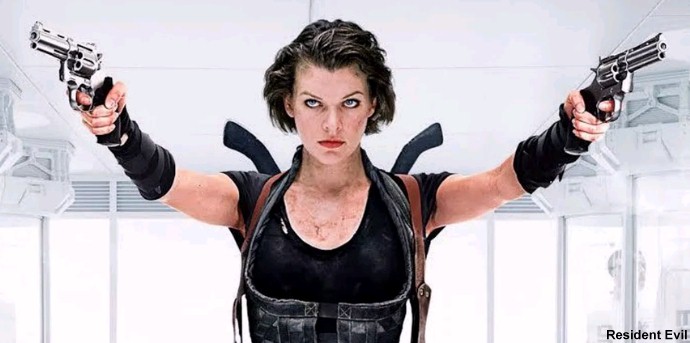
These thoughts of nudity vs. violence started recently over a coffee when I had to listen to a male relative tell a group of us how repulsed he was on seeing a male cyclist walk into his local café in form-revealing Lycra, and argued that Lycra shorts should be banned everywhere, telling us how Mike Saunders recently banned them from his Rangiora hotel (photo below right). His childish argument was that he didn't need to be reminded that other males had genitals. This led to another person telling an even more horrific story Near the end of the movie (and there's a couple of hours I'll never get back), a male intruder breaks into a family home, immediately killing the husband and then gagging and tying the wife and two teenage daughters to metal wall fixtures with wire, the wire cutting through their wrists and causing bloody, painful wounds. Their terrifying ordeal lasts for at least a day and night, maybe longer, and it's implied that the wife and the daughters are raped over this period, or else why keep them alive when the husband was quickly killed in cold blood? Bound and gagged, clearly they have not been kept alive for their conversation or cooking skills. The hero (Bruce Willis) eventually arrives and following a violent struggle strangles the murderer. The women's wrists are freed, but unfortunately it's too late for the wife, and she slumps to the floor dead. Viewers are forced to grapple with the suffering of the women, the terror of their situation, the murder of the husband, the violent struggle and slow strangling of the attacker, and finally the death, not the rescue, of the wife (plus the other scenes of violence in the movie). As I said, it seems obvious that one or more of the women were sexually assaulted, but this was never shown, the women weren't even shown semi-clad or with ripped clothing. Why is it felt that we can see, indeed need to see, drawn out graphic violence, traumatic suffering and grim death, with the assumption that we won't be emotionally harmed in the slightest, and yet showing the rape, or even the wife naked after the rape, would have been too shocking? We couldn't find a screenshot from the movie, but a similar screenshot from a different movie should set the scene for you:
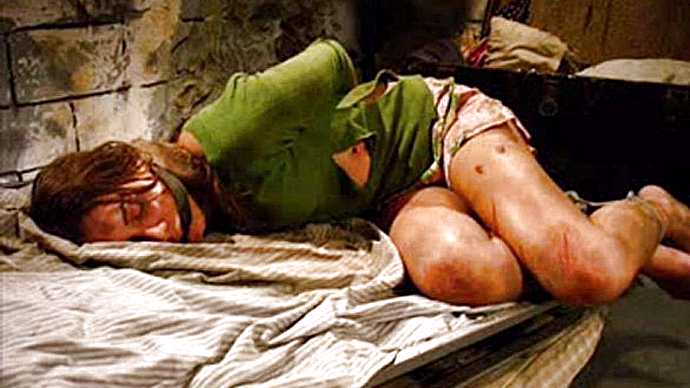
It's from 'The Girl Next Door' (2007), a sadistic horror movie based on a true case, involving the abduction of a 16 year-old girl who was repeatedly tortured and raped, and finally murdered. But at least in the movie, by keeping her clothed, they were caring enough to protect her modesty while torturing and raping her. There's no happy ending, but based on all the cruelty and suffering, and the lack of graphic nudity and sex, it's truly a movie for the whole family. Pass the popcorn please. (We haven't seen the movie and have no wish to.) Again, as we've said, the producers' of the movie 'Unbreakable' clearly wanted viewers to believe that the three women were subjected to ongoing vicious sexual assaults, but were only prepared to show their pain and suffering after the attacks, even going so far as apparently having their attacker put all their clothes back on to protect their modesty (as happens in real life cases!) We could see them bound and bleeding and terrified, but not naked. The following screenshot is from a minor 1980's movie (not a mainstream Hollywood movie or from a studio constrained by their rules and censorship) and it shows a similar scene of a bound woman abducted for the purpose of ongoing sexual assault, the difference being that back then rather than show a clothed body and bloody injuries to imply rape, they simply showed the woman bound and naked. They opted to show graphic nudity rather than graphic violence, no doubt believing that while a bound naked woman or a bound bloody clothed woman could both serve to imply that a rape occurred, the image of nudity would surely be just as informative while being far less disturbing to viewers than the image of violence. Today however the situation is reversed, the public now cries out for scenes of violence and decries scenes of nudity, and Hollywood (and like-minded studios around the world) obliges.

After the 'Unbreakable' movie, thanks to some channel surfing I then caught a few minutes of a recent British TV show, a murder-mystery, set maybe in the 1930s. The lady of the house is found murdered in the drawing room, her clothes covered in so much blood you'd swear she'd been bathing in it. A trembling maid is sitting on the stairs, her hands also dripping blood. A white cat then walks all over the bloody corpse, with the police making no effort to stop it, and then plods across the carpet leaving a trail of bloody paw prints. Just prior to the murder, we're shown the lady of the house perving at a young man in her bath, and in a flashback we're shown the lady of the house in the bath, but with both her and the young man, all we are shown to suggest that they are naked is their naked shoulders rising from soapy bath water. Again, it's felt that the body of a clothed murdered woman covered in blood is something we absolutely need to see, and yet seeing the naked body of the same smiling, beautiful woman in the bath is something that must only be hinted at, lest it give us nightmares. Explain to us again why disturbing violence and bloody bodies (clothed of course) are preferable over joyful experiences and the natural beauty of the naked body, why the above screenshot of nudity will offend many but the following screenshot of implied bloody violence will upset very few?
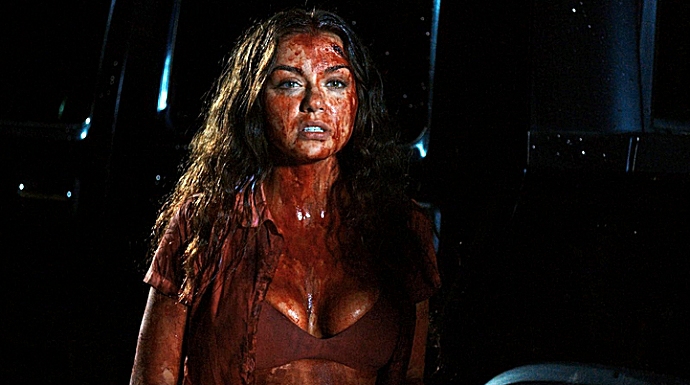
Before we continue, a quick note about labels. Until recently society referred to men as actors and women as actresses, whereas now the label 'actor' more often refers to both men and women, to anyone who acts, there is no longer a gender differentiation. However in this essay we will sometimes use 'actress' when it's important to grasp that the point being made involves a female 'actor' rather than a male 'actor'. Also, while the roles of movie director and movie producer are quite distinct, we will sometimes use either title interchangeably simply to refer to a person who has considerable influence over what we see in a movie. As for the label 'Hollywood', we'll often use it as a catch-all term that refers to the American movie and TV industry in general, not just the specific studios in Hollywood, Los Angeles. Finally (and remembering that all countries have good and bad apples), we'll often condemn the attitudes and practices of "America" or "Americans", and when we do so we are referring to the "bad" Americans; the ignorant, Bible-thumping, racist, sexist, homophobic, gun-loving, Trump-voting, abortion-opposing, sex and nudity adverse reprobates that give America a bad name around the world, not the "good" Americans that represent all the admirable values that America claims to stand for, like human rights, free speech, democracy, equality, education, scientific research ... and showing nudity in movies. Americans are real Jekyll and Hyde characters, a mixed society of decent people using science and reason to inform their lives and redneck hillbillies who are slaves to religion and faith. It's a sick joke to claim they live in the United States of America, when they are anything but united; from person to person and state to state their views on right and wrong are often polar opposites. And now, back to your regular programming.
Most movies and TV shows today only ever hint at nudity, a bare back or thigh (nothing like the above screenshot), perhaps some underwear sliding to the bedroom floor and a blurry flash of flesh as they jump under the covers. These days they almost never show full-frontal nudity (defined as nothing concealed, when you can see the whole of the front part of someone's naked body, including the genitals), and even when they appear to, it's often fake. Decades ago when Hollywood wanted to show full-frontal nudity they simply filmed real naked people, but today they have the technology to fake it, using prosthetics, flesh-coloured body stockings and computer-generated imagery (CGI). This means, especially in this #MeToo era, that they don't have to persuade an actor to get naked for the part, or worry about the legal battles regarding nudity release forms, and they can make body parts look exactly the way they want them to look, regardless of what the actor playing the part looks like naked. For example, if you think you saw some female pubic hair, that's right, it was almost certainly fake (they're called merkins, pubic wigs or fur bikinis), with some actresses almost desperate to inform the media afterwards that it wasn't real, that moviegoers hadn't actually seen them naked. There And movies certainly don't show real sex (obviously), just pretend sex, just as they never show the actors really getting tortured, injured or killed. And yet strangely, we are often shown a character's "fake" death in slow motion and in graphic detail with blood and guts spraying everywhere. And if we're lucky, we'll get to see the bloody body again as the police examine the crime scene, and then, if we're really lucky, again in the morgue, cut open on the autopsy table as a pathologist explains exactly why their gruesome wounds were fatal. If we're really, really lucky, we'll get to relive the murder several times over as the witness to the murder experiences numerous traumatic flashbacks. Somehow we're expected to view realistic torture and death over and over again in many movies (albeit faked), and take it in our stride, but if we were to see a naked body (real or faked) ... what? ... we'll all be traumatised for life? WTF? As an example of this idiocy, there was some brief full-frontal female nudity in the pilot episode of the sci-fi TV show 'Stargate SG-1' (A favourite of ours). While they showed this on both US and NZ TV on its original broadcast (1997), amazingly they have now edited this scene out on the DVDs available in the US. We read on the Internet the comments of one American father who wrote that he's glad they edited out those few seconds of female nudity (there is no other nudity in the entire ten seasons of the series), since he's been wanting to buy the series and watch it with his young son, but refused to do so while the nudity remained. You may not be familiar with 'Stargate SG-1', but there are more people shot, killed, stabbed, tortured and blown up in the series than in a dozen 'Rambo' or 'John Wick' movies.

Admittedly the scenes of people dying and being tortured are not as graphic or confronting as those in many movies today, or as seen in many modern TV crime shows, but people are still tortured, shot and killed, meaning there is still a lot of death and suffering that viewers have to come to terms with (if they can be bothered to think about it). This guy's comments show how warped some people's values are, that he has no problem with all the violence and death, or with his young son watching it, indeed he wants his young son to see it, but he was shocked and sickened by a few seconds of nudity in one episode, which wasn't in any way gratuitous. And it wasn't just this one American prude, it was the large number of complaints that apparently helped convince the director to re-edit the episode and delete the following scene before releasing the DVD to the American public (it remains in the NZ version).

The female nudity scene that we referred to (screenshot above, actress Vaitiare Bandera) showed evil aliens implanting a parasite into a struggling woman's neck (a woman they had forcibly kidnapped), and her screaming as it took over her mind. And it wasn't the forced possession or the screaming that upset US viewers, since similar scenes played out numerous times throughout the series and no one complained, their only problem was that this time the human host was shown naked. These prudes had no problem with seeing innocent people being possessed by aliens, in some sense one could even say raped, or of being tortured and murdered, they were just so shocked that they had to look upon a naked body. A beautiful naked body. They didn't mind seeing what the aliens were doing to her, if only they had had the decency to let her keep her clothes on as they did it. So the take-home message from this is that murder, torture and rape are quite OK to watch in TV shows and movies, even for children, but we most definitely must never be shown any nudity, even in a non-sexual context. So, to sum up, violence is good and nudity is bad; violence is acceptable and nudity isn't.

How could we have got it so wrong, so mixed up? Both nudity and sex are legal and perfectly natural, and something most people want to experience over and over in their lives, and yet nudity and sex, real nudity and sex, must never be shown, while murder and other violent acts, which are illegal and abhorrent, and something most people never want to experience in their lives — ever — are shown over and over again in extreme detail. In most TV crime shows entire episodes revolve around a violent death or crime of some sort, a crime that isn't left to our imagination as it used to be in the old Alfred Hitchcock movies, we get to view it in graphic and disturbing detail, thanks to the invention of CGI. We've questioned people over the years why they, and the censors, have no problem with movies that show untold people being raped and tortured and killed in all manner of grisly ways, and yet at the same time we must never see naked people having sex, or even naked people not having sex, just innocently strolling naked from the bedroom to the fridge. Think about it, don't you ever find it weird how strangely self-conscious people are in movies and TV shows these days? In bedroom scenes where the clear implication is that lovers have just had uninhibited sex, the woman always has the bedsheets pulled up to cover her chest, while the man can never quite manage to cover his. Hollywood even has a name for this careful positioning of the sheet, one that implies nudity but doesn't actually reveal it, it's a trope called 'the modesty bedsheet'.
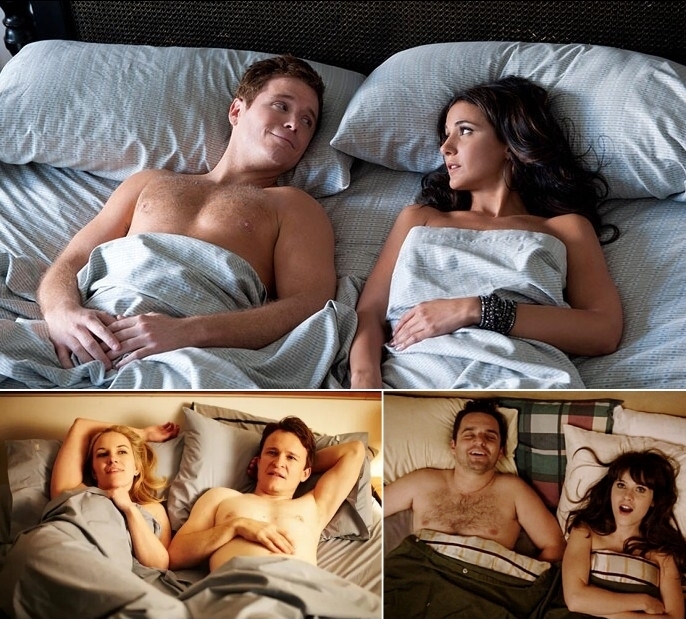
Here's a quote from a famous film critic bemoaning this silly use of a sheet: "Sexy women would 'happen' to be topless in the 1970s movies for no better reason than that everyone agreed, including themselves, that their breasts were a genuine pleasure to regard — the most beautiful naturally occurring shapes in nature, I believe. Now we see breasts only in serious films, for expressing reasons. There's been such a comeback for the strategically positioned bed sheet, you'd think we were back in the 1950s."  In the entertaining and informative documentary 'Skin: A History of Nudity in the Movies' (2020), actress Kristanna Loken who starred in 'Terminator 3: Rise of the Machines' (2003), also criticised this childish ploy to hide female nipples with bed sheets:
In the entertaining and informative documentary 'Skin: A History of Nudity in the Movies' (2020), actress Kristanna Loken who starred in 'Terminator 3: Rise of the Machines' (2003), also criticised this childish ploy to hide female nipples with bed sheets:
'It's easier for a man to just have his shirt off, you know, and not have anything thought of it, other than a woman, even if they're in bed together, which I agree, the bed sheets up here, it looks weird'. [1]And if they must get out of bed, they drag one of the sheets with them, wrapping themselves up like a mummy, or they grab some pillows or clothes from the floor, anything that might cover their body in order to prevent their lover from seeing them naked. When of course they already have, usually in great detail.
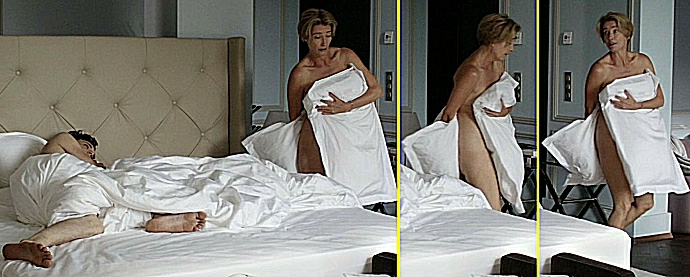
Some actresses apparently think that covering their breasts with a modesty sheet looks silly or is difficult to get right, so get around it by happily letting the sheet drop, but avoid shocking any viewers by keeping their top or bra on. Or stranger still, when they hop out of bed it's revealed that lovers that we assumed were naked under those sheets are actually still wearing underwear! What normal man or woman keeps their underwear on in bed when having sex, or immediately pulls underwear on (that they had conveniently stored beforehand under the sheets) after having sex and before hopping out of bed? And yet in the movies, when the modesty sheet is dispensed with for some reason, men often hop out wearing underwear and women are found to be wearing a bra and panties (or 'knickers' if you're British). Are we seriously expected to believe that this is how decent men and women should dress in bed during and after sex? That even during sex, nudity isn't appropriate? Look at the title of this revealing article: 'Did Hollywood con us in to keeping our bras on during sex?'


Although it's not as if actresses don't realise how silly it is and some fight for realism. For a sex scene in the movie 'The Island' (2005), Scarlett Johansson was forced to wear a black bra in bed by the director Michael Bay, even though she wanted to be topless. According to Bay the "discussion" went as follows: Johansson: 'I'm not wearing this cheap *** bra. I'm going naked'.Unfortunately, the director's desire that the movie not be rated R trumped realism, meaning Johansson was forced to wear a bra. An R rating — meaning "Restricted" — limits who can see the movie, and therefore the money it will bring in. Sometimes this rating is the difference between a movie making a profit or a loss. For some bizarre reason, even innocent nudity will see a movie getting an R rating whereas scenes of gratuitous violence and gore won't. However, in the action movie '2 Guns' (2013), actress Paula Patton does appear topless in a scene with Denzel Washington. Like Johansson, it was later revealed that, for the sake of realism, 'Paula chose to go topless in 2 Guns'. But unlike Johansson's director, this director agreed (and consequently the movie got an R rating). Let's quote the relevant text: 'Paula ... plays Denzel's character's lover and admitted she hates it when people keep their underwear on for sex scenes as it's unrealistic. ... "I kept thinking about this scene, and thinking 'Gosh, these two have been lovers for a long time, they've just made love.' It seemed odd and unnatural for her to put a shirt on." ... "And one of my pet peeves is seeing people in bed with a bra on, I just don't understand it." ... "So I came to set and I said to Baltasar Kormakur [the director] and Denzel, 'I'm not going to be wearing a top. It doesn't seem natural.'Now it may seem that Paula agrees with us, that movies showing lovers wearing underwear in bed is utterly moronic and prudish. But only to a point it seems. Look at the following screenshot from that scene in the movie. Notice anything unexpected?
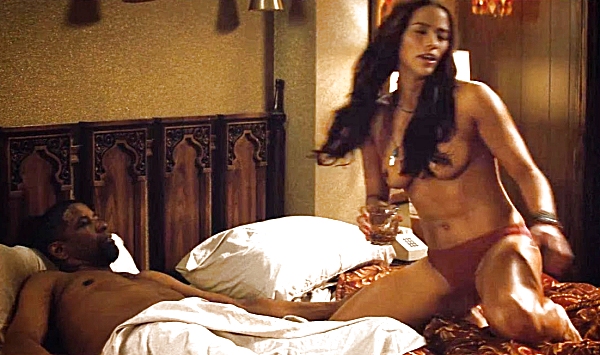
That's right, Paula is wearing panties. We don't see how Paula could honestly make her argument for losing her bra for the sake of realism, but then insisted on wearing panties. We're not saying that there had to be full-frontal nudity, but we all know that certain camera angles or props could have at least implied that she was completely naked (as they do for Denzel), for the sake of the realism that she was arguing for. It's simply just as ridiculous for Paula to be wearing panties as a bra, probably more so. If she was truly sincere in her belief regarding movie sex scenes, she would have told the director she was going to be naked, not merely topless. You can't publicly express a pet peeve regarding the prudish depiction of lovers in movies, and then in a personal protest, be almost as prudish yourself. It seems that actress Shailene Woodley 'I'm totally comfortable with nudity ... [and] if I'm going to do a movie with sex scenes,Actress Dakota Johnson has expressed a similar opinion: 'Maybe I have more of a European mind-set about these things. I don't want to seeAnd here's how actress Margot Robbie views Hollywood's use of the modesty bed sheet and bra: 'I think nudity for the sake of nudity is shameful. If they've put it in just so that a girl getsOf course this is just these actresses' personal opinions, actresses (and actors) don't have the final say in how a scene is shot, the likes of directors, producers and studio executives do, who are often thinking of ticket sales, not realism. So just as Scarlett Johansson's desire to be topless in 'The Island' was overruled, perhaps Paula Patton would have preferred to be fully naked in '2 Guns' but knew the director wouldn't go beyond her being topless. Likewise actresses Shailene Woodley, Dakota Johnson and Margot Robbie remain clothed in several of their movies when realism would dictate some nudity, so clearly this was a choice of the producers, not a reluctance on the part of the actresses to disrobe to add some realism to the scene. (And it's not just the nudity that Hollywood gets wrong, have a read of this brief article: '18 Things Women Do In Movies During Sex That Are Totally Unrealistic'.) Yet even when they're alone in the bedroom or bathroom most movie characters still carefully arrange the sheets or towel as if they suspect strangers are watching. This is ridiculous, what normal person in real life covers their body in front of a lover or at all when they're alone? Who, in the privacy of their bathroom, emerges from the shower with a towel already securely wrapped around their body? How does the towel even stay nice and dry when it's in the shower with them?

It's silly enough that Hollywood are adverse to showing naked bodies, but it's sillier still that they go to such childish lengths to hide them in plain sight. By unrealistically wrapping them in a sheet or towel they somehow think that they have shielded the viewer from seeing a naked body, and yet the scene deliberately tries to make it very clear that the person behind the sheet or towel is quite naked. The action purposely takes place in the bedroom or bathroom with a scantily clad person to generate the thought of possible nudity, and thus the viewer can't help but visualise that person naked.
It's like us saying that we're going to name a certain animal and whatever you do, we don't want you to think about it or even form an image of it in your mind. Ready? Polar bear. You of course will now be thinking about polar bears. It's impossible not to, you can't help it. It's the same thing when a movie shows you a couple in bed after they've had sex, or someone in the shower, you can't help but visualise, even if it's only fleeting, what sex and bathing entails — naked bodies. Your mental images may not exactly match the real, Why do movies and TV shows deliberately devise scenes that would realistically involve nudity but then go to childish and ridiculous lengths to hide it, to merely suggest nudity and in doing so force the viewer to imagine naked bodies that are never actually seen? If nudity is something best avoided in polite society, if no one wants to see that sort of thing (spoiler alert, we do), then what's with all the gratuitous scenes in bathrooms and bedrooms where the actors and camera crew are forced to hide the nudity that the very location creates? Why not film in the kitchen? And yet when it comes to scenes of disturbing violence and bloody bodies they make no attempt to hide anything. With nudity they merely hint and suggest, lest they cause us to faint with shock, but with violence they show it in all its bone-breaking, blood-spurting, trauma inducing graphic glory. With violence the viewer's imagination apparently cannot be relied on, meaning in movie after movie we are shown untold images of bloody and battered bodies (suitably clothed of course), like the woman in the following screenshot:
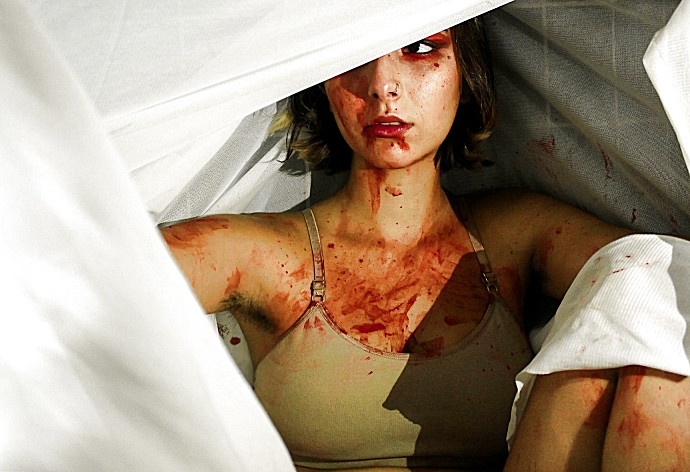
But it is a rare movie that shows a smiling, happy woman who hasn't modestly covered herself with a sheet, as in the image below. Why is the distressing sight of a woman's blood-covered flesh perfectly acceptable in movies but the pleasurable and quite harmless sight of a woman's nipple something that must always be hidden? Why do movies keep hinting at beautiful things — naked bodies — that they definitely don't want to actually show us but they keep showing us graphic things — bloody bodies — that we really don't want to see?

Look at the following screenshot from the 2012 American movie 'One for the Money', an enjoyable comedy starring Katherine Heigl. An intruder breaks into her house while she's in the shower, and failing to find what he was looking for, confronts her and eventually leaves her handcuffed to the curtain rail. She then has to call a male friend to come rescue her, who isn't keen until she tells him she is naked. While the shower scene was funny, it's quite clear that it was only in the movie to titillate the viewer, to make us think about Katherine Heigl's naked body. Although again, it's a body where we don't actually see the naked bits.
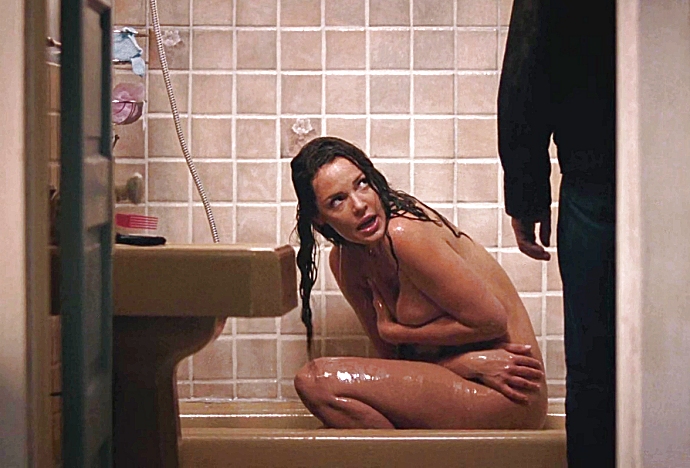
Why do you always see these movie scenes of the heroine being attacked in the shower (making it one of the most dangerous places in the house), and always managing to hide her nakedness with a towel or shower curtain or a well-placed hand as they fight off the attacker, or die reaching for the towel instead of the gun? But we never see realistic scenes like the one below, where the naked heroine completely ignores her nudity and simply fights for her life, where her very survival is far more important than her modesty. Movies want a lot of action to happen in the bathroom or bedroom to make us think about nudity and sex, but then say they can't show that nudity because that would be ... umm ... rude? They'll happily provide the suggestive outlines of the scene, but we have to flesh out the naked details.
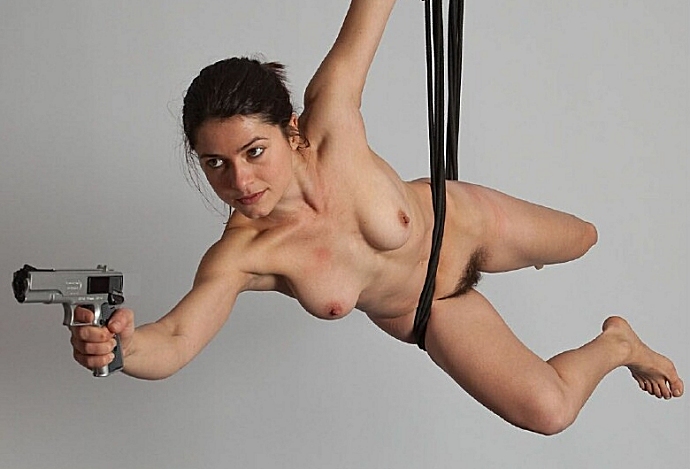
The animated adult comedy 'Velma' (2023) highlighted this hypocrisy perfectly. It's a cartoon TV series (a prequel actually) about Velma and Daphne, the fictional amateur teenage sleuths whose "later" adventures featured in the children's cartoon TV series 'Scooby Doo, Where Are You!' (1969-1978). In one scene we see several teenage girls showering together at their high school, when Daphne joins them and asks: Daphne: 'Oh, hey. Team shower discussion topic of the day. Have you ever noticed how pilot episodes of TV shows always have more gratuitous sex and nudity than the rest of the series?'Their conversation in the shower of course parodies the use of gratuitous nudity to attract viewers since we are just one minute into the pilot episode of their TV series. It ridicules the nonsense that most viewers don't want to see nudity, since the directors of these TV shows know very well that nudity is a proven way to hook viewers to a new show and keep them watching future episodes, just in the hope that there will be more. Directors don't for a moment think that including some brief nudity in their pilot episode will offend their potential audience and cause them to quickly change channels, just the opposite, they hope it will entice them to watch the entire series. Of course the director's vision is forever bumping against the censor's vision, meaning that the above scene in the shower also (surely unintentionally) parodies the prudish American idea of nudity, since in these supposedly nude scenes from various TV shows there is (almost) never any actual nudity, it's always implied nudity. In the 'Velma' shower scene (below) Daphne is attacked (again demonstrating how danger so often befalls women when they are naked) yet in the ensuing fight the modesty of the girls is never compromised, not a glimpse of a nipple or pubic hair, since the young women are effectively all wearing ... not real bikinis or even 'fur bikinis', but 'soap bubble' bikinis ... and are you ever naked in a bikini, no matter what it's made of? Only in Hollywood.
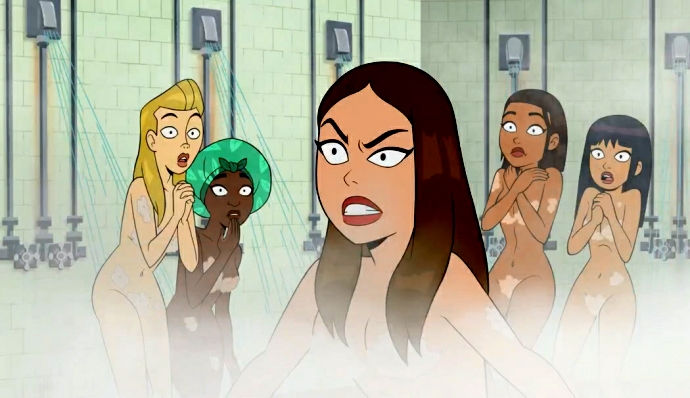
Nudity, is it harmful or harmless? So what are we being protected from exactly with all this silly censorship in movies, what is the perceived harm caused by viewing nudity? It seems that generally there are two reasons offered for why sighting nudity or sex outside your own bedroom could destroy decent society, and perhaps even help bring about the end of the world.
First, it's the belief of many in society that seeing nudity will somehow psychologically harm us and/or cause us to harm others. Apparently we'd harm others since it's believed that nudity creates dangerous lustful desires; intense, unrestrained, obsessive sexual cravings that we can't resist, and "naturally" we'd force others to help us fulfil those desires, and in doing so, harm them. Even if we could somehow resist harming others, our lustful desires will apparently still cause us to harm ourselves, because we'd go blind. Why? Because it's well known that lustful desires that are unsatisfied can lead to 'In "A Return to Modesty", author Wendy Shalit ... argues that modesty in dress and behavior is a good quality that exists naturally in women and helps them avoid being victimized by men. In many cases, she maintains, it also motivates men to exercise sexual restraint and develop a more respectful attitude toward women. If Shalit is right, then the half-naked look affected by many young actresses and singers and imitated by their admirers is harming them (and perhaps the rest of us). Is Shalit right?'This is the sort of silly belief we're talking about, that the chance of real harm goes up as the naked flesh on display goes up. As a male, I have no problem being respectful towards women, even if they're in bikinis, in their underwear or completely naked. I find it insulting when some people imply that I'll turn into a rapist if a woman takes off her sweater, revealing a tank top, bra straps and naked shoulders. But this is the belief that people like Shalit are pushing. And she's not spending much effort arguing that naked people should cover up, or that only nudity causes men to harm women, she seems to assume that society already has a lid on public nudity. She's talking about women who are already dressed, arguing that the clothing women are wearing now isn't covering enough, isn't modest enough. If just the half-naked look is what Shalit believes causes harm, nudity would no doubt bring about World War III in her mind. But of course it's quite obvious that everyone sees naked bodies every day, if not their partners then at least their own, and it doesn't trigger them to attack others. Much of the nudity people see in real life is innocent nudity, in the gym or pool changing room for example, completely unrelated to sex, and even if sighting a naked body does occasionally generate thoughts of sex (and being human, it sometimes does), apart from a few deranged individuals, everyone else is perfectly able to control those thoughts and not act on them. Hollywood and society is convinced that we can view graphic murders in movies without becoming serial killers (even knowing that we all have a list of people we don't like), so why don't they think we can view nudity without becoming rapists? What is driving this censorship, is there actually any evidence that viewing nudity is detrimental to our well-being? Perhaps we can get an insight into the effects exposure to nudity has on the mind and then our behaviour by examining groups in society that regularly encounter nudity. Five groups spring to mind: (1) beauty therapists that perform body hair removal, eg Brazilian waxing, (2) medical practitioners, (3) nudists, (4) the people that censor our movies and books, and (5) people who view pornography. It's not easy to ascertain if the people in these groups ever experience lustful desires when they encounter nudity, some likely do on rare occasions, and those that view pornography certainly will, but the important question is whether they act on those desires and harm others. (I think that as regards pornography, we can ignore the childish assertion that masturbation causes self-harm.) It should be immediately obvious that none of these groups feature in our crime statistics. Neither law enforcement nor society in general is even hinting that we need to keep a close eye on individuals from any of these groups because their much higher than normal exposure to nudity is a time bomb just waiting to go off. So let's dig a little deeper. (1) Beauty therapists.
To the best of our knowledge, beauty therapists that spend their days removing body hair are not reporting an unusual and unexplained increase in lustful desires and going on to sue the government for compensation because of all the genitals they've been exposed to, arguing that hairy vulvas, asses and
(2) Medical practitioners.
As with beauty therapists, medical practitioners, especially gynecologists and cosmetic surgeons, but also GPs, nurses and technicians that perform mammograms etc., are often required to look at their patients naked, often in detail, sometimes touching is even required. But again, while medical practitioners often (and justifiably) complain about the long hours they work or about insufficient pay or unsafe working conditions, they never complain that they have to sometimes see naked people as part of their job. Whether they like, dislike or are ambivalent about this part of their job is unknown, but clearly they don't see it as harmful and worth complaining about. And as for public safety, just like the beauty therapists, medical practitioners are not exhibiting any sort of worrying behaviour that suggests that their exposure to nudity might be a threat. (3) Nudists.
(4) Censors. Now let's consider our group of censors, the group whose very existence implies that viewing nudity causes real harm that society must be protected from. One thing has always worried us about the people that act as movie (and book) censors, and we feel it discredits their entire reason for existing. Their claim is that certain material is so damaging that if the public were to view it, it would harm us and/or cause us to harm others. Watching just one movie scene with full-frontal nudity or of actors pretending to have sex would risk triggering something inside us all and see us turning into rapists, peeping toms, sex addicts, exhibitionists, pedophiles or chronic masturbators, and thus it must be deleted. But surely their silly belief is badly mistaken, since these censors aren't claiming to be superhuman or even specially trained. They're just ordinary people, they don't have some higher nudity threshold than you or me, and they don't have their memories of what they've watched wiped at the end of each day. And they aren't just watching one movie, they're watching hundreds, they're viewing this "damaging" material week in and week out for years. Their exposure to on-screen nudity and sex is enormous, they'll see more bare flesh in a year than we will in a lifetime, they'll cut and ban untold scenes from movies that we didn't even know existed. Comparing what a censor sees to a what a typical member of society sees is like comparing the number of x-rays a radiographer sees in their career compared to how many a patient sees following a broken leg.
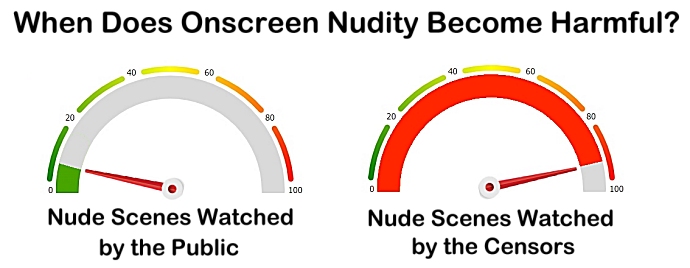
What makes the adults that are doing the censoring more capable than those they are doing the censoring for? If they're watching truly harmful material that needs censoring, why aren't they being harmed in the process of viewing it? Consider this analogy. To minimise the risk of harm we limit how much ionising radiation certain people are exposed to, eg commercial pilots and X-ray technicians, but we don't put a limit on how much nudity and sex a censor can be exposed to before he or she becomes a risk to himself and society. Why not? Because as far as we're aware, there is no evidence that censors are harmed in the slightest by all the nudity and sex in the movies they watch. It apparently doesn't effect them in any lasting way, no more than the way a scary movie briefly affects me. They still function normally in society, they continue to relate lovingly to their families and friends, and they don't go on to rape, kill and pillage because of what they've viewed and then banned from the many movies that they've watched. How is this possible? Is the material they're banning harmful or not? Why do these arrogant bastards think they can handle seeing some actors naked and pretending to have sex, but believe that the rest of us would turn into rapists and porn addicts? If viewing nudity and sex, real or pretend, is damaging and harmful, then it must harm those censors that watch hours and hours of movie nudity and sex for a job, how can it not? And yet at the end of a long viewing session, censors assure us they're fine and can be trusted to go home to their kids. Perhaps they'll pick up a pizza on the way. So clearly bingeing out on nudity and sex in movies is as dangerous as watching paint dry, as harmful as watching a beautiful sunset. (And of course the same argument must apply to viewing graphic violence in movies, since the censors clearly don't turn into crazed killers and sadistic torturers due to the untold disturbing scenes they watch, scenes that they then censor so we can't be harmed by them.) But why would we be harmed if they weren't? And since NZ's last Chief Censor, Bill Hastings, spent nearly 12 years watching nudity, sex, cruelty, horror and violence and is now a District Court Judge, obviously no one thinks he was psychologically harmed by what he watched, not just once or twice, but for nearly 12 years. (5) Pornography.
So clearly viewing nudity and sex, even the most explicit and shocking scenes that are eventually censored, has no deleterious effect on the actual people doing the censoring, and looking now at our final group — ordinary people who view pornography — further reinforces that view. And note that we are now referring to legal pornography, not the pornography that the above censors have viewed and (arrogantly) deemed harmful and illegal. But while censors can (somehow) separate safe from harmful porn, one writer has noted that many Christian moralists argue that ALL 'pornography corrupts the moral fiber of its victims to the point where fantasies spill over into actual rape or sexual abuse'. These Christian moralists believe that viewing any fictional scene of naked people having sex is just priming people to commit sex crimes (while at the same time implying that watching violent fantasies never spills over into actual murder or physical assaults). This argument is nonsense, since in reality when we look at people who have watched pornography we actually have the best evidence that viewing both nudity and sex is not at all harmful, because pornographic movies of
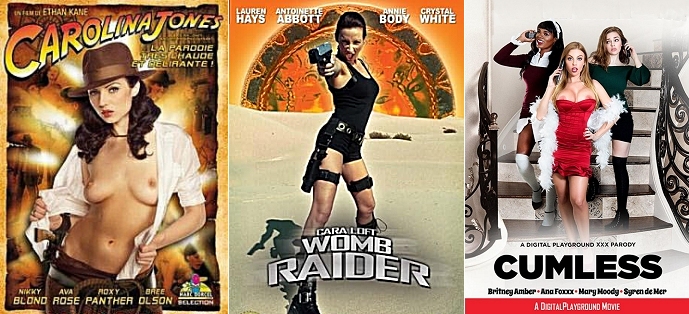
Professor Penley makes the astute observation that: 'One thing that's remarkable about these porn knock-offs is [that they're] a kind of critique of Hollywood film for its hypocrisies and its pretensions for the way Hollywood film promises sex but never delivers, it only gives us simulated sex, and also taunting Hollywood for substituting violence for the sex that it can't deliver'. [8]That is so on the mark. It's reckoned that the US porn industry makes more money (and more movies) than Hollywood, meaning they must have a sizeable audience that want to watch movies featuring real sex. Porn is honest, it shows what many in society want to see, consensual acts that are pleasurable and harm no one (in the movie or in real life) whereas Hollywood, knowing the carnal desires of their audience, lures viewers in with the promise of nudity and sex but never delivers anything but a fleeting glimpse in a darkened room, if that, and instead assaults the senses with graphic violence. Hollywood is terrified of exposing a female nipple or showing explicit sex but has no qualms at subjecting the viewer to seemingly unending scenes of blood splattering violence. They censor the very thing that adult society finds pleasurable and replace it with that which any decent adult should be shocked by. Legal and desirable acts are replaced by illegal and appalling acts. Again, we're not saying violent acts in movies should be censored, they're often integral to the story being told. We shouldn't hide it as violence is unfortunately part of the real world, and will naturally be part of real world stories. But so is nudity and sex, meaning it makes no sense for Hollywood censors to argue that we must see the violence, and not only will it not harm us, it will add to our viewing experience, but were we to see nudity and sex it would lessen our viewing experience, and worse still, would harm us psychologically, the disturbing nature of what we had seen staying with us long after the movie is over. The rich and powerful that dictate how American society functions are arrogant, ignorant hypocrites, arguing that their violence-filled but sex-free movies are a safer option than porn movies, that teens and adults can handle watching graphic violence but not graphic sex, or even innocent nudity.
If viewing extended, explicit scenes of full-frontal nudity and graphic, real sex was thought to be harmful, then pornography would be banned, but not only is it not, it's now more prolific and easily available than at any time in history. So to repeat, we know for a fact, from decades of data, and personal experience, that viewing the real thing in great detail doesn't do the slightest bit of harm to the typical viewer. And yet movie censors still spend their time, and our money, deleting innocent nudity and pretend sex from mainstream movies.
Of course the prudes will argue that children, even if they're told not to, often want to watch movies made for adults, and it's near impossible to stop them, so we have a responsibility to make even adult-themed movies safe for children. Maybe, but the reality is that we don't make them "safe", we don't remove the most harmful and traumatic adult themes from movies, such as the numerous scenes of murder, rape, torture, cruelty, horror and violence, all the truly nasty stuff, and for children, the stuff that will likely be very frightening, upsetting and disturbing. Censors just remove the innocent nudity and pleasurable sex, the stuff normal adults really love and the very stuff young children generally don't care about. Young children don't see anything wrong or shocking with nudity, and have to be trained over the years to keep their bodies covered; parents and society must actively subvert their natural tendencies. Children must be taught to be ashamed of their bodies. Just last week a friend refused to let her 3-year-old granddaughter join her in the spa pool, solely because she hadn't brought her bathing suit. The young child said she could go 'rudey-nudey', but my friend wouldn't hear of it. The adult fear of nudity extends to passing that fear onto innocent young children with silly phrases such as 'rudey-nudey', that being nude means you're always being rude! Adults are the ones being childish when even a 3-year-old is viewed as offensive if naked. In his book 'A Brief History of Nakedness' (2010), Philip Carr-Gomm writes:
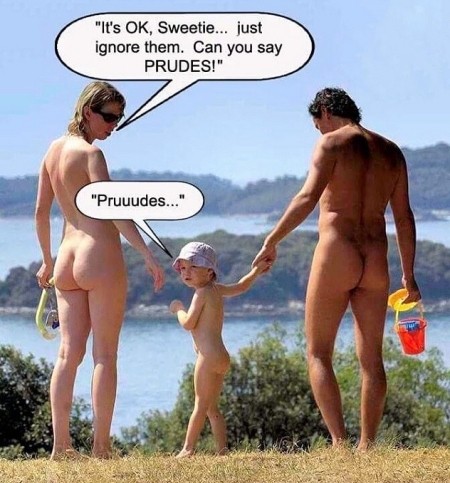
And as for sex, prepubescent children generally have no interest in it, finding adult intimacy rather gross. When some young children do go looking for adult movies with nudity or sex scenes, it's only because they're curious as to what it is that adults are hiding from them, thinking that it must be good because adults clearly enjoy it and want to keep it all to themselves. If children grew up knowing what naked adults looked like, perhaps having seen their parents and older siblings strolling naked from the bathroom for example, or having seen innocent nudity in movies, then they wouldn't sneak around trying to view adult movies. For the same reason that children are curious about what's in those colourful boxes beneath the Xmas tree, they're curious as to what's beneath those clothes that adults continually wear. If adults scream and frantically cover their naked bodies with a sheet or towel when a child suddenly walks in, then of course the child will wonder what they're hiding. Adults by their obsessive, secretive behaviour force children to go looking for information on what naked bodies look like, because clearly their parents aren't going to provide it. As Susan Stanton writes in 'Being Naked: Attitudes Toward Nudity Through the Ages' (2001): 'There is nothing mysterious about the human body. It is the human attitude toward the human body that is mysterious and bewildering'.So, there you have it. Five groups in society that regularly encounter nudity, and none show any ill effect whatsoever. Nothing in their general behaviour at a dinner party or poetry reading would suggest that they've seen more nudity than you. Therefore, any argument that maintains that viewing public nudity might subconsciously push us into acting like unthinking and uncaring animals and cause us to satisfy our sexual desires by using and harming others is clearly bogus. And while Christians generally agree with the above (bogus) argument that viewing nudity greatly increases the risk of us harming others — because we are flawed and sinful creatures — they also have an additional and quite weird belief as to why seeing nudity can harm us personally (in addition to the masturbation one.) They argue that it doesn't matter if you don't act on your lustful desires, just having them is enough to cause a major problem. For example, you may have heard this quote from the Bible: 'But I tell you that anyone who looks at a woman lustfully has already committed adultery with her in his heart' (Matthew 5:28). And, human nature being what it is, of course the sight of a sexy naked body might generate lustful thoughts, so it makes sense (if this bullshit were true) that if some vengeful god was going to torture us because of our thoughts then it's crucial to hide naked bodies and remove all temptation. The only flaw with this argument, and it's major, is that fully clothed sexy bodies can also generate lustful thoughts. The fashion industry exists to create outfits that makes the body appear sexually attractive, from revealing dresses and skimpy bikinis to tailored three-piece suits. And since hiding clothed bodies is quite impractical, working to just hide the naked bodies is an utter waste of time. If just a single, unintended lustful thought is going to get us tortured for eternity, a thought that wasn't generated by seeing a naked body, then we're all destined for Hell. So let's get naked and enjoy life, since as they say, one might as well be hanged for a sheep as a lamb. Thankfully, since God and Hell aren't real, we can quickly dismiss any and all religious arguments concerning nudity and sex. Keep that in mind as we discuss censorship reason number two. The second reason people call for censorship is that in addition to causing dangerous lustful desires, desires that we apparently can't help but act on, many also believe the naked body and public nudity, eg. in movies, on the beach, in the sauna etc., is obscene, indecent and offensive because it violates their code of morality. Even if no one is actually harmed, just seeing a naked body is a sin, which according to my dictionary definition is: 'A transgression of a religious or moral law, a deliberate disobedience to the known will of God, and something regarded as being shameful, deplorable, or utterly wrong'.Just as we would see it as obscene to watch someone being tortured, raped or murdered, this group also views nudity in the same way; as obscene. Even though torture, rape and murder clearly harms others, and nudity harms no one, supporters of this superstitious view can't see the difference. To them it's not about harmful actions or outcomes per se, it's merely that they follow a moral code that says that nudity, even if it causes no actual harm, is still wrong. Why? Because their god says it is, and he doesn't have to give reasons. And in countries like NZ, this group is predominantly made up of Christians, although worryingly, Muslims are gaining ground with a moral code that pushes an even more oppressive view of nudity. And unfortunately it's not just a warped opinion that Christians and Muslims keep to themselves, they actually expect us to follow their chosen moral code too! They both take a hard-line stance against public nudity, what they call "acts of public immorality". But it gets worse, not only do they see public nudity as violating their god's law, they view it as truly shameful behaviour, which my dictionary defines as behaviour that is disgraceful, that gives offence, that is indecent. They claim that the naked human body, setting aside what God might have said on the matter, is something that is genuinely unpleasant to see, repulsive even, something the generates intense embarrassment and shame. And so it needs to be hidden, always. It's not just about breaking their god's moral code, they consider the naked human body, in and of itself, as something obscene and indecent. We find this a strange thing for religious believers to claim, as surely it's blasphemous to say the human body — God's masterful handiwork — is indecent and shameful? How does this make any sense, that a perfect being could make a perfect body that his followers now view as indecent? Aren't they criticising God's work, and isn't that dangerous considering how jealous and vengeful he is? Of course many Christians and Muslims, contrary to what they claim publicly, secretly love viewing naked bodies (they are human after all), meaning it's obviously God's blatant disgust with the naked human body that generates this fake disgust within his submissive followers. It's clearly not about the body, it's what God has said about the body, and his followers want to keep on his good side, so if God hates the naked body then they'll pretend to do so too. While still secretly watching porn when God isn't around. But is the naked human body really indecent or offensive or shameful? Or are these conflicting feelings of disgust nothing but irrational thoughts arising from muddled, fearful, superstitious minds that are deeply puritanical in matters of the flesh, people wanting to obey their god but who frustratingly still find naked bodies sexy and alluring? OK, so clearly there is a real battle being waged in the very minds of the religious, their blind obedience to their god versus their love of the forbidden. As actor Jennifer Tilly has said, 'Because America is very puritanical, [our] films are about forbidden lust or forbidden desires or things that you shouldn't exactly be doing'. [4]But why should we care that deluded American Christians are struggling to understand why their god gave them forbidden desires, and then ordered them to suppress them? As long as we're not harming others, why should we be bound by their primitive, irrational moral code? Is their moral code absolute, meaning it applies to everyone, whether it makes sense or not? And when various groups all push different moral codes, which, if any, are we bound to obey? Without exception, we've found that these groups claiming that nudity is indecent are always religious in nature. Even if an individual insists that they're not religious, and doesn't refer to some holy book in their argument, further questioning on why they think nudity breaks their personal moral code always finds its way back to some primitive religious belief. This link is especially noticeable in the US, and in 'Sex(Ed): The Movie' (2014) (not actually a movie but a documentary about the history of sex education in America), author Carol Queen explains that: 
'United States culture does come out of a culture of religious conservatism. Puritans and pilgrims and our whole history and many of our laws including most of the laws that govern sexual behaviour come out of a religious basis'. [9]Many are surprised that this is the case, that their fear of nudity comes from religion, usually saying that they believe it's immoral because their parents, not some god, told them it was. But when asked where their parents got this belief from, the answer is that it was likely from their parents and/or society, and back it goes, right back to some passage in some ancient holy book. Try as they might, people can never explain why nudity is wrong. All they can say is that on reflection they don't know, or that some god said it was, and therefore, for reasons unknown, it must be. But if you go down the religion path seeking answers for why nudity is wrong, the truly weird thing is that in Genesis, a foundation book that Jews, Christians and Muslims all take to be true, it clearly says that God created Adam and Eve naked and fully expected them to remain naked, and furthermore that their nudity caused no shame, to them or God.
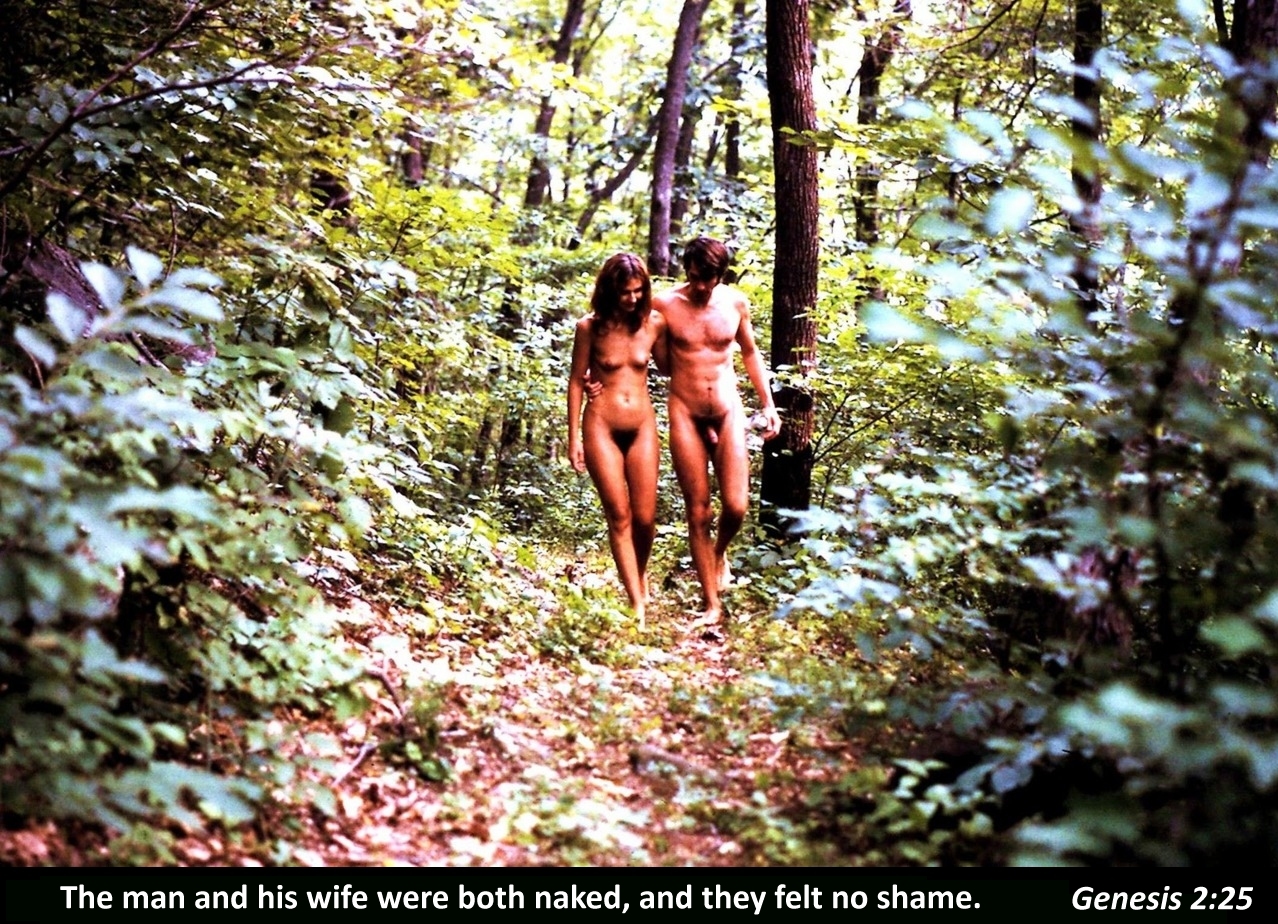
But then there was an incident with a talking serpent (it's a fairy tale remember), and suddenly for some unexplained reason nudity, even between lovers, becomes something shameful and forbidden. And so now Judaism, Christianity and Islam all find the naked body shameful, with some groups in all three religions, not just Islam, going to ridiculous extremes. Hiding not just the female breasts and genitals of both sexes, but (for women) almost the entire body, meaning women pay the highest cost to maintain a false modesty. Note in the following image that the male forces extreme modesty on his female companion while he happily wears comfortable, flesh-revealing shorts and T-shirt (and sunglasses to hide him ogling the bikini-clad woman.) And while nudity is horribly offensive and immoral to these people, sex is even more so.

Early Church Fathers like Augustine connected the transmission of original sin with sexual intercourse, or more precisely, sexual pleasure. But even these idiots, or at least some of them, realised that someone had to have sex or else humans would quickly die out. Sex was seen as a necessary evil. So marriage was allowed, although not encouraged, since it was still better to live life as a virgin than worry about the human race. In fact the morons even calculated how much one would benefit on reaching heaven. Virgins would receive 100% heavenly reward, widows and widowers (because they had stopped having sex) would get 60%, and married people only 30%. So marriage and sex was begrudgingly permitted, but it was not under any circumstances to be enjoyed. Thomas Aquinas said that, 'Marriage is aimed at procreation, and therefore the man who loves his wife too passionately contravenes the good of marriage and can be labelled an adulterer'. Jerome stated that, 'The begetting of children is allowed in marriage, but the feelings of sensual pleasure such as those had in the embraces of a harlot are damnable in a wife'. The likes of Augustine, Thomas Aquinas and Albert the Great considered sexual pleasure as, 'evil, a punishment, filthy, defiling, ugly, shameful, sick, a degradation of the mind, a humiliation of reason by the flesh, common, debasing, humiliating, shared with the beasts, brutal, corrupted, depraved, infected and infecting'. And even worse, these descriptions are also transferred to women since they are the filthy things that men are coerced into having sex with.
These poor deluded Christian fools can't separate nudity from sex. To them sex is obscene, and the only reason for a body to be naked is to have sex. Of course it wasn't always that way, not if we look back before the deluded and prudish views of devout Jews, Christians and Muslims corrupted the world. (Yes, there were people around long, long before the Bible invented them.) In her book 'The Aphrodite of Knidos and Her Successors: A Historical Review of the Female Nude in Greek Art' (2007), Christine Mitchell Havelock writes that the historical evidence, 'suggests that the ancients did not share the modern sense of nakedness as humiliating, shameful, and a sign of vulnerability'.And 'modern sense of nakedness' of course refers to the prudery forced upon the world by Christianity (and more lately Islam) once their cult gained political power and dominance. And even thought Judaism was forced to the fringes after the rise of Christianity, let's not forget that the Christian view of nudity came solely from their reading of Old Testament passages (the Jewish Bible), and that the behaviour of Jews still influenced society. For example: 'In Jewish medieval life nakedness was considered to be a disgrace, and thus the more someone hid their body from view the more respectable they were, a person's "natural contours becoming] totally invisible".' [27]But "good" Christians must bare the bulk of the blame, they carried the torches and hammers. Utterly appalled by the open-mindedness of the ancients towards nudity, the Christian Church set out to obliterate any and all offending artwork and literature produced by ancient cultures. Book burning and wanton destruction of ancient artefacts was the norm. Untold treasures were destroyed, anything that showed the 'offensive' parts of the human body. But worse still, incalculable knowledge was destroyed and the progress of civilisation was set back a millennium. Books and scrolls that dealt with matters of science, philosophy, medicine, history, local religions etc, anything that was in conflict with Christian dogma, was, often by rule of law, burnt or censored so as not to corrupt the thoughts of weak-minded Christians. In her very interesting book 'The Darkening Age: The Christian Destruction of the Classical World' (2017), Catherine Nixey revealed that, 
'For centuries, Christian Europe had ... been carefully obscuring the sexuality of the classical world; scraping nipples from statues, suppressing lewd frescoes and obscene poems. ... a statue of Venus that stood in a bathhouse has had her nipples and mons pubis chiselled away; ... Nipples were smashed from one naked figure of Aphrodite'.But not everything that the Christians found offensive was wiped from history and the public gaze. As Nixey said in her book, when the buried city of Pompeii was rediscovered in the 18th century, Roman paintings and statues exhibiting nudity and sex were uncovered that had been hidden from the Christian's destructive rampage under volcanic ash. She noted that: 'they were found everywhere, even — especially — in some of the most opulent villas in the town. The Pompeians had not simply put up images of naked people; they had done so openly and without shame. No one in these images was struggling to hide their modesty with their hands or with fig leaves. ... No zealous Christians had attacked the Pompeian frescoes with hammers; no squads of the godly had chiselled away at the herms [busts] that stood on almost every street corner. The people in these images in Pompeii were not just naked; they were unashamedly naked. This was a world that had, quite literally, seen no Fall'.It should also be noted that these 'Roman paintings and statues exhibiting nudity and sex' (as well as any other artefacts that were discovered by 18th and 19th century archaeologists researching other ancient cultures and deemed offensive) were not destroyed as they were in previous centuries, but neither were they  revealed to the public, they were hidden away in secret rooms in museums and private collections under lock and key, and only a select few (male scholars and wealthy elite) ever knew of their existence and could request a private viewing. As narrator Kim Cattrall explained in the documentary 'Sexual Intelligence' (2005), revealed to the public, they were hidden away in secret rooms in museums and private collections under lock and key, and only a select few (male scholars and wealthy elite) ever knew of their existence and could request a private viewing. As narrator Kim Cattrall explained in the documentary 'Sexual Intelligence' (2005),
'Before the first droves of Victorian sightseers came to Pompeii, giant penises and other artefacts that had been buried for over 2,000 years were hidden from sight ... again ... in the secret museum. Pompeii's most risque treasures were locked away in 1819 after being deemed obscene ... It wasn't until the year 2000 that these incarcerated objects were made accessible to the public' [20].That's nearly 200 years of Christian shame.  A piece of historic naked artwork that somehow did escape destruction by Christians, and was never hidden, is the 55 metre high hillside figure in Dorset, England, known as the Cerne Abbas Giant (right). It has existed for at least a millennia, although its exact age is unclear, but it's somewhere between 1,000 and 2,000 years old, with some researchers saying its origin is likely around the 10th century CE, while others say it could be almost 2,000 years old and related to the Roman cult of Hercules. As recently as 1921 a Dorset resident by the name of Walter Long campaigned, with the support of two bishops and others, to 'either convert it to a simple nude, or to cover its supposed obscenity with a leaf'. Apparently 'The Home Office considered the protest to be in humour, though the chief constable responded to say the office could not act against a protected scheduled monument'. A rare case of common sense not bowing to Christian dogma. A piece of historic naked artwork that somehow did escape destruction by Christians, and was never hidden, is the 55 metre high hillside figure in Dorset, England, known as the Cerne Abbas Giant (right). It has existed for at least a millennia, although its exact age is unclear, but it's somewhere between 1,000 and 2,000 years old, with some researchers saying its origin is likely around the 10th century CE, while others say it could be almost 2,000 years old and related to the Roman cult of Hercules. As recently as 1921 a Dorset resident by the name of Walter Long campaigned, with the support of two bishops and others, to 'either convert it to a simple nude, or to cover its supposed obscenity with a leaf'. Apparently 'The Home Office considered the protest to be in humour, though the chief constable responded to say the office could not act against a protected scheduled monument'. A rare case of common sense not bowing to Christian dogma.
Of course a counterargument could and has been been made that art produced during the centuries that Christianity run roughshod over the western world actually portrayed, like the ancient cultures before them, considerable nudity, and more often than not, quite gratuitous nudity, which is all rather confusing and paradoxical considering that the Christian Church viewed nudity as offensive and sinful. This was a Church that executed people who held what they considered heretical views and who maintained an 'Index of Forbidden Books' from 1560 to 1966, material that Christians were not allowed to read or even discuss, and yet not only did they seemingly turn a blind eye to nudity in art, much of the nude art work was actually commissioned by the Church, like the ceiling of the Sistine Chapel, and produced by devout Christian artists. Even today the Vatican is overflowing with paintings and sculptures featuring nudity, to the extent of being extremely gaudy and garish. You'd think it was an art gallery rather than a place of worship. So why were angry Christian mobs, with the backing of the Church, chiselling the nipples off naked female Greek and Roman statues and the penises off male statues (that's why most statues in museums today lack a penis) and yet the Church were often allowing nudity, including nipples and penises, in new works of art that they got to hang on their wall? Wasn't this all rather hypocritical? Is nudity beautiful if it's Adam and Eve or Jesus and Mary who are naked, and only obscene when it is an ordinary man or woman that is without clothing? That's certainly the view one could reasonably reach with a quick Internet search of art produced during the era when Christianity was the western world's morality enforcer. This view, we shall shortly argue, is wrong, but first let's consider the naked body of western art. Judging by the many religious subjects represented in western art over the centuries, there appears to be the view that the divine form is perfect even when naked, and that only the base human form is offensive and corrupt due to its sinfulness, even though that makes no sense since every painting or sculpture that features nudity always features human nudity, they can never show the naked bodies of divine beings no one has ever seen. Even when they pretend to portray angels and demons they are clearly just showing human bodies with either wings or horns added. Reality check, no one has any idea what Adam and Eve or Jesus and Mary looked like (we have far better descriptions of what Darth Vader and Batman look like) so a painting of a naked Adam and Eve or Jesus and Mary can only show a representation of the human models that the artist considered to be beautiful or handsome. All the artist can paint is the naked human model that is posing for him, never anything divine, the nature of which he is quite ignorant of, and while he can exaggerate some features that he finds desirable and hide what he considers flaws, the naked body that finally appears in the painting can only ever be the artist's personal vision of what the ideal human body would look like, not what some perfect body created by God would look like. Due to his ignorance he can never paint Eve or Jesus, not even something close, he can only paint a real woman or man that he has seen and who he considered to be very attractive. He may call the naked subject of his painting Eve or Jesus but simply putting those names on an image that was derived from a real naked human body does not somehow transform that art work from something obscene to something beautiful. The naked bodies in art work are and always will be human bodies, modelled on real human bodies, so if Christians view a painting of two real naked bodies, let's say called Steve and Penny from California, as offensive, they must also view a painting of two naked bodies the artist has labelled Adam and Eve from the Bible as offensive, especially if Steve and Penny were the models used for the painting. And yet something as simple as the title a painting is given is enough for Christians to flip from disgust to reverence. An offensive nude in Christian eyes suddenly becomes acceptable if given a godly label (even though nothing about the corrupt human body has been changed) and thus devout, wealthy and powerful Christian men could commission a nude painting to hang in their home, and artists were quite willing to accommodate their wishes (by spending long hours staring at naked models). In the documentary 'Mary Beard's Shock of the Nude' (2020), historian Mary Beard began by rightly noting that, We think the answer to that last question is obvious — the obsession with nudity is explained by the fact that humans, especially men, have evolved to find attractive naked bodies sexually desirable — so the better question is — how did men get away with it for so long? Why did the domineering Christian Church allow, and even commission, artists to paint and sculpt naked bodies for public display when nudity, male or female, offended them so? Anne Hollander notes in her book 'Seeing Through Clothes: Fashioning Ourselves' (1980), that, 'Occasions for nakedness often have to do with sex, and so among those for whom sex was associated with shame, a sense of the shamefulness of nudity could arise. The Christian West, however, though thoroughly committed to this ancient Hebraic idea, also had its origins in other Mediterranean cultures devoted to the celebration of human physical beauty'.In other words, all Christians were utterly committed to the Hebrew belief that nudity was shameful, but many were still draw to the belief of more ancient cultures that nudity was also beautiful. Oh woe ... how can two such opposing views be reconciled, so that Christians (men, always men) of good breeding can loudly condemn women for flashing a naked ankle and yet still display that large nude painting over the fireplace? Men got away with their obsession for nudity because of something called the patriarchy. Men ruled at every level of society, they were the head of the family, the Church, all businesses and schools, the military, and all the professions from doctor and lawyer to teacher and artist excluded women entirely. Women were second class citizens, with few to no rights, and were often little better than a slave. Men got away with anything they wanted, including nudity in art, simply because they were in charge, and that included being in charge of the Church, and as we all know from history and from recent sexual abuse scandals, popes, bishops and priests do not lose their sexual urges on entering the priesthood (regardless of what they claim). In fact for around the first thousand years of Christianity's existence popes and priests were able to marry and viewed sex as something to be enjoyed at every opportunity. It was only after 1139 CE that the Christian Church decreed priests were no longer to marry, which of course also meant that they were to remain celibate. Of course most didn't, they just had to try and keep their sexual activity secret. While the hierarchy of the church had to appear to be disinterested in matters of sex and nudity, even offended by it, they weren't opposed to owning art work that had nudity which, if one let their imagination roam, could be suggestive of sex. In the centuries before the 'Playboy' magazine with its nude centrefold was available, these paintings served the same purpose for those few that could afford them. The reality was that the market for art work in centuries past involved wealthy and consequently powerful male clients, which included the Vatican, and their wealth gave them the power to commission works of art with subject matter disguised as godly that they found appealing, and also arousing. Just as today, back then the wealthy and powerful in society could afford things, and get away with things, the masses could not. If the pope commissions Michelangelo to paint nudes all over the ceiling of the Sistine Chapel, then there is no one higher that any aggrieved commoner could complain to. Let's consider some of those Christian-themed paintings. The images below are just two small sections from Michelangelo's Sistine Chapel painting (completed in 1512 CE) showing naked men and women, and what confuses us is not just why those on the left had to be naked (Adam on the right is rightly naked), but why he painted one woman raising the dress of a topless woman?
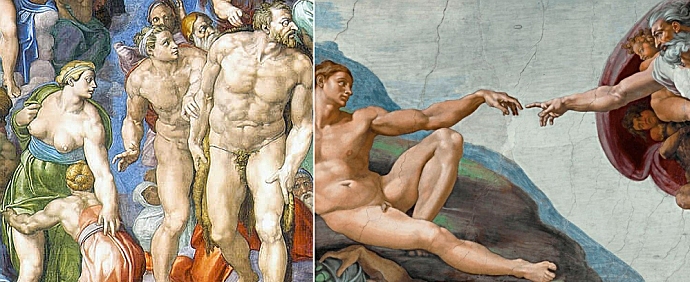
Next we have two women from the Bible named Mary. On the left is Mary Magdalene by one of Leonardo da Vinci's students, c. 1535, and on the right the so-called "Virgin" Mary holding a chubby (and naked) Jesus, a painting by Jean Fouquet known as 'Madonna and Child with Angels', c. 1454. Both these paintings would today be banned as pornography by Facebook, both for the exposed nipples, and the second also for child pornography, ie the exposed penis of the naked baby. While we don't have a a problem with the naked breasts or the baby, we wonder why artists in a very devout Christian society would choose to portray sacred characters from the Bible in such a risque manner when it hardly seems appropriate for them to do so, especially since the Bible never relates any incident, important or otherwise, where they were scantily attired.

The next Biblical painting shows Lot's daughters getting their father drunk so they can both have sex with him (and him pretending he doesn't know what is happening! Think about it, if he's that inebriated that he doesn't realise he's groping his naked daughters, then he'll likely be too incapacitated to actually perform. Unless of course God slipped some Viagra into his wine). It's by Joachim Anthonisz Wtewael, c. 1597, and is entitled 'Lot and His Daughters'. Of course as sexual (and ridiculous) as this myth is, this is exactly what the Bible says did happen, but the question is why the Church allows it to be portrayed in such an explicit manner?

Of course many of the paintings and sculptures that were produced through the centuries of Christian domination did not have a Biblical theme, nor the Biblical "justification" to include nudity, but another closely related theme that seemingly could also make use of the nudity loophole was art work concerning ancient myths from classical times, such as stories about Greek and Roman gods and goddesses. They weren't depicting stories about the Christian god, but apparently gods of every religion often liked to be naked, and were painted thus. Untold paintings were commissioned, such as the following entitled 'Diana and Actaeon' by Giuseppe Cesari, c. 1603, depicting the hunter Actaeon stumbling across the Roman goddess Diana bathing with her forest nymphs. Outraged she turns him into a deer who is then killed by his own dogs. Obviously this myth was chosen simply as an excuse to paint naked women, as were other myths in numerous other paintings. And time and time again the Church inexplicably let it slide, never condemning the paintings for their nudity, or for promoting stories about false gods. It's said that the French painter Gustave Courbet criticised 'the hypocritical social conventions ... where eroticism and even pornography were acceptable in mythological or oneiric paintings'.

But the more the Church turned a blind eye or even encouraged nudity in supernatural-themed art work the more artists pushed the envelope and started including nudity (mostly female nudity) in art work that had nothing to do with gods, Christian or otherwise. Real events from history became a popular subject to feature nudity (as it always had for ancient cultures), for example Egypt's Cleopatra became the focus of untold paintings, such as 'The Death of Cleopatra' painted by Jean-André Rixens in 1874, shown below:
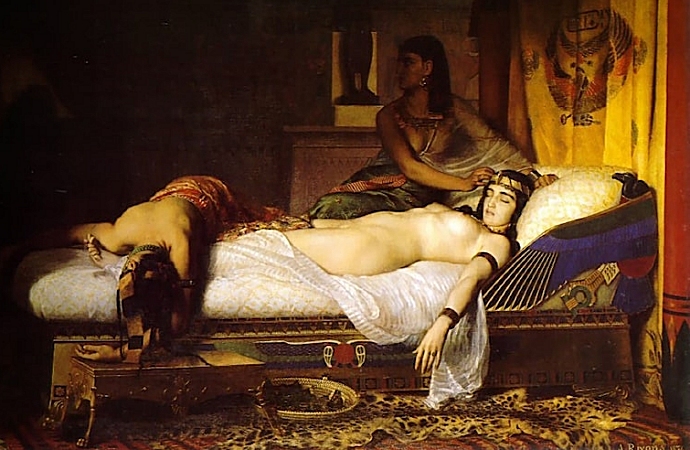
Another famous artwork is one commemorating the July Revolution of 1830 that toppled France's King Charles X (and not the French Revolution of 1789 as is sometimes thought), Eugène Delacroix's 1830 painting 'Liberty Leading the People' (below):
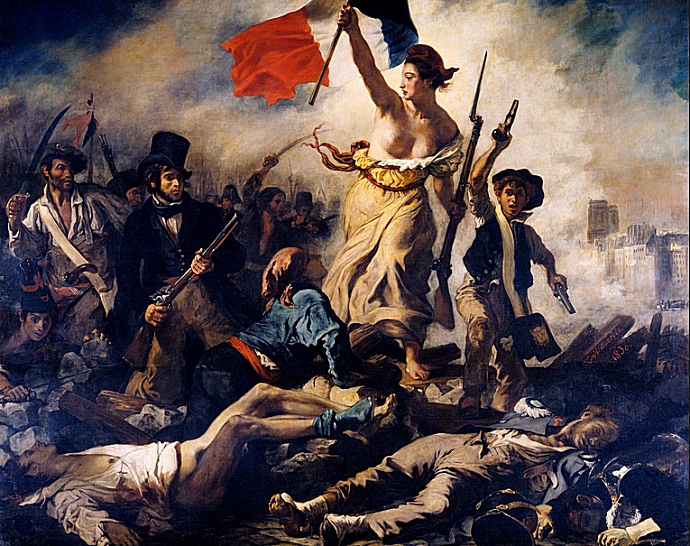
However both of the above paintings (and untold others) employ a misdirection, and that is the implication that what is being shown is 'based on a true story'. It's an event that really happened, and as such artists have a responsibility to be truthful, even if some elements of their paintings, like the nudity, might make some people uncomfortable. And indeed Cleopatra did commit suicide aged 39 and the July Revolution did happen, but there is no evidence that Cleopatra died naked on her bed or that a topless French woman led that revolution. In both cases the added nudity is utterly gratuitous, introduced solely to titillate male viewers. As an aside, this ploy is one that modern artists working on Hollywood movies have now adopted with a relish in their many movies 'based on a true story', introducing characters and dialogue and events and, yes, naked bodies, that were never actually part of the 'true story'. All were added to make their product more enticing to the viewer. We believe that regarding most Hollywood movies that claim to be 'based on a true story', they should be forced to employ the following statement that flashed on the screen at the beginning of the movie 'The Big Year' (2011). If only they could all be so honest.

But we digress ... By the 1800s the Christian Church had largely lost its power to dictate what artists painted, and consequently paintings started to include nudity in scenes of ordinary life where nudity didn't even make sense. As we've said, we now talk of gratuitous nudity appearing in movies, but it happened in paintings first, as the example below shows, entitled 'Luncheon on the Grass' c. 1863, by French painter Édouard Manet. Typical of untold paintings in the Christian era, women appeared naked or topless for no good reason while the men remained clothed and dignified. Clearly these are just white men painting nudes for frustrated wealthy white men in an era still waiting the arrival of erotic photography, then girlie magazines, strip clubs, stag films and finally internet porn.
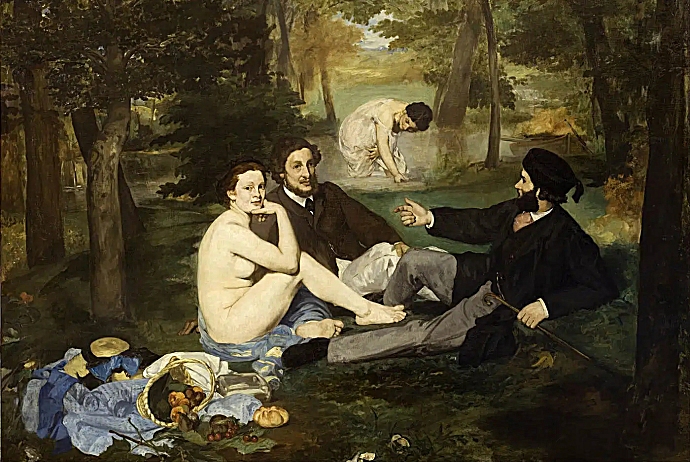
But we have to remember that these old paintings and sculptures (with and without nudity) that are now quite famous and have been seen by millions of people either in movies, TV shows, photographs or for real in an art gallery or museum would have been unknown to almost everyone when they were produced and for the centuries that followed. Literally only a handful of people would have ever got to see them. They would have been commissioned by a wealthy male and when completed would have been essentially hidden away in his mansion and seen only by a few wealthy folk that he invited to his home. And this applied equally to art commissioned by the Church, most were destined for the pope's or a bishop's residence, not for churches that the ordinary folk attended, so again, unless you were some important person that would get invited to the Vatican or some bishop's lavish home to discuss some matter with the Church hierarchy, then all this fancy artwork by famous artists remained out of sight of ordinary men and women. Getting to see this artwork throughout the centuries would be as rare as getting invited to lunch by the King of England or the President of the United States is today. Some more risque paintings and sculptures were literally hidden from view and only taken out and shown to a very select few with like-minded tastes. The Church would have been quite unaware of the existence of untold pieces of art that they would certainly have condemned had they seen them. The perfect example is a painting (below) called 'L'Origine du monde' [The Origin of the World] by French painter Gustave Courbet in 1866. As the Musée d'Orsay states on its website (a museum in Paris, France), this painting 'epitomised the paradox of a famous painting that is seldom actually seen'. It is believed to have been commissioned by Khalil Bey, an Ottoman diplomat, whose debts forced him to sell it a couple of years later and it subsequently passed through a series of private collections until it was obtained by the Musée d'Orsay in 1995 where it finally went on public display.
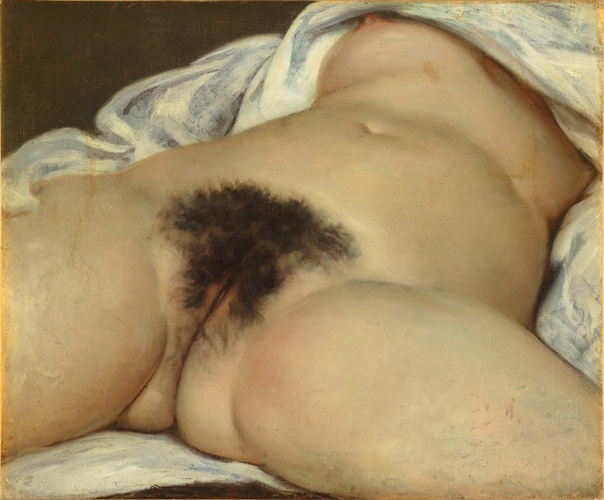
Today many people are familiar with untold examples of famous artwork, from the Mona Lisa and the Venus de Milo to the fabulous treasures found in the Egyptian tomb of Tutankhamun, but that wouldn't have been the case for most everyone throughout history who would have been quite ignorant of the art found in the homes of the rich and powerful, and remember this is where most of the art was. This was long before the creation of public art galleries and museums, and even when they made an appearance, initially only the elite in society ever got to wander their halls. Again, for most people through the centuries the amazing pieces of ancient and classical art that we in the 21st century are quite familiar with essentially didn't exist for them. They had no knowledge of it, and therefore no opinion on its merit, and its subject matter, such as nudity, didn't influence behaviour or society in the slightest. Today a photograph can travel the world and be viewed by millions in seconds, but in historical times the best they could do was produce a painting that never moved further than the artist's studio to the house it was hung in, and was never seen and admired except by a few lucky visitors. Regardless of whether some people viewed the nudity in some of these paintings or sculptures as beautiful or scandalous, only a pitiful handful, almost none when you take a country's population into account, ever had the chance to form an opinion one way or the other. We can't look at a painting from historical times that features nudity and then talk of the influence it likely had on the society of the day, because for all intents and purposes the society of the day never saw the painting or likely even knew of its existence. So to return to this counterargument that Christians portrayed nudity in their art just as openly as ancient cultures did, that they weren't suppressing or condemning depictions of the naked body, this argument fails when one realises that nudity in Christian-era art was literally invisible to most Christians, hidden away in private collections belonging to society's elite, both the wealthy aristocracy and the powerful Church hierarchy, and seen by almost no one. Of course in the ancient world the rich and powerful also possessed the bulk of their culture's art (just as today), most of it never seen by the plebs, but unlike the Christian era, in the ancient world there was still art typical of the culture found in public places that the ordinary person frequented, like in the temples and at monuments where everyone worshipped, or the murals, statues and paintings found in the Roman baths where everyone, from master and mistress to peasant and slave, bathed. Most people in ancient times (and through much of the Christian era) couldn't read and so the only simple and visual way for rulers to convey stories of gods, goddesses, kings and heroes to the people was through images in public paintings and sculptures. And the reality is that nudity in ancient art was displayed as representative of those cultures, it was normal and accepted as part of life. Ancient art was showing characters, such as soldiers, athletes, slaves and dancers, who would have often been naked in real life, and also gods and goddesses who, while obviously not real, were believed to often be naked, and perfectly comfortable with being naked. And if the gods and goddesses had no problem with nudity, or sex, then why should their followers. However nudity in Christian-era art was very different, as it was largely nonexistent, at least in a public sense (apart from the ubiquitous naked body of a dead Jesus), since what little did exist was hidden from public view and intended solely to titillate a very small and select male audience. The nudity in these paintings and sculptures was utterly gratuitous, it wasn't in any way representative of the events they were portraying. It was a loophole if you will, one seized on by artists to show nudity to wealthy clients searching for erotica. Naked artwork was forced into the backroom and hidden from view when the Christians rose to power and introduced their god's concept of shame and disgust concerning the naked body, and it saw them destroying and hiding naked artwork produced by ancient cultures wherever they encountered it, in addition to enforcing new censorship codes to ensure bodies, real or in artwork, remained modestly covered at all times. This notion of viewing the naked human body as obscene was not a natural thing, it was a new (and misguided) belief devout Christians had to impress on people. Christians viewed nudity (and sex) as shameful and indecent, something that must be hidden, whereas nudity (and sex) in the ancient world was celebrated as natural and was openly, proudly and publicly portrayed in their artwork, as the images below show (left to right: Egyptian, Greek, Roman, Indian).

In a 1970 documentary — 'Sexual Freedom in Denmark' — that promoted the social and psychological benefits of the sexually 'Many civilisations outside our current European frame of reference have looked upon sex as central in life and religion, and upon human love as necessary and valuable art that needs to be carefully cultivated. In other eras however, man's achievements have been buried and forgotten while dark ages of ignorance prevailed' [21].Of course the mention of 'other eras of ignorance' and 'taboos' around the naked body are clear references to Christianity. And as we've mentioned, ancient cultures weren't just comfortable portraying nudity in their art, sex was also openly displayed in paintings, sculptures and on pottery. If you're 18 or over you can view some examples of these more explicit ancient images (that even today most museums still hide away in backrooms) by clicking on the 'ADULTS ONLY' image below. These are just 
'sees the number of nudes in imagery as evidence that, contrary to Christian and Islamic attitudes, "the ancient Near Eastern attitude toward nudity was not one of prudery and fastidiousness", and that the ancients were never "ashamed of the undressed body".'And as Georg Feuerstein wrote in 'Sacred Sexuality: The Erotic Spirit in the World's Great Religions' (2003): 'It should be noted here that, generally speaking, in pre-modern times nudity — the exposure of male and female organs — was not surrounded by the feelings of shyness and guilt that characterize much of our own era. Our paleolithic and neolithic ancestors had a far more down-to-earth attitude about nudity and sex than we do. Likewise, images of the genitals, however grossly exaggerated or distorted, were by no means deemed obscene. This explains why representations of the vulva and phallus can be found in countless ancient temples and holy sites throughout the world. Obscenity is a modern notion'.Of course many religious folk and those that have been influenced by current religions don't believe our Paleolithic and Neolithic ancestors even existed, choosing instead to believe that there was nobody wandering around naked until God created the world and then (a naked) Adam and Eve some 6,000 years ago. It is belief in this relatively recent fairy tale that is the reason why religious folk think that the naked body and sex are both offensive and immoral. All because deluded, ignorant old men who lived millennia ago believed superstitious nonsense. The religious can (and do) assert that nudity and sex outside a darkened matrimonial bedroom is immoral, but an assertion doesn't make it true. You can't sin and disobey some god if that god doesn't even exist, and without God the notion of sin is meaningless, meaning anything that was once considered sinful must be re-evaluated. Christians used to quote their holy book and assert that slavery was moral and working on a Sunday was immoral, but they now agree that their moral code was wrong on both counts. Clearly their view on nudity and sex has the same flawed foundation and is equally wrong, they're just too stupid to realise it. There is no argument that can be offered that shows innocent nudity or sex between consenting adults to be obscene, indecent, offensive or immoral. Saying that you're obeying the commands of an imaginary sky fairy is not an ethical argument, it's an admission of ignorance and blind servitude. It's a failure to live up to your potential as an independent, free-thinking adult that is contributing to the betterment of society. In simple terms, rather than reducing harm, you're causing harm by being a useless, scaremongering, deluded prude. There is actually a third reason some people don't want to see nudity, and that is that it sickens them. It has nothing to do with being harmful or sinful, to them the naked human body, male and female, is simply quite gross to look upon, and generates feelings of revulsion and even nausea. One comment we saw was that objections to nudity can be justified solely on 'aesthetic grounds: seeing others naked can violate our visual sensibilities'. For some this revulsion extends to the naked male chest and female nipples or the sight of a bare ass, but for most it's the sight of male or female genitals that truly sickens them. Even clothing that reveals the form of the genitals is too much for them, such as the Lycra clad cyclists we mentioned at the start of this article. These are the people that never undress in front of their partners, that bathe wearing a chemise, that have sex with the lights off, that lie back and think of England and get the disgusting deed over and done with as quickly as possible. I was reading a book awhile back on the history of slang, and when Francis Grose (1730-1791) wrote his dictionary of slang words, for the word "Cunt" — a slang term for the female genitals — he wrote this less than informative entry: 'C**t: a nasty name for a nasty thing' (And yes, he refused to even spell it fully!) I also read recently that it's not surprising that the anatomical term for vulva is 'pudenda membra'. That's a Latin description which originated in the mid 17th century and translates as 'parts to be ashamed of', it's what they might have called, to paraphrase Grose's definition, 'a fancy euphemism for a nasty thing', a term refined gentlemen could use instead of the nasty C word. And while pudenda technically describes the external genitals of both men and women, these days it will usually, especially in "polite" literature, be referring to the vulva. So for centuries people, especially the educated elite, doctors and priests (who would have all understood some Latin) were using a negative term that told them exactly how they should feel about genitals, especially those of women, and that was that they should be ashamed of them. These folk look at genitals, their own or that of others, the way normal, well-adjusted people look at dog shit on their shoe: Eww yuck ... disgusting! What they see is not something that's going to generate lustful desires and cause them to harm others, they don't see it as immoral, it's simply something that's very unpleasant to catch sight of, something they'd rather never see.
But what generates this revulsion of the genitals, and is it rational? Sure, the genitals are not usually in the running for most beautiful body part, but neither in my view should the likes of the ear or the big toe be considered. I'm not even a great fan of the elbow. But people aren't repulsed by the sight of ears, toes or elbows. And the reason is simply because we're all used to seeing the ears, toes and elbows of other people, but not their genitals. It's that unfamiliarity that shocks and unnerves people, not the genitals themselves. Since they were toddlers, people have been compelled to keep their genitals hidden from others, with the argument being that they are offensive to look upon and certainly not what others want to see. So it's not hard to see why some people view the genitals as repulsive, since it's been a self-fulfilling message that's been playing in their mind their entire life, from family, friends and society. And this creates a real problem when these people are confronted with innocent nudity in the likes of a pool changing room or erotic nudity in sexual encounters. How can they behave appropriately, meaning ignoring the nudity in the changing room and embracing it in the bedroom, when their upbringing has conditioned them like Pavlov's dogs to be shocked We are all quite accepting and comfortable with the ears and noses, knees and elbows, hairstyles and clothing choices of friends, family, colleagues and even strangers on the street. While there is a lot of variety and we may prefer some over others, a nose is still a nose, and we never ask someone to wrap a scarf around their nose before we talk to them. We should be able to look on the genitals the same way we accept a nose or an exposed ankle, as just another part of the body. Humans are not born with a demarcation line on the body to show where innocent skin turns into offensive skin, where a cute navel lies just over the border from gross pubic hair.
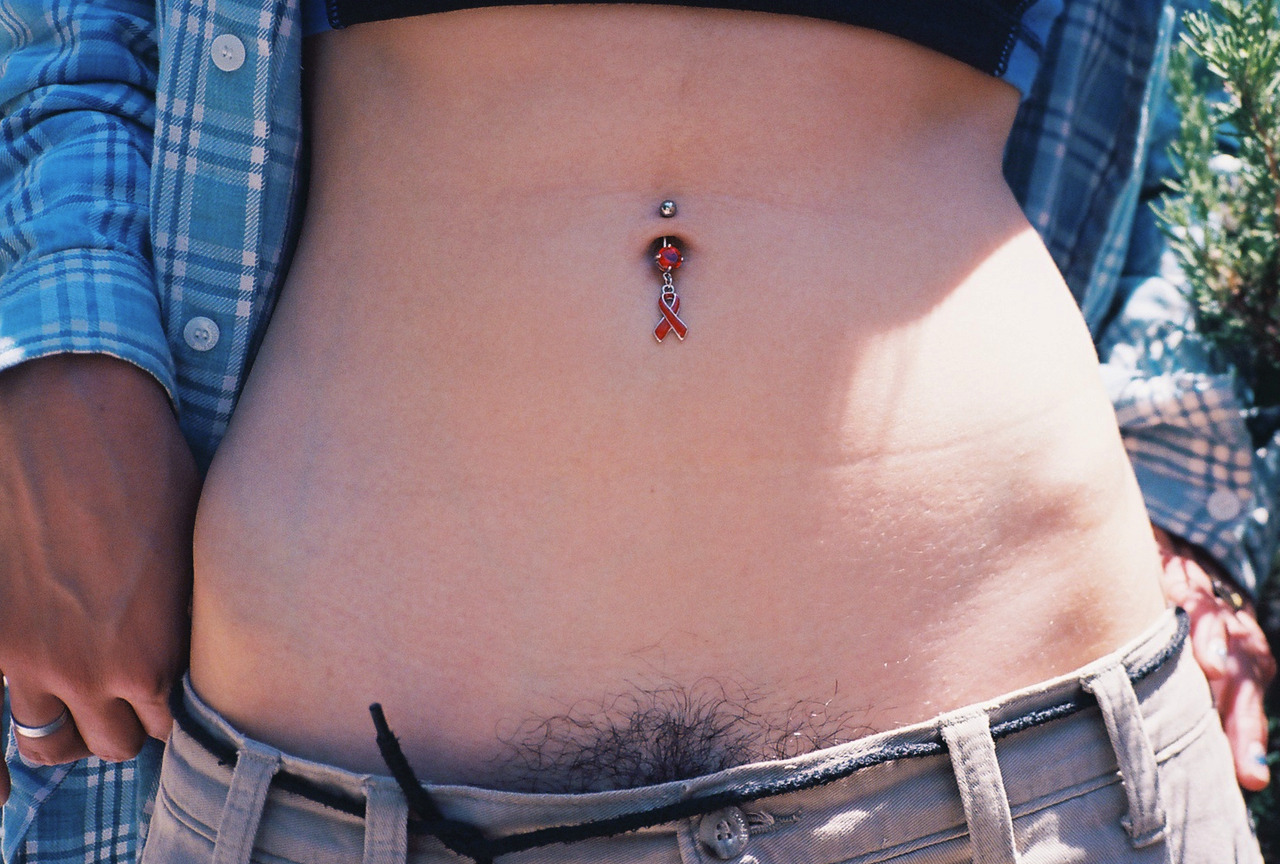
Most people we know that find nudity offensive are probably of this ilk, they have been told so often that our genitals are ugly and gross, and everyone they know goes to great lengths to hide theirs, that they have convinced themselves that it must be true. Society has created this problem, convincing people that there is a monster in their pants that must remain hidden at all costs and never spoken of. Western countries cover up nudity the way Muslim countries cover up their women, both foolishly thinking that some things must forever remain hidden for the good of society. If decent, upstanding citizens of the 1920s could see the amount of flesh on display on a beach today, with the bikinis and topless men, they would be scandalised, and yet most people today think nothing of it, having come to realise that a bare female midriff and male nipples don't corrupt society as was once thought. We need to take that final step and discard the remaining wisps of superfluous material and swim the way humans have for most of history, naked. Naked and free and unconcerned and uninhibited. At the beach we should be worried about sharks and jellyfish and sunburn, not about showing too much flesh. And the same goes for the pool and the sauna and the deckchair in the backyard, it's utterly ridiculous that we'll buy skimpy bathing costumes to reveal 99% of our bodies, but that someone should call the cops if we opt for 100%. And we think if people became more accepting of innocent nudity in the public sphere, then it would only improve their attitude in the bedroom, making them more confident and relaxed, where they could focus on enjoyment rather than guilt and shame at being seen naked. They would have realised that the human body comes in many shapes and sizes, that none is perfect, and that no one form is the ideal that everyone seeks. And that the genitals vary as much as the nose and are no more repulsive than the ear. Anyone that feels uncomfortable sighting a naked body and is sickened by the genitals in particular, really has problems and needs help if they are to live a good life. Nudity isn't causing harm, fear of nudity is. OK, so those are the silly, superstitious and clearly unsupported reasons for why seeing nudity and sex in our movies (and real life) is harmful. But as bogus and antiquated as these views are, they effectively are what guides the decisions made by the censors. And so to protect us from an imaginary harm, our movies are not allowed to show people naked as they leave their bed or shower, but we are allowed, unfortunately, to see them get shot in the head with blood and brain matter splattering all over the wall, and even then, in their death throes, they must somehow still manage to maintain their modesty, clutching that concealing sheet or towel as they fall to the floor, dead. Bleeding profusely from an horrific head wound, but thankfully keeping all the naughty bits covered, their dying concern not to shock their murderer or the police with unwanted nudity. Forget the movies, what's happening in real life? Maybe it's just us that's sick, in that we'd prefer to see a live naked body than a dead clothed one. Or then again, maybe it's not us, maybe it's those with a fixation on viewing the violent deaths of others. Is that the level society has sunk to, where watching sickening violence is preferred over natural beauty? We just have a niggling feeling that something's not quite right here. But as a society, that's where we seem to be. It's not just that nudity in the movies and in public has reduced greatly this century, it's clear that violence has at the same time increased. And it's not just graphic violence in movies, but positive attitudes to real activities involving real violence has also increased. Decades ago there used to be strip clubs where mostly men would pay to get a very brief glimpse of a naked female body, but they went the way of the dodo in most places. For a decade or so they were replaced by the occasional nationwide tour of male and female strippers, but they too died out. It seems that given a choice between naked bodies or violence, these days people would rather pay to see something that involves naked aggression and the chance of injury. Locally, we now have a group called 'Fight For Kidz' that gets ordinary men and women to fight each other in organised boxing events to raise money for kids' charities, such as the two women in the photo below. And yes, boxing matches are nothing new, but these are people that have never boxed before, they're not trained athletes, they're just people off the street, like accountants and nurses and motel cleaners. While some of the profit from ticket sales does go to a good cause, what has it come to when the community associates violence with kids, when to help kids you feel your only choice is to punch someone repeatedly with such force that you'll damage their brain and render them unconscious? And that a lot of people will pay good money to watch you do that? This year's event (2019) was in jeopardy due to a fighter dying in a similar corporate event in Christchurch, but we've just read that it's all on again, and they hope to get over 140 ordinary men and women fighting each other. Not just a dozen or so, but 140! Clearly the real risk of boxers being injured and even dying is not enough to stem the blood lust, and indeed, like the ancient Romans and their gladiators, perhaps it's precisely what the audience craves?
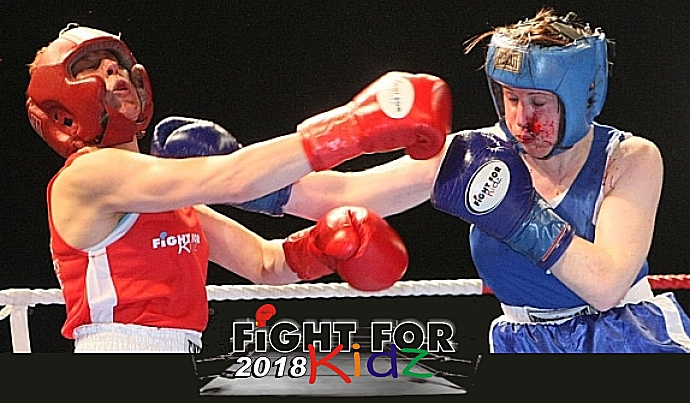
Our national sport is rugby, a physical contact sport where tackles cause everything from bruising and concussion to severe injuries that can see players sidelined for months. On rare occasions players have even died, and there is increasing evidence that concussion can lead to brain damage later in life. But unfortunately society has a deplorable macho attitude to violence on the sports field. While it's against the rules of the sport, players can violently assault each other and the worst that might happen in a punishment sense is that they will be sent off and perhaps forced to sit on the sideline for a couple of games. If we committed a similar assault on the street, or even just pushed someone, we'd be arrested and charged. Many players have tackled opposing players in such a manner so as to deliberately injure them and remove them from the field. The message to society is that violence is not unexpected on the sports field, since it's a contact sport and a man's game, and only gutless losers would walk away from a fight. Long gone is the idea that sports still has any connection to that quaint notion of sportsmanship. And what does our national rugby team now do before every game? They perform a primitive war dance known as a haka that has one traditional objective, to intimidate their opponents in a coming battle. They feel they must win at all costs, they truly see their opponents as an enemy that must be defeated, by any means, even if that calls for tactics more appropriate to the battlefield (or prison yard) than the sports field. When I played rugby in my teens, we never sought to harm the opposing players or win by cheating, and after the game we would often socialise with the other team. But today, the All Blacks, after their games, flee back to their hotel and deliberately avoid any contact with the other team. They may have won a battle (or not), but the war is ongoing, and there will be no fraternising with the enemy. We hate this 'win at all costs' attitude, remembering that we're talking about a game, not an actual war. But this 'do or die' attitude is the one that far too many in society believe in, that defeating an opponent — in a game — is all that matters in life, and that talk of simply enjoying the encounter, no matter who wins, is for wimps and losers, and dare we say it, girls, not for real men.
Then we have Maori, the people from whom the All Blacks stole their haka. Unfortunately Maori are over represented in our prison population, gangs, crime statistics, poor education outcomes, high unemployment rates etc, On the TV news we're shown real scenes of unarmed black men being shot in the back by US policemen as they run away, terrorist bombs exploding in crowded markets and the bloody aftermath of dead bodies and limbs, young children in Syrian hospitals screaming in pain as doctors remove shrapnel, bodies being pulled dead from devastating earthquakes and washed up on the shore after human smuggling boats capsize, starving children in Africa that look like stick figures and are near death, video of people that have suffered horrific facial injuries and graphic shots of surgeons operating on them. And on and on this parade of distressing and shocking images goes. And we're not saying we shouldn't be shown them, we need to see them so that we can be aware of what's happening in the world and respond appropriately. We shouldn't be sheltered from the harsh side of reality. But why do those in charge of the media think that we can handle seeing a chest sliced open by a surgeon or a face that was disfigured by a shotgun blast, but that simply seeing a woman's nipple, let alone a penis, or Zeus forbid, an erect penis, will corrupt society and send us spiralling back into the barbarous and uncivilised dark ages?
'hypocritical, with everything you see on TV. There are more important things to focus on than a woman's body part, which is a beautiful thing ... and for this to be such a focus, I don't understand'.Neither do we Janet. No doubt Americans would have cheered had she whipped out a semi-automatic pistol instead. Why do people have such a love/hate relationship with women's breasts — love the breasts, hate the nipples? On the Internet, popular sites such as Facebook, Instagram and Tumblr understandably have a ban on pornography, but they also ban images of innocent nudity as well, including genitals and female nipples. On Facebook, even photos of mothers breastfeeding was banned, although back around 2015 they claimed that they had relented on that one. But not really, as in Nov 2018 they banned a young mother from their site for posting a photo of herself breastfeeding, saying that a photo showing "sexual content involving minors ... doesn't follow our community standards". Seriously, Facebook thinks breastfeeding is a sexual act, and millions of idiots agree with them.  For The Girls of Apartment 408's view of Facebook, click on the cartoon strip (right) to view a larger image. Many in NZ are just as bad, we still have people, surprisingly it's mainly other women, who cause a real fuss when a mother breastfeeds in public. (Click here to view an excellent parody, using a kid's comic strip, of society's disturbing embrace of violence contrasted against its abhorrence towards breastfeeding.) And depressingly, while NZ has led the way in revamping other laws, breastfeeding in public is still not specifically protected by NZ law. A report entitled 'Protecting, Promoting and Supporting Breastfeeding in New Zealand' writes that, 'It is likely to be possible for a mother to assert her right to breastfeed under the Human Rights Act, although it must be noted that a mother's legal right to breastfeed has never been explicitly affirmed by any New Zealand court'. Hence breastfeeding mothers can and are still being ordered from cafes and food halls and harassed by ignorant prudes and the police do little to help (the latest incident we read about was in Auckland in 2020, where a mother was asked to leave an indoor playground 'so that she didn't make other people feel "uncomfortable".') Why do people fear the female nipple, and yet not the identical male nipple? And yes, they are physiologically the same, it's not just superficial. Male nipples can lactate if the correct hormones are produced. It's a question that has long mystified religious folk — Why do men have nipples, what was God thinking? Hint ... it's actually answered by evolution, not by resorting to prayer. For The Girls of Apartment 408's view of Facebook, click on the cartoon strip (right) to view a larger image. Many in NZ are just as bad, we still have people, surprisingly it's mainly other women, who cause a real fuss when a mother breastfeeds in public. (Click here to view an excellent parody, using a kid's comic strip, of society's disturbing embrace of violence contrasted against its abhorrence towards breastfeeding.) And depressingly, while NZ has led the way in revamping other laws, breastfeeding in public is still not specifically protected by NZ law. A report entitled 'Protecting, Promoting and Supporting Breastfeeding in New Zealand' writes that, 'It is likely to be possible for a mother to assert her right to breastfeed under the Human Rights Act, although it must be noted that a mother's legal right to breastfeed has never been explicitly affirmed by any New Zealand court'. Hence breastfeeding mothers can and are still being ordered from cafes and food halls and harassed by ignorant prudes and the police do little to help (the latest incident we read about was in Auckland in 2020, where a mother was asked to leave an indoor playground 'so that she didn't make other people feel "uncomfortable".') Why do people fear the female nipple, and yet not the identical male nipple? And yes, they are physiologically the same, it's not just superficial. Male nipples can lactate if the correct hormones are produced. It's a question that has long mystified religious folk — Why do men have nipples, what was God thinking? Hint ... it's actually answered by evolution, not by resorting to prayer.
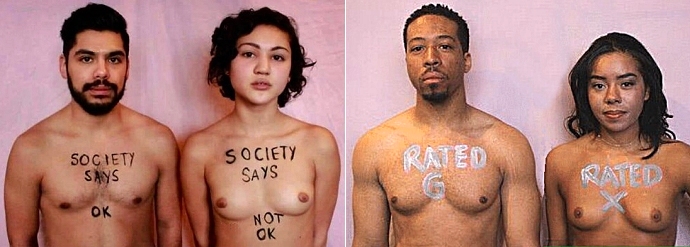
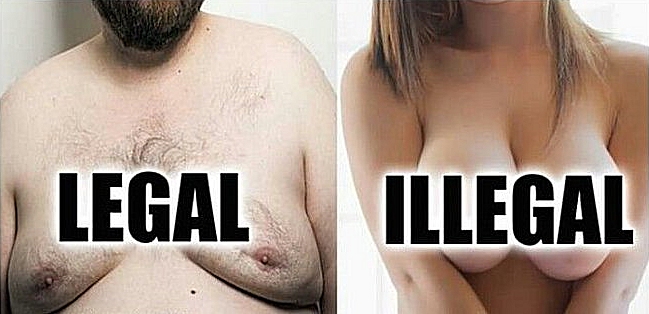
And as we know, it is the female nipple that is feared, not the breast itself, as women often go to great lengths to display their breasts, with low cut dresses, see-through outfits, micro bikinis, even just with pasties or a little tape etc, and are never arrested or harassed as long as their nipples are not exposed. We simply don't understand why a naked breast is obscene and yet the same breast with no more covering than a small (often postage stamp size) piece of cloth over the nipple is not just legally acceptable, on beaches, on social media posts, on TV and in newspaper, it's something that most women like displaying and most men (and many women) like looking at. Why are the photos below of young women (including comedian and actress Chelsea Handler, bottom left, encouraging Americans to vote with 'I VOTED' nipple stickers and singer Miley Cyrus, bottom middle) quite acceptable simply because the only thing about their breasts left to our imagination are their nipples? And it seems especially silly and childish to hide them when we all know what nipples look like, because we all have a pair.
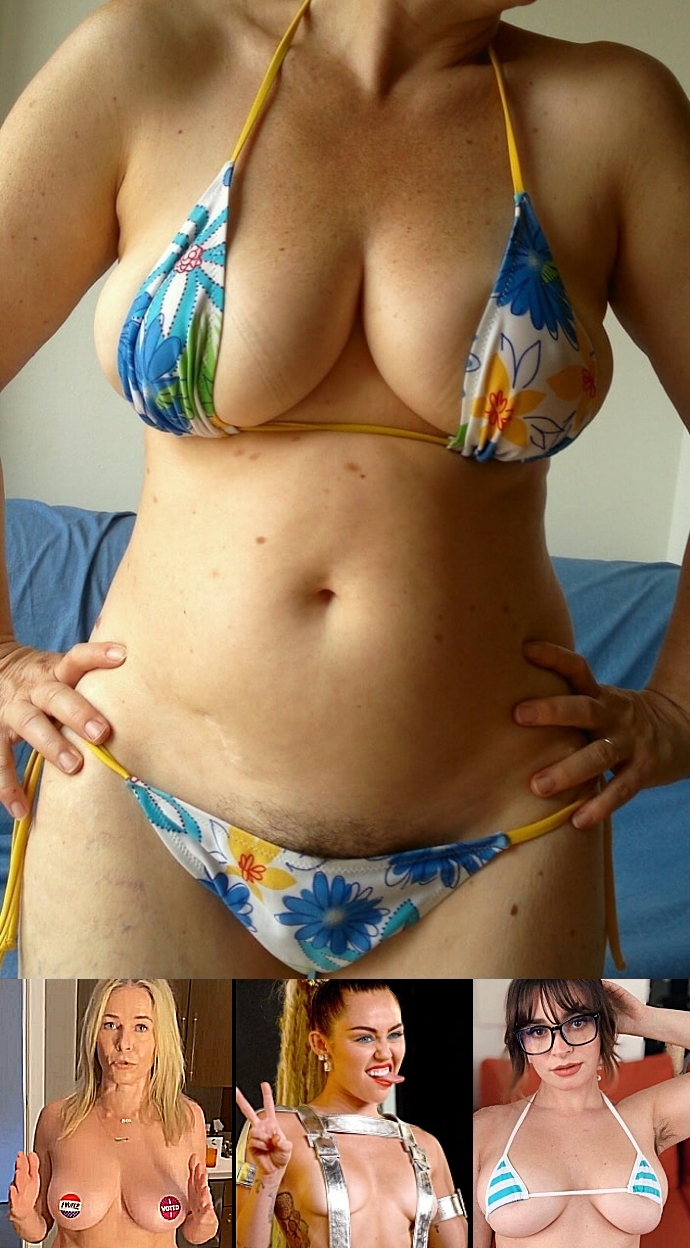
Recently a magazine for women, the 'NZ Woman's Weekly', refused to run a breast cancer awareness advert because a photo showed a woman's nipples, saying that, 'readers might not accept the image'. Likewise, we remember seeing a news article back in 2013 with the heading: 'Nipples banned from TV breast cancer ad', and that said in part: 'Kiwi prudishness has complicated the Breast Cancer Foundation's adaptation of a Scottish advert credited with a massive increase in breast cancer awareness in Scotland. The foundation said it had to find creative ways to get its message across after the Commercial Approvals Bureau told it nipples were not allowed in television advertising. [The Bureau argued that] the prevailing view was people did not want to be confronted by nudity during primetime television'.What utter bullshit. If the bureau's statement about primetime TV is to believed, then it seems to suggest that people think it's OK to put nudity in time slots outside primetime, just not in primetime, like in the afternoon when children are watching their programs perhaps? The reality is that primetime is when adults are watching and when adult content is expected. The utter stupidity with the bureau's stance is that adult viewers were prevented from seeing a public service advert that could reduce suffering and save lives, simply because we would have seen some nipples, and yet at the same time we remember watching the 1990 sci-fi movie 'Total Recall' on TV, in primetime, and it showed nipples in abundance, merely for entertainment. You may remember this scene with the amply endowed prostitute on Mars propositioning Arnold Schwarzenegger:
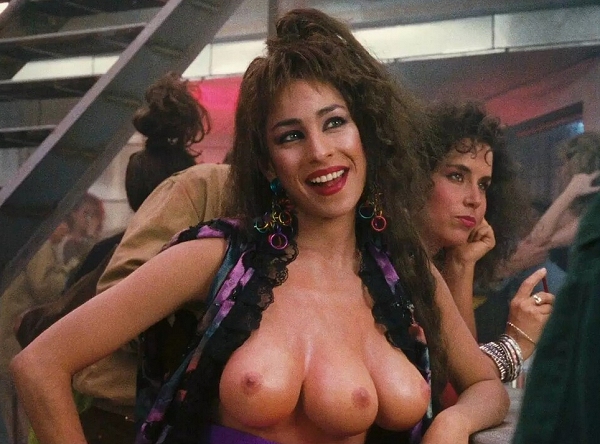
Admittedly, as we're arguing in this article, there isn't very much nudity in movies, especially compared to violence, but we all know that occasionally there is some, and when there is, it's most likely to be topless women, nipples included. So how is it that those people that censor our movies think we can safely be confronted with a brief flash of nipples, and these days the breasts, like the violence, are most likely fake, but at the same time those that censor our adverts believe that we couldn't handle seeing nipples in a TV advert about breast cancer? Do they not talk to each other or read the same studies on what the prevailing view of society is? What handful of old prudes clutching their Bibles have somehow decided that adults don't want to be confronted by nudity during primetime TV? No one ever asked our opinion. A year or so ago I watched a TV documentary on tourism in the Greek Islands (filmed around 2010 I think), and the locals said that a few decades ago nudity on the beaches was normal and widespread, but now it's rare. (And I can personally confirm that nudity on European beaches as a whole has declined to the point where you're now more likely to see Bigfoot than a naked sunbather.) While they were filming on some beaches, if a rare naked bather did walk past, and even though they were in the distance and it was hard to tell if they were even male or female, they still felt they had to protect us viewers by censoring the blurry stick figure with big black dots. Consequently I slept well that night, no nightmares of beautiful naked bodies on sun-drenched beaches. Thank you TV censors. As we've said, we've watched TV news items where some women campaigned for the acceptance of breastfeeding in public, and they've been opposed and abused not just by men, but by other women as well, both arguing that it's obscene and offensive. How bad has it got when even women argue that their own bodies are offensive? In 2016 during a publicity stunt in a "naked restaurant" in Hamilton, NZ, TV3's now defunct current affairs show 'Story' featured the "accidental", fleeting and completely innocent shot of the genitals of a nude waitress named Tyler (below), which was quickly followed by a flood of complaints from viewers and then groveling apologies from the show's spineless presenters.

Almost every night we see images on the news and in movies that we genuinely do our utmost to erase. Everything from real images of wars and disasters to movie images of torture, murder, rape and rampaging zombies devouring screaming humans, and yet a fleeting glimpse of a beautiful, semi-naked young woman, who wasn't being killed or killing anyone, or even having sex, she was just walking past, this was the image that people complained about and was the image that generated profuse apologies. We just can't get our heads around how so many people can believe that a glimpse of a woman's nipple or pubic hair or a penis or even a naked ass can be so damaging to our psyche, even though you'll notice in the image of the waitress that you see none of those shocking things. Apparently there is something so disturbing about the naked body that we must be shielded from ever catching sight of it. And yet we can all, even children, be flooded with images of graphic violence and unspeakable suffering and apparently not be affected by it at all. One aggrieved mother railed on the program's Facebook page: 'That live nude shot was not necessary! I get that you wanted to show this new restaurant etc but my young daughters and I didn't need to see a vagina, a parental guidance warning would have been appreciated!!!'She was so annoyed that she felt her complaint warranted three exclamation marks. She was of course wrong in that viewers were given plenty of warning, and seriously, what could one perhaps expect to see at a "naked restaurant"? But that wasn't all she was wrong about. We don't understand why many women, who of all people should know their own body best, want to falsely insist that they've seen a vagina, and worse still, that it was truly traumatic. Even the waitress later made the same mistake in identifying her body parts, saying, 'Okay so it's a vagina, so what?' Clearly more public shots of naked women are desperately needed (or should that be pubic shots?), if only as a public service, with informative labels attached, when even women don't know that the vagina is internal to the body, it's as unseen as her womb or her liver, and the correct anatomical name for a woman's visible, external genitalia is vulva. The only person that might have viewed her vagina would be a gynecologist. Men don't get caught naked and say, 'Oh dear, my towel dropped and she saw my prostate'. And yes, there are untold euphemisms for both male and female genitals, but vagina is no more a euphemism for vulva than prostate is a euphemism for penis. In her book, 'Vagina: A Re-education', Lynn Enright wrote that, 'in 2016, 60 per cent of British women were unable to correctly identify the vulva in an anatomical diagram'. Both women and men (and even some educators!) mistakenly believe they are being quite clinical and grownup when they use the word vagina, although many more still are reluctant to even say vagina, and have actually created real 21st century euphemisms for the word vagina, such as veejay, vadge and vajayjay. That's progress for you. To her credit, the waitress couldn't understand what the fuss was about, but is the typical woman repulsed these days when she sees herself naked, or her friends in the changing rooms at the gym? And if they claim they're not, then why are they so upset when they see a naked woman on TV? What's the difference? What's happened to humanity when we've sunk to a stage where men and even women are repulsed by the sight of female genitals, and in their ignorance, even mislabel them? Surely this childish mislabelling, by both men and women, shows that hiding the naked body creates not only ignorance, but worse still, implies that it deserves to be hidden, that it is something to be ashamed of, and not something an impressionable young girl should ever have to see on TV. And if you have young daughters, you should probably cover any full-length mirrors in the bathroom and bedroom to prevent traumatic shocks while bathing and dressing. You don't want to scar them psychologically for the rest of their life. But seriously, all this is especially mystifying since we all see nudity every day of our life — at the very least our own, while showering and dressing — and it doesn't faze us at all, in fact most of us are perfectly comfortable with our own nipples and naked asses, and many of us actually love seeing the naked bodies of our lovers, or those we wish were our lovers. Why are most adults happy to see shocking and disturbing acts and graphic violence portrayed in movies and on TV, and often watch it alongside their kids, and yet if they see some innocent nudity (other than when they're secretly watching porn), they get all upset, screaming that it's offensive and disgusting to see others naked? Apparently the only place where nudity is acceptable is in their private sexual fantasies. Even on the TV news a while back we once again had the male news readers almost retching when they showed a picture of Tiger Woods without a shirt on, and then again later on when a similar image of Russia's President Putin was shown shirt-less on a horse, with them moaning that there is no reason we need to see pictures like that, especially around meal time. And they were serious. Even though it wasn't even nudity, they apparently felt that it's inappropriate to see adults that aren't fully clothed. As repulsed as they were by what they were screening, it seems they were showing these pictures as a public service, with the implication being that we should all condemn and ridicule people that think bare flesh is acceptable outside the privacy of the bedroom or bathroom (besides that is, supermodels and porn stars with the "perfect" bodies). We're really appalled at how prudish many people are becoming, insisting that the only time we should see other adults naked, real adults that is, and not just "movie" adults, is when we're having sex with them. Movies — more violence, less nudity?
'A young woman wears a short top that exposes her bare midriff.'It's truly sad that some people are shocked and offended by a person simply relaxing in a bathing suit, that their mind immediately connects this innocent pastime with improper sexual thoughts, but how repressed and prudish, how mentally challenged, do these people have to be if simply seeing a woman in yoga pants or even just a man's bare feet in a hot tub is still screaming sex and nudity. Disgusting sex and indecent nudity that we all need to be warned about. What about where viewers are cautioned about a movie scene in which 'A man and a woman hold hands'. Seriously ... is that a sex scene or a nudity scene, or both? We're confused. What about the warning that, 'A woman wears a suit dancing', what does that even mean? Our only guess is that it's some Biblical homophobic thing, that men wear suits and women must not wear men's clothing, so therefore this woman must be a lesbian, and thoughts of lesbians makes one think of two beautiful women having sex with each other. And remember that saying from the Bible, 'anyone who stares at a woman with lust for her has already committed adultery with her in his heart'. So, simply seeing a woman wearing a suit in a movie makes one commit a horrible sexual sin, so ... umm ... avoid that movie, strike it from your list lest you be tempted to think corrupting thoughts. Of cute lesbians. In the minds of these deluded fools people are naked and/or engaged in indecent sex acts even when their nudity is obscured by actual clothing (so not nudity at all) and they are behaving quite innocently and non-sexually. Commenting on a movie, one poster warned of: 'frontal female nudity (pubic area obscured)'. WTF? If the pubic area is obscured then there is no full-frontal nudity, that's as silly as saying, 'frontal female nudity (pubic area obscured ... by a bikini). Full-frontal nudity by definition means with nothing concealed. What a sheltered upbringing they must have had. They see men or women wearing something less than a burqa or a large puffy jacket and baggy trousers, something that exposes an ankle or reveals the shape of the thigh or (shock and disgust) a bare shoulder, and their tiny minds immediately start fantasising about how the character's inappropriate dress and behaviour will quickly lead to naked sex. These prudes really need to grow up and stop pushing their ignorant views on those of us whose worldview is not still mired in the Middle Ages or some holy book. None of the above comments (and unfortunately they are anything but rare, untold movies have such inane comments) should ever have been approved by IMDb since the scenes clearly have nothing to do with sex or nudity, except for the fact that they all involve fictional characters that could potentially get naked and/or have sex at some later time in some unrealised X-rated version of the movie. The people writing these comments are clearly basing their warnings not on what they see on the screen but on their sex-obsessed fantasies, on what they imagine could (would) happen if they were watching a hardcore pornographic movie instead. Mainstream movies refuse to show real sex and show only hints of nudity, they rely on the viewer to greatly enhance the scene in their imagination and create a far more graphic vision in their mind of actions that weren't performed and flesh that was never actually revealed, and the repressed minds of the prudes that made the above comments were clearly running in overdrive. As an example of how naive viewers are fooled into believing they saw things they didn't, below is a screenshot from a western I watched recently, 'The Duel' (2016), where in IMDb's 'Sex & Nudity' section a viewer had added the following comment: 'One scene with woman in see through nightgown. You can see that she is fully nude underneath.'
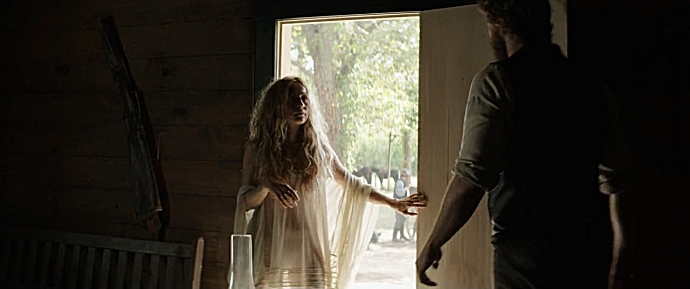
The woman in the above image was a prostitute working in the saloon who went to the sheriff after being badly beaten, however the clear reality is that you CANNOT 'see that she is fully nude underneath'. The gauzy material of the nightgown, the back-lit lighting and the woman's silhouette merely suggests that she is naked. It's almost certain that the actress was wearing underwear, possibly white or flesh coloured, and where there should likely be the hint of a dark pubic triangle, this was the 1800s after all, this area is strangely lighter than the surrounding skin. This scene with its deliberate lighting and clothing choices certainly wants the viewer to believe she is naked beneath her nightgown, but it is done solely with suggestion, it's all in the viewer's mind, since the scene definitely doesn't show a naked woman. Claiming that we can see the actress is fully nude is as bogus as claiming that we can see that she really had been badly beaten. Of course the actress didn't actually have to get naked beneath her nightgown or really be beaten to convey the impression that she was nude and badly injured. It's worrying that so many movie viewers can be so easily fooled by what they think they see on the screen, when in fact their imagination is doing all the real work. To demonstrate the difference, a few days after watching 'The Duel' and in the mood for another western, I stumbled across a 1975 movie called 'The Girls of the Golden Saloon', a western made in France but dubbed into English, a crappy movie (as it turned out) whose only redeeming feature was to show that back then the Europeans actually knew how to show that a woman was truly naked under her see-through nightgown, as the following screenshot shows. Recall that this was a time when, to give the impression of nudity, producers simply used real naked women in their movies. They had to fake the deaths, fights and gunshot wounds, but not the nudity. Unlike today they didn't even try to think of ways to fake the nudity, of making us think we saw something that we didn't. It was such a radical concept, the belief that realism trumped fakery, and that such innocent nudity wasn't in any way harmful to the actresses or the viewers, but unfortunately such enlightened thinking wasn't to last. The prudes would stage a comeback.
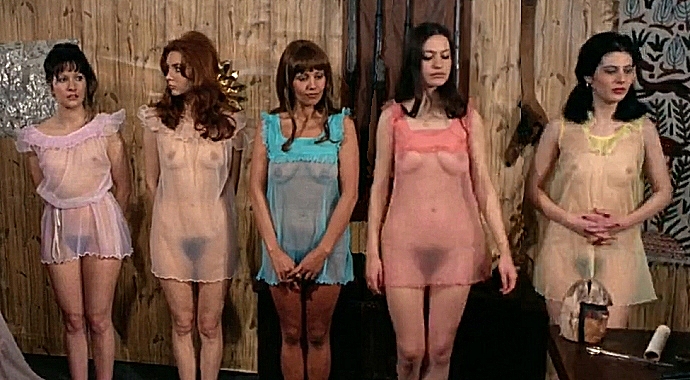
Of course not all the advisory comments in the 'Sex & Nudity' sections are so childish, as if written by Catholic priests tormented by their own forbidden erotic fantasies, many comments do refer to actual movie scenes of sex and/or naked bodies, not just imagined scenes playing out in their minds. And of course it should go without saying, but obviously many prudes are so ignorant that we must again remind them that actual sex scenes in mainstream movies and TV shows are clearly fake, not really sex at all, just pretend sex, and the nudity in modern movies is also often fake, it being sometimes easier for filmmakers these days to use CGI or to glue on a merkin than convince a reluctant actor to perform naked, especially since some American actors now insist on contracts with no-nudity clauses. That said, if we ignore the (many) ridiculous comments about bare shoulders and cheerleaders in miniskirts, the other comments made about this fake sex and nudity seem to be written with one of two purposes in mind. There are the comments apparently written by prudish parents wanting to warn other prudish parents that the movie has scenes of fake sex and nudity that looks real (at least to other prudes), so for God's sake, keep it away from the kids. Then there are the comments clearly written by newly pubescent and frustrated teenage boys advising other like-minded teenage boys whether a movie has any good sex and nudity scenes starring their favourite actress that they really need to see (with some lube and a box of tissues handy). The prudish parents are warning people to avoid the movie due to certain deplorable scenes, the horny teenagers are recommending it for the same scenes. The only thing that both the prudish parents and the horny teenagers have in common is that they both view scenes of innocent, non-sexual nudity, such as someone dressing or playing volleyball on a nude beach, as always being sexual, when it is only their depraved mind that makes it so. To be fair, not all the comments on IMDb are from people raised by monks, nuns or Muslim imams, many sane, rational, intelligent people view movies as we do. For example, the comment below concerned an action movie (a truly crappy movie) where untold (mostly innocent) men and women were violently kidnapped, beaten and killed (plus untold women were repeatedly raped but this was not shown on-screen). This content saw the movie receive a rating of: 'Violence & Gore: Moderate'. As for sex and nudity, while it was implied that sex was happening off-screen, there were no sex scenes shown and no full frontal nudity, the only nudity involved several topless women, and yet this mild content saw the movie receive the highest rating possible for its category: 'Sex & Nudity: Severe'. Below are two screenshots from the movie, one shows a man dying after having his throat cut with a sword and the second shows his killer, a topless woman.
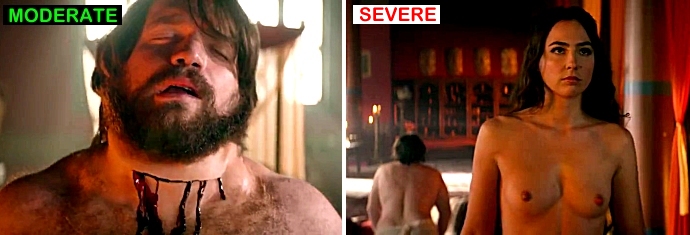
It was considered that seeing women topless would deliver a 'Severe' shock to the viewer, but seeing people violently murdered (including many of those women) would only register as a 'Moderate' shock. The person who wrote the following comment is clearly as mystified as we are, and concerned that so many people can be so screwed up: 'And [what's] all the fuss about the nudity? Probably coming from Americans. Odd how there's plenty of outrage over nudity, yet the extreme violence barely gets a mention. Since when is nudity worse than violence? Makes you wonder.'The very name of this section in IMDb's 'Parents Guide' — 'Sex & Nudity' — is misleading since it perpetuates this myth that nudity is always linked to sex and vice versa, if one is happening then so is the other, and completely ignores the fact that real-life nudity is more often than not quite innocent and non-sexual, since people get naked changing their clothes or bathing or sleeping far more often than they get naked and have sex. By linking sex & nudity in the same section IMDb is implying that they are intimately connected, in the same way that the scenes in their other 'Parents Guide' advisory sections are linked, such as 'Violence & Gore' and 'Frightening & Intense Scenes'. Grouping scenes of violence with scenes of gore makes logical sense since both normally involve people being seriously hurt and/or killed in a graphic and often bloody manner, and if you are shocked by violence you will likely also be shocked by gore and will want to avoid both. Thus there is a clear and genuine link between violence and gore that justifies their appearance under one label, ditto with 'Frightening & Intense Scenes', but we'd argue that sex and nudity shouldn't both feature under a single heading since often there is no link between them, even though IMDb (and prudish Americans and Muslims) believe there always is. Again, nudity happens most often in non-sexual situations (such as bathing), and sex is often engaged in (such as in nightclub toilets) without people being naked. The view that there is always (or even often) a link between nudity and sex is bogus. And even if in the fake world of movies people only get naked to have sex, why do we need to be warned about it? It's a perfectly natural act that people willingly engage in and fantasise about, having a 'Sex & Nudity' warning is as silly as having a 'Food & Eating' warning.
'Andrew Gilbert's (writer/director) true talent is in directing because he managed to show gruesome violence, cannibalism and sexual violence without crossing the line into exploitation or even resorting to nudity'.Here we have someone praising the director for showing 'gruesome violence, cannibalism and sexual violence' while thankfully not showing any nudity, not even during the sexual violence scenes! This is someone who apparently believes normal, decent people welcome the reality of gruesome violence, even cannibalism, but would naturally be shocked, appalled and offended by nudity. A scene of a human killing and eating another human is good movie viewing, but please don't subject us to a scene with a naked human! Society is truly fucked up when violence trumps nudity in the movie scenes people want to see. Another movie I watched recently was '47 Ronin' (2013), starring Keanu Reeves as a samurai, featuring plenty of violence but no sex or nudity. However under the IMDb 'Sex & Nudity' link was this helpful comment: 'It's obvious Lord Kira shares some sort of sexual relationship with his witch cohort'. What a truly pathetic and worthless comment. You could look at the kid's cartoon show 'The Flintstones' and say that, 'It's obvious Fred Flintstone shares some sort of sexual relationship with his wife Wilma'. Has it really got to the point that we must be advised of sex and nudity that never feature in a movie, but logically most likely happened in their imaginary world when we weren't around? In that case practically every movie and TV show ever made needs a 'Sex & Nudity' warning! The parents of Garfield the Cat must have had sex, so too the parents of Barney the Dinosaur, and some of the Smurfs must have got naked and had sex (although strangely there is only one female Smurf, Smurfette, so most Smurfs are apparently having gay sex). Where does this prudish lunacy end? The other night I watched 'Deadpool 2' (2018), starring Ryan Reynolds, a comedy about a violent and sarcastic superhero. Here's some of what the 'Parents Guide' said: Compare the scale of graphic violence depicted in the movie with the level of nudity. The movie gets a moderate rating for nudity because apparently women in bikinis and underwear can be seen (we didn't notice them) in some posters in the background. Curious as to what "nudity" we had missed (but mainly because we enjoyed it), we watched the movie again. The only poster we noticed, and then only because we were looking for it, was the one in the following screenshot. (See the red arrow. If you're struggling to see much detail, you're not being prudish enough, and it is a little clearer in HD on a big-screen TV.) It's of a woman standing in front of a military vehicle holding an assault rifle, and wearing what appears to be long camouflage pants and a bikini top. Not a full bikini or underwear, just the top of a bikini. She's not a real live female actor, she's not in the foreground or the focus of the scene, and she's not even naked, and yet some moron thinks she should be included under the heading, 'Sex & Nudity'. What sort of pathetic, sheltered upbringing have they had to think that nudity and a woman in a bikini top are the same thing? When they go to the beach, and lots of women in bikinis and men without shirts can be seen, do they exclaim, 'Wow, there's a lot of nudity on the beach today!'? And while this prude was concerned that viewers might be shocked to see a woman in a bikini top, they made no mention of the fact that she was holding an assault rifle (or that four real characters were pointing guns at another character and threatening to kill him). Again we have this totally screwed up attitude, that even clothing that's merely suggestive of nudity requires a warning, while weapons that are suggestive of violence don't even warrant a mention. Call me weird, but if in real life I saw two attractive women approaching me, one in a bikini, the other modestly dressed and carrying an assault rifle, as much as I'd prefer to watch the first, I'd be watching the one with the assault rifle. Why are we clearly in the minority for thinking that nudity in movies is harmless and that it's movie violence that should instead be seen as shocking and disturbing? If the argument is that watching specific movie scenes might pose a threat to the well-being of society, then it's the bullets that worry us, not the boobs.
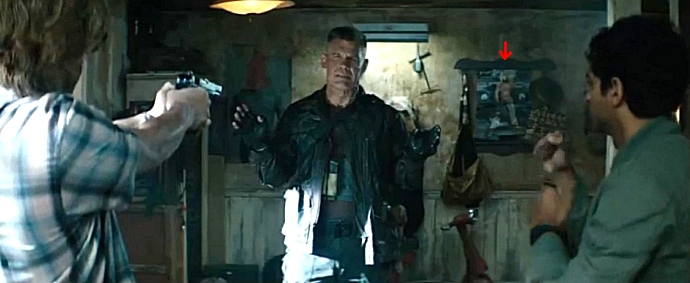
And note that these same fucking cunts have spent their time counting how many times words such as fuck and cunt were uttered. The reality is that the movie is almost non-stop graphic violence, some of it quite disturbing, but it's also very funny, and very popular. No doubt there will be another sequel to look forward to. If I was a parent considering whether I should let my children watch it, I'd consider it an insult to my intelligence if you even mentioned women in bikinis, as if briefly seeing them were in any way equal, psychologically speaking, to witnessing just one of the many, many violent deaths featured in the movie. But that's what it's come to it seems, where moviegoers are more shocked by a woman in a bikini top (in a poster in the background) than they are by the hero having his body ripped in half as seen in the following screenshots (don't worry, he makes a full recovery):
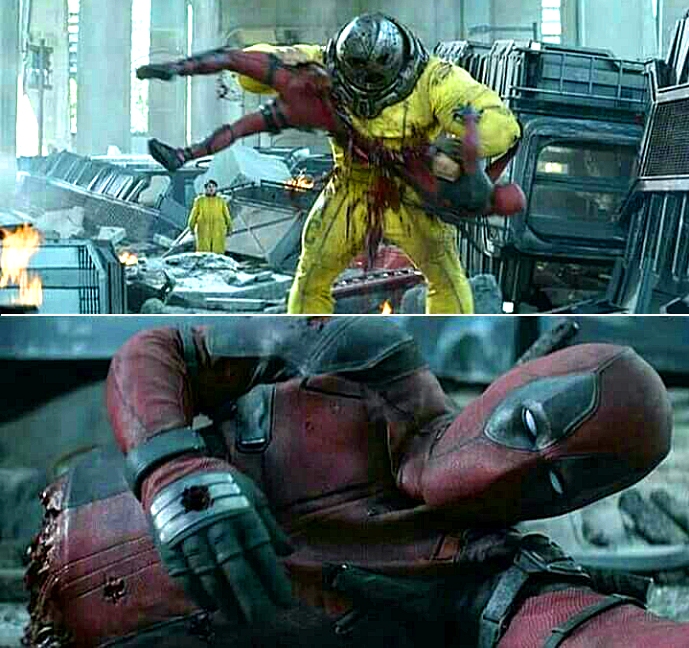
So what's the story, does a group called 'Prudes are Us' write the rating reviews for IMDb? It's quite worrying that there are moviegoers who are fixating on an innocent poster in the background while there are people being horribly killed in the foreground. That they would even mention a woman in a bikini or a male without a shirt on under the topic of nudity is mind-boggling, especially since they are implying we should be concerned lest children see them.
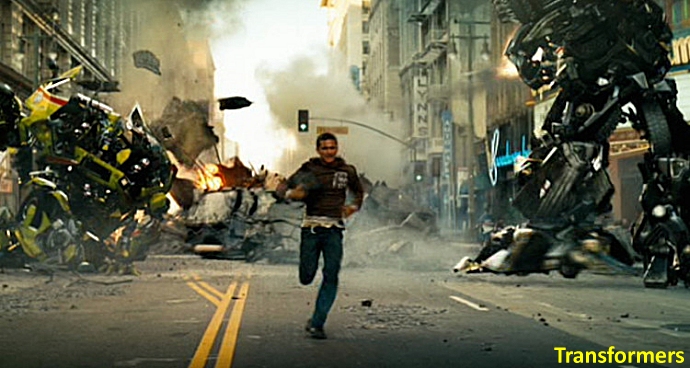
Of course evil villains, aliens, monsters and wizards don't care about the deaths of innocent bystanders, but equally neither do the movie producers, these deaths are a mere backdrop to the action and excitement. People have to die, often horribly and in great numbers, to highlight what is at stake and to make the hero's task all that more important. I watched the movie '12 Rounds' (2009) the other night where the villain blew up the hero's house, deliberately killing the plumber still inside, then he murdered the security guard that was helping the hero, later he murdered the hero's partner and another colleague, then he murdered two colleagues of the hero's girlfriend in front of her, and on and on his killing went, and while not shown, many innocent people would have been killed unintentionally by the hero too as he rampaged through the city crashing vehicles, trying to save the life of his girlfriend who was being held hostage by the villain. How many innocent men, women and children die in these movies without the viewer ever giving them a second thought, as long as the hero wins in the end? In so many movies the deaths of friends, colleagues, innocent strangers, of people on the street or in opposing armies, are shown as being quite natural and inevitable and nothing to lose sleep over. We're taught not to care about strangers who die in the background, in foreign cities and distant lands. However, if we were running the show and writing the movie scripts, we'd rather that people, and especially kids, were taught instead to not care about seeing someone naked, that they should give nary a thought to the nudity and a bit more thought to all the innocent deaths. Awhile back I watched the movie 'Kill Bill: Vol. 1' (2003), starring Uma Thurman as an ex-assassin, an expert with the samurai sword and in martial arts. After her old team of fellow assassins murder her fiancé and his family, they then shoot her in the head and rip her unborn baby from her womb, leaving her for dead, as seen in this screenshot:
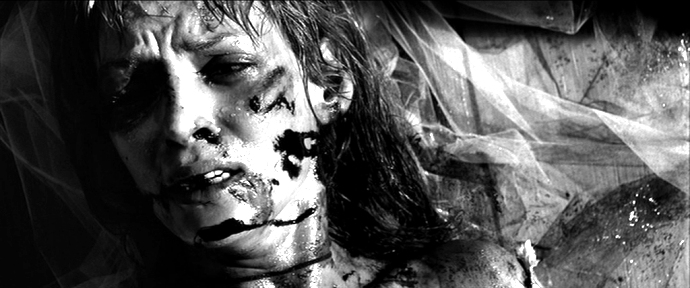
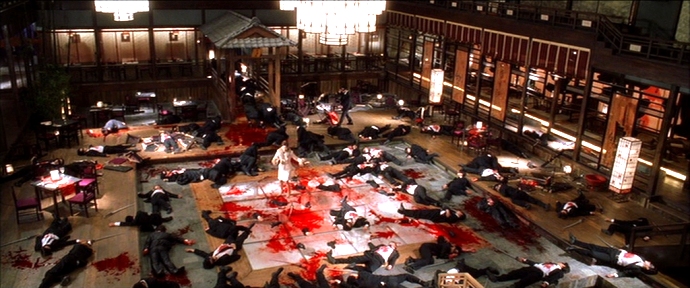
With just a little thought and no research, here are some more shockingly violent and bloody movies we can recall viewing over the last few years, many of which had sequels, and all of which make the violence in the 'Stargate SG-1' TV series we mentioned earlier look trifling in comparison. And we haven't included any of the many (many) horror movies in which disturbing violence has become an integral part. That's because I personally refuse to watch movies whose sole purpose is to use violence to create an atmosphere of fear, in which you know someone, and usually many, will die gory, gruesome deaths, or something equally sickening, just for our entertainment. You'll have to add your own horror movie titles.
As for that last movie, I'm sure you all remember the sort of loving, serene image of Jesus that Mel Gibson pushed in 'The Passion of the Christ', a movie that many churches argued was entirely suitable for young children. If not, here's a typical shot from the movie. And yes, that's his blood on his face and hands, it's not that they served ribs dipped in barbecue sauce at the last supper.

And before we're accused of being hypocrites for watching these violent movies, and enjoying many of them (but certainly not 'The Passion of the Christ'), our complaint is not that we are shown realistic violence in movies (swamped with images of realistic violence even), it's that at the same time images of innocent, casual nudity and realistic sex are banned. Society is utterly screwed up over this matter, the general view being that images of realistic, bloody, disturbing acts of violence are perfectly acceptable, utterly harmless and a great source of entertainment, while nudity, if shown at all, must be very fleeting and poorly lit, must avoid exposing the genitals, and sex must only be suggested by movement under the sheets and by appropriate moaning and facial expressions.

Look at the above stock photos of men attacking women with knives. They're for sale by reputable companies on the Internet, and you can buy them to use in a publication, company report, or on your webpage. They're deemed perfectly acceptable and respectable images, able to be viewed by anyone and everyone. Yet search as you might through their huge database of stock photos, or the databases of other companies that sell stock photos, and you won't find such confronting and explicit photos of loving couples having sex, or even of naked bodies not having sex. Photos of terrifying violence against women are fine, but photos of explicit sex or natural full-frontal nudity are deemed totally unacceptable.

Likewise the director of the Judge Dredd action/sci-fi movie 'Dredd' (2012), starring Karl Urban, also believed that viewers needed to see how flesh responds to bullets, in this case as one rips off the side of a face:
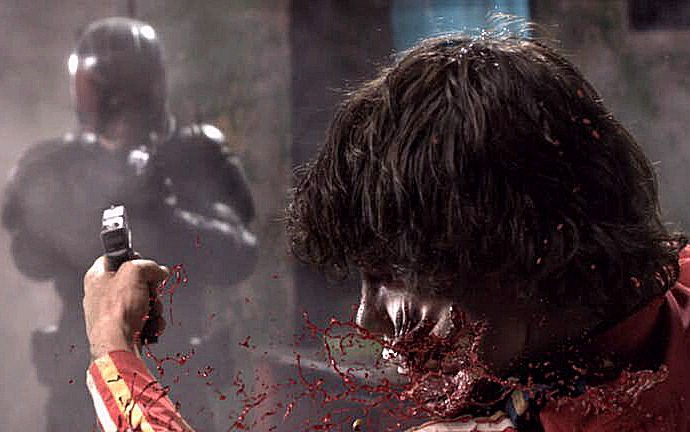
But to digress slightly, it's not just violence that has the tick of approval these days. Recently a NZ made series screened on TV called 'Spinal Destination' (2024). The series opens with a woman taking a bath, who suddenly and inexplicably becomes paralysed below the waist and understandably panics. Isn't it just amazing the number of important life events that occur while naked in the bathroom? Anyway, her paralysis results in her nearly drowning (although how that would actually be possible is beyond us), but even though she is madly thrashing about, there is no nudity in this scene, somehow the actress and the film crew, by utilising different camera angles, props and soapy water, thankfully manage to keep all the naughty bits hidden. Viewers are kept safe from seeing anything shocking and offensive, like breasts or pubic hair. Fast forward to the woman, who is now in a wheelchair in a hospital spinal unit, watching a paraplegic man. He's in a sling suspended in the air by a hydraulic hoist, and the nurses are in the process of taking him to the toilet when the hoist freezes. Before it can be fixed the man, unable to hold on, defecates on the floor, and we're shown faeces as they hit the floor and splatter, and then a nurse as she tries to clean up the smelly mess. While the scene was disturbingly realistic, let's remember that this wasn't a real incident caught by a news cameraman, it was deliberately staged and filmed for the viewer's benefit! Just as the opening scene in the bath was, but whereas they felt they had to hide the nudity, lest we be disgusted, they felt they had to show the splattering shit! What level has society sunk to when we must be shown graphic footage of someone shitting on the floor and yet we couldn't be shown a woman's breast in the bath? Now don't get us wrong, that toilet scene did expose the harsh reality of the suffering, frustration and embarrassment that incapacitated people go through every day. It's a fact of life, albeit unpleasant, that it doesn't hurt us to see, but why do these same people think we couldn't handle nudity? Is showing shit really more acceptable than breasts in today's world? Apparently so. First violence, then reality TV shows, and now defecation, what repellent and odious thing will they next fill our screens with in order to avoid showing the beauty of a naked body? And now for something completely different So that's a very small sample of the readily seen and accepted violence on our big and small screens, and we're sure they were all the sort of images that you are familiar with and likely enjoyed seeing again. No doubt we've given you plenty of choices for a rental movie this weekend. But hang on to your seats because now we're going to show some truly disturbing and shocking images. We've discussed what censors are happy for you to see and society is more than happy to watch, now we want to show you some images of what we mean by innocent public nudity, images that censors don't want you to see because apparently most in society would be offended, or at the very least, deeply uncomfortable on viewing them. They're not from TV shows or the movies since these sorts of scenes — 'Oh my goodness! That's obscene!' — are banned from our screens in the name of common decency. We had to go to some very shady websites to find these examples, websites that are so scandalous and unsavoury that they've only recently found their way out of the dark web, the source of all things immoral and illegal. I discovered that our library's free wi-fi bans their access, even though they will happily rent us movies like 'Kill Bill' and 'Deadpool' on DVD. And a word of warning, lest you be disappointed, there's not a single gun, knife, drop of blood or hint of violence in any of these images that are typically banned from our movies and TV shows, as well as popular online sites such as Facebook, YouTube and Instagram. Note also that there is no sexual activity in any of the following images, or even suggested. None imply that some sexual activity is about to happen or has just happened. It's just ordinary people relaxing, socialising and enjoying nature, at beaches, rivers, lakes, hot pools, on hiking trails and in the backyard, the only difference is that they're doing it without clothes; it's what we define as innocent public nudity. So if you can't view these images without immediately fixating on sex and without being shocked and scandalised, then it's you that needs to question your narrow-minded Victorian attitude, the irrational view that nude is lewd and that nudity always equates to sex. Get your mind out of the gutter!

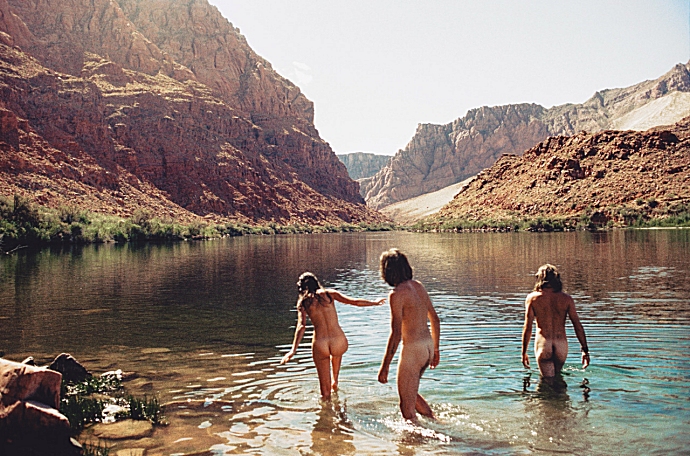
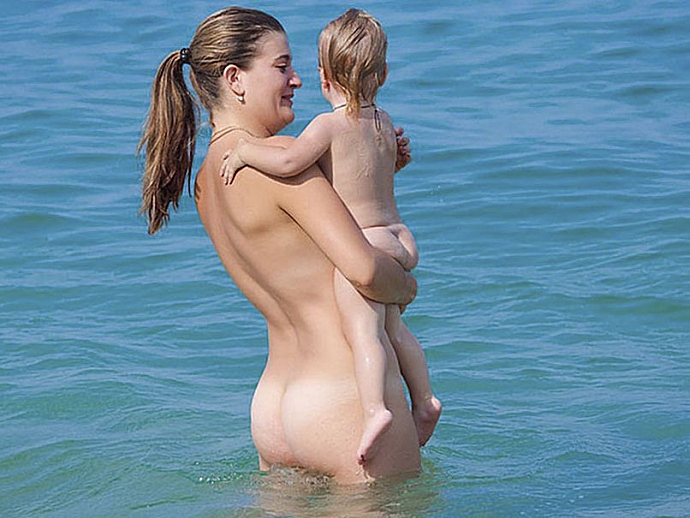
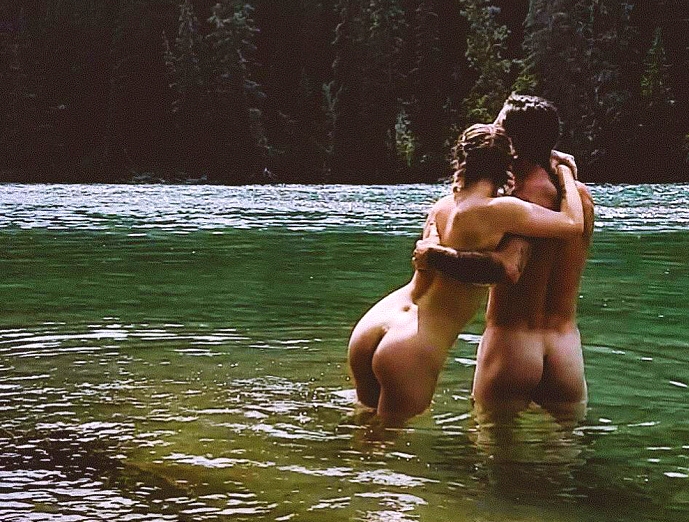


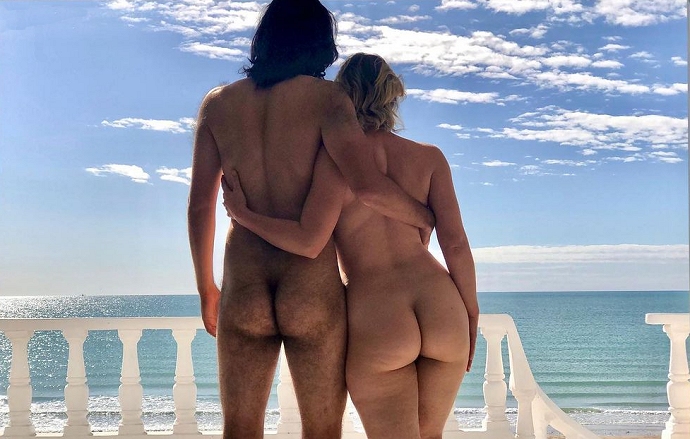


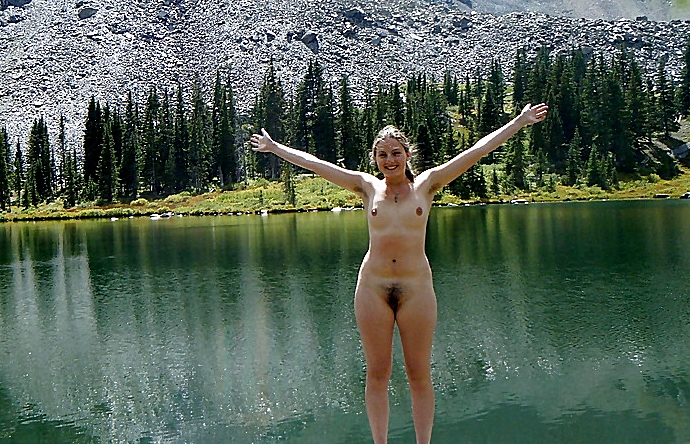
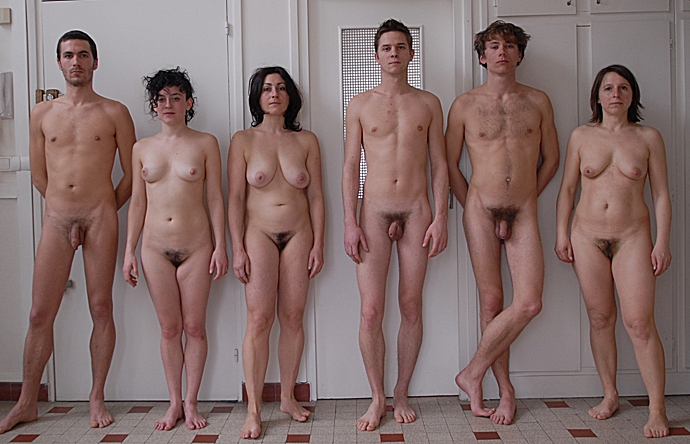

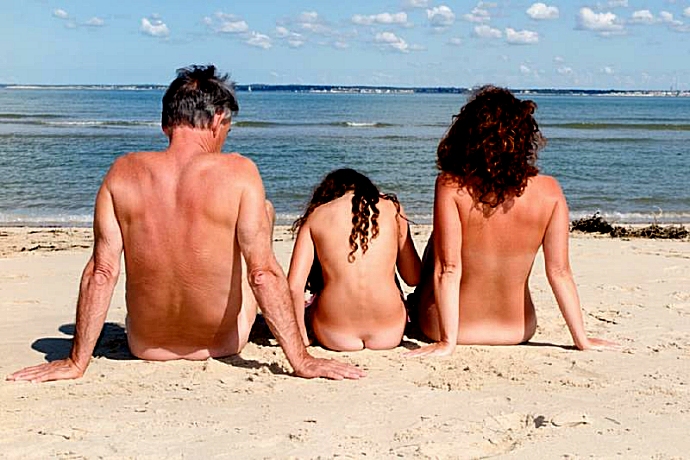


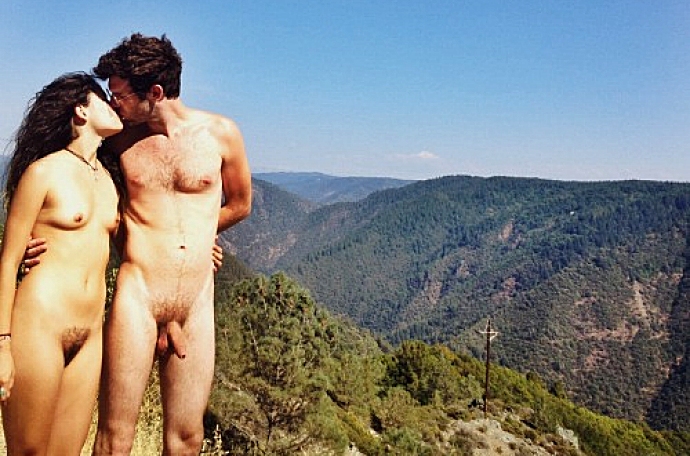
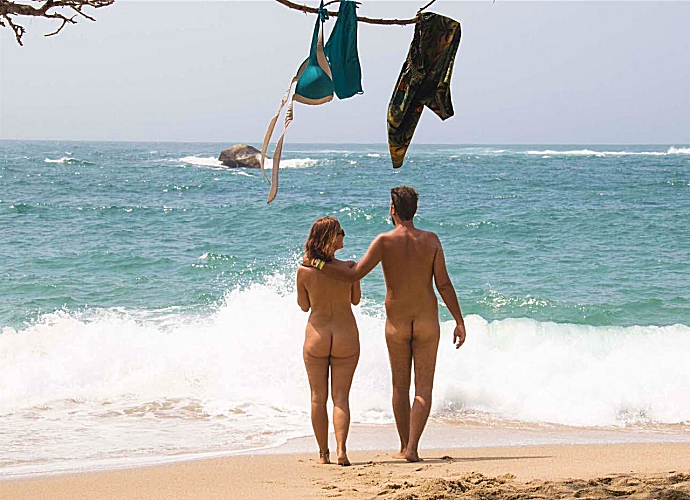


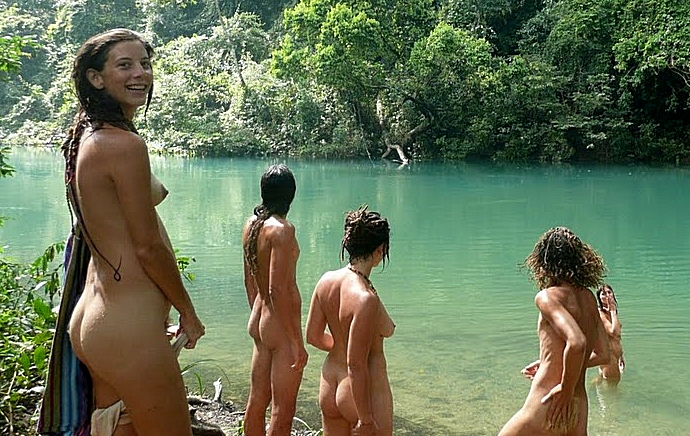
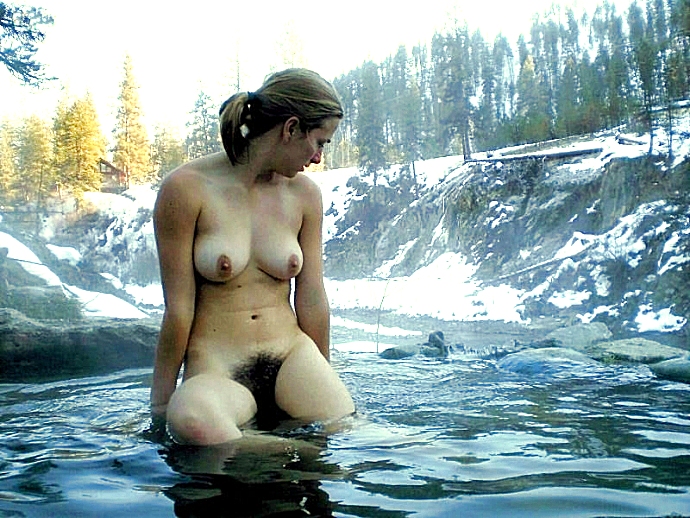
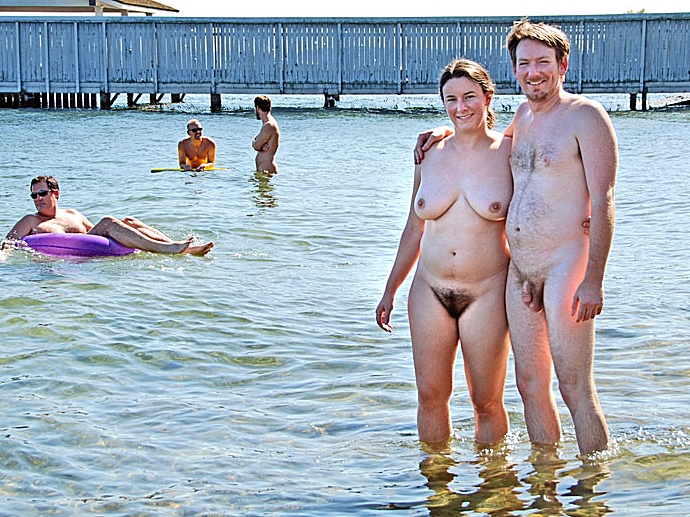
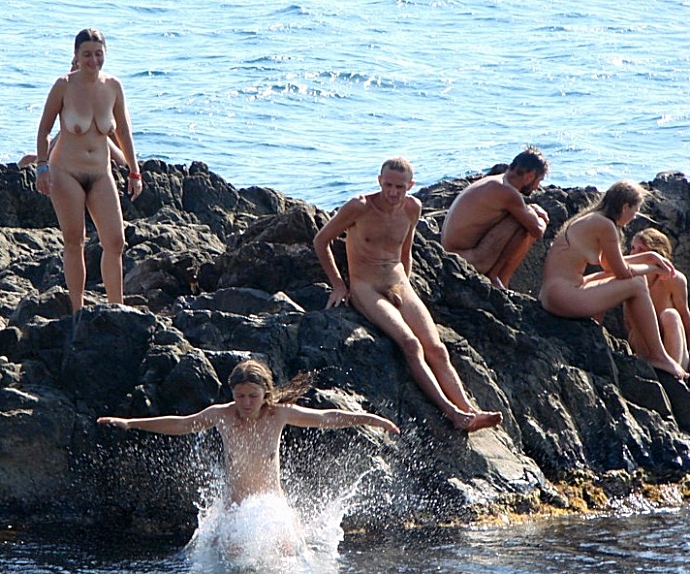


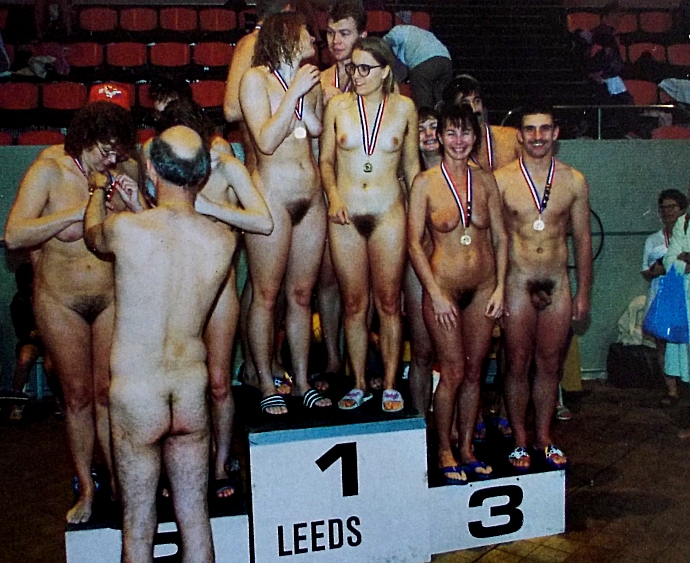
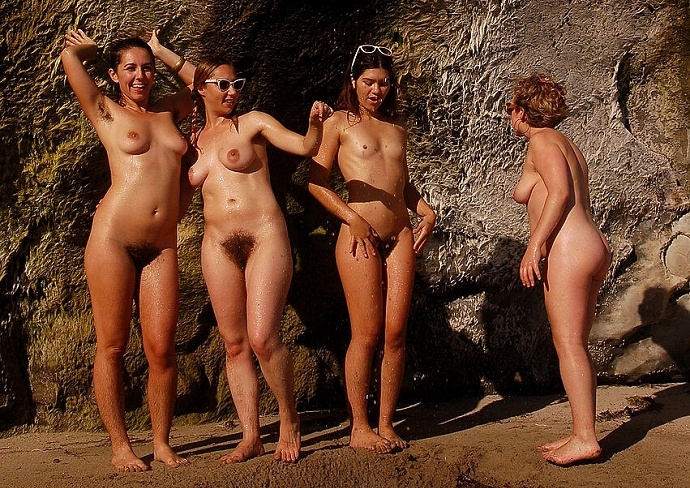


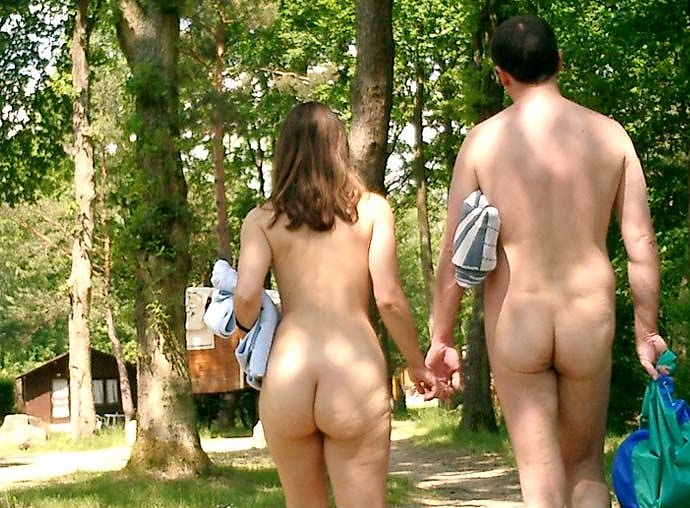

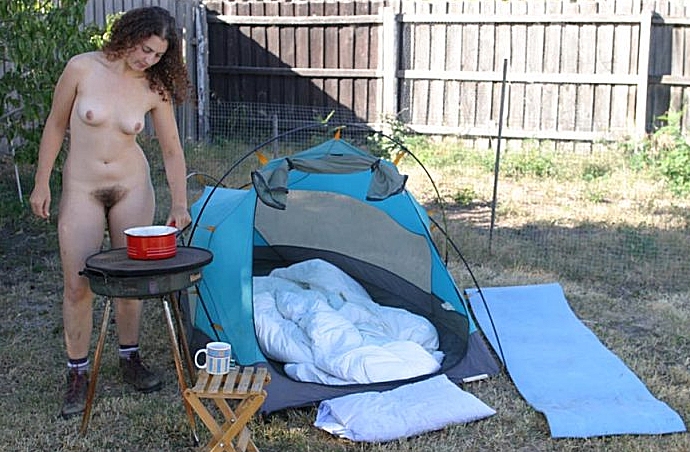

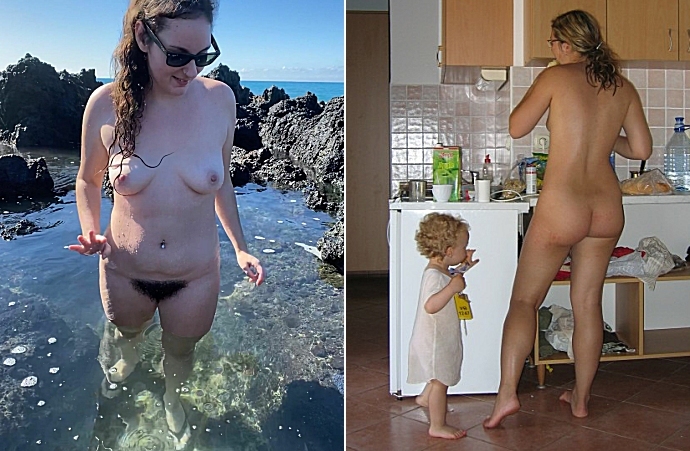

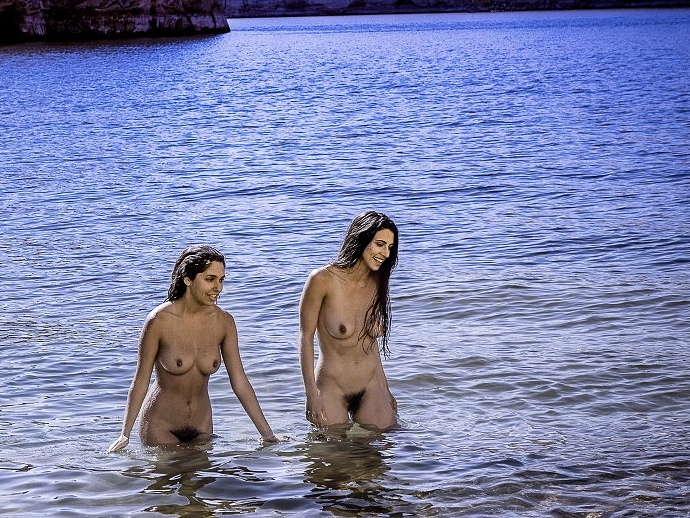
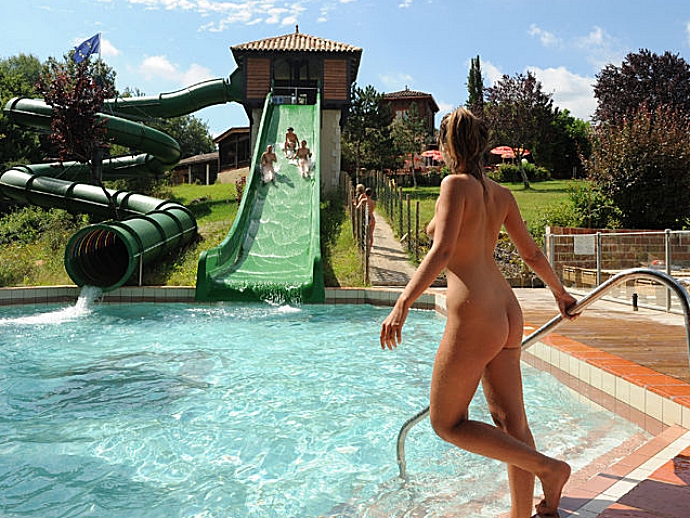


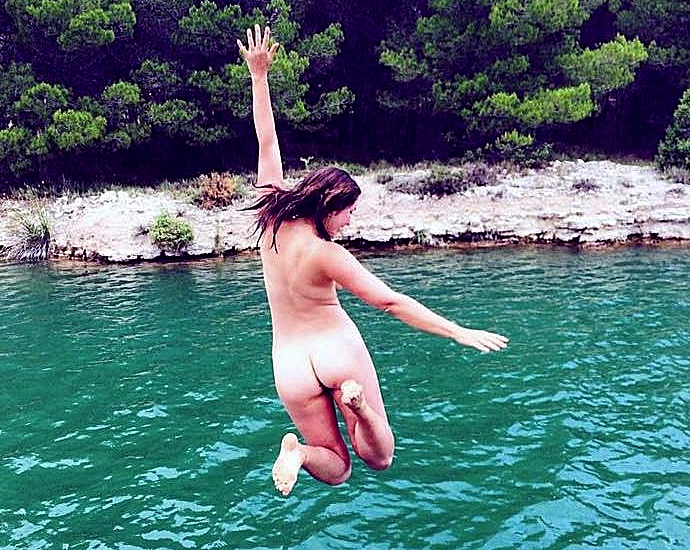
After viewing those images of innocent nudity you're no doubt utterly scandalised, somewhat nauseated, and truly thankful that our censors and moral gatekeepers don't allow such filth on our screens. But before you compose a strongly worded email to us, or rush to contact your therapist requesting an urgent session to discuss what you've just seen, perhaps you could first explain why it's thought that viewing graphic, realistic violence is deemed a lot less harmful, and far more preferable, than viewing innocent nudity? Like it or not, you've now seen examples of both, so why is violence in movies quite OK, as long as they keep their pants on? And again, we're not campaigning to have all the realistic violence cut from our movies and TV shows, we're complaining about the hypocrisy. As we've said, we do find some of the violence far too realistic and depressing, but we're not calling for a ban, we'll simply avoid those movies and TV shows. We can all choose what we watch. What we're arguing for is common sense and equality. Apparently adults, and children too, can watch adults shoot, stab, strangle and beat others to death, can watch adults torture others, can watch adults rape and abuse others, can watch innocent men, women and children die violent deaths in not just natural disasters, but as pawns caught up in fights between superheros and villains, and come away totally unharmed. Some of these violent acts will have been real, and viewed as news footage, but the great majority will have been fake, although appearing totally realistic, and created solely for entertainment. If we can view an inordinate amount of realistic violence over the years, whether it be real or fake, and not be harmed — and we don't believe most people are harmed — why do people think we will be harmed by viewing nudity and sex, whether it be real or fake? Where is the evidence for this? And if the modern consensus is that we won't be harmed, then why is it censored from our screens and our beaches? You are probably in one of two minds. You either think nudity in movies or on a public beach is offensive and needs to be banned, and nudity involving sex doubly so, or you think that innocent public nudity is natural and quite harmless, and if graphic sex was shown in movies it would probably be viewed as titillating, and if not, it certainly couldn't be any more shocking than graphic violence, which we're quite accepting of. So, if you're the first sort and think nudity and sex is offensive, why are they both legal and so sought after by most everyone, especially in their private lives? By legal we mean that innocent public nudity is not an offence, at least not in NZ, if it's not intended to cause offence, eg skinny dipping and sunbathing naked at the beach, and sex is perfectly legal between consenting adults, although maybe not on the beach. And if you concede that nudity is harmless, perhaps even quite nice if viewed in a bedroom on satin sheets, why does it suddenly become offensive and shocking out on the patio in a deckchair? This is what you need to explain and justify, how and why a naked body goes from beautiful and alluring indoors and in private, to disgusting and repulsive outdoors in public, whether that's a real body in the real outdoors or a celluloid body in a movie. To us this seems as irrational as insisting that a hamburger looks delicious if seen outside on a barbecue table, but revolting if seen inside on a coffee table.

Let's try a little thought experiment. Think of a Hollywood actor or actress, one you view as very sexy, in a scene from a favourite movie. Now imagine you're lying on a remote beach in Hawaii and suddenly you see them walking along the shore, naked. Would this stunningly handsome or beautiful, and very sexy person that you had previously only viewed clothed, have now morphed into someone gross and offensive, someone you can't even now look at without a feeling of revulsion? We doubt it, in fact being naked has likely only made them more enticing. So why if this happened in real life would some people think it was offensive, and then quickly call the police, or at least avert their gaze? What's changed, why has the naked body gone from very sexy in their imagination to very offensive in reality? Clearly the body hasn't changed, only their attitude to it has. So again, depending on the location, why does seeing a naked body evoke such polar opposite reactions, how does someone justify flipping from desire to disgust? If, on the other hand, you're the second sort and you view nudity and sex as natural and normal and not something that would shock you if spied at the beach or in the movies, then why does society generally work towards keeping it hidden, even though there's no real legal or ethical requirement to do so? Is it just a matter of numbers? Do the prudes greatly outnumber the carefree, liberal people in society? Or are the prudes small in number but just fanatically outspoken, ensuring their puritanical views are heard, especially in regards to the law, censorship and public morality, while the rest of us carefree folk are out enjoying life (often naked), and not trying to enforce our enlightened views onto others?

And we're not pushing that our movies should be full of gratuitous nudity and graphic sex either, merely that when it is appropriate to the story then it is shown in a natural and realistic manner. Nor are we Ye olde days — was nudity always a problem? When discussing this topic with others recently, some of the group aged in their 20s to 40s agreed that there is certainly a lot of graphic violence in movies and little to no nudity, but they felt that, right or wrong, the reason for this disparity is that it simply mirrored real life. Our TV news is replete with instances of violence while stories of public nudity are almost unheard of. They said they could remember watching some old movies like the first 'Rambo' and 'Diehard' movies and they'd seen a few episodes of TV's 'Charlie's Angels' and 'Miami Vice', and while all had violence, mainly people being beaten and shot, none had nudity, because again, while you're always hearing of people being beaten and shot in real life, you normally never hear of people encountering naked people in real life. They didn't feel we'd proven our case, that instances of public nudity had decreased over the last few decades and that society had seemingly become more prudish. But we disagreed with this assessment. They were basing their view of those times on what was shown in a very small sample of old movies and TV shows, not from experience, and we'd argue that movies are usually a very (very) unreliable way to learn about the past (or the present). So, are there activities from the recent past, say around the 1970s and '80s, where some forms of public nudity was accepted as normal, or if not exactly normal per se, at least not seen as harmful, but today there's a complete reversal? We can immediately think of five examples from the late 20th century where people encountered nudity and thought nothing of it, but where today in the 21st century, these things still exist, but the nudity element is either missing or rare. And if it is suddenly encountered, people are generally freaked out about it. These examples are (1) streaking, (2) saunas, (3) gym and pool changing rooms, (4) beaches, and (5) movies. Let's now consider each of those five examples. (1) Streaking. You will have heard of streakers, where individuals, and sometimes groups, run 'naked through a public place as a prank, a dare, for publicity or an act of protest'. Streaking really took off in the 1970s and '80s, there was even a No.1 song denoting its popularity, 'The Streak' by Ray Stevens. We're now going to show some typical images of streakers from the 20th century and then some from the 21st century. We want you to focus on the key phrase 'run naked' and see if you can you detect any change in attitude from last century to today?
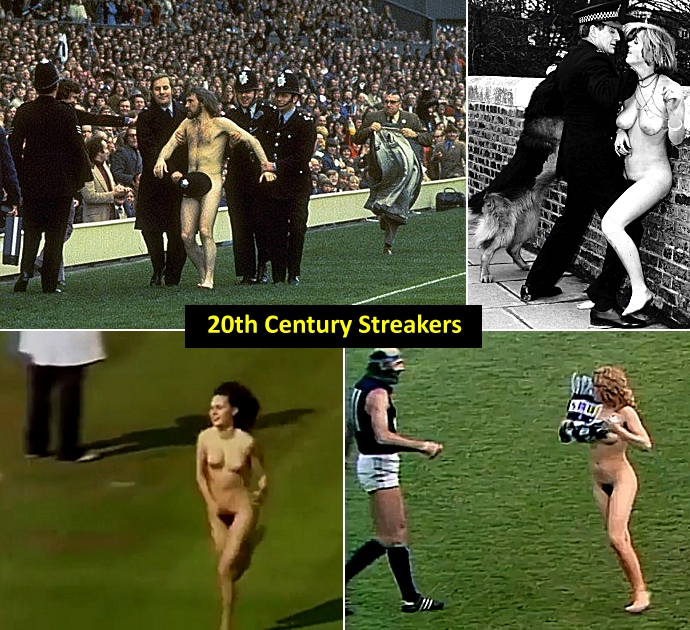
For the history buffs, the streakers are (clockwise from top left): Michael O'Brien, Twickenham, London, 1974; Sally Cooper, London, 1974; Helen D'Amico, MCG, Melbourne, 1982; Sheila Nicholls, Lord's Cricket Ground, London, 1989. And just to be clear, for streaking to have any impact and make any sense, the runner has to be naked. If you're not naked then you're just somebody out for a run. Nothing to see here. Jump forward now to the 21st century, where streaking, in a boring and immature sense, still happens on occasion.

Did you spot the difference between then and now? It's very subtle ... so look again. Many people now seem to be utterly confused about what it means to be naked. We've seen real people on TV speaking about real life and say that someone they saw was naked, when in reality they were wearing underwear or a towel and certainly not naked. In 2006 in NZ, a woman by the name of Lisa Lewis became briefly famous for "streaking" at a televised All Black's rugby match, and yet she was wearing a bikini! (That's her in the above image between the two security guards). You're not streaking if you're not naked, completely naked, and you're not naked in a bloody bikini. Are women at the beach in bikinis naked? She said afterwards that it 'was a lifetime goal of mine to streak on a rugby field, and obviously [I've now] fulfilled that dream'. Umm ... no you haven't you fucking moron! Even the equally moronic journalists that later interviewed her asked about her impressive confidence to run naked in public, and many women on social media commented that they could never go naked in public like that. And where might they be getting this stupid notion that you're naked even though you're clearly not? From movies and TV shows. Just the other night I watched a sitcom where one character asked his roommate why he was naked in the lounge, and yet he was wearing boxer shorts! Saying that someone is naked in a bathing suit, a towel or underwear is as stupid as saying that I walked through town yesterday naked ... well, you know ... beneath my clothes. And last century streaking was also a popular group activity in some American universities, with organised naked fun runs across campus on the last day of classes. Apparently these naked runs were the origin of streaking, back in the 1960s. In 1974, a naked run at the University of Georgia attracted 1,543 entrants. One of these varsity runs was even the focus of the comedy movie, 'American Pie Presents: The Naked Mile', a run held at the University of Michigan from 1986 until 2004 when the University 'ended the tradition through arrests and threats to students who ran'. Worse still, in the US the innocent and harmless act of streaking can now see streakers being forced to register as sex offenders for life, since they can charge streakers with criminal sexual conduct. This is because of the ignorant notion that nudity is ALWAYS connected to sexual activity, and, we assume, since you run past people who aren't necessarily willing participants in the streak, it's therefore sexual activity of a criminal nature. Authorities are doing their utmost to dissuade people from being naked in public by turning an innocent and harmless fun run into a criminal offence that could ruin your life, since being registered as a sex offender puts you up there with convicted child rapists, and it carries certain conditions, like going to all your neighbours and advising them that you're a registered sex offender. Even urinating in public (even behind a bush) is classed as illegal sexual activity in many US states and will see you being arrested and labelled a sex offender. I remember being one of a group of ten young women and two young guys vacationing in the US and walking along a quiet rural road at night in Montana, when one of the women decided she needed to pee so she simply hitched up her skirt, dropped her panties and went right there in the middle of the road. Back then none of us (we were Kiwis and Aussies) realised that she could have been arrested and hauled off to jail if an American had seen her. We saw nothing sexual in her actions and no one was shocked, she was simply answering the call of nature like all of us have done many times previously back home, especially on the way home from the pub. No one thought this offensive or deviant or sexual and a reason to call the police. But in parts of the US innocently taking a pee in the countryside is seen as being as offensive as raping a child, the logic being that genitals are uncovered and since sex involves uncovered genitals, then clearly urination is a sexual act. We seriously can't understand how people can believe that fucked up argument, but it's not just ignorant Bible-bashers that do, so too do judges and lawyers in the US. So, thanks to this very backward looking attitude, instead of 'The Naked Mile' at American universities, we now see fun runs such as the 'The Nearly Naked Mile'. As this advertising poster for one of the events states, there's to be no hint of nakedness on a nearly naked run. That's progress for you. Or not.
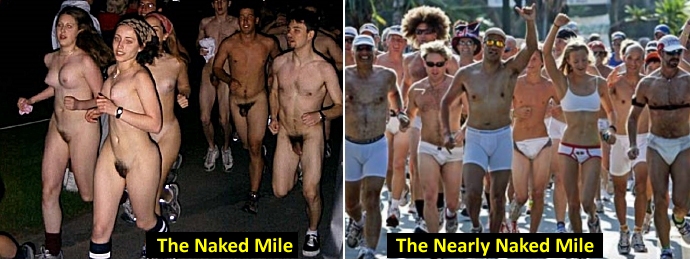
Streaking only works due to the surprise of seeing someone run past naked, in places where they normally aren't. For example, streaking wouldn't evoke any reaction or make any sense in a nudist club, and for a similar reason streaking fails abysmally when the streaker remains clothed in places where clothing is expected. And yet streaking has somehow gone from a harmless and entertaining naked prank to a point where the "streaker" now runs with clothes on, which utterly defeats the entire purpose of the run. Even in NZ, well away from America's draconian laws, nudity is now so feared that what people still childishly refer to as a "naked activity" must be done fully clothed. (2) Saunas. In the 1970s and '80s when saunas, steam rooms and spa pools became popular in NZ, male and female nudity wasn't just commonplace in these establishments, it was the rule, a rule that made perfect sense. Why get clothed to sweat? And in the Scandinavian countries where they originated, it's still the rule. Everyone was naked, you had a towel and that was it. And back then, no one freaked out, people weren't as terrified of glimpsing the naked body, their own or that of others, as they are now. We're now going to show some typical images of saunas from the 20th century and then some from the 21st century, and again, see if you can you detect any change in attitude from last century to today?
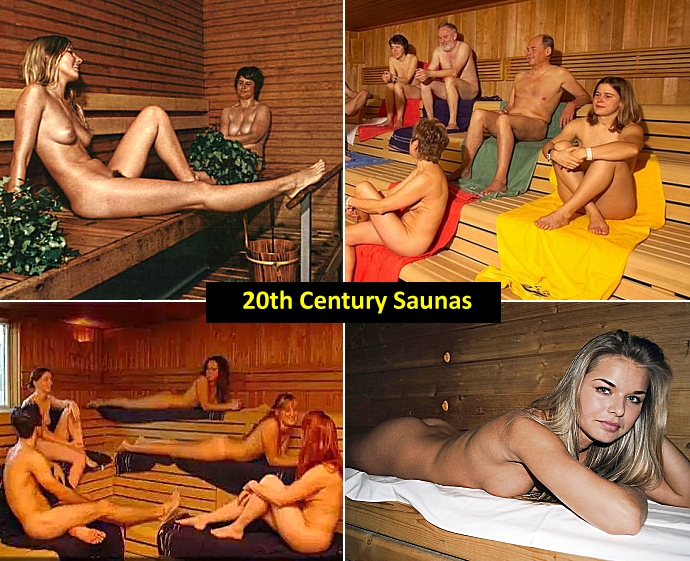
Sadly no such dedicated establishments exist anymore, and of the few public places that might still provide a sauna or spa pool, such as gyms, motels and hotels, all demand that bathing costumes are worn, with both management and customers now finding the thought of public nudity utterly shocking. As the next set of images show, the prudes have gained control of the sauna mindset and the sauna rules.

(3) Gym and pool changing rooms. It's not just in mixed saunas where our views have regressed to Victorian times, many people are increasingly becoming terrified of being seen naked in single-sex open-plan changing rooms at public swimming pools, gyms and schools.
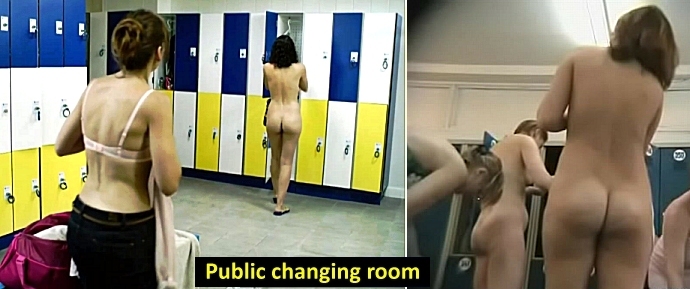
Even in NZ we've had prudes complaining and pushing for public changing rooms to disappear. The following quote is from one article (plus video) on the controversy: 'Debate sparked over etiquette inside pool changing rooms'. One paragraph says that: 'Engineer Shabbir Ahmed was at the Lido Aquatic Centre in Palmerston North in February when he saw a child become distressed on seeing a completely naked man in the open changing area. "The father of the kid put a towel over his face and said 'don't look over there'," Ahmed said. "It does not leave a positive impact on a child's brain". Ahmed said the centre had private changing rooms that adults should use to avoid placing children in potentially vulnerable situations'.Why would a young boy become distressed on seeing a naked man, not on the street, and not holding a priest's outfit, but simply a man undressing at a public pool to go swimming? Hadn't the boy seen his father naked? What has his father or family been teaching him, that nudity is harmful, even in the context of a changing room? But some Kiwis, rather than tell these bloody prudes to grow up, are changing things to suit these primitive, ignorant viewpoints. Pool manger Lynden Noakes said they've doubled the number of family changing rooms and in the video said that they encourage people, both families and individuals, to use them so that, 'They don't have the hassle of seeing anyone else naked'. Rachel and I both grew up using open plan changing rooms and showers at school and the local pools and gyms, single sex of course, but also occasionally, as adults, unisex changing rooms and showers at saunas, and neither we nor any of our friends ever had a problem with changing or showering around our friends or complete strangers, no one ever saw it as a hassle or something to fear. And still don't. What's wrong with us? Oh my gawd ... are we perverts?

Coming down on our side of the debate, the changing room article noted that: 'Massey University senior lecturer in clinical psychology Dr Kirsty Ross said she had not come across research suggesting nudity in changing rooms had negative lasting effects on children ... [and that] parents also needed to be careful not to instil fear in their children. "We don't want kids to be scared going in to changing rooms or concerned that something is going to happen".'And we'd argue that if viewing innocent nudity in changing rooms is having negative effects on children these days, even if it's not lasting, then clearly parents and educators are failing in their duty to teach them the basic facts of life, and what innocent things they can expect to see at the pool. Again, these are changing rooms, where nudity is expected, not a back room at the local Catholic Church or Scout den. Unfortunately, freelance Kiwi writer Lee Suckling has also detected problems with changing rooms, and has written an article, 'The rules of a public changing room', to tell us how we can limit our distress. In part he writes: 'I'm not ashamed of my body. However I would rather exercise some tact when in a public changing room and prefer to always face the wall when towelling off. I'm all for naturism in the right setting but a public changing room is NOT a place to relax and feel free and comfortable. It's pure personal administration: the goal is to get in and get out as fast as possible'.While he claims to have no problem with public nudity — 'I'm all for naturism' (ie nudism) — he then contradicts himself by saying that one shouldn't feel relaxed and comfortable being naked around others (the complete opposite to naturism), and that 'the goal is to get in and get out as fast as possible'. We suspect he doth protest too much. While Suckling isn't demanding private cubicles for everyone, the clear implication is that it would solve all the problems he raises, and unfortunately this does seem to be where we're heading, where increasingly people view it as inappropriate for open plan changing rooms to exist. Apparently if two or more people are naked in the same changing room, and they aren't as embarrassed as you are, then look out, since clearly something sexual is about to happen! Eww ... gross! UPDATE: The above calls to convert open-plan changing rooms into private cubicles so that timid people never have to see bodies undressing were made back in 2018, and unfortunately five years later this nonsense is still ongoing and getting even more ridiculous. In November last year our own city council reported that youth (who they identified as being between 14-25) were 'not well engaged' with our local swimming pool complex and sought solutions to increase their attendance, one being to 'investigate the viability of having more private/individual changing facilities for general use'. So to increase revenue they are willing to facilitate youthful prudery. The council report had also noted that 'LGBTQI teenagers felt unsafe with the [existing] changing room set-up', which really makes little sense. Do LGBTQI teenagers deliberately advertise their sexuality with rainbow-coloured swimsuits and underwear? All that would be on display is their bodies, not their sexuality. If this argument made sense, it should be the heterosexual bathers that should feel uncomfortable with homosexual teenagers taking furtive glances at their naked bodies while they change. But it doesn't make sense, it's just overly-sensitive youth — gay and straight — and ignorant adults with the Victorian view that the naked body is offensive and must only be uncovered in private. And as we explain here, a surf life saving club in Australia has now banned nudity outright in its open plan changing rooms and showers. All to protect the traumatised children. But wait ... there's more. In an update to our update, in July 2024 an offended mother started a petition to have g-string bikinis banned from New Plymouth's public swimming pool, and again the pathetic excuse is to shield the children from harm. We expose the bullshit here.
In her book, 'Nudity: A Cultural Anatomy', published in 2004, Ruth Barcan revealed that even back then this fear of nudity had already emerged as a worrying trend, with Barcan suggesting that young people today are becoming more prudish, noting that: A writer who grew up in Europe but is now working in the US wrote that she was amazed at the prudishness of Americans, noting that in Europe, 'We are not taught to cover up our bodies, to hide our boobs when we're three years old, or to be ashamed when we see a naked body on television. Maybe in America, the very thing that is trying to "protect" us is having the exact opposite effect. Why else would so many women and girls be ashamed to do simple things like change in front of friends or wear a bathing suit?!'The way we see it, hiding nudity from children is as harmful as hiding the reality of death from them. If children are exposed to innocent nudity as they grow up then they'll think nothing of it. They'll be more accepting of the normal and natural differences between bodies of both sexes, and they'll realise that the majority of bodies they see in magazines and movies are totally unrealistic, that the perfect body is a myth. You can digitally manipulate bodies in magazines and movies, however it's rather difficult in real life. If natural nudity is hidden from them, as opposed to the carefully constructed nudity in pornography and movies, then you greatly increase the risk that they might feel uncomfortable, anxious, inadequate, flawed, disappointed and even traumatised when they finally encounter others naked, and they themselves are seen naked. And encounter nudity they will if they wish to lead a normal life, and it will be real naked bodies in all their wonderful diversity that they encounter, not a Hollywood version that is as rare as Bigfoot. There's a well-known story from the Victorian era concerning British art critic John Ruskin and the debilitating shock he received on seeing his first real woman naked. All the many paintings and statues he'd seen in art galleries of naked women had never revealed that real women have pubic hair, so he was, as the story goes, apparently quite traumatised on his wedding night to discover that his beautiful 19 year-old wife, Euphemia ('Effie') Gray, had pubic hair, so traumatised in fact that he couldn't face having sex with her, and she ended up having the marriage annulled six years later, still a virgin. Another more recent take on what might have incapacitated Ruskin on his wedding night was that he had pedophile desires, and on seeing his new wife naked, including all her body hair, he finally accepted that naked adult bodies were not something he could be sexually attracted to. He preferred the hairless bodies of young girls. What isn't in doubt is that being confronted with a real naked woman triggered something in Ruskin that caused him to run for the hills and become a laughing stock. Social historian Virginia Nicholson has recounted a similar incidence of ignorance from the same era: 'In her autobiography, the artist Kathleen Hale tells how her mother, as the date of her wedding approached (in 1891), was consumed with dread at the thought of the inevitable discovery of her pubic hair, which she imagined to be "a monstrous disfigurement, peculiar to herself alone".' [19]And this is the society we're returning to, where young men and women are overexposed to the unrealistic naked bodies in porn and movies and yet never get to see a real and normal adult naked until their first sexual encounter, and then it's all, 'OMG, your body is nothing like what I've seen in all the porn I've watched, or even the James Bond movies! So ... umm ... thanks, but no thanks. Please put your clothes back on and I'll call you an Uber. Seriously ... why haven't you considered surgery, and what's with all the hair down there, are you a gorilla? Only men have body hair, or filthy lesbians'. If you think we're deliberately being ridiculous to make a point, we're not. In a British TV documentary series called 'The Sex Education Show' one episode looked at the way pornography was influencing how youth view sex and naked bodies — 'Porn: the new sex education' (2009). They surveyed over 400 British teenagers between fourteen and seventeen concerning their pornography consumption and its effects on their sexual attitudes, and found that porn actively misleads teenagers about what normal bodies are like and what sexual practices really involve. In the documentary: 'A group of boys from Sheringham high school in Norfolk is shown photographs of 10 pairs of breasts. All say the most attractive are the ones that have been surgically enhanced. Alarmingly, a posse of their female classmates says the same thing. Both sexes are unimpressed with normal breasts, which — unlike porn stars' silicone-boosted chests — are often not symmetrical and sit down, not up.It was also revealed that: 'Many are having sex without learning proper contraception techniques because the pornography they watch does not show the use of contraceptives, or because "when boys see girls merely as sex objects, they're unlikely to respect them when it comes to matters such as contraception".'On Internet forums and sites such as Instagram, Twitter, Facebook, Tumblr, Reddit and in the comments section following media articles it is unfortunately all too common to come across vile comments, written mainly by young men, but also young women, that verbally attack, condemn, ridicule, abuse and shame women that have the nerve to post a photo of themselves in a bikini or revealing outfit when they don't have the "perfect" body of a porn star. Society allows free and easy access to the naked bodies in porn while actively concealing even non-sexual nudity in our movies, TV shows and public life, as if to say that the only people sexy enough to be seen naked are porn stars, and that the rest of us are the naked equivalent of the severely deformed Elephant Man. So please, keep your clothes on, we don't need to see that! The real harm in hiding innocent nudity, in hiding normal, natural and diverse naked bodies, is to make people ashamed, critical and dissatisfied with their own bodies and the bodies of others. The harm is not in seeing naked bodies — normal naked bodies — but in not seeing them. (4) Beaches. In the 1970s and '80s, especially on the beaches of Europe, boobs were everywhere (as a friend once remarked), since the Europeans didn't have the same hang ups the rest of the world had. It was quite common to see women sunbathing, swimming and socialising topless, and sometimes completely nude, also bathers stripping naked to rinse off the sand under the outdoor showers found on many beaches wasn't unusual. They weren't the majority, but no matter what beach or where you looked, some would be topless, and those that had kept their tops on weren't giving disapproving, hostile or shocked looks towards those that had stripped off. Families and young children enjoyed the beach with no concern given to the extra flesh on display. And some of the more remote beaches around the Mediterranean, especially in the Greek Islands, were totally nude beaches, and they were as crowded as the normal beaches, including families. Although Kiwis are generally more repressed regarding nudity than Europeans, even in the summer hoilday resort of Queenstown, NZ, it was not uncommon to see one or two women sunbathing topless on the beach, and I remember driving into the nearby Skippers Canyon in a 4WD and passing two young women walking out topless. But that was then.
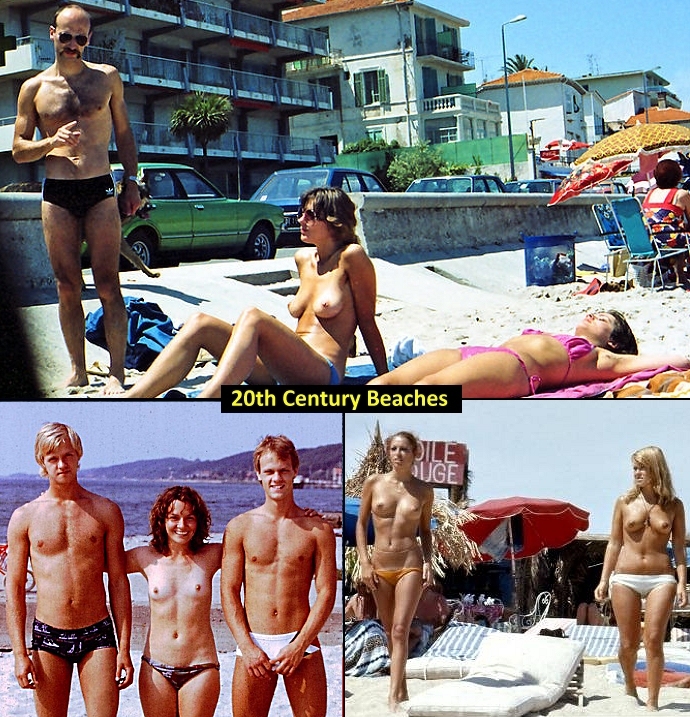
When I was again in Europe in the late 90's, I still saw one or two topless women on the beaches, but they were now an uncommon sight, and I saw no total nudity. When I was there again in 2007, we didn't see a single topless woman on the beaches. Where topless women were once commonplace and even completely naked men and women didn't raise an eyebrow, now in the 21st century they were, like the dodo and the dinosaurs, apparently extinct.

Note that while the female bathing suit remains firmly in place these days, it's still just as skimpy as it was decades ago, whereas the material making up the male bathing suit has increased considerably. The bare male chest, nipples and all, is still acceptable, but the pants are getting longer and baggier and returning to the style of a hundred years ago. In NZ, sightings of a topless woman sunbathing on the beach is so rare and shocking these days that they usually result in complaints to the police or the local council, which of course gets the media involved. Complainants, and sometimes even the council officers and/or police, then have to be reminded that it is not an offence for women 'A group of male politicians want topless sunbathing banned on beaches ... arguing that the sight of women without bikini tops is offensive'.They're evidently supporting a proposal by the Reverend Fred Nile, so we have just another shameful example of old, white males following a religious agenda and trying to tell women what they can and can't do with their own bodies. Apparently they failed, but maybe those male politicians should just avoid the beaches if they're so easily shocked. The article also noted that, 'Topless sunbathing has been common on most beaches in Australia since the 1960s. Nude beaches are also legal in every state except Queensland'.So again, we've moved from a time when nudity on beaches, while not ubiquitous, was not uncommon, and was not seen as harmful or offensive, to a time where it is now rare and viewed as obscene and something that should be illegal. And as bad as it has become in the likes of Europe, Australia and NZ, in the US it's a million times worse. The majority of Americans (good Christians all), and certainly those that make their laws, are terrified of nudity in general and of the female nipple in particular, while paradoxically producing more nudity in the form of pornography than all other countries in the world combined. While topless women could be seen on some US beaches in the 1970s and '80s, and nude beaches were tolerated, topless bathers now risk arrest and many nude beaches have been closed. (5) Movies. Like the previous examples, let's look back a few decades, from the late 1960s through to the 1990s and see if, between then and now, there's a discernible difference in society's general attitude to nudity in mainstream movies. And let's consider true nudity, meaning full-frontal nudity, rather than just topless women or the sight of a bare ass, scenes where the nudity is obvious and more than just fleeting. Not scenes where the viewer exclaims, 'Wait ... was that my imagination, or were they naked?' However, before we look at movies, let's very quickly consider an example or two from their forerunner, from their much older cousin, by which we mean live theatre, a form of entertainment that has existed for millennia. You may have heard of the rock musical 'Hair' that opened in New York's Broadway theatre district 'in April 1968 and ran for 1,750 performances. Simultaneous productions in cities across the United States and Europe followed shortly thereafter, including a successful London production that ran for 1,997 performances. Since then, productions have been staged around the world'. Telling the story of some politically active, long-haired hippies, the musical not only featured profanity, sex, drug use (both simulated of course), but also a brief nude scene featuring 'full-frontal nudity of both male and female cast-members' (below). I happened to attend a NZ performance of 'Hair' in the mid-1990s, and was disappointed to discover that the nudity had long since been deleted from the show. How times change!
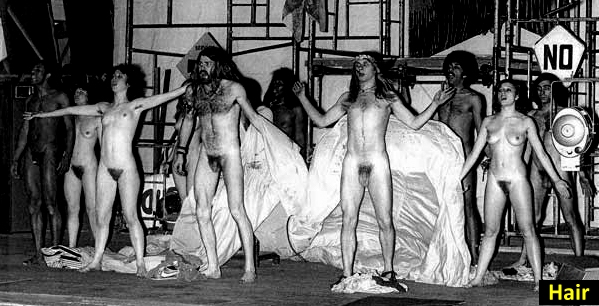
Following on the heels of 'Hair' was 'Oh! Calcutta!' which debuted Off-Broadway, NY, in 1969, and then in London's West End in 1970. This musical had 'extended scenes of total nudity, both male and female', and apparently these two shows 'set off a minor craze for nudie musicals in New York, which lasted through much of the decade', ie the 1970s. 'Oh! Calcutta!' ran for three-and-a-half years in NY, the 1976 revival ran for another 13 years, and it 'remains Broadway's eighth longest-running show and the longest-running revue in Broadway history'. The low-budget musical 'Stag Movie', also featuring nudity, ran across the street from 'Oh! Calcutta!' for six months during 1971.
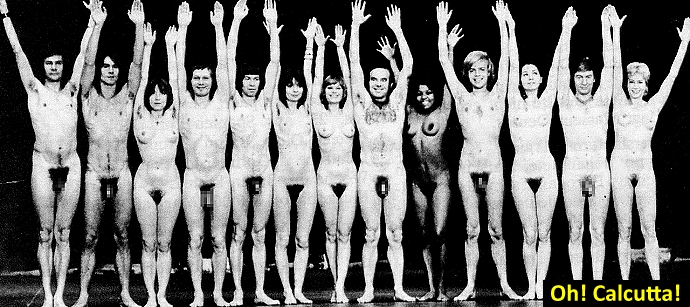
Another musical with sexual themes and nudity was 'Let My People Come', which ran in Greenwich Village, NY, from 1974 to 1976, finishing it's final few months on Broadway (below). These examples from live theatre show that back in the late 1960s, through the '70s and into the '80s the general public, at least in NY and London, had no problem with nudity on stage. Their attendance at these shows meant they would run for thousands of performances.
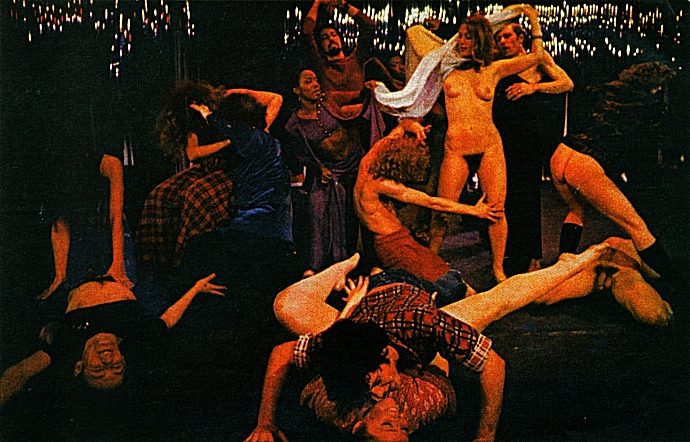
And there is no doubt that live theatre influences movies and vice versa, with many actors preforming in both. What succeeds in one to draw in an audience will obviously be adapted and adopted by the other where it can. Give the people what they want. OK, so nudity in live theatre was obviously an enticement that many people back then would pay to see, so did this element also start to show up in movies in the late '60s? We believe it did. We're not movie buffs, and NZ only gets to see a fraction of the movies that Hollywood and other English-speaking countries release (and almost nil from other countries), but some movies from those decades that spring to mind would be the following.
First we have 'School for Sex' (1969), although it would be into the '70s before NZ moviegoers got to see it, since unlike now where a movie can be released simultaneously worldwide, NZ had to wait at least a year or two for the film to arrive here. Even though censorship codes in Britain and the US (and NZ) had banned on-screen nudity from the 1930s until the late '60s, some movie makers in Britain decided to push the envelope, as explained in 'Saucy!: Secrets of the British Sex Comedy' (2024) [16], a documentary that examines a series of British sexploitation Actually shooting different versions for different markets to get around censorship was not a new idea, in Sandy Schreier's book 'Hollywood Dressed & Undressed: A Century of Cinema Style', she notes that back in 1930 when Marlene Dietrich appeared in 'The Blue Angel' ('Der Blaue Engel'), the movie was: 'filmed simultaneously in two versions for both German and American audiences. Some of the underwear scenes in this German film were reshot for the English version, as director Josef von Sternberg felt that American audiences were too prudish to accept the original costumes'. [23]Many of the British sex comedies that followed 'School for Sex' also shot two versions, with Walker later saying, 'They used to call it the hot version and the cool version'. Some of those destined for Europe even shot a third version where footage of explicit hardcore pornography was inserted into existing (simulated) sex scenes using porn actors as body doubles for the real actors. Needless to say we in NZ never saw the hardcore version, but luckily, unlike British and American audiences, NZ did get to view the fully nude versions. The weird thing is that even without the nudity in their version, the British Board of Film Censors still rated it as X for the British market. Weirder still is that even the censored version was wildly successful in Britain and the US; it actually ran continuously for two and half years on Broadway in NY. Likewise it was extremely popular in the likes of France, but at least they had the beautiful naked women to look at. Take away the nudity and it really is a pretty pathetic movie, certainly by today's standards. The images below, the first of actress Francoise Pascal, show what the Europeans (and Kiwis) were allowed to see and what the British weren't (even though many holidayed in Europe and could easily watch the uncut version there, and view hardcore pornography, also banned in Britain).
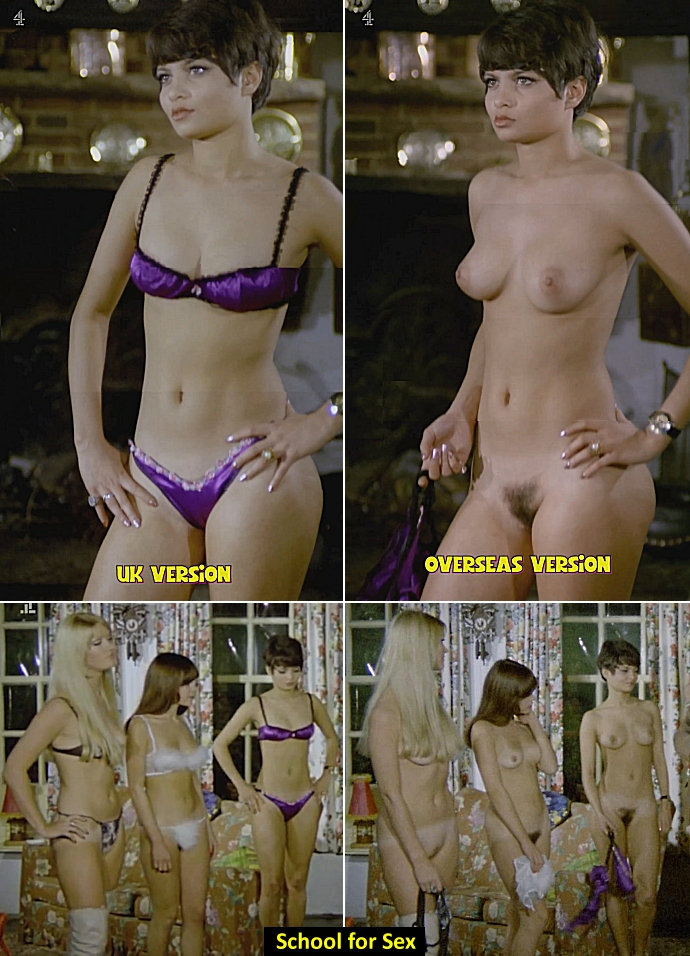
In a similar vein was the sci-fi comedy 'Zeta One' (1969). It featured well-known actors of the time James Robertson Justice and Robin Hawdon. A British spoof of spy movies, the screenshot below is from a scene where a spy played by Yutte Stensgaard returns to her lover after quickly checking on the dinner cooking in the kitchen. We highlight this scene in particular since it is in sharp contrast with how such scenes are now filmed. Note that there is no unrealistic modesty in front of her lover, she is not overwhelmed by embarrassment and unrealistically hiding her body behind hastily grabbed sheets or clothes. We've already discussed the 'modesty bedsheet' and the prudish habit of wearing of underwear while having sex, something that is a common feature of movies made in the last couple of decades, but it was apparently not something they thought made sense back in 1969. Back then we could put a man on the Moon and get out of bed naked, now ... not so much.

The next movie is 'The Last Picture Show' (1971), an American drama (shot in black and white) starring Jeff Bridges, Cybill Shepherd, Kimberly Hyde and Gary Brockette. The screenshots are of teenage friends skinny dipping in the local pool. It's not part of an orgy, they're just swimming and having fun.
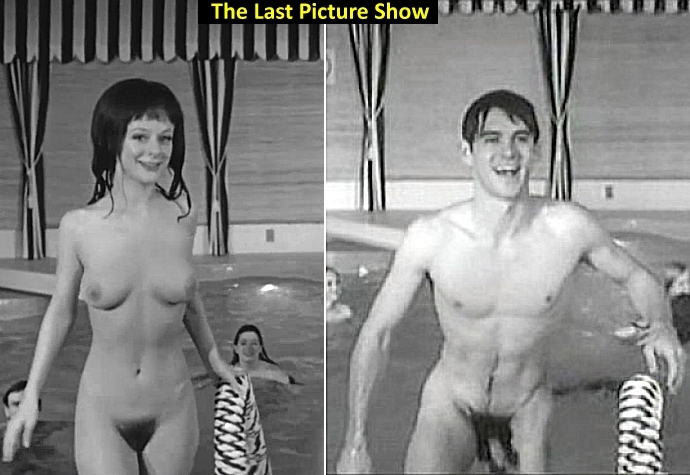
Next is the Australian drama 'Walkabout' (1971), featuring Jenny Agutter, David Gulpilil and Luc Roeg. A teenage girl and her younger brother find themselves stranded and dying in the arid Australian Outback, and are befriended by an Aborigine youth. When they finally find water, the girl goes swimming alone. And of course, having not planned on getting lost in the desert, she had not brought along a bathing suit.
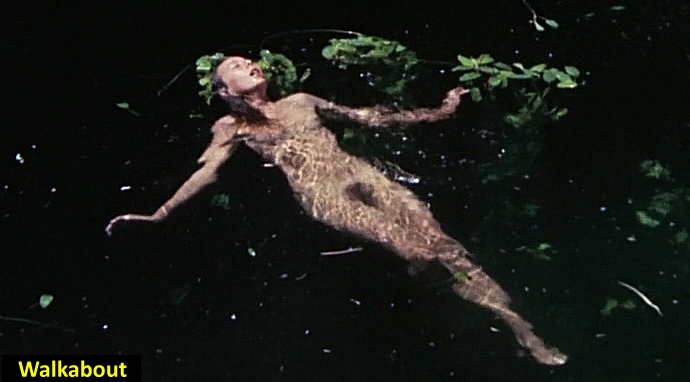
Then we have 'A Clockwork Orange' (1971), a sci-fi drama about a sadistic gang leader, played by Malcolm McDowell. In the scene below, it's implied that a rape is about to happen, but while nudity is shown, the rape isn't.
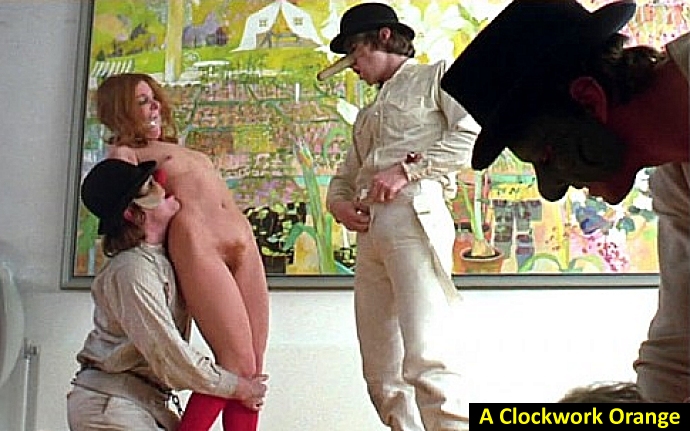
Next is the drama/romance, 'Last Tango in Paris' (1972), starring Marlon Brando and Maria Schneider. This is but one scene where Schneider is naked. While there are sex scenes, much of the nudity, as in this scene, is non-sexual.
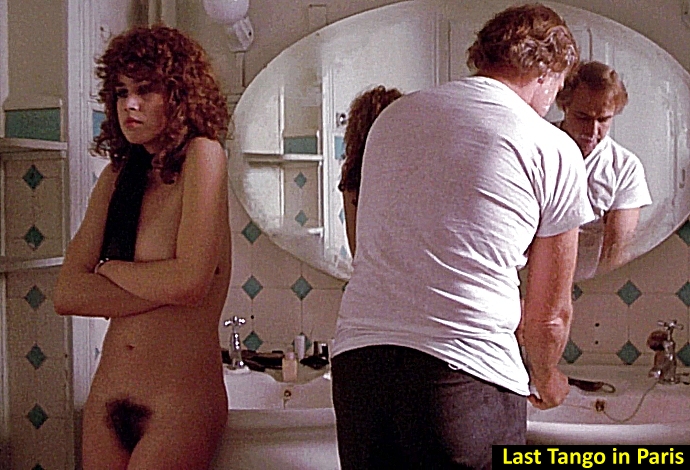
The Australian comedy 'Alvin Purple' (1973), was the most commercially successful Australian film at that time, and was followed by 'Alvin Rides Again' (1974). It starred Graeme Blundell, and this screenshot of nudity is just one of many from the movie.

The British sex comedy 'Confessions of a Window Cleaner' (1974), starred Robin Askwith, and 'It was the highest grossing [British] film in 1974'. It was followed by two almost as popular and profitable sequels, 'Confessions of a Pop Performer' (1975) and 'Confessions of a Driving Instructor' (1976). We read on the IMDb website that regarding 'Confessions of a Window Cleaner', 'In order to satisfy the censors of a worldwide market, three versions of this film had to be shot. The 'A' version was the traditional nude format, the 'B' version had both male and females wearing underwear, while the 'C' version (made for South Africa) had fully-clothed sex scenes'.Thankfully, we in NZ got to see the 'A' version (or at least it was the 'A' version by the time I saw it). But note that the scene below is one of the movie scenes that is described as a 'sex scene' when it clearly isn't, it is merely a scene shot in a women's shower room. No one is having sex! It features nudity but no sex, people need to learn that there is a difference. Nudity does not equal sex.
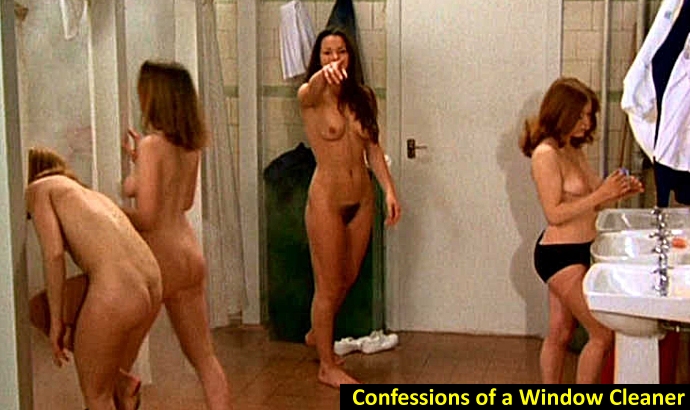
In the short British comedy 'Romance with a Double Bass' (1975), two strangers, a princess and a bass player, played by Connie Booth and John Cleese, both have their clothes stolen while swimming and must make it back to the castle without people noticing they are naked. And amazingly, even though they're both naked, they make it without being distracted by sex.
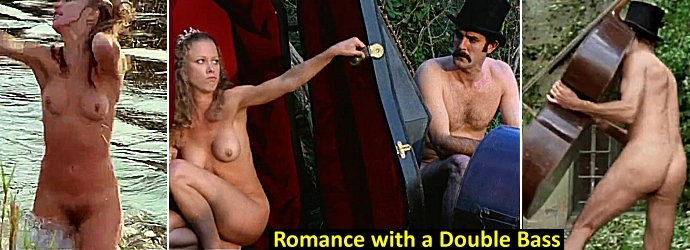
In 1976 Hollywood released 'The First Nudie Musical', a comedy/musical starring Cindy Williams (now most well known for the TV comedy series 'Laverne & Shirley'). It's a spoof that no doubt capitalised on what was happening in live theatre musicals at the time, meaning it featured several scenes of full-frontal nudity from both sexes, but mainly female. Elizabeth L. Wollman noted in her book 'Hard Times: The Adult Musical in 1970s New York City' (2013) that the movie 'featured more nudity than any film warranting an R rating had ever featured before', and yet it opened in New York City 'to generally enthusiastic reviews' and went on to become 'the fourth-highest grossing film in the country that year' [24]. For some reason NZ movie theatres never obtained the movie, at least not as far as I'm aware, and I only recently got to view it. And FYI, Cindy, certainly the most likeable and believable character in the movie, unfortunately keeps her clothes on. It was apparently an example of America producing and screening a movie that NZ censors weren't so accepting of, whereas the intervening decades have seen a real reversal, with NZ now screening movies that America has problems with.
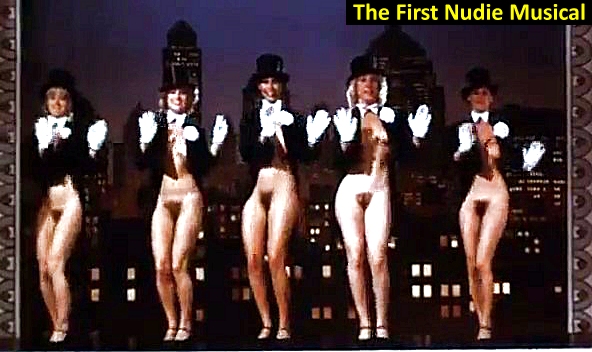
Another of the British sex comedies was 'Come Play with Me' (1977), which was so popular that it 'ran continuously in London's West End until March 1981 [and] it remains the longest running British film of all time'. It starred, among others, Mary Millington (below right), who was Britain's #1 sex symbol of the 1970s, and Penny Chisholm (below left). And like 'School for Sex' and 'Confessions of a Window Cleaner', it was also shot in a nude and clothed version, plus a (now rare and possibly even lost) version with pornographic inserts which some of the famous and conservative old male actors who also starred in the movie weren't at all pleased about when they found out.
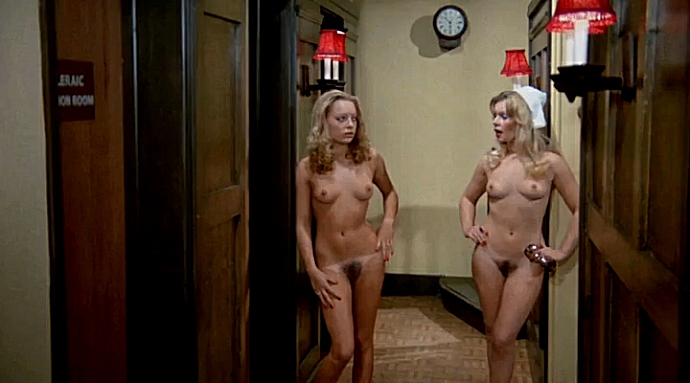
The irreverent and blasphemous comedy 'Monty Python's Life of Brian' (1979) is of course a brilliant movie. The full-frontal nudity of Brian (Graham Chapman) and Judith (Sue Jones-Davies) is completely natural and just a bonus.
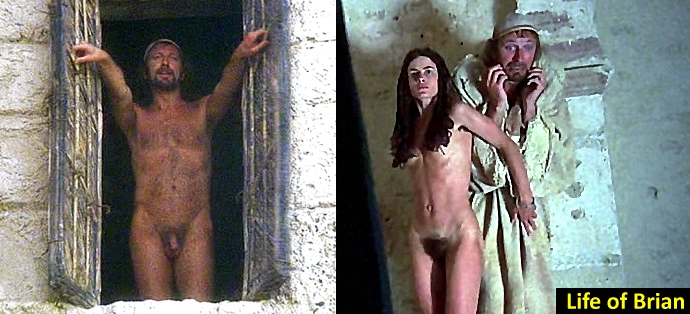
This is the famous shower scene from the American comedy 'Porky's' (1981), starring Dan Monahan, Mark Herrier and Kaki Hunter, where high-school girls in the gym shower are actually shown — surprise, surprise — naked, in a shower of all places.

The movie of George Orwell's dystopian novel, '1984', was coincidentally released in 1984 and starred John Hurt and Suzanna Hamilton (below). Obviously it's not a fun movie, but the nudity is realistically portrayed.

The next screenshot is from 'The Advocate' (1993), starring Colin Firth, Sophie Dix et al. It's a drama set in 15th century France where a lawyer is called upon to defend a pig in a murder trial. Interestingly, the premise is based on historical fact, and just as the religious nonsense of that era is realistically exposed, so too is the nudity.
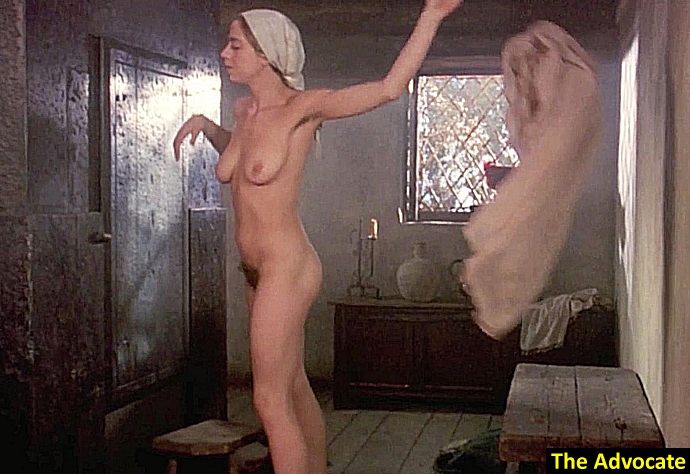
Next we have the Aussie movie 'Sirens' (1994), a drama featuring Hugh Grant and Tara Fitzgerald. It concerns an artist and the problem the Church has, naturally, with the sexual theme of some of his paintings.
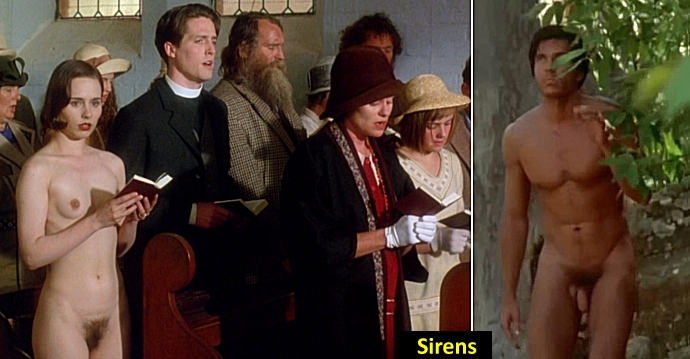
Finally we have Rachel Weisz relaxing naked next to a swimming pool in the movie 'Stealing Beauty' (1996), revealing the fact that nudity while sunbathing or swimming wasn't always viewed as indecent.
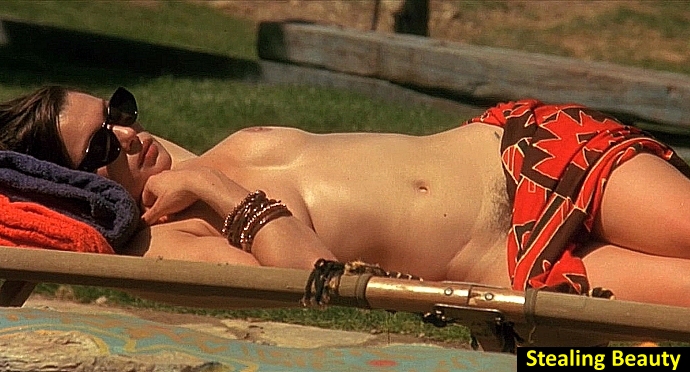
While the majority of movies from this period had little or no nudity (equally they had little or none of the graphic violence seen in many current movies either), the nudity that was shown never seemed to shock or offend your typical moviegoer. Worldwide, small groups protested outside theatres showing 'Monty Python's Life of Brian', and it was even banned in some countries, like Ireland and Norway, and in many towns in England and the USA, but they were upset and offended by the blasphemous nature of the film (even though they hadn't actually seen it!), not by the nudity. Back then moviegoers weren't all that surprised that nudity was shown in a sex scene or in the shower or while swimming alone in a desert pool, since they were all places where nudity would be expected in real life. Of course, nudity is still expected in those same situations today, the only difference is that movies are now, except on rare occasions, very reluctant to actually show full-frontal nudity anymore. We still see the sex scenes, the shower scenes and the skinny dipping scenes, except that actual nudity is almost never shown, only implied. Let's look at some screenshots from movies and TV shows made in the last decade or two that have been on NZ TV of late. And we haven't censored anything or picked non-revealing shots, this was as graphic as they got regarding their depiction of nudity. Here's the combined shower and sex scene with Berenice Marlohe and Daniel Craig in the 2012 James Bond movie 'Skyfall'. The movie is packed with graphic violence, torture and death from start to finish, but any nudity and sex is merely implied, and none of the other recent Bond movies are any different.
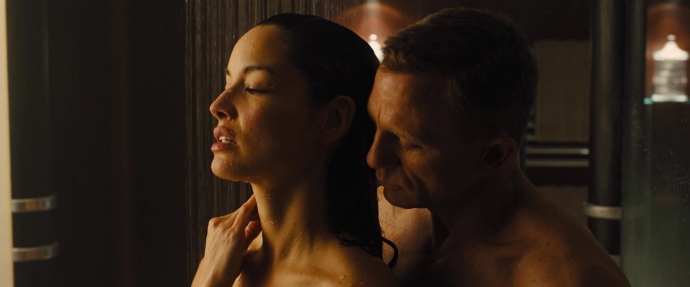
And while it was apparently deemed too traumatic to allow movie viewers to see Bond or his lover naked, the producers thought it important that we later saw her tortured and murdered, used as target practice by the villain:

Next is Amy Adams in the sex scene from 'Batman v Superman: Dawn of Justice' (2016). Again, plenty of violence and death in the movie that we get to witness, but we have to imagine the nudity. Asked on the Graham Norton show about being naked in this scene, Amy Adams replied, 'No, they actually put you in very unflattering modesty garments [and] stick-on things'. The guy, Superman, even remains fully clothed in this brief scene, which only implied that sex followed:
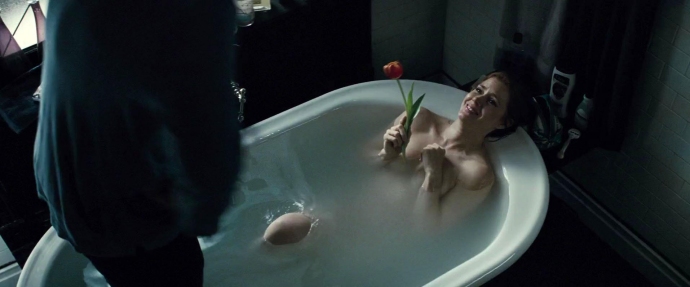
Now we have Kelly Brook in the TV comedy 'One Big Happy' (2015), where her character is seen unashamedly walking around her apartment naked, much to the embarrassment of her prudish female roommate. But of course the viewer is not allowed to see any nudity, the show's producers have blurred out all the naughty bits so as not to shock us. They've deliberately included this scene so that we'll imagine her naked, so that we can't help but visualise in our minds what those blurry bits are hiding, but even though we're now seeing a truly naked woman in our mind's eye, they somehow think that we'd be harmed if we actually saw that naked woman on the screen as well.

Zooey Deschanel features in the next image, a gratuitous shower scene from the movie 'The Hitchhiker's Guide to the Galaxy' (2005), a highly anticipated but ultimately terrible American adaptation of the original and brilliant British radio show, books and TV series. The Americans, typically, felt they had to alter the zany humour and story to match American sensibilities (destroying its original appeal in the process). So of course they had to include a shower scene, but keep it family-friendly at the same time. As the website that provided this screenshot noted, 'the shower scene never showed anything close to being naughty. It merely made you think naughty'. There were no shower scenes in the original material, this was an addition purely for the American viewers, most of whom, ironically, don't like nudity, not even implied nudity, and who probably felt quite uncomfortable throughout the entire scene. Again, they definitely don't want to show us a naked body, or even have us think of naked bodies, so apparently the best way to keep our minds focused on other things is to show us a beautiful woman having a shower, albeit from-the-shoulders-up. Their logic on this matter is confusing to say the least.
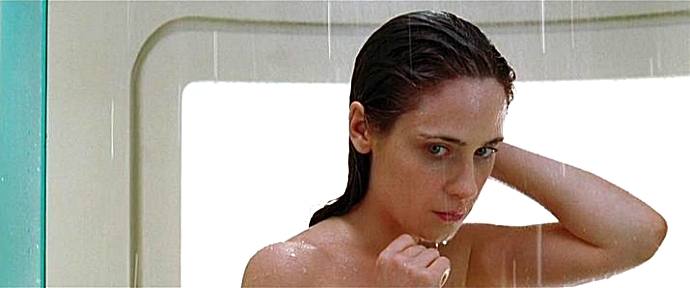
Next we again have actress Rachel Weisz, this time in the movie 'Agora' (2009), an interesting historical drama set in ancient Egypt where Weisz plays the famous pagan philosopher Hypatia of Alexandria. The movie ends with a crazed Christian mob abducting Hypatia, stripping her naked, murdering her, and then burning her body on a bonfire (and yes, Christians actually did that). The movie clearly showed running scenes of the Christians as they violently rioted and killed pagans and Jews, but when Hypatia's robe was ripped from her, suddenly the camera retreats to this single distant shot of her naked, then changes to just a shot of her head and shoulders as she is killed. Again, movies are now happy to show disturbing violence but not nudity, as if the evil murder of an innocent woman by cowardly Christians would be far less shocking and offensive to viewers than seeing her naked body would be.

This next screenshot is from the NZ TV comedy '800 Words' (2015), and the scene takes place on a nude beach that's popular with the locals, one that these three friends often spend time at. So if it's a nude beach, and the three people have seen each other naked many times, why is the woman covering her breasts as if she's been suddenly surprised in the shower, and why is the surfboard strategically placed to hide everyone's genitals? The woman (whose character in the show has no qualms about being naked around others) is of course acting totally out of character so as to hide her body from the TV viewer, not from either of the men, who of course can still see her genitals. We hate it when characters are forced to act in ridiculous ways, behaviour that would never be seen in real life, just because producers want to hide things from the viewer.
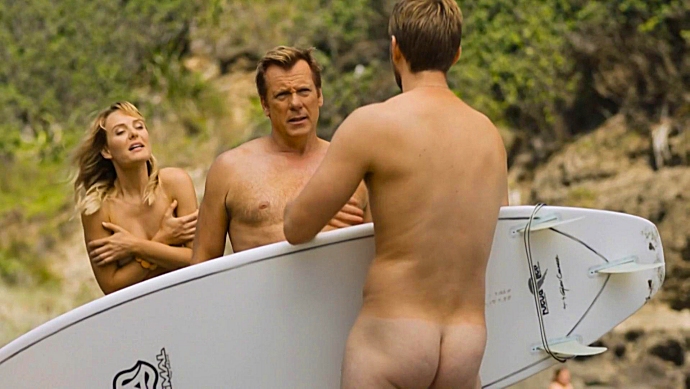
The 2015 move 'Trainwreck' with Amy Schumer and John Cena provides the next image. It is of course a sex scene, which is implied by their dialogue, their movements and Cena being naked. But do you see a problem with the image? For us, it's Schumer's unbelievable state of undress. Especially since Schumer's character was, to put it nicely, a 'promiscuous slut', and after they had sex the movie shows the naked boyfriend in the bathroom with just a towel hanging over his still erect penis. That was perfectly OK with the producers it seems, however suggesting that Schumer would be naked while having sex was clearly a step too far. But just as you didn't actually see the erect penis, the hanging towel merely implied it was there (all thanks to a prosthetic of course), you also didn't have to actually see all of Schumer's naked body, so why with a bit more camera trickery didn't they even pretend she was naked? She was happy to have a scene where a guy was giving her (pretend) oral sex, under the sheets, but not one where she pretended to be naked. What is this problem people have with simple nudity, even pretend nudity, but not with pretend sex acts?
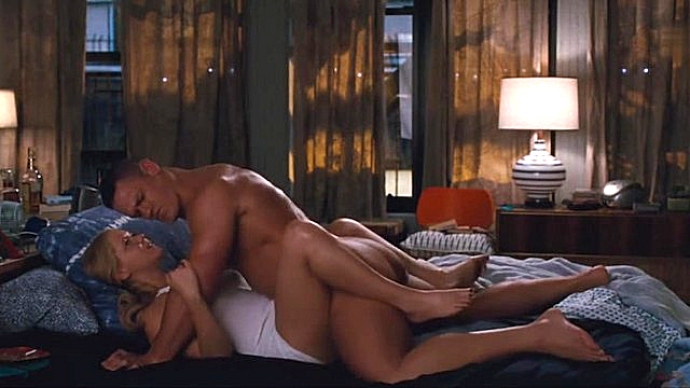
The following screenshot is from the movie 'Z for Zachariah' (2015), starring Margot Robbie as a nuclear apocalypse survivor living alone in a remote valley. With good reason, she believes she could well be the only person left alive on the planet, or at least in the Eastern United States. And yet, believing she is totally alone, and in a darkish room, the movie still shows her character wearing panties while bathing, scrubbing any possible trace of radioactive contaminants from her body. She's just returned from a trip outside the valley, so the scene makes sense, as do other scenes in the movie regarding radiation poisoning, technology, agriculture etc in a post-apocalyptic world, so why does the movie get it so wrong when showing how someone would do something simple like taking a bath? Unlike older movies where the character would naturally be shown naked, current movies still want viewers to think about nudity while being too afraid to actually show it.
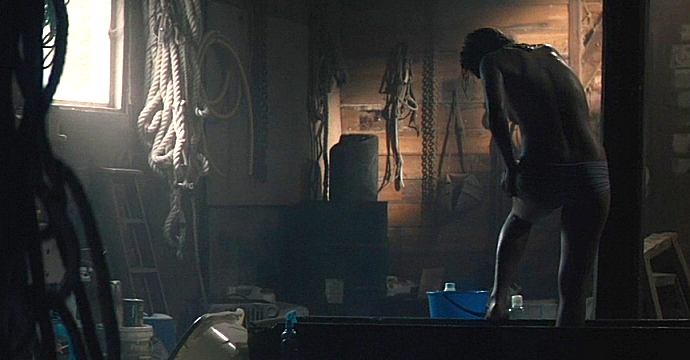
In another bathing scene, we have Kelly Hu from 'The Scorpion King' (2002), starring alongside Dwayne Johnson. An action movie set in the Middle East some 5,000 years ago, we see warriors battling, and dying, with swords, arrows, knives and even explosions, there is no shortage of graphic violence, torture and betrayal. But when Kelly's character is shown bathing in the royal palace, her long hair conveniently covers her breasts and a well-placed bowl of fruit hides any glimpse of pubic hair (not that there was any risk of that as she was actually wearing flesh-coloured underwear). Again Hollywood delivers a scene where innocent nudity is expected but then wimps out and utilises the infamous nudity-hiding props.
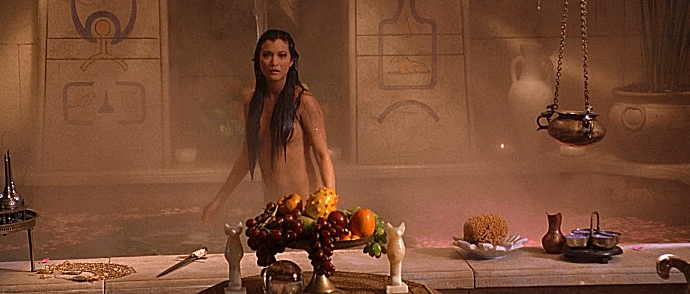
In yet another bathing scene (Hollywood loves bathing scenes), the image below shows Charlize Theron as the evil queen in 'Snow White and the Huntsman' (2012), also starring Kristen Stewart and Chris Hemsworth. The scene was quite gratuitous, it was clearly included just to titillate. But even if it had relevance to the story, what woman enters her bath keeping her breasts covered as if she knows millions of movie viewers are watching her? And let's remember that this is the evil queen, an extremely ostentatious and pretentious woman, who had been assured by her magic mirror that she is the most beautiful and sexiest woman in the land. She is the last person that would want to hide her self-assured perfection, she wants the world to see and acknowledge her beauty so her sudden modesty makes no sense. Zeus knows how many people were violently killed in this movie (certainly hundreds, maybe thousands) as the evil queen and Snow White fought for control of the kingdom, and while we had to witness many of these graphic battles and gruesome deaths, even see the queen murdering Snow White's father, thankfully the producers hid those shocking nipples from us.
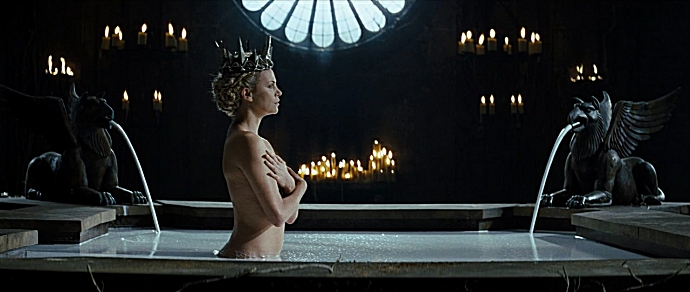
The next movie "nude" scene features Olivia Wilde's character miraculously rising naked from the flames in 'Cowboys & Aliens' (2011). Wilde has said of the scene, 'It was kind of strange because I was half-naked in front of a bunch of people, including the crew, a bunch of Apache warriors, a bunch of cowboys, and Daniel Craig, who I had to stand in front of basically naked'.It's revealing that Wilde says she was only 'half-naked' and only 'basically naked', rather than 'fully naked' and 'really naked', which implies that she wasn't actually naked at all, and as the screenshot below shows, all that is shown (at a distance and in the dark) to the moviegoer is her naked shoulders and part of her butt, which is probably the 'half-naked' bit. The front of her body was likely fully covered, and why wouldn't it be, since it was never going to be seen.
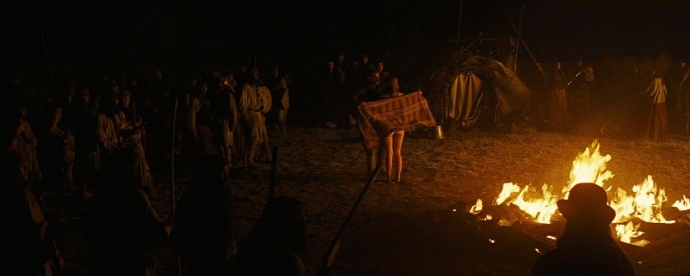
Our next example of a nude scene also shows no nudity, however the filming of it has an interesting twist. It's from the excellent comedy/thriller 'Happy Death Day' (2017) starring Jessica Rothe, where her character decides to walk through her college campus completely naked for something different to do (trust us, it makes perfect sense in the movie). As is typical, the most we see of Jessica is in the following image: 
Knowing that only her bare back is seen in the movie, it would be reasonable for moviegoers to assume that she was likely wearing low-slung pants and a strapless bra. But that would be wrong. We read later that: 'Even though they only filmed and show her face and bare back in the movie, Jessica Rothe said in a 2017 interview that she decided to go totally nude for the scene where Tree Gelbman walks around campus naked in order to feel the same rush as her character. She called it a very "liberating" moment'.It is surely very rare for an actor to willingly film a scene naked (in front of extras and a large film crew on a real college campus, not a closed studio set), knowing that no nudity will be actually be shown in the movie and therefore nudity isn't even needed for the shot. Unlike Olivia Wilde's 'half-naked' scene in the previous example of 'Cowboys & Aliens' where she only pretended to be naked, which required careful editing to not reveal that fact, Jessica Rothe was actually naked and yet all that real raw footage is edited to just a shot of her bare back for the actual movie. However the producers had no problem with showing violence; the movie was essentially one gruesome murder after another from start to finish, each one different so the viewer didn't get bored. And again, we're not saying the violence should have been cut, it was crucial to the story, but if it's felt that we viewers could handle seeing multiple violent deaths, why couldn't we handle a few seconds of a beautiful woman happily walking around campus, naked? The next two screenshots are from 'Terminator Genisys' (2015), starring Emilia Clarke and Jai Courtney. Their characters had to be naked to use a time machine, as established in the original 1984 movie 'The Terminator'. But while this movie had non-stop graphic violence, like all the Terminator movies, actual nudity was not something the producers were willing to make viewers sit through. Forced to be naked because of the storyline, the producers avoided shocking viewers by utilising prudish camera angles and shadowy, distant shots where the actors (supposedly portraying brave, confident warriors from the future) are told to desperately cover their bodies (suggesting that Americans will still be ashamed of nudity in the future).
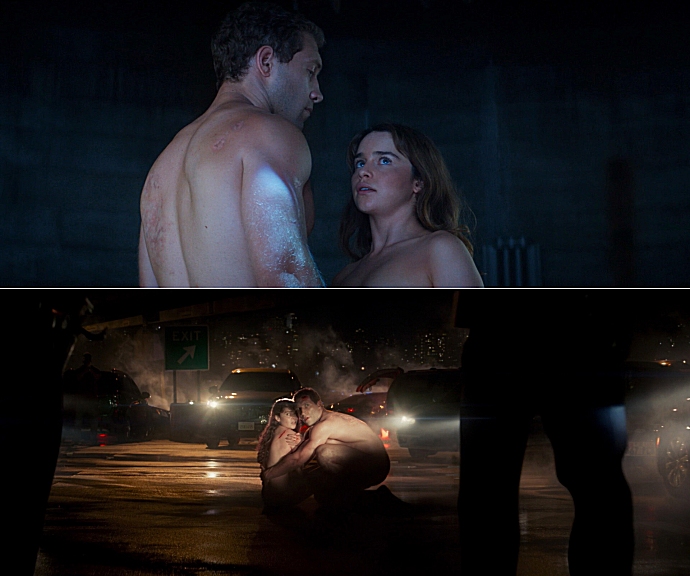
Two years later they made another Terminator movie, 'Terminator: Dark Fate' (2019), with a new director but still the same old theme — plenty of exciting violence, lots of deaths, but no nudity. Of course there is a nude scene since our time travellers arrive naked from the future as per usual, but as usual the nudity is more suggestive than obvious. That said, although the moviegoer isn't aware of the fact, Canadian actress Mackenzie Davis not only performed her own stunts in the movie's opening fight scene, she also decided to film it totally nude since her character would have been naked. While we applaud Mackenzie's willingness to simply be nude in a nude scene (what a revolutionary idea ... like something from the 1970s), the producers still go out of their way to hide this realism, and Mackenzie's honest input to the scene was largely wasted. Below are some screenshots of the fight scene from the movie, starting with our time traveller Mackenzie crashing naked to the ground. She is then seen fighting with several police officers, and finally she surveys their beaten bodies. You'll notice that the only time you see her full body "clearly" is from behind (in the top and bottom photos) where it's dark and at a distance. The centre photos are representative of the actual fighting, and while they show her closer, her body is always shown moving very fast from numerous angles and there is never any full-frontal nudity seen. The one time there definitely should be, when she is shown running towards the camera, they opt only show her lower legs, like an old 1950s movie. This was a case where the actress really was naked, where they didn't have to employ any tricks to make it simply look like she was, and yet the way the video footage of the scene was edited for the movie gave exactly that impression. If you've seen the movie you'll know they didn't film all their scenes of graphic violence in the dark and from a respectful distance, just the nude scene. They expended considerable effort to show the exciting violence of the scene while largely hiding the real nudity. While it's now acceptable to see a woman beat up men in a fair fight (at least in the movies), seeing that woman naked is still taboo.
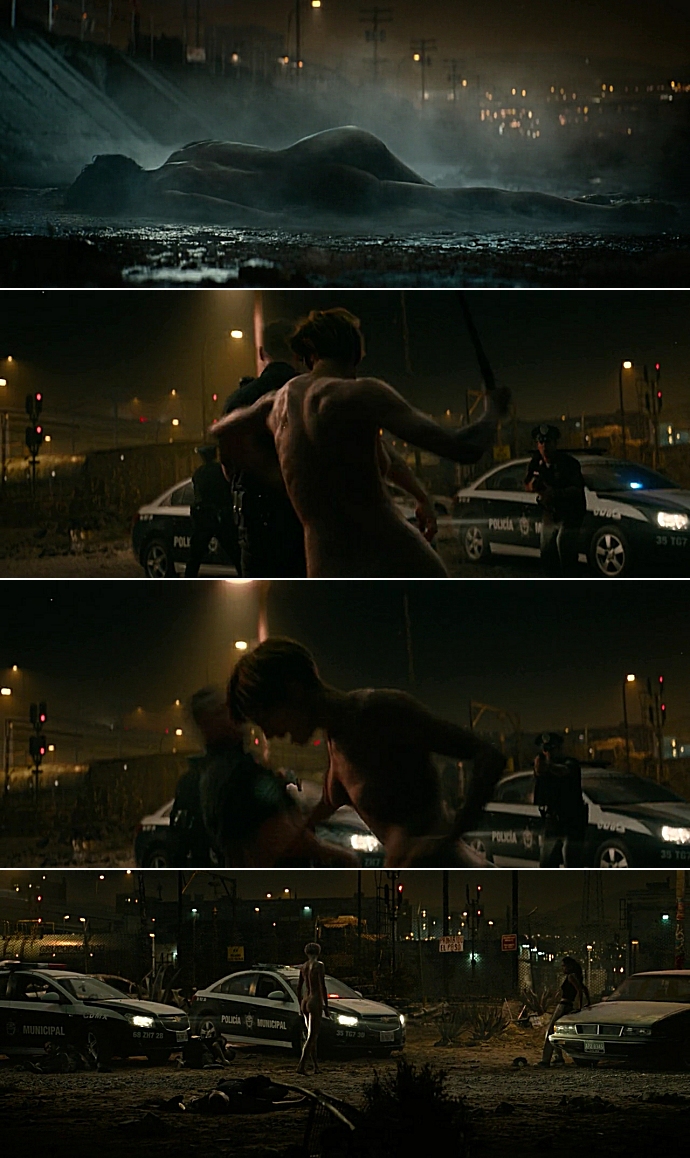
The next movie is 'The Northman' (2022), about a Viking out for bloody revenge. It's rated R for strong bloody violence, but the bit that intrigued us was a report by the director stating that historical authenticity was vital, right down to the two Viking warriors being naked as they fought each other (on an active volcano). We're all for historical authenticity in movies, but then it's revealed that the actors weren't actually naked. The director has said that 'they were wearing thongs because no one wanted to get their bits chopped off', but surely they weren't using real swords or filming on a real volcano! He then added that 'we actually had to add some CG genitals for certain shots so that they didn't look too Ken doll-ish. You've got to make it look real'. In another interview one of the actors involved 'explained that it was actually very important for the battle scene to contain nudity'. And yet ... there was no nudity. These conversations suggest there was nudity even as their words say there most definitely wasn't. And while we're sure the fact that the actors weren't really naked was obvious to the film crew, look at the screenshot below (and this is as clear as it gets) and ask yourself whether the time and money spent on adding two CGI penises was worth it, did their effort 'make it look real'? What .. you can't see them? As far as the viewer is concerned the actors could well be wearing snug-fitting Batman pyjamas. It's just ridiculous to go on about the quite invisible nudity and (fake) male genitals present in a battle scene and completely ignore the graphic violence, but that's Hollywood for you.
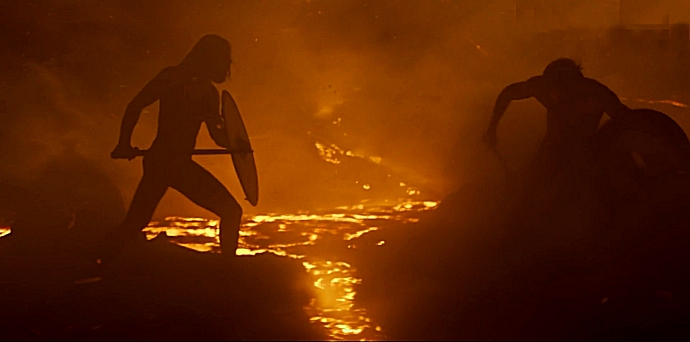
Our last movie example is a couple of screenshots from the latest remake of 'The Mummy' (2017), starring Tom Cruise and Sofia Boutella. If you think the only nudity in the movie is brief and pretty hard to make out, especially compared to the nonstop violence, then you'd be right. But again this is our point, producers of movies these days are very reluctant to provide anything but fleeting glimpses of nudity, and even then they must be hidden in deep shadows.
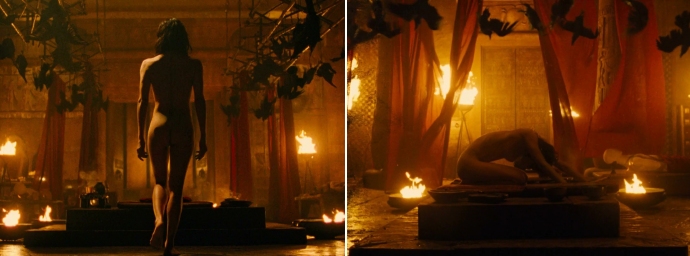
Finally, a friend reminded us of a now-and-then political example of how attitudes have changed, where in the not so distant past nudity was not so offensive that it couldn't be used in election campaigns. In the following image, the poster on the left, created by George Noordanus and Hendrik-Jan Koldeweij, promoted the Pacifist Socialist Party (PSP) in the Dutch parliamentary elections of 1971. The election poster on the right is of course a current one and features Donald Trump, a man infamous for such quotes as, 'Grab 'em by the pussy' and 'You're disgusting, you're disgusting'; the first quote being Trump's preferred method of greeting attractive women, and the second quote Trump uttered when a lawyer and mother requested a break from a deposition to breastfeed. Can you imagine any political party today using nudity in their advertising? There would be a deafening public outcry and it would be political suicide. Today's screwed up society will happily embrace naked aggression but not naked bodies; they'll incomprehensibly vote for those that expose their stupidity, racism and sexism but not those that expose their flesh; and they'll willingly accept fake news but not real bodies. Attitudes have certainly changed from then to now, but for those that concern nudity and violence, they've changed for the worst. 
Thus, with these examples we'd argue that the chance of encountering nudity in the public sphere or the movies has indeed decreased over the last few decades. But there's more to it than just that. Has this decrease in sighting nudity seen a similar decrease in the risk of harmful behaviour? Are we, as a society, better off with far less nudity? Earlier in this article we mentioned five groups that are currently exposed to nudity with no ill-effect (beauty therapists, medical practitioners, nudists, censors and watchers of porn), and now we've just listed five more historical examples (streaking, saunas, changing rooms, beaches and movies), where people in the 1970s and '80s might have encountered more innocent nudity than they would today. And yet again, there was no ill-effect noticed, back then society wasn't suffering harm as a result of people viewing a naked body, and we'd argue that society was generally much safer then than it is now. We'd also argue that generally people had a much healthier and more realistic view of what normal, natural bodies looked like, and weren't worried terribly about body image as many now are. Girls suffering from anorexia nervosa and bulimia were unheard of. When I was a teen growing up, no women were getting breast implants or even wishing they could, unlike now where there is an increasing number of parents buying their teenage daughters implants, not to mention women getting labiaplasty and other cosmetic genital surgery. And men are also increasingly seeking cosmetic genital surgery. Now young men and women are fooled into thinking that the performers they watch in pornography look the way we're all supposed to look, and if your genitals and breasts and overall body shape doesn't match a porn star's, then you need some work done, and should keep covered up until the surgery scars heal. Of course, just as with the pornography now, back in the '70s and '80s most women didn't look like the nude models in 'Playboy', but back then most models still looked normal, like beautiful 'girl next door' types that you could occasionally expect to see in real life, women that hadn't achieved their looks through surgery. Look at the bodies in the above movie screenshots from the 1970s and '80s, they're attractive, yes, but they're also quite normal. Men and women were far more comfortable with and accepting of different body shapes, and that's probably because they saw normal looking naked bodies, bodies that resembled theirs somewhat, not just someone's idea of a perfect body that was made in an operating theatre and further improved in Photoshop. Look at the following current image selling underwear, not much diversity there. Even the models in the advert probably lament the fact that they don't have the "perfect" body that the finished photo appears to show, that magazine editors likely still found the need to tweak their bodies, making it even more unrealistic that real women could obtain that look.
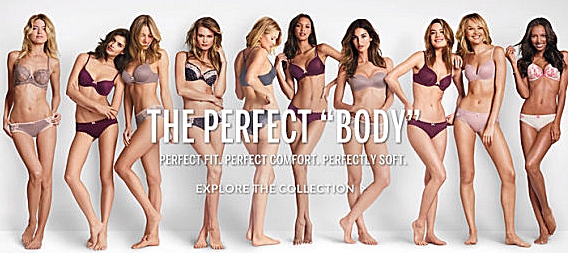
So no, we don't think society is better off having eliminated encounters with innocent, public nudity. Who controls movie content — the producers or the censors? Without doubt, there's lots and lots of graphic violence and profanity in today's movies, much more than in the past, and we're arguing that nudity and sex has gone the other way. Of course you'll hear people complaining that there is actually far, far more nudity and sex about these days than there used to be, but they're being disingenuous. What they really mean is that there is far more pornography about today, and free access to it is child's play. And that's true, but what we're arguing is that nudity in mainstream movies and TV shows has reduced drastically, not that access to pornography has reduced. If you're not deliberately seeking out pornography and only watch mainstream movies, if you watch what's on view in public spaces, the content that most people view for entertainment, then you'll see far less nudity than people did several decades ago. Even nudity in magazines has disappeared from sight. In the 1970s and '80s publications featuring nudity were on every NZ bookshop's magazine rack, openly displayed alongside motoring and gardening magazines, everything from 'Playboy', 'Penthouse' and 'Fiesta' to nudist magazines such as 'H&E' (Health and Efficiency) and 'New Zealand Naturist'. Below are some covers of magazines published during the '70s and '80s, all openly displayed in corner dairies, bookshops, supermarkets and petrol stations around the country.
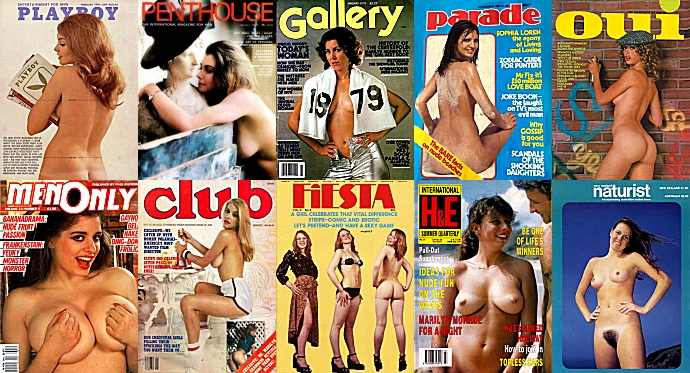
Then nationwide in the 1990s NZ magazine retailers suddenly and inexplicably became troubled with the public display of such magazines. Retailers started sealing these magazines in clear plastic, with tape or paper covering any "naughty" bits on the cover, so that no one could "accidentally" open one and be traumatised by viewing the nudity inside. But apparently this level of censorship wasn't enough, and shops then moved to wrapping the magazines totally in brown paper with just its title scribbled on it, meaning that now sensitive shoppers wouldn't be shocked by the thought that they were even near a magazine containing nudity, and then eventually these problem magazines pretty much disappeared from shops completely. We suspect that actively hiding a product (never a good idea when you're trying to sell it), the rise of the Internet (and online porn) and an increasing public prudishness towards nudity all contributed to the demise of the magazines. Why NZ magazine retailers moved to suddenly censoring the magazines is unclear; there was no growing public outcry to have them removed from sale, there were no new laws banning their public display, just the opposite in fact with pornography finally becoming legal in NZ in 1993, and yet these magazines were not pornographic and very tame compared to what was available in America and Europe. One wonders whether some ultra conservative group, no doubt prudish Christians, were working in the shadows to get these "filthy" magazines off the shelves and so prevent them from harming children. Back in its heyday, the common excuse offered by men embarrassed that they had been caught buying a 'Playboy' was that they only bought it for the articles, not for the naked centrefold. Hoping to boost flagging sales, and apparently sucked in by this childish excuse, 'Playboy' even removed all nudity from their magazine back in 2016 and relied solely on the quality of their articles for sales, but that move failed (obviously) and they reinstated nudity a year later, with their Chief Creative Officer admitting it was a mistake, explaining that 'Nudity was never the problem because nudity isn't a problem'. What annoys us is that these same NZ retailers that by their actions effectively scuttled the open sale of magazines such as 'Playboy' and 'Penthouse', anything with nudity, happily continued to promote and sell, and still do, others products such as tobacco and/or alcohol. The greedy hypocrites aggressively push the sale of products that clearly harm and kill people, that cause untold suffering and economic loss on an unacceptable level, while at the same time conspired to limit the sale of a product that has never harmed or killed anyone, that in fact has only brought pleasure. Ask yourself which you would rather find hidden under your teenage son or daughter's bed, cigarettes and whisky or a nudie magazine? Remind us again, does nudity cause cancer or drunk driving and domestic abuse? No! So why can we now buy tobacco and alcohol at the supermarket but not a magazine containing nudity? Between the '70s and '80s and today we have seen a complete reversal, with a harmless product pushed off the shelves and replaced with harmful, but hugely profitable, ones. We can understand why greedy and uncaring retailers sell harmful products, but not why in the 1990s they suddenly and deliberately started to censor and therefore damage the sale of a harmless product — magazines featuring nudity — a product that they had previously been happy to sell. What changed from the '80s to the '90s? As for the movies, it's been suggested that the promise of full-frontal nudity and (fake) sex scenes helped sell mainstream movies decades ago, but since scenes of real sex can easily be found in online pornography these days, for free, going to the bother of putting brief scenes of pretend sex in movies no longer helps to sell tickets. It takes time and money to fake it, some actors are uncomfortable with nudity, and some prudes will always complain. The solution: it's simply more bother than it's worth, so let's lose the nude scene and add some more explosions and killing instead! So, we could go on and on, listing untold examples from mainstream movies made in the last couple of decades that feature scenes that imply nudity, and where nudity is naturally expected in the real world, such as sex, shower and bedroom scenes, changing rooms, strip clubs, nude beaches etc, but where at the same time, nudity is never actually shown, unlike prior decades. Now it's all about suggesting nudity, and then letting the viewers' imagination do all the heavy lifting. And again, that's the strange thing, movies don't shy away from deliberately putting their characters in situations where the viewer is forced to imagine the characters naked. If movie producers don't want us thinking about nudity, then why do they always have some crucial element to the storyline unfold while the person is in the shower or getting undressed? Look again at the above screenshots from 'The Mummy'. What happens in that scene is essential to understanding the movie, but there is no logical reason why the Egyptian princess, played by Sofia Boutella, had to be naked rather than clothed. The nudity, shadowy as it is, was completely gratuitous. Likewise, if they don't want us thinking about sex, then don't have the characters rolling around moaning under the sheets. It's not rocket science, if nudity and sex is offensive and shocking and not something you want to show us, then why are you continually planting the idea in our heads with your suggestive scenes in the shower and the moaning under the covers? So what explains this apparent paradox, where movies shun frank nudity and yet many promote the idea of it at the same time? Money is the answer. Movie studios and producers, first and foremost, want to make huge profits, entertainment comes a distant second, or perhaps third after fame. The reality is, we believe, that most movie producers, directors, script writers etc would happily put full-frontal nudity, and perhaps even graphic sex, in their movies and TV shows for adults if the scene called for it. No one spends millions trying to make their spaceship interiors, car chases, fight scenes and aliens look as realistic and as believable as possible, and then makes their nude scenes and sex scenes look as though they were filmed by a naïve 5-year-old under the direction of an embarrassed Pope. Ensuring historical, scientific and physical accuracy in movie sets, costumes, props and special effects is one of the major costs of making a movie these days. And yet, even though filming a naked body is simple and dirt cheap in comparison, movie producers deliberately let realism slide when it comes to depicting nudity and sex, so why is this? The reality is that they're rewarded handsomely at the box office for making movies such as 'The Bourne Identity' (2002) starring Matt Damon, or 'Casino Royale' (2006) starring Daniel Craig as James Bond, movies that feature nonstop action that is visually stunning, exciting and violent, but they're punished at the box office for making movies containing full-frontal nudity and/or graphic sex.
'The industry was getting a lot of pressure from religious groups in the '20s to police itself and to keep itself in check. The moguls who ran the studios had very little interest in putting out pictures that were going to cause trouble, because basically it was always motivated by profit'. [3]The Church also desperately wanted to control what movies could show, meaning what messages they could convey to the public, and the studios weren't in business to anger the Church or its hundreds of millions of followers, they just wanted to make money. Thankfully the Church these days has much less influence over the studios (although certainly not zero), leaving the studios largely free to just concentrate on generating profit. Now all mainstream movies are generally given a rating by a censorship organisation, and in America this is the Motion Picture Association of America (MPAA). US TV shows are different, they aren't rated and the broadcasters themselves decide what they'll screen, although the FCC can fine them for 'violating public decency standards' (whatever that means). If a movie is rated G, then moviegoers of any age can buy a ticket and watch it, but putting even brief nudity in a movie can see it rated PG-13, which limits the audience, and the ticket sales. Movies with full-frontal nudity would likely receive at least an R rating (Restricted), meaning those under 17 must be accompanied by an adult, or worse still, it would be rated NC-17 (NC means "No Children"), meaning "adults only" and no one 17 or under can see it. And the thing is, restricting a movie's potential audience to those over 17 could see a movie losing a fortune at the box office, possibly not even making a profit at all. We read that as of 2006, 'No film rated NC-17 has been a major box office success'. Director Martha Coolidge has noted (in 'Indie Sex: Censored') that: 
'The studios are convinced that if you're a G or a PG, your movie can make more money because it crosses more markets than if it's an R or an NC-17'. [3]And writer/director Jamie Babbit argues that: 'You absolutely need an R rating [or lower] in order to get the film into any kind of mainstream cinema in the US. I went to like a Sundance or Toronto film festival, and they ask you, "What's your rating?", and I said I have an NC-17. No one would buy the movie, because it really limits what theatres they can put it in'. [3]Movie critic Dana Stevens, in discussing the movie 'Young Adam' (2003), said it was 'a movie that appealed its NC-17 rating, tried to be released as an R movie and failed, and probably lost a lot of business as a result'. Thinking about the sex scenes in the movie, she mentioned a scene that showed cunnilingus: 'You could make a feminist argument that that's an unusual scene to see in movies, and that it might be the content of that scene more than the raciness of it that pushed that movie into NC-17 territory. I would imagine that implied that female-on-male oral sex [fellatio] might be more acceptable to censors. You know, it seems to be happening all the time in R rated movies'. [3]As quotes from actors Kat Dennings and Ryan Gosling both highlight shortly in this article, censors are apparently more accepting of seeing a man receive sexual pleasure than a woman, just as they are more willing to let scenes featuring naked female bodies through than they are scenes of naked men. As director Adam Rifkin has said: 'There's always been a kind of double standard, there's always been the acceptance of female nudity more so than male nudity' [4], or as actor Peter Sarsgaard observed, 'The ratings board can only handle so much penis, they can handle a lot of tits and ass'. [3] Of course the MPAA ratings board isn't law, and filmmakers can include as much male and female full-frontal nudity and realistic sex scenes in their movies as they want in order to try and reflect what's happening in the lives of real people, but as movie critic Stephanie Zacharek points out: 'If you're a filmmaker and you want to do that, you have to be ready to face the consequences, and you have to realise it's going to limit who's going to see your movie'. [3]  In his book 'The Naked Truth: Why Hollywood Doesn't Make X-Rated Movies' (2007), Kevin S. Sandler quotes director Wayne Kramer, who asked in relation to his movie 'The Cooler' (2003),
In his book 'The Naked Truth: Why Hollywood Doesn't Make X-Rated Movies' (2007), Kevin S. Sandler quotes director Wayne Kramer, who asked in relation to his movie 'The Cooler' (2003),
'People get shot in the head and bashed to a bloody pulp in movies all the time, but we get an NC-17 for a glimpse of pubic hair. Why is that, do you think?' [5]Put graphic violence in your movie and the ratings board will quickly give it the tick of approval, but put in nudity and/or sex, whether it's graphic or not, and your movie will be given a rating that severely limits who might see it. Maybe no one. In 1994, 'A Harvard study showed that violence occurs just as frequently in PG, PG-13, and R-rated films' [3], meaning that the ratings board felt that violence was acceptable across all age groups, it was just nudity and sex that must be restricted to a small, mature audience. 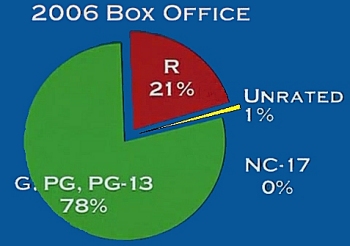 Look at this graph for the US box office in 2006. The majority of movies Americans were going to see — 78% — were rated G, PG and PG-13, and around a fifth were rated R. Unrated movies only accounted for a measly 1% of ticket sales, and NC-17 movies were zero! This is because many theatres are reluctant to even screen R rated movies, let alone NC-17 movies (or unrated movies, since who knows what you'd be getting — acceptable violence or unacceptable nudity?) Today the big money, for both the theatres and the producers, are with movies that target the youth market. Decades ago, before DVDs and wide-screen TVs, adults were the big moviegoers, now it's the youth that make or break a movie, and if it's a movie that has profitable spin-offs such as toys and games, such as 'Star Wars' and superhero movies, then that's even more reason to ensure that your movie is rated low enough so that kids can see it. Worse still, if the MPAA thinks a movie content doesn't even fit a NC-17, they'll refuse to rate it at all, and while their rating system isn't enforced by law, most theatres abide by their rulings and won't screen unrated movies since their ticket sales would be poor. Followup DVD sales are the same, with many large stores in the US limiting their display of NC-17 and unrated movies, so again the movie fails to reach the public, and loses yet more sales. It's the same with TV, producers can certainly include more realistic nudity and sex in their shows, but then TV broadcasters won't buy their show. That's because advertisers won't run their ads during shows that prudish viewers will complain about and then boycott. If advertisers stay away then broadcasters don't make money, so like movie theatres, broadcasters refuse to screen anything that might cut into their profits. The exception is some premium cable TV channels such as Showtime and HBO that are not tied to advertising or bound by FCC rules, but even then, studio executives usually limit the nudity while giving the violence free rein. And of course many of the movies and TV shows we in NZ get to watch are made to fit the US market, so the American censors are in effect our censors too. Look at this graph for the US box office in 2006. The majority of movies Americans were going to see — 78% — were rated G, PG and PG-13, and around a fifth were rated R. Unrated movies only accounted for a measly 1% of ticket sales, and NC-17 movies were zero! This is because many theatres are reluctant to even screen R rated movies, let alone NC-17 movies (or unrated movies, since who knows what you'd be getting — acceptable violence or unacceptable nudity?) Today the big money, for both the theatres and the producers, are with movies that target the youth market. Decades ago, before DVDs and wide-screen TVs, adults were the big moviegoers, now it's the youth that make or break a movie, and if it's a movie that has profitable spin-offs such as toys and games, such as 'Star Wars' and superhero movies, then that's even more reason to ensure that your movie is rated low enough so that kids can see it. Worse still, if the MPAA thinks a movie content doesn't even fit a NC-17, they'll refuse to rate it at all, and while their rating system isn't enforced by law, most theatres abide by their rulings and won't screen unrated movies since their ticket sales would be poor. Followup DVD sales are the same, with many large stores in the US limiting their display of NC-17 and unrated movies, so again the movie fails to reach the public, and loses yet more sales. It's the same with TV, producers can certainly include more realistic nudity and sex in their shows, but then TV broadcasters won't buy their show. That's because advertisers won't run their ads during shows that prudish viewers will complain about and then boycott. If advertisers stay away then broadcasters don't make money, so like movie theatres, broadcasters refuse to screen anything that might cut into their profits. The exception is some premium cable TV channels such as Showtime and HBO that are not tied to advertising or bound by FCC rules, but even then, studio executives usually limit the nudity while giving the violence free rein. And of course many of the movies and TV shows we in NZ get to watch are made to fit the US market, so the American censors are in effect our censors too.
But we should also note that in the Western world it's not just the Americans censoring movies (every country does it to varying degrees) and Great Britain has their own equivalent of America's MPAA called the BBFC, the British Board of Film Censors. The documentary 'Respectable: The Mary Millington Story' (2016) noted that, 'In the 1970s Great Britain boasted the strictest anti-obscenity laws in the Western world' [17]. Writing in an article concerning the BBFC for 'The Guardian', Simran Hans noted that, 'founded in 1912 ... The organisation has undergone something of a makeover in the years since ... (grounds for deletion used to include not just "gruesome murders and strangulation" but also "scenes laid in disorderly houses") ... [like] changing the C-word in its name, in 1985, from "censors" to "classification".' In the documentary 'Saucy!: Secrets of the British Sex Comedy' (2024) [16], Estella Tincknell, Associate Professor in Film and Culture, noted that the British Board of Film Censors were insisting back in the 1960s and '70s that, 'We don't censor, we certificate films, you know', but she immediately dismissed this claim, saying 'Of course it's censorship, of course it is', and while discussing the BBFC this image of a plaque on their office building was shown on the screen. 'It's a head-scratcher of a mission statement that gestures towards individual empowerment, while conveniently erasing its own nanny state paternalism. A bracketed clause should follow: "View what's right for you (based on what we say is right for you)".'The reality is that the BBFC, just like the MPAA, controls the content of most movies the public gets to see. They do this by either refusing to give a movie they deem objectionable a rating or viewing certificate, or giving it such a restrictive rating that in either case the movie is unable to secure a decent distribution agreement with the theatres and is therefore unable to make money. Thus if movie makers want to see a good return on their investment they are effectively constrained as to what scenes they can include in their movies. Their view of what makes an acceptable movie must match that of the BBFC (and the MPAA if they want to screen it in the US). While the BBFC and MPAA don't literally cut scenes from movies (the directors do that based on their recommendations), and movie makers don't legally have to apply for a viewing certificate, there is no doubt that the all-powerful influence of the BBFC and MPAA results in censored movies, that the choice of movies we get to see is based on what they say is right for us. That is the very definition of censorship. That said, there is a noticeable difference between the MPAA and the BBFC. The website of 'BFI Screenonline' explains that, 'It should also be noted that the MPAA and BBFC apply differing principles to films. The MPAA is generally more lenient towards violence but tougher on sex and non-sexual nudity (frontal male nudity in particular), but the BBFC's concerns are often the other way round'.Of course this differing perspective between countries makes it difficult for directors who want to market their movie in both Britain and the US (and numerous other markets with different censorship constraints). Unfortunately American movies are made primarily for the local US market, meaning they are censored to their conservative standards. When they go into overseas markets their local censors may demand that some violent scenes are deleted, but they usually don't request that any nude scenes that the MPAA had deleted be reinserted. Of course American directors know that the MPAA will recommend that most nude scenes be deleted in order to get a preferred rating, so why even film them in the first place.
So that's the answer, we believe, as to why movies and TV shows don't have many scenes of nudity or sex these days. It's not that those making movies don't want to make their nude scenes as realistic as the scenes depicting violence and death, it's just that if they do they'll be severely penalised for it. The censors (and society) have given graphic violence the big tick of approval, while at the same time they've placed a huge X across scenes of nudity and sex, with a helpful note for directors, 'No, no, no ... don't even think about it!' Consider the blockbuster sci-fi/horror movie 'Alien' (1979), in which the crew of the spaceship Nostromo are awakened from hypersleep to investigate an alien radio transmission. Things don't go well. 'Originally there was going to be a lot of nudity in the film. Of the matter-of-fact variety. There were going to be lots of shots of naked people walking around, which I thought was a good idea because it was such a harsh environment. It would have been a nice contrast. ... [it was] one of the things I thought was very interesting about the film, because, again, I was coming from theater, I wasn't thinking about markets and Catholics and ratings and censorship ... That was in the script at the beginning. We didn't shoot it that way because Fox said "We'll lose Spain and we'll lose Italy, so you have to wear [clothes]".'In our view it's seems quite ridiculous that executives at Fox, the American film studio, were arguing (in 1979) that countries like Italy and Spain, where, as we've already stated, women regularly went topless, if not completely naked, on-screen and on the beach, would be offended by a little movie nudity. Surely the only people shocked by the thought of nudity were the American movie executives themselves. In fact not all the planned nudity was completely deleted before filming began, one scene was shot but later edited to hide the nudity. At the beginning of the movie when the crew rise from their hypersleep pods, everyone is wearing only white boxers, and like the men, the two women are topless. As Sigourney Weaver explains: 'Actually there was some nudity in the script in the beginning of the movie. When we all wake up, we're supposed to be naked. ... But that was changed later'.What Weaver is saying is that the script originally called for complete nudity, since it was felt that in the future nudity would no longer be considered offensive, but that was then changed to just having the two women (Sigourney Weaver and Veronica Cartwright) be topless when they staged and filmed the scene. However, due to censorship fears, this changed yet again by having both women cover their nipples with thin white tape. As Cartwright explains: 'All of a sudden we had to have white tape put across, like, all the way across, our nipples, but the guys didn't, so that's weird, considering we were supposed to be total equals and we were truckers in space. But you lost six countries if our nipples weren't covered — and try and get that stuff off after about 4 or 5 hours! That was not pleasant!'Again, what is it with Americans and their fear of female nipples, and how did they seriously think that some thin tape was going to hide anything? Here are two photos of the scene as it was originally filmed, and note that Cartwright (on the bottom left of the first photo, Weaver on the bottom right and in the second photo) says that this topless scene took 4 or 5 hours to shoot:
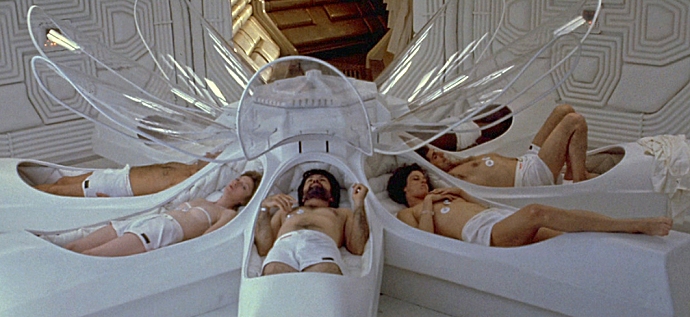
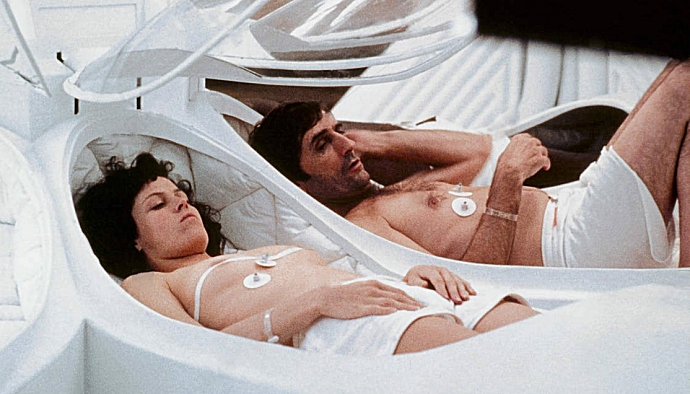
However here is the scene as it eventually appears in the movie. You'll notice that we are now viewing the hypersleep pods from a different angle, one where the women are not directly shown in the shot, only the men (we've indicated Veronica Cartwright, still topless, with a red arrow). After going to all the bother of having the women appear topless, albeit with silly tape over their nipples, studio executives apparently thought it was still too offensive and edited the footage to only show the men in their boxers. Male nipples are OK, it's just the female ones, they're so ... gross.
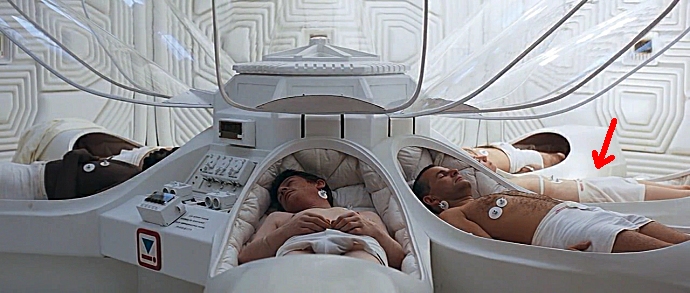
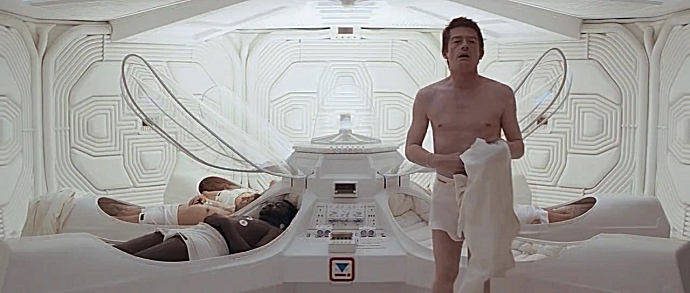
The movie 'Alien' is now rightly famous, but not for its 'matter-of-fact' nudity that the script had originally called for, it's for the violence and death and sheer horror that it brought to the screen. As its tagline said, 'In space no one can hear you scream'. The director lost his battle to keep the nudity but studio executives and censors had no problem with showing the violent death of a crewman by having an alien suddenly and unexpectedly burst out of his chest, with blood and guts going everywhere. That was a terrifying scene that must be shown in all its gory detail; some moviegoers actually fled from the cinema in shock when it happened, but that innocent scene with the topless women, that must go. Show us the topless men instead, what man or woman doesn't enjoy looking at the naked male chest? And it's not just directors, many actors and actresses are annoyed that movies opt for violence over sex and nudity. Comparing nudity versus violence in movies, in an interview actress Linda Blair, star of 'The Exorcist' (1973), said: 'My feeling is, I would rather see a breast, even a penis, than I would violence, that's me'. [1]Considering what movies she'd be happy letting her young daughter watch, actress Rosanna Arquette said: 'I'm much more uptight about violence than I am of sex'. [3]In the 1987 documentary 'Hollywood Uncensored' actress Sheree North opined: 
'I think it would be a whole lot better if everybody were naked and didn't shoot each other, and get rid of the guns and the knives and the violence'. [2]Actor and producer Eli Wallach added: 'I think it's outrageous that every argument settled on television today is settled with a weapon, that the only solution to any argument or discussion between people is with violence. I am appalled by that'. [2]And here's a quote from actress Zoe Saldana ('Guardians of the Galaxy', 'Avatar', 'Colombiana', 'Star Trek'):
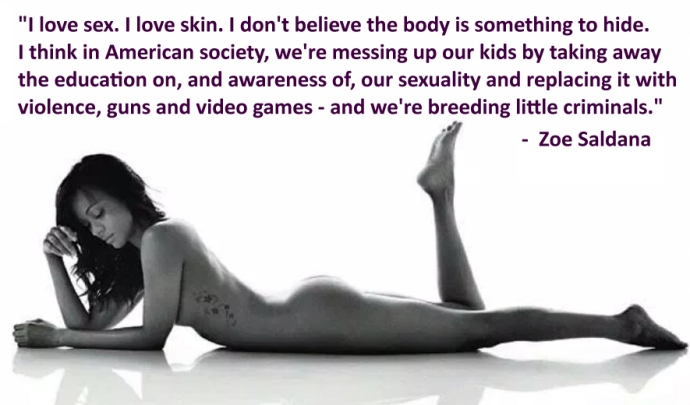
Click here for an image of actress Kat Dennings highlighting the double standards of the MPAA, and the following image shows a quote from actor Ryan Gosling where he criticises the MPAA's stance of embracing scenes of movie violence while restricting sex scenes:
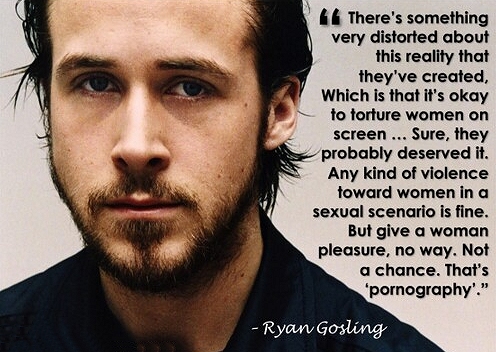
In a 2008 interview in Glamour Magazine, actress Charlize Theron is quoted as saying: 'It bothers me that in this society, it's OK seeing a guy blow another's head off, but a child seeing Janet Jackson's boob at the Super Bowl is the worst thing that could happen. It's not the end of the world! It's just a breast!'A 2018 Playboy interview asked Sofia Boutella if she was annoyed that the media made a big deal about her sex scenes with Charlize Theron in the movie 'Atomic Blonde' (2017), an action movie that it should be noted was 'Rated R for sequences of strong violence'. She replied, 'It was not annoying, but why is it such a big deal to see people having sex? You see people kill each other on-screen all the time. That's not a big deal ... What's wrong with sex?'In an American TV interview, when asked what question she was sick of answering, actress Emmy Rossum said it was the one about the occasional nudity on her TV series 'Shameless' (which the interviewer had already asked!), highlighting the irony that a society that is so opposed to nudity keeps bringing it up at every opportunity. The extremely naive male interviewer challenged Emmy when she said America was anti-nudity, but Emmy replied saying: 'America is so anti-nudity. When you go to Europe there is absolutely no guns, no violence really in their material on television, but all the women are topless and pubic hair and whatever, like what is the big deal about nudity? I just don't get it. Like it's not violence, it's not offensive to anyone, I don't get it, it's the human body, we were all born naked!'Recently American actress Gaby Hoffmann did an interview for 'The Independent', where she highlighted her frustration over the absurdity of Hollywood celebrating violence while stigmatising natural human bodies and criticised the public's quite irrational shock towards nudity while accepting graphic violence. 'The Independent' noted that, 'In 'Crystal Fairy & the Magical Cactus' with Michael Cera ... Hoffmann spends much of the film high, dancing, and naked. It was the third thing that caused the most ruckus. "I've always been very comfortable being naked," Hoffmann says. "So long as a woman is not being made to feel uncomfortable or isn't being exploited, it shouldn't be a big deal." But a big deal, it turned out to be. So shocked by Hoffmann's pubic hair — the abundance of it or even its mere existence — people assumed she was wearing a merkin. She was not. The scrutiny over her body and her decision to bare it was reignited a couple of years later when she appeared — often naked — in the third season of 'Girls'. "I was annoyed and bored by that conversation, especially being called brave," she scoffs. "I'm always shocked that nudity is such a big topic when it seems like in every other film someone gets their head blown off. Do we really need to talk about tits and vaginas? Let's talk about AK47s, pistols, and the kind of absolutely revolting violence that is not just normal, but expected." These days, she continues, in America at least, people are still prudish about boobs but not blood. "I mean, I can barely watch somebody get punched, but a breast? That's beautiful".' 
Austrian Natascha Hahn Ladek has worked in Hollywood for over two decades and has seen the American sexualization of the body firsthand, noting that: 'Film-making in Europe is still a little bit more organic. The nude body is still shown as a nude body rather than a sexual object as it is here'.Another outspoken critic of Hollywood's attitude to nudity and sex is Paul Verhoeven, director of such movies as 'RoboCop', 'Total Recall', 'Basic Instinct' and 'Starship Troopers'. He also recently directed the French movie 'Benedetta' (2021), an historical drama based on the life of a real 17th century Catholic nun, Sister Benedetta Carlini. In the media Verhoeven defended the inclusion of sex and nudity in the movie, saying: 
'"There's a problem with nudity and sexuality now. People are trying to avoid it, feeling it should be something of a mystery and shouldn't be seen. Of course, I've said many times, 90 per cent of people do it [sex], but somehow our society has decided you shouldn't bring that to the table — not in a movie. Violence and shooting and killing — that's all fine, but if there is a naked breast ...So we shouldn't automatically blame movie producers, directors, actors and actresses (at least not all of them) for the lack of nudity in today's movies, or accuse them of being prudes, since the few movies and TV shows that do have nudity have it only because they argued that it made sense, they wanted it included and they fought for it. They are as confused as we are as to why society is condemning nudity while embracing violence. In the movie 'Outlaw King' (2018), set in 14th-century Scotland, there is a brief scene of full-frontal nudity featuring Chris Pine, who later made this comment about the reaction from many moviegoers, 'People were giggling about my penis as if they were schoolchildren. I think it's maybe the dying embers of this Calvinistic idea that self-flagellating and shame and anger and violence is all good and yet sex and intimacy, making love is bad. And that manifests in us all giggling about a penis — it's so stupid'.For another example, I was recently flicking through a book by Martin Howden on the TV series 'Game of Thrones' (2011-2019), and by coincidence came across him commenting on this issue of sex versus violence on our screens as it related to that show. He noted that: 'Peter Dinklage has no problem with filming the sex scenes. "Those scenes are fun," he said. "We get so much flak for it, but what's wrong? I just find it to be so sad, people get in such an uproar about breasts, but not chopping people's heads off." [Game of Thrones] author Martin himself said, "I get letters about that fairly regularly. It's a uniquely American prudishness. You can write the most detailed, vivid description of an axe entering the skull, and nobody will say a word in protest. But if you write a similarly detailed description of a penis entering a vagina, you get letters from people saying they'll never read you again. What the hell? Penises entering vaginas bring a lot more joy into the world than axes entering skulls".'The only thing we'd disagree with in those comments is that unfortunately it's not 'a uniquely American prudishness'. Although America in general certainly has a severe case of prudishness, many countries are following their lead and adopting their 'Less nudity, more violence' mantra, and let's not forget that Muslim countries are far worse. And we should note that the nudity and sex in the above 'Game of Thrones' is an aberration, it only got through because it screened on HBO, a premium cable TV channel, and even then, the nudity in the show was still swamped by all the graphic violence. In another example, in a magazine interview we have actress Sharon Stone discussing nudity versus violence in the movie 'Basic Instinct' (1992), where she portrayed a serial killer: 'I don't go, like, "Oooh, I can't wait to rip off my clothes and jump around in front of everybody." ... And I was certainly not comfortable when I had to depict murdering someone — violently killing someone. I am infinitely less comfortable with the fact that the public is more concerned with whether or not I was nude or gay than whether or not I was a fucking serial killer. Excuse me very much, but where are your priorities, people?'In the documentary 'American Grindhouse' (2010) Eddie Muller (author of 'Grindhouse: The Forbidden History of "Adults Only" Cinema' 1996) explained that back in 1960s America the earlier movies that had been know as 'Nudie Cuties' were replaced with movies called 'Roughies', so named because in them women were treated roughly, very roughly, and not just slapped around, but often badly beaten (what today is called domestic violence) and even tortured and mutilated like disobedient animals. Instead of seeing women naked (and happy), you saw women suffering (and suitably clothed). Describing these movies Muller said, 'they're ugly, they're ugly movies really', and from the snippets the documentary screened, we would agree, only sick people could enjoy them. So why did Roughies grow out of the Nudie Cutie? Muller said, 'a huge part of the reason for this I believe is because you could not show sex on screen, so you had to show a substitute ... and violence was that substitute' [18].Discussing censorship and American teen movies from the 1970s and '80s, Mike McPadden, author of 'Teen Movie Hell' (2019), noted that: 'A lot of teen guys — underage guys — were allowed to see slasher films. They were not allowed to see teen sex comedies. And the irony was, why is it okay to see people being killed and slaughtered, but not okay to see a naked body having sex?' [1]  Decades later nothing has changed, Hollywood still promotes violence and censors sex. In the 2003 documentary 'Sex at 24 Frames Per Second', here is how James R. Petersen (author of 'The Century of Sex') described the MPAA rating system:
Decades later nothing has changed, Hollywood still promotes violence and censors sex. In the 2003 documentary 'Sex at 24 Frames Per Second', here is how James R. Petersen (author of 'The Century of Sex') described the MPAA rating system:
'Hollywood invented a rating system that was psychotic. You could show violence, you couldn't show sex and it was quite succinct. You could show someone cutting off a breast, but you could not show a hand touching a breast.'In the documentary 'The Cutting Edge: The Magic of Movie Editing' (2004), the English movie editor Antony Gibbs was discussing new editing techniques employed in the 1967 movie 'Bonnie and Clyde' and noted that, 'Bonnie and Clyde was much more violent than anything we had done [in Britain or Europe] because basically the Americans like violence much more than we do'. Historian M. J. Trow wrote that, 'The film was hailed as "new Hollywood", breaking taboos, especially in terms of violence. The ambush that resulted in the robbers' death, with its slow-motion exploding "blood" capsules was revolutionary at the time and stunned cinema audiences when they saw it' [15]. But to return to our point, producers and directors know what makes a good realistic nude scene, they're just not encouraged to make it (unlike a scene featuring violence). The problem lies with those that censor what producers make, that threaten them, forcing them to toe the line or else their movie or TV show may be given the stamp of failure. We believe most producers and directors would love to keep the nudity and the realism that an original script called for, but not at the expense of an R rating and a financial failure at the box office. It doesn't matter if the few people that eventually saw it thought it was brilliant, and that the sex and nudity wasn't at all offensive or gratuitous, you simply can't keep making expensive movies that don't make a decent profit or even recoup their costs due to the censors limiting how many people will buy tickets. It would be financial suicide. Censors — why can their view trump yours and mine?
Could this happen, could some of what's portrayed in popular movies influence behaviour and views in society? If you think of how reluctant movies (and TV shows) are these days to show nudity, then this omission of course necessitates some ridiculous behaviour from movie characters that are forever So is there any suggestion that society is being influenced by what the censors force the movies to hide, and religious nutters argue needs to be hidden? By its deliberate and obvious omission, are movies implying (unintentionally from the producer's viewpoint, intentionally from the censor's) that nudity is obscene, indecent and offensive, harmful to young eyes, unwanted outside the bedroom, and that viewing it might create dangerous, lustful desires? Is there any evidence that people today are taking this proposed threat from nudity seriously and working to remove it from real life, not just the movies? Since we've argued that nudity has indeed disappeared from some aspects of public life where it was common not so long ago, eg saunas, beaches and streaking, then clearly some force is at work to reduce the acceptance of the naked body in public society. Discussing the Hays Code, an industry guideline on self-censorship of movies forced on Hollywood in the 1930s through to the late 1960s, Mick LaSalle, author of 'Complicated Women: Sex and Power in Pre-Code Hollywood' (2000), argued that: 'There's a strong case to be made that the Hays Code ... changed not only the morality of movies, but changed the morality of the country because of the influence that movies had'. [1]Female writer/director Jamie Babbit has observed that: 'When they started clamping down on what movies could portray, something that was underlying it was the total acknowledgement of the power of movies, and who was going to control this power'. [3]Through the stories and images that were shown on-screen, and equally by what wasn't shown, people quickly recognised that movies had the power to influence society, and so began the battle to control what viewers could see, and what must be kept hidden. And we would argue that nothing has changed since, movies still wield immense influence over how people view the world. Moviegoers still happily modify  their language, mannerisms, fashion choices, views on science and history, and especially their morality, based on how the stars of the big (and small) screen behave. In her book 'Strong Female Character: What Movies Teach Us' (2022), Hanna Flint discusses how movies influence society's view of women and noted that even at the very beginning of the movie industry, their language, mannerisms, fashion choices, views on science and history, and especially their morality, based on how the stars of the big (and small) screen behave. In her book 'Strong Female Character: What Movies Teach Us' (2022), Hanna Flint discusses how movies influence society's view of women and noted that even at the very beginning of the movie industry,
'European cinema was certainly not as squeamish about women's hairy bits as the US ... the women in Georges Méliès films, like 1902's iconic La Voyage dans la Lune ['A Trip to the Moon'], displayed their underarm hair ... [and film-makers in Europe and Asia] had no qualms showing female characters with fuzzy pits [and] capturing women in all their natural glory [whereas in American films] pits and legs show no sign of fuzz'. [10] 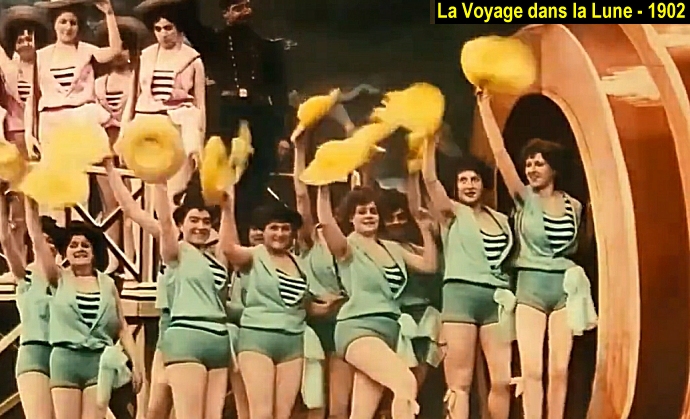
This is a practice that has changed little over a century of movies. Unlike European fare which usually treats female body hair, if shown, as natural and normal, it's largely invisible in American movies, except when it's used to shame a woman, to make her an object of ridicule, disgust or laughter. In Hollywood movies and TV shows, body hair is usually used as a trope to code women as ugly, lazy, dirty or a man-hater. The screenshot below is a typical example from the 2017 TV sitcom 'American Housewife', where the eponymous character Katy expresses clear disgust upon encountering a young woman with natural underarms in a store, and we hear her think to herself, 'Yuk, I need a bath'. And to annoy her nemesis Tara she then tricks her into also viewing and being equally repulsed by the hair. Call me weird, but personally I find the confident and "hairy" woman on the left far more attractive than Katy, the ignorant 'American Housewife'. 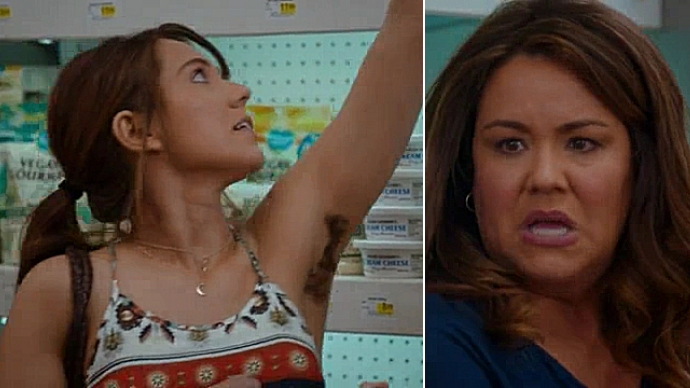
Although the above hair is quite normal looking (but likely fake), this realistic representation is rare. Usually American comedies don't just condemn female body hair as gross, it's typically fitted out as over-the-top, hamster-under-the-armpit, gorilla-level hairy in order to leave no doubt that one should have feelings of revulsion, shock, disgust and derision. The TV character who sees it should feel nauseated and the TV viewer likewise, but the viewer should also laugh at her understandable discomfort. And what's even worse with this particular example is that the person expressing this bodily disgust is another woman, a woman siding with the patriarchy and policing how women must appear in both the public and private sphere so as to please men and not scare the horses.
'nowadays, I simply subscribe to Zazie Beetz's way of thinking. The actress of German and African ancestry, plays Domino in Deadpool 2 and, unlike her superheroine counterparts, graces the screen withHanna was impressed that the movie made no comment or jokes about her body hair (image right), and we were too. It's very unAmerican, but then Ryan Reynolds, star and one of the writers of 'Deadpool 2', is actually Canadian and not American, which we guess makes all the difference. We're sure Hanna would also be encouraged by Michelle Rodriguez's portrayal of her character in the 2023 action/fantasy movie 'Dungeons & Dragons: Honor Among Thieves' (which came out the year after her book), since she also rocks hairy pits, and again the movie made no comment or jokes about the hair. And of course, considering the ancient world the movie was set in, it would have been quite unrealistic for women to have shaved their armpits, and yet according to what's displayed in most Hollywood movies, apparently a razor that was safe for women to use (and probably pink) was invented even before the wheel. Approving of this growing acceptance of female body hair (something that was the norm until quite recently), Hanna writes: 'I support the representation of pubic hair even if it is a wig or computer effects; it all contributes to the normalisation of natural beauty, even if trimmed and tidy still appears to be the most pervasive setting'. [10]Like us Hanna is arguing that movies shouldn't be afraid to show naked bodies, and show them as they naturally are, with body hair. Arguing that movies do indeed influence behaviour in the real world, Hanna concludes with: 'If cinema is going to continue to be a mirror to the world, our society and culture, here's hoping it will start to reflect more female-identifying characters in all their hairy glory'. [10] Movies, what's seen in them and what isn't, are still influencing America and the world. In the documentary 'Reel Bad Arabs: How Hollywood Vilifies a People' (2006), and in the book of the same name (2001), author Jack G. Shaheen argues that what we see on the screen, in this case how Arabs are portrayed in movies, influences how society then views them, stating that: 'reel images have real impacts on real people'. [7]Of course Shaheen is talking about racism and not the ethics of public nudity, but the same argument is clearly still applicable, that movies influence, for good and bad, how we think and behave in the real world. And it flows the other way too, ordinary people are also working to influence movie content, unwilling to just accept what Hollywood gives us or the censors will let through. Unfortunately these people are often conservative and religious. Charles Lyons, an historian and writer, notes that, 'there is what I'd call tacit censorship, and that is when groups from political left and right get involved and through their actions the film is either changed or pulled from the marketplace'. [3]Many groups in America with political, ethnic, ideological or religious agendas, even those trying to market a product or service, will vigorously advocate for their cause to be positively represented in movies and TV shows, and will try and do whatever it takes to convince studios to add or delete elements from their proposed scripts to benefit their agenda, or will attempt to squash the project altogether if agreements can't be reached. No publicity is better than bad publicity. They know the huge influence movies can have on society, and they want that influence to be working in their favour. So if public groups are trying to censor movies for their purposes, might censors also have an agenda? Some most certainly will have, like it would be difficult to be very religious and not allow those beliefs to control your decisions, and everyone has natural biases. But we'd like to think that genuine, honest, independent censors without agendas (if they exist) are not out to force their values onto society, since they are part of society, and generally they will simply be responding to what they think society wants. Society is saying that they're not concerned with the violence, it's the nudity and sex that offends them, and censors are taking note. As we said at the start of this article, too many people that we know are more than happy that nudity is becoming a rare thing, in public life and in the movies. They're just not comfortable being confronted by nudity, and nudity plus sex is even worse. Apparently if anything is going to cause the collapse of modern civilisation, it's going to be nudity, not violence. If you don't believe us, have a read of this article, 'What some people would pay to eliminate from popular films, if they could'. It states that around 2017, 'Sony had the brilliant idea of re-releasing some of its hottest titles without the sex, violence, and language of the original cuts'. The article said it didn't go ahead, but revealed that Sony wanted to make some older movies more family friendly and was influenced by the fact that, 'there are some viewers who would censor select scenes from films — even G-rated movies — if they could'. It seems that in 2016, by using a service called VidAngel, subscribers could pay to have that company use filters to censor movie scenes that they found offensive, like violence, language, sex and nudity. When the researchers analysed the 2,914 movies VidAngel offered in 2016, they found that: 'Viewers on VidAngel weren't concerned much with violence. They cut sex scenes most often, particularly those involving female immodesty, which was filtered more than 7 million times.We find it quite disturbing that people would pay to have scenes of nudity deleted, and even 'scenes that merely suggested sexuality', such as in a kid's cartoon movie, and yet they paid little heed to all the violence. Even profanity got more attention than violence. I'm currently watching a TV series called 'Justified', an action/drama about a present-day US Deputy Marshal, and Joelle Carter, one of the actresses on the show, made the following comment: 'The funniest thing I got was an email or tweet from a fan going, "We really, really love the show, but the cussing is starting to get out of hand". And I'm like, the cussing? Four people die every episode! It's OK for the killing and you know, the brutal beat downs, but let's not cuss?'This is the sorry state of affairs we find ourselves in, especially in the good ol' USA where most of the movie censorship happens. Far too many people are accepting of the graphic violence in what they watch but are horrified when the killer utters a naughty word! This sort of childish complaint from a fan shows that people aren't blindly accepting of what Hollywood turns out. Moviegoers are running the show, or trying to, and society is making its views known. What movies they watch, or don't watch, influences what producers put in their new movies. If viewers are consistently flocking to movies with graphic violence, but are shunning movies with nudity (or cussing), then the offensive nudity and cussing must go. Consider this observation from a British Board of Film Classification (BBFC) Annual Report: 'It will be difficult for Hollywood to come to grips with the culture of violence in entertainment until America comes to grips with the culture of violence in society'.As long as Americans tolerate violence (and even promote racism, sexism, homophobia etc) in their society, and abhor innocent nudity, then these (backward) attitudes will be reflected in their movies. While censors clearly do the actual censoring of movies, deciding what can stay in and what must be deleted, our argument is that it's the views of the wider society that guides the censors in their deliberations. Censors don't work in a bubble, and to aid their decisions they look to society to gauge what sort of behaviour the masses currently find acceptable. And this is nothing new. For example, in 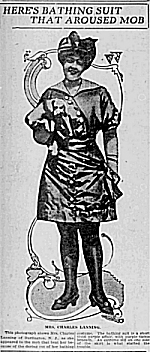 her book 'All the Rage: Stories from the Frontline of Beauty: A History of Pain, Pleasure, and Power: 1860-1960', (2024), author Virginia Nicholson notes what happened when, early last century, a mob in the US disapproved of a woman's beachwear that they felt was far too-revealing: her book 'All the Rage: Stories from the Frontline of Beauty: A History of Pain, Pleasure, and Power: 1860-1960', (2024), author Virginia Nicholson notes what happened when, early last century, a mob in the US disapproved of a woman's beachwear that they felt was far too-revealing:
'In 1913 Mrs Lanning of Atlantic City, New Jersey, wearing a short purple bathing dress, was set upon by a mob of two hundred men, pelted with sand and beaten unconscious. "An extreme slit on one side of the skirt is what started the trouble," reported the local paper. Perhaps her assailants had been listening to Cardinal John Farley, visiting the city that day, who denounced the latest women's fashions: "The diaphanous gown and slit skirt are products of the devil's industry," he ranted. Mrs Lanning was rescued by lifeguards, but the crowd followed her to hospital "to get another glimpse at the suit", and waited menacingly outside until she was discharged' [19].To modern eyes Mrs Lanning's bathing costume (right), as shown in the 'South Bend News-Times' on 12th September, 1913, looks more like a conservative outfit one would wear to the beach BEFORE changing into a bathing costume rather than actually being the bathing costume. Clearly censors of the time would have been influenced by these news reports, that such offensive displays so enraged decent society that men would beat an innocent woman unconscious. Paradoxically though, if the bathing costume was so offensive, why was a photo published in the newspaper for all to see? Were they (more likely) trying to defend the men's vicious assault by showing how the woman was indeed asking for a good beating for dressing as she did? (or should that be undressing?) Regardless, while things improved a little, nearly a decade later American society still thought that a woman's bathing suit was indecent if it didn't cover enough of her legs, and police would stop women on the beach and measure for length violations, as in the following photo taken on a Washington DC beach back in 1922:
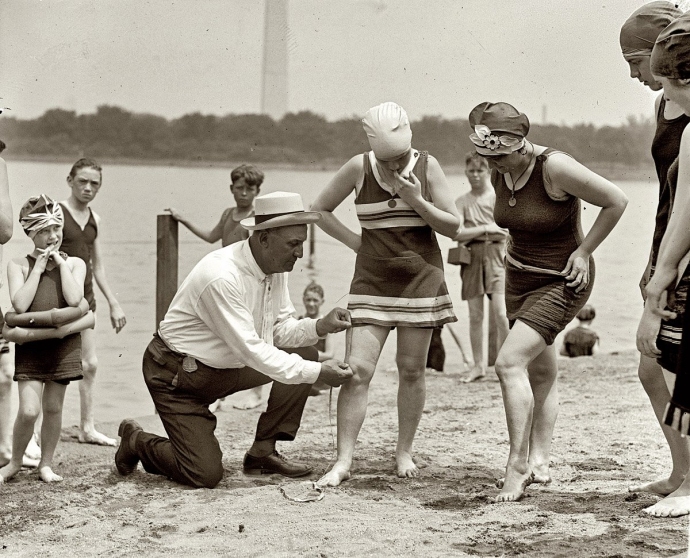
In his book, 'More Than A Movie: Ethics In Entertainment' (2000), American producer and entertainment attorney F. Miguel Valenti comments on America's embarrassing stance regarding sex and violence in its movies: 'A number of critics of contemporary media — particularly those with a religious or conservative bent — use as their mantra the elimination of "sex and violence" in films and especially on television. This is rather like trying to combine love and hate or life and death. Sex and violence could not be further apart on the spectrum, yet they are often attacked as one conglomerate evil by parent, religious and other groups. In fact, given a choice, many of these advocates would prefer to see sex eliminated from the land than violence.Note how Valenti says that while some with a religious or conservative bent try to ban them both, 'Sex and violence could not be further apart on the spectrum'. A comment made by Thomas Doherty, author of 'Hollywood's Censor' (2007), about Alfred Hitchcock's film 'Psycho' (1960), touches on the same sentiment. He said that the movie had: 'everything the Breen office [ie the office implementing the censorship of the Hays Code] would not have approved. It has sex, it has violence, it has the relationship between sex and violence'. [1]No doubt this is how the censors saw the movie, but this just highlights how conservative and confused they were back then (although to be honest many Americans haven't changed all that much in the last 60-plus years). The movie certainly had violence, it's about a deranged serial killer after all, but to say the movie had sex is laughable by today's standards. Pretty much the only thing that people remember today and that is ever mentioned about that movie is the infamous shower scene, and in that scene (and in fact for the entire movie) there is absolutely no sex and no nudity (what you imagine you saw is all in your head); all that's seen is violence, the vicious murder of a defenceless woman. How can anyone seriously suggest that this movie exposes 'the relationship between sex and violence'? What absolute nonsense, there is no real world relationship between sex and violence any more than there is a relationship between poetry and violence or cooking and violence. If a woman is attacked and stabbed to death while volunteering in a soup kitchen, we don't say that demonstrates a relationship between charity work and violence, and it is equally ridiculous to claim there is a relationship between sex and violence. Some might argue that there is a relationship between rape and violence, and there certainly is, but rape is not sex, rape is sexual violence. Rape and sexual assault is not what a normal, decent person thinks of when they think of sex. To suggest that sex and violence are somehow interconnected, that one causes the other, is as stupid as arguing that masturbation has a causal relationship with blindness, hairy palms and insanity. 'Psycho' was a horror movie, it had a specific scene of shocking violence that is still widely talked about today, but it's unbelievable that people suggest that the sex in that movie, of which there was none, was somehow the cause of the violence. 'Psycho' is just another example of Americans being perfectly happy to watch a movie with violence, and to falsely put the blame for that violence onto sex. It's like the comedy movie 'The Final Girls' (2015) starring Malin Akerman, a satire of the violent slasher movies of the 1970s and '80s. I only watched it because it promised a laugh and didn't contain the horrific violence of the actual slasher movies (or any sex or nudity unfortunately, but it did have time travel). Set in a 1980s summer camp for teens, the premise of this movie (and most slasher movies) was that whenever a young single woman had sex, or even just took her top off exposing her breasts (specifically her nipples), a deranged and masked serial killer would emerge from the woods and slash her to death with a machete. The clear message in all these slasher movies was that nudity and sex was wrong and deserving of a violent death, and the only women that would be left alive and safe from the vengeful killer would be the chaste and prudish virgins (the 'Final Girls' of the title). Sex and violence was intimately connected, try and have the first and you'd be visited by the second. Women who experimented with sex or even just went skinny dipping would meet a violent end. American society was insisting that there was a serious point to these movies that went beyond mere entertainment, which was that naked hussies in the real world would also be justly punished. Of course movie makers weren't suggesting that the real-world punishment for sex would be bloody violence at the hands of a deranged killer, only that bad things would certainly happen to young women that fail to keep their pants up and tops down (because God is always watching), like unwanted pregnancies, venereal diseases, being labelled a slut and ostracised, and maybe some violence too, like a well-deserved beating from their enraged father. For Americans, sex and nudity is bad, really bad, and making untold movies featuring a rampaging serial killer seeking to punish those that stray from the moral path was seen as an acceptable way of getting this message across to society, especially horny teenagers. But think about that for a moment. Conservative Americans in their wisdom thought it was a great idea to show explicit violence in the form of multiple murders to demonstrate how harmful nudity and/or premarital sex was. They justified killing untold young women on-screen in order to teach society how dangerous it was for women to expose their nipples off-screen. Their focus was solely on the (imaginary) harm caused by both nudity and sex, that's where, in their deluded minds, the danger lay, and they saw no problem in flooding their movies with violence, something far less harmful than nudity in their view, to get this message across. This screwed up attitude saw America legalising guns and banning vibrators. Charles Champlin, the Entertainment Editor for the Los Angeles Times has said: 'I think it's a terrible irony of American films that the censors, both in Hollywood and in the country at large, were always much more exercised about sexuality than they were about violence. Violence became a substitute for sex, I mean that was where you got your action, your conflict, your drama and your excitement.'When writing in 2016 about what might be expected on the then upcoming fourth season of 'Orphan Black', a Canadian sci-fi TV series (that we'd recommend), American medical ethics expert and science fiction aficionado Professor Gregory E. Pence expressed a similar sentiment, 'Some things I hope will not change: the Canadian feel of the show, where we have occasional violence but not the gross violence of American shows'. Like Valenti, Pence is another American dismayed at his country's love affair with extreme violence. Referring to an article from 'The Economist' about how the 'film industry as a whole has become increasingly gun-friendly', this article notes that 'gun violence in PG-13 films has more than tripled since 1985; in recent years, it has even exceeded the violence of R-rated films'. We shouldn't need to note, but I fear we must, that over the same period nudity in movies has gone the opposite way, that the film industry is not body-friendly, unless those bodies are fully clothed and are being used as target practice.
In the six years since we wrote this essay it has been revealed that nudity in movies is indeed still decreasing. A NZ TV talk-show news item in April 2023 noted that movies are now featuring far less sex scenes and nudity, that the 10 most popular movies of 2022 had no sex or nudity, and that current blockbuster movies are reminiscent of the chaste 1960s. Driving this trend is Hollywood's goal to make money, as much as possible. Once movie moguls realised that some of their potential audience was becoming increasingly uncomfortable with sex and nudity and shunned movies with such scenes, the simple answer was to delete those scenes and produce movies that everyone would watch, or more accurately, buy tickets for. Sex scenes not only limited ticket sales to adults, it reduced it to just mature broad-minded adults, since you lost all the prudish adults, which in the likes of the American and Middle Eastern markets especially is an enormous number, and consequently an enormous loss in potential revenue. So deleting the sex and nudity would make a movie suitable for everyone; adults, children and prudes alike. Anyway, the talk-show's presenters, two men and two women, were all apparently happy with the sex and nudity vacuum in contemporary movies, with one of the female presenters saying, 'Seeing those snippets of sex, it's like no, I don't want to see that, it does make me feel uncomfortable'. The other female presenter added, 'We've seen enough [sex and nudity], we just want to enjoy a movie for what it is and it doesn't have to be saucy'. They flashed supporting tweets from some Twitter users on-screen, with a prudish Robbie Nicol asserting that, 'Sex scenes have no place in mainstream film and television', and another noting that on viewing sex scenes moviegoers are 'experiencing their discomfort as a violation being committed BY the film that then necessitates some kind of censoring action'. How hypocritical that these people see these brief sex scenes (that are usually loving and pleasurable in nature) or nudity (usually innocent and often unrelated to sex) as a violation, that they're being harmed somehow, and they call for censorship — such scenes 'have no place in mainstream film and television' — yet they have no problem with (and never even mention) movies that have almost non-stop graphic violence, scenes that portray actual harm being inflicted on people, where people are shown in considerable pain and often die. They have no concern for people that might feel discomfort, might feel violated, on watching untold scenes of cruelty, torture, murder, rape and widespread suffering. What hypocrisy. Calling for censorship of scenes of pleasure and innocence while allowing scenes of suffering and violence, preferring a movie where hundreds or thousands die over one where a loving couple have sex. What sort of person is quite comfortable seeing a murder but not a naked body, and uses that criteria to choose what movie the family should watch? That sort of
The talk-show didn't reveal the source of their story, but in this 'TIME' article entitled 'Why Aren't Movies Sexy Anymore?', it noted a claim made on the show, that, 'Of the 10 top-grossing movies at the domestic box office in 2022, none were rated R', ie no sex or nudity. We've also since read that, 'Of the fifty highest-grossing films during the aughts [2000s], only two ('The Matrix Reloaded' and 'The Passion of the Christ') had a rating higher than PG-13'. [25], meaning definitely no sex or nudity. Even the two movies that weren't PG-13 had no graphic sex or nudity, but had plenty of violence, especially Mel Gibson's blood soaked fantasy about the sky fairy Jesus. In support of our argument that nudity in movies is declining, nudity which is almost always (erroneously) tied to sex, the 'TIME' article noted that:
'In 2019, Playboy pulled data from IMDb and found just 1.21% of the 148,012 feature-length films released in the 2010s contained depictions of sex, the lowest percentage of any decade since the 1960s. "I miss it," [director Steven] Soderbergh says of sex in film. "It's a thing we all have to reckon with, an axis we all have to navigate in our lives as creatures on the planet, so I don't know why it isn't addressed in a more matter-of-fact way".'This article — 'Some Are Wondering Why Sex Has Disappeared From Movies' — notes that, 'it is concerning insomuch as it reaffirms Hollywood's pivot away from sex on-screen and the sexlessness of culture in general', and that, 'The death of the sex scene might be due [... to] the fact that the Puritanism seeping through today's culture is very much for sex-less behavior [and] When compared to their European neighbors, maybe Americans are indeed getting squeamish about sex'. It acknowledges that, 'In the '80s and '90s, the erotic thriller was all the rage. It's a genre that is all but dead today'. It noted that movie producer and director Paul Verhoeven: 'has also been a critic of Hollywood's puritan take on coitus in cinema, and his reaction to today's lack of eroticism is dead-on:Helping to inform Hollywood's decision to delete sex and nudity will be the likes of UCLA's 2023 'Teens and Screens' study which concluded that — when it comes to movies and television — Gen Z (those born between 1997 and 2012) is more interested in platonic relationships than sex. Wait ... what? More interested in platonic relationships than sex? Seriously ... WTF? That sounds like some stupid thing a Catholic priest would say (although obviously not meaning it). In the last few decades, what has changed horny teenagers into sex averse wimps? Is being on Facebook and TikTok 24/7 somehow screwing with their raging hormones? Has the ban on displaying sex and nudity on social media and on TV, and it's disappearance from most movies (its spot replaced by violence), caused teens and those in their early 20s to fear sex and nudity the way older folk fear the likes of Ebola and AIDS? Humanity is doomed if the generation that is currently at the peak of their sexual life is somehow able and willing to suppress all sexual or romantic involvements, preferring instead to watch family movies from Disney and Hallmark where no one has sex or goes skinny dipping. Raised during George Bush's War on Terror and Facebook's War on the Female Nipple, Gen Z has embraced screen violence and runs screaming from screen nudity.'Sex is the essence of existence! Without it, there are no species anymore. So why is that a big secret? There is a new purity [at the movies]. Sexuality has been moved out of movies […] In the 1970s you could talk about it. But you arrive now, decades later, and those movies are not possible anymore'. In a 2019 article — 'Sex is disappearing from the big screen and it's making movies less pleasurable' — Ann Hornaday had also noticed this trend, writing: 'Thus does a familiar pattern repeat itself: The summer begins with a new crop of sexually explicit, mostly European movies [that] set off from Cannes to the festival circuit ... while Hollywood churns out its chief export of gun-happy escapism and wholesome kid stuff. Between those two channels the classic sex scene — once a staple of high-gloss, adult-oriented, mainstream movies — has been largely forgotten and ignored. The 1980s and early 1990s were a heyday of sex scenes that might have been hot and heavy but stayed within the parameters of bourgeois good taste: Movies ... were must-see films, not just because of their twisty plots but because of sex scenes that were frank, artfully staged and, sometimes, arousing in their own right. When a sex scene works — when it exists for more authentic reasons than shock value or sophomoric giggles and manages to involve viewers more deeply than mere voyeurism — it exemplifies one of those rare things that movies do best. Well-conceived sex scenes are capable of producing a spontaneous physical frisson just as cathartic — and gratifying — as a sudden belly-laugh or a good cry. As the critic Jonathan Rosenbaum has noted, movie sex "is the ultimate special effect". And now, it's pretty much gone. What's more, [movies are] pretending to build a world grounded in realism that is completely devoid of one of the core elements — and joys — of the human experience'.We totally agree with Ann's points, that well-crafted, realistic sex scenes can add real value and believability to the story a movie is trying to tell, because sex and nudity actually happen (a lot) to most people in the real world. Hiding it doesn't make sense. We've complained elsewhere about how Hollywood makes movies based in the real world, movies that they want viewers to take seriously, that are then ruined (in our opinion) by the introduction of elements that are quite impossible in the real world, like when the hero gets shot 50 times and is fully recovered a week later, but the 50 bad guys he shot died instantly from a single bullet each. As Ann said, if movies are 'pretending to build a world grounded in realism' then real world things should happen to the characters. It's quite childish to pretend that theirs is a world where sex and nudity doesn't exist (at least not obviously), but where terrorists and rapists and serial killers are still making their presence felt everyday. If in our movies we must accept that terrorists and their harmful atrocities are not just real, but we must actually view them being carried out, and we must, then surely we can accept that sex and nudity is real too, and also view it. If movies insist on showing a man being beheaded, then surely they can show someone walking naked to the bathroom. We know which scene we find more traumatic, so why do movies show the beheading in slow motion and delete the nudity entirely? Why do so many people want their movies to have hyper-real violence and yet no sex or nudity? Is this a world they fantasise about? We suspect many gun-toting, sexually repressed Americans do, since, as we've already mentioned, what other country would legalise guns and ban vibrators? OK, so clearly both nudity and sex scenes are disappearing from new release movies, but not all, and there are still a lot of older movies available to watch from more liberal decades, so how might this new prudish generation select something for movie night that won't traumatise them by showing naked flesh? Well, we've recently become aware of two websites whose creators and users have watched all the nudity and sex in thousands of movies so you don't have to (and there are no doubt other websites advertised on the likes of church notice boards and Facebook pages). We've written more here, but briefly one is the 'Movies Without Nudity' website which informs us that it 'provides a simple yes-no guideline to nudity in over 10,000 movies', a list that allows people to quickly reject and shun any movie that contains nudity, no matter how fleeting or innocent. Another is the 'cringeMDb' website, where the listed movies have either a green SAFE or red UNSAFE label attached. Clicking on a particular movie title will display the SAFE movies as being 'Certified Parent-Safe', whereas the UNSAFE movies (now labelled NOT SAFE) are deemed 'Certified Cringeworthy'. As to what makes a movie 'Cringeworthy' and NOT SAFE, this is the reason given for all such movies: 'CringeMDB users flagged the content of [this movie] as being inappropriate for children to watch with their parents because of either of a nude scene, a sex scene, or a scene depicting rape or sexual violence'.Above this message they also display which of those categories made the movie NOT SAFE to view. When we looked at the website we checked its recommendations for various movies, two of which are displayed below, one NOT SAFE and one SAFE for kids to watch. First we have 'The House Bunny' (2008), a silly teen comedy starring Anna Faris and Emma Stone. On its release it was 'Rated PG-13 for sex-related humor, partial nudity and brief strong language'. By 'partial nudity' they mean viewers get to briefly see the naked ass of Anna Faris. That's it, there is no full-frontal nudity, no naked breasts, no naked genitals. There is no sex either but there is some 'sex-related humor' and this must be what the 'cringeMDb' website classes as a 'sex scene'. Apparently merely joking about sex, even using euphemisms that kids likely wouldn't understand, is just as offensive as actually showing sex. And so this website labelled 'The House Bunny' as NOT SAFE, meaning keep it away from the children lest they be shocked by Anna Faris' cute ass.
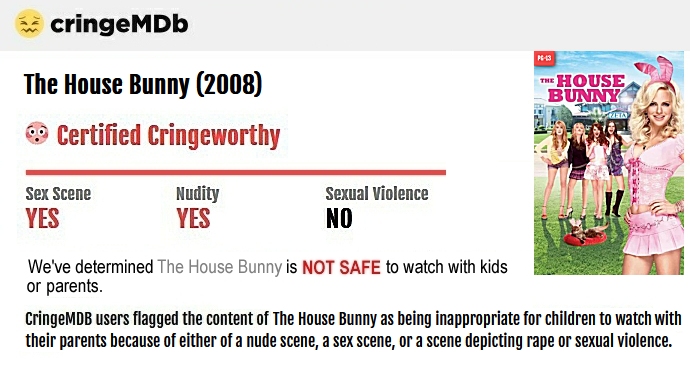
Next we have 'John Wick' (2014), an action crime thriller starring Keanu Reeves. On its release it was 'Rated R for strong and bloody violence throughout, language and brief drug use'. And when it says 'strong and bloody violence throughout', that is really an understatement, it is a very — very — violent movie, with the assassin John Wick continually beating, stabbing, shooting and killing people almost from start to finish. But — thank God — there is no nudity, sex scenes or sexual violence, so the 'cringeMDb' website clears it as SAFE for children to watch and enjoy with their parents.
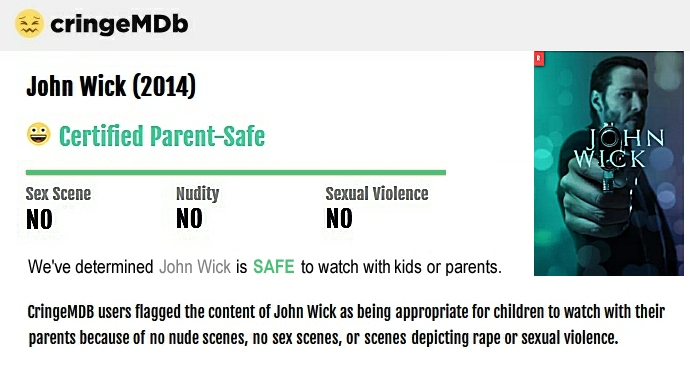
Note that neither of these "censoring" websites have a problem with violence in movies. The 'Movies Without Nudity' website specifically states that they don't believe movie violence causes any harm, it's only movie nudity that causes harm in society. The 'cringeMDb' website doesn't explicitly dismiss movie violence, but it surely implies this since violence is not one of the criteria it uses to judge the acceptability of movies. In its view the only content that makes a movie inappropriate for children is nudity, sex and/or sexual violence. They clearly recognise sexual violence as something children should be shielded from, but all the many other forms of violence seen in movies that are not of a sexual nature, like murder, torture, domestic assaults, assassinations, bullying, horrific deaths and injury from natural disasters, car crashes, terrorist attacks and wars, and let's not forget bloody attacks from zombies and monsters, these violent scenes — because they keep their clothes on — all receive the SAFE label. So a PG-13 movie that theatres allow children to see is deemed NOT SAFE by these prudes, and yet a movie rated R that theatres only allow adults to see is considered SAFE, and these prudes would allow their children to view it at home on a family movie night. I don't know if you've seen either 'The House Bunny' or 'John Wick', but it is certainly the very violent 'John Wick' movie with all the graphic killing that we would stop children from watching, not the teen comedy with some naked ass. It wouldn't be quite so bad if these websites and groups were condemning movies with nudity and ALSO condemning movies with violence, but they're not, they're giving very violent movies a PASS mark and anything with nudity (often very innocent nudity) a FAIL mark. For example, the action movies 'Black Hawk Down' (2001), 'Death Race' (2008), 'Mile 22' (2018), 'Mad Max: Fury Road' (2015), 'Extraction' (2020), '13 Hours' (2016), 'The Accountant' (2016) and the fantasy movie 'The Passion of the Christ' (2004), are all rated R for their graphic violent content, and yet the 'cringeMDb' website has found them all SAFE and perfectly appropriate for children to watch. You can of course find numerous movies featuring violent content on their websites that have been deemed NOT SAFE to view, but they all got that label due to nudity and/or sex, never because of the violence, since a category for violent content doesn't even exist. Clearly the people that created these anti-nudity websites, plus their users, have put a lot of effort into not just maintaining and updating their websites, but actually watching over 10,000 movies specifically on the lookout for nudity and sex (and no doubt risking their own mental health in the process). Just as clearly, their continued existence shows many individuals and groups believe there is a real need for the information they provide. However in our view it is totally screwed up that a growing proportion of society is fighting to remove nudity and sex from movies while completely ignoring violence. But these online resources that allow people to avoid movies with nudity are apparently influencing the viewing choices of society, and the studios are taking notice by removing nudity and sex scenes from their upcoming movies in order to make them more acceptable to a wider ticket-buying audience. But the violence remains. It's also interesting, and disturbing, that many conservative critics of movies, especially religious fundamentalists, do often consider scenes of nudity or sex and scenes of violence as both deserving of censorship, and yet if they're told that society only has the resources to currently focus on the elimination of one, they'll pick nudity and sex, seeing the naked body and sexual pleasure as a far greater threat to a decent society than violence. And seeing that movie violence has increased while sex and nudity has been pushed to the fringes, clearly that's where their efforts are focused these days. And if they were to win the war against sex and nudity, we suspect their next fight would be against those goddamn fucking cunts who use blasphemous profanities in movies, with violence still having to wait its turn. It's simply astounding that these morons find nudity more of a worry than violence. How can they look at movie violence and rate its potential harm level and then do the same for nudity, and nudity comes out as the real threat? It's like they're from another planet. And why do censors listen to them, or do they all go to the same church?
Censors do of course have to ban anything that is illegal in their particular country, like all of us they are constrained by the law. But beyond that, it all becomes rather subjective and vague. As Larry Flynt said, 'One man's pornography is another man's art'. So, why can't adults take responsibility for their own lives and simply avoid or ignore things they don't like, why do we need official censors to shield us from things that the censors might find shocking and harmful? And that question reveals another real flaw with how censorship works. Ignoring for the moment the illegal stuff which they're compelled to ban, the censors are, to some degree, shielding us from things that they personally find shocking, not necessarily from things that we find shocking, since of course they've never asked us what it is we find shocking and would rather not see. We don't recall any questions on this in the latest census. Without any research, censors apparently believe that they can somehow take the pulse of contemporary society, somehow they fool themselves into thinking that they've ascertained what the majority most likely does and doesn't want to see, and from there they take an ill-informed guess on our behalf, their decisions greatly influenced by their personal preferences, what they like and don't like and what they believe, usually without evidence, would be harmful to society. Why is it that a handful of mostly anonymous, unqualified adults that weren't elected to their position get to decide what millions of other adults are allowed to see in public, let alone get to read or view in their private lives? 'Who is so smart or so bright or so intelligent that they are capable of telling the rest of us what we should think, what we should see, or that we're not mature enough to handle certain subjects? I think that's totally ridiculous.'To co-opt a passage I read last night (on a quite unrelated topic), why do governments have this 'unspoken assumption that a small cadre of elites — [censors] — know what's best, that they can make better decisions on behalf of millions or billions of people than those individuals could make for themselves'? But, we hear you say, the subjective views of the censors, the things that they personally find acceptable or distasteful, are not the criteria that they use to categorise books, movies, art, video games, websites etc. And you're right, to a degree, since censors have a set of laws and guidelines provided by the justice system to follow, which clearly decree that certain things are permitted, or not permitted, and the personal view of the censor cannot override the law. But that just moves the same argument back a step, instead of censors we now have judges shielding us from things that they personally find shocking. And where judges and lawyers are involved, many of the laws and guidelines around censorship seem to use words such as obscene, offensive, shocking, pornographic, distasteful, harmful, indecent, vulgar, disgusting, repulsive, vile, repellent, disrespectful, blasphemous, irreverent etc, to describe the work being considered. And the well-known problem is that the meaning of these words is vague and subjective, they don't explicitly and objectively define what they signify in the way that words in other laws do, such as gun, murder, prostitution and blood alcohol limit. It's very easy to decide whether a person has a gun, but not so easy to decide if what he's saying is offensive, since what might be offensive to one person can be totally innocuous to another. For example, some Christians have said they find our upfront atheism offensive, whereas we find their barely contained glee that we're going to be tortured in Hell, along with new-born babies, offensive. We obviously have differing ideas as to what actions are offensive, ie free speech or torturing babies, and if either of us controlled the censorship department then clearly very different things might end up being censored. They would ban criticism of religion and we would ban vile threats of violence towards innocent babies and atheists. You may have heard the famous quote from some judge who said he couldn't define what pornography was, but that he'd know it when he saw it. That guy was Justice Potter Stewart, who in the USA in 1964 tried to explain how judges in their legal system recognised when pornography went from softcore to hardcore, from barely acceptable to obscene. He said, 'I shall not today attempt further to define the kinds of material I understand to be embraced ... but I know it when I see it'. Don't try and tell us that view isn't subjective, based solely on Stewart's personal preferences and worldview, and so vague as to be almost worthless. In no way does it go anywhere towards helping define whether something is obscene, or even in providing some rough guidelines to determine obscenity. And the legal system today still struggles to explain why some things are offensive and need banning, offering nothing but vague gut feelings that they can't expand on. Recall how in the US the FCC can fine people for 'violating public decency standards', but again this is a pretty vague and nebulous statement, meaning quite different things to different people. Consider that skimpy bathing suits that would violate public decency standards in many Muslim countries are quite acceptable on European beaches. To further prove that their rulings are subjective rather than objective, some things that were deemed obscene in the past are now viewed as quite acceptable, while some have even gone the other way, from acceptable to obscene. For example, one of the first married couples to be shown together in a double bed on TV were Herman and Lily Munster in 'The Munsters' (1964). Everyone else, like the married couples in shows like, 'I Love Lucy' (1951-1957) (image below) and 'The Dick Van Dyke Show' (1961–1966), had to have single beds, and stay in them. You couldn't even suggest that married couples might have sex, and of course they both worn baggy (matching) pyjamas to their individual beds, no sexy nightwear or hint of nudity.
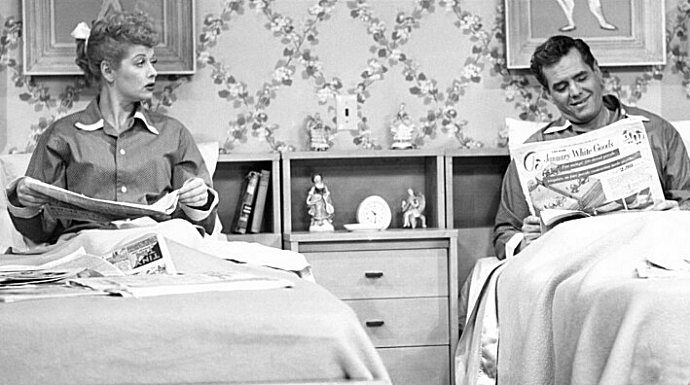
No doubt the Munsters were only allowed to share a bed because they were "monsters" and not real people. And then we have that kiss between Captain Kirk and Uhura in 'Star Trek' (1968), which was one of the first interracial kisses on primetime US TV, something the producers really had to fight for, and the TV network executives (who were of course only fearful of alienating audiences and sponsors and losing money) only eventually allowed Between then and now, nothing has changed except the views and values of those making the rules, new rules that society is now expected to follow. Homosexuality is still the same as it's always been, it hasn't given up certain aspects in order to make it publicly acceptable, and naked bodies in the 21st century haven't become so repulsive, compared to the 1980s, that we now need to ban them from the saunas to save our eyesight. So what's really changed? No hitherto unknown objective rules have been discovered, no stone tablets have surfaced, only our personal views on how we see the world have changed, meaning society has changed, and clearly not always for the best. It's obviously good that homosexuals are now treated as normal members of society, but not good that innocent nudity is no longer seen as normal and harmless, that it's now seen as something to be censored, hidden and deeply ashamed of. Over recent decades homosexuality has been slowly brought out from the closet from whence it hid, and innocent nudity has been thrust into the vacated space, as if society's acceptance of homosexuality was conditional on something else taking its place in the shadows.
Of course, like all people, there are personally some things we'd rather not see on TV or in the movies we watch, like scenes of people performing ballet, rap music or the Maori haka, and pretty much anything with Adam Sandler in it. And some things truly offend us, like shots of stupid people praying to some invisible god, and items on the TV news that suggest moronic things, like that homeopathy works or that ghosts are actually real. And it aggrieves us when we see the Bible and books about psychic mediums for sale in bookshops and they've put them in the 'Non-Fiction' section. But we don't campaign to have these movies or books banned, we simply avoid watching or reading them, and if we stumble across them accidentally, then we simply ignore them. Our exposure to the silly ideas and annoying claims in these books and movies over the years hasn't meant mental scarring which will be with us for life, they're not something we 're fearful of or feel threatened by, and therefore, unlike the Christian Church who for centuries maintained a list of books people were forbidden to own or read (on pain of death), we've never felt it necessary to demand that a censorship department be created to ensure we never see the things we don't like. Like spying dog shit on the footpath, we know how to walk around it and get on with life.
But not everyone is as tolerant as us, many arrogant people feel the need to have the world moulded to their values, to run by their rules. They want to be in charge of society, not merely part of it. If something offends their values, rather than look away, they'll demand it be eliminated, no matter that the rest of us aren't offended. Back in the 16th century the Christian Church launched what has become known as the Fig Leaf Campaign, in which they censored ancient Greek and Roman statues that were naked by placing a plaster or metal fig leaf over the penis (although many penises (most?) were simply chiselled off) and paintings that had visible penises and pubic hair had fig leaves or loincloths painted over them. There's even an interesting documentary on the topic called 'Fig Leaf: The Biggest Cover-up in History' (2011). And this is not just some example of idiocy from history, we read that:
'... censorship and the moral dilemmas nudity inspires still rage on. As late as 1995, the city of Jerusalem rejected a gift from Florence: another replica of Michelangelo's David. After much back and forth, they finally accepted the influential sculpture — but only after shielding its loins with underwear.'A book I'm currently reading about anatomy and the human body (published 2013) has a picture of Michelangelo's David (image right) on the cover, and the publisher has (thankfully) put a large green fig leaf over the naughty bits. It's been over 500 years since those naughty bits were carved in marble, and still many in society haven't got comfortable seeing them, even though half the people on the planet have their own personal copy that they see everyday. Clearly the primitive, religious notion of nudity being shameful still has a powerful and insidious hold on many in society, and that view is again increasing and affecting the content of our movies. How long is this latest wave of prudery going to last? We say 'latest wave of prudery' because of course these calls for censorship and extreme modesty from certain elements in society come and go. History has seen it all before, it's a battle that Christianity has been fighting for centuries, but one they've been unable to win outright since, in our opinion, the cause they are fighting for is quite unnatural and irrational. Throughout history humans have always been getting naked for untold reasons, and most have had no problem with this, finding it perfectly natural and comfortable, it's the demand from God-fearing folk that's unnatural, that everyone must remain clothed because the unclothed body is obscene. Currently we seem to be again losing the battle, and the freedoms gained and enjoyed from the 1960s to the '90s have been eroded. Since the turn of the century a new wave of prudery has been embraced by the masses, promoted of course by the Christians (and now to an increasing extent by Muslims) and aided by the censorship codes enforced by the likes of Facebook and YouTube, and consequently nudity in movies (and in public) has seen a steep decline. Some might consider those recent decades where nudity was socially acceptable as an aberration, an anomaly, an ill-conceived experiment by hairy hippies that was tried and failed, and now things are (thankfully) returning back to the world's natural state. But that would be fake news. The reality is that nudity is the norm, always has been, it's censorship of nudity that's abnormal.
In fact nudity in "movies" or "moving pictures" was there before movies were even invented. Produced in 1998, 'The Story of X' 'The images have always been there. Images of love. Images of sex. In the 19th century Eadweard Muybridge was trying to analyse movement in a series of photographs that lead to the discovery of movies. And he became the first but not the last maker of these kinds of pictures to be criticised for the nudity of his subject matter. Moving images of eroticism and sexuality have always thrived in the shade of the more respectable mainstream movie. For many they still live there ... challenged, condemned or ignored, with the hope that maybe they'll go away ... but they never did'. [26]
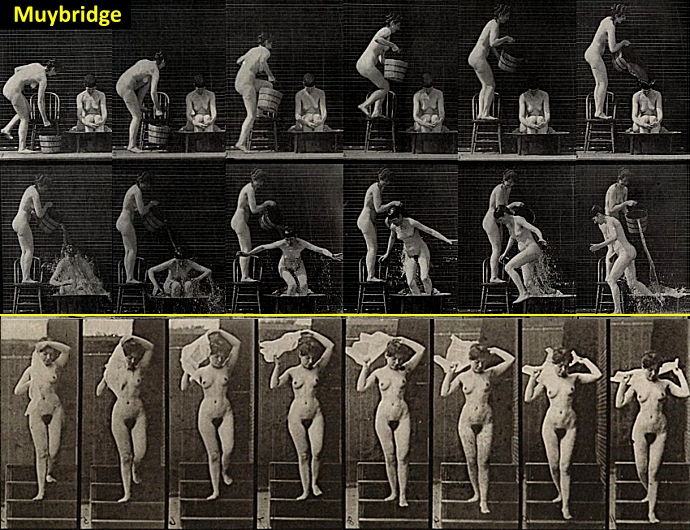
As surprising as it may appear to many people today, the idea to put nudity into movies didn't come about in the 1960s. In fact some young adults that were interviewed for the above documentary after being shown some very early silent, black and white adult films were stunned to learn that people back then knew about oral sex, thinking that it was a modern discovery! Of course it's not, and nudity in movies is nothing new either, producers have been putting it into their movies since the industry's early days, and the morally outraged have been trying to censor it on our behalf from day one. For example, in 1894 New York, before Hollywood even existed, Thomas Edison set up his Kinetoscope, a slot machine which showed the newfangled moving pictures on an endless belt. Each "film" lasted around a minute and people queued for hours to pay for a look. In his book 'Film Censorship in America: A State-by-State History' (2017) Jeremy Geltzer writes that,
'In addition to boxing, dancing films were also extremely popular with early film audiences. Out of [Edison's studio] came 'Annabelle Butterfly Dance' (1894), 'Carmencita's Dance' (1894), and 'Lola Yberri's Fan Dance' (1895). These pictures offered a glimpse of bare ankles or shaking hips, titillating and sometimes shocking images to a culture still restrained by notions of Victorian propriety and Edwardian etiquette. When Asbury Park's state senator, James A. Bradley, visited a Kinetoscope parlor, the flickering images of Carmencita caught his eye, and not in a good way. "Show such a picture to the good people of Asbury Park? No, no; never!" he reacted. "This picture, sir, is barred from your show. I will not permit it." On that day in July 1894, history recorded the first instance of government film censorship in the United States' [14].Note that Senator Bradley's outrage wasn't due to seeing nudity, just a female ankle and a quick flash of petticoat, however even that was a step too far in his cloistered opinion. The image above is a screenshot of Carmencita from that shocking and deeply traumatising film, and unfortunately many Americans today are still supportive of Bradley's prudishness. But the genie couldn't be put back in the bottle, and as Geltzer notes, motion pictures soon spread across the globe, and 'As motion pictures grew in popularity so did the call for censorship', but certainly not from everyone. As one theatre owner in Honolulu said, 'The people like pictures that are spicy ... If there are any prudes who don't like the class of pictures I am showing then let them stay away'. That's such a common sense response, and let's remember that 'spicy' pictures still didn't mean nudity (or even skimpy costumes), but clearly non-prudes, ie normal, well-adjusted people in the late 1900s, were open to viewing pictures that showed something entertaining, something exciting and something beyond their everyday life.
Meanwhile in Europe many short films were also being produced for a public eager to see them. In France in 1897, director Georges Méliès showed actress Jehanne d'Alcy's naked behind in a bathing scene (below) in a one minute silent movie called 'Après le bal' (After the Ball, the Bath). Because of her naked buttocks, this is said to be the first nude scene in film history, although the actress wasn't actually as naked as the scene implied. The naked buttocks were real but she was also wearing a flesh-coloured body stocking to
Within a decade European film makers were busy turning out movies on all manner of topics, still without sound or colour unfortunately, but hugely popular nevertheless. And included in those short films were increasingly some that featured nudity, and not 21st century blink-and-you'll-miss-it movie nudity, but full-frontal nudity (although exclusively female nudity unfortunately, men remain fully clothed, dignified and in charge, as feminism and equality had yet to find its voice). For example, the following screenshots are from eight different short films made by Austrian photographer and pioneer film producer Johann Schwarzer and his Saturn Film Company, all shot between 1906 and 1908. Note that the first scene (top, left) is another bathing scene, The Internet Archive has 22 of Schwarzer's known 52 films on their site, and 20 of those 22 contain nudity. Schwarzer had already been 'making erotic photos which were used on naughty postcards common to the era', so the move to produce 'Filme Pikante' (spicy films) made good business sense. This endeavour saw him enter into competition with his French and Argentine counterparts, but thanks to a more professional quality, his films were 'the most widely distributed and popular adult films made in the first decade of the 20th century'. They 'allowed for voyeurism and female nudity but not, he insisted, pornography'. A quote from his company's 1907 film catalog states, 'Our films are of a purely artistic tendency, and we avoid tasteless subjects in favor of beauty'. Other European film makers were certainly making hardcore pornographic films at this time, that is, films showing unsimulated, clearly visible sexual acts, but the films from the likes of Schwarzer and others were seen as merely risque or 'spicy' films, and those overzealous chroniclers that back then and even today continue to label them as pornography are surely quite ignorant. If those old films are pornographic then every movie from Hollywood that shows a naked woman, like Kate Winslet in 'Titanic' or Margot Robbie in 'The Wolf of Wall Street', is also pornographic. Clearly nudity or even a simulated sex scene under the sheets does not make a movie a porno, and even though the Europeans were indeed making the first hardcore pornographic movies way back then, they were also making movies that included non-sexual nudity, and were in some ways more accepting of on-screen nudity than many people are today. But as we've said, while there has been nudity in movies since the industry's early days, unfortunately there has also always been those who thought they had the moral obligation to control what the public saw and were busy censoring whatever offended them, after, of course, watching it themselves first. Watching these scenes didn't harm them, but somehow these arrogant people in positions of power were convinced that they would definitely harm everyone else, so the censors were ordered to act. In the case of the above films by Johann Schwarzer, after ignoring them for at least five years, suddenly in 1911 Austria's courts ordered them banned and destroyed all they could find (thankfully 31 of the original 54 films have survived in complete or fragmentary form). Saying that they had received letters of complaint from embassies in Berlin, Rome, Paris, London and Tokyo, the only such letter that still exists was received from — surprise, surprise — the United States Ambassador, in which he had helpfully included images of naked women from the films in 'bedenklichen Situationen' (precarious situations). Even back then arrogant American authorities wanted to control the content of any movie that might potentially reach American shores, and not happy with just censoring their own movies, they wanted to dictate what Europeans could see as well. They already saw themselves as the world's morality police. Moving from Europe to the US, the silent movie 'Inspiration' was released in 1915, and movies were now shown in dedicated theatres and ran for an hour or two. It was a drama starring Audrey Munson (below) in the role of an artist's model, quite fitting for the woman dubbed 'America's first supermodel', and it is believed to be 'the first non-pornographic American film to show female full body nudity'. That said, while Audrey Munson (being a real-life nude model) would have been comfortable being naked, it's very unlikely that the movie showed 'full body nudity', by which we mean full-frontal nudity. It's likely that Audrey Munson was never allowed to face the camera, and possibly never moved at all, remaining frozen in her stance as a real artist model would be. Estella Tincknell, Associate Professor in Film and Culture, has said that, 'People find moving pictures more potentially dangerous than still images', and in fact some early censors were prepared to allow limited nudity if the naked person didn't move, giving the impression of not being real, and no more sexy than a naked statue in the park, just an inanimate, creamy-white, irreproachably hairless piece of marble in the shape of a woman. Unfortunately the film has been lost so we'll likely never know what the movie showed, apart from the following studio still photo:
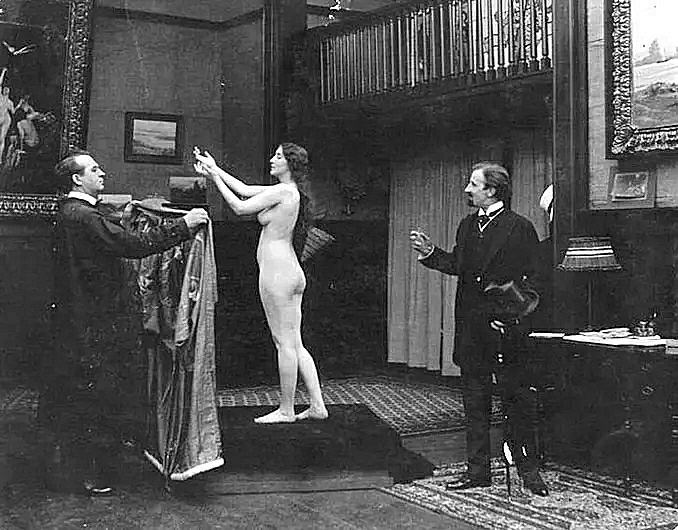
Then in 1917 we have actress Theda Bara playing the lead in the silent movie 'Cleopatra', with a running time of two hours. Even though this movie was made in America and not Europe, it is said that they still put in 'as much nudity as the censor would allow' and, rather than focus on Cleopatra's role in history as an intelligent and powerful leader, Hollywood instead 'made sex what she was all about'. The movie had Theda Bara play Cleopatra as a seductive woman using her sex appeal to exploit men, meaning lots of sexy, revealing outfits and bare flesh, such as the one below where Theda is essentially topless, only her nipples are hidden so as not to offend prudish American sensibilities.
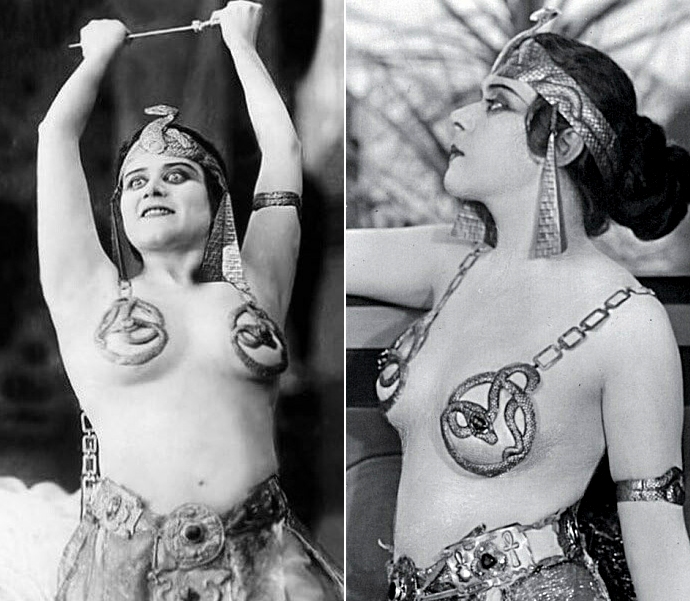
Just a few years later in 1921 the director of 'The Queen of Sheba' must have thought how childish this hiding of the female nipple was and simply didn't bother. Betty Blythe starred as Sheba (below), and like Theda Bara's Cleopatra she does have some "token covering" over her breasts, however unlike Theda, Betty's nipples are clearly visible. Unfortunately for fans of old movies, all copies of both 'Cleopatra' and 'The Queen of Sheba' have also been lost and all that remains are studio stills from each film, however it's said that 'The Queen of Sheba' contained 'several scenes of nudity, but they were available only in prints screened in Europe. American versions omitted the footage or used an alternate take that did not include the offending skin'. By 'offending skin' we assume they mean Betty's nipples. Naughty Betty.
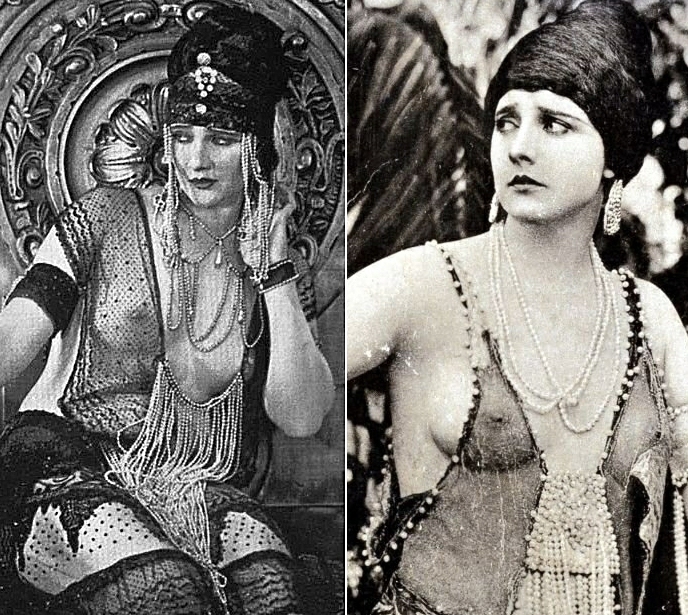
Our next example of an American director deliberately putting nudity in his movie is from 1925 and 'Ben-Hur: A Tale of the Christ', still silent with a running time of 2 hours 23 minutes. One scene (below) shows topless Vestal Virgins leading a parade through the streets of Rome, and a far more unusual image for that time shows a naked man from the rear. However while the director clearly thought the nudity was realistic for the scenes and quite inoffensive, moral leaders thought differently and reports tell us that the 'Nudity was often censored from the film. Shots of topless flower girls and the nude prisoner in the slave galley were deleted from a majority of prints that were in circulation'.
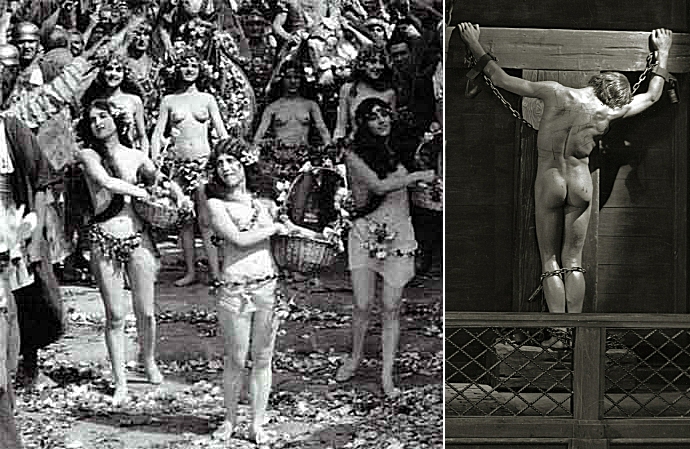
Then in 1927 'Forbidden Daughters' was released, starring Clarice Conwell (below), Gladys DeLores and Kathryn Kay, and described by Wikipedia as an 'American silent black & white short erotic-drama film directed by prominent nude photographer Albert Arthur Allen'. It should be noted here that the phrase 'erotic-drama' does not mean 'pornographic' drama, it's simply another term for the aforementioned risque or 'spicy' films, what would later be called the 'Nudie Cutie', and what are sometimes now referred to as 'softcore' movies, those that may have some innocent nudity and/or simulated sex scenes, but definitely no explicit hardcore sex scenes. And while 'Forbidden Daughters' does feature nudity, there are no sex scenes whatsoever, the actresses have even removed all their pubic and armpit hair, making their bodies appear more like naked Greek marble statues or women in old paintings that one might see on display in a museum than those of real women, which would likely have made the nudity more acceptable to a conservative American audience in the 1920s. They're not naked, they're nude, therefore it's ART.
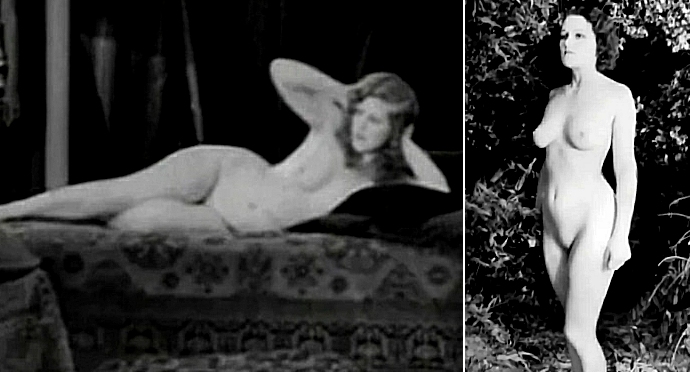
Back in Europe the French released a six minute silent movie in 1928 called 'Messe Noire', a fantasy about the initiation of a novice into a satanic cult. Unlike the above American 'Forbidden Daughters', the nudity in 'Messe Noire' is realistic (as are the sex scenes); the bodies are real and natural, body hair and all, there is no pretence that the audience is viewing some romanticised and classical ideal of the female body.
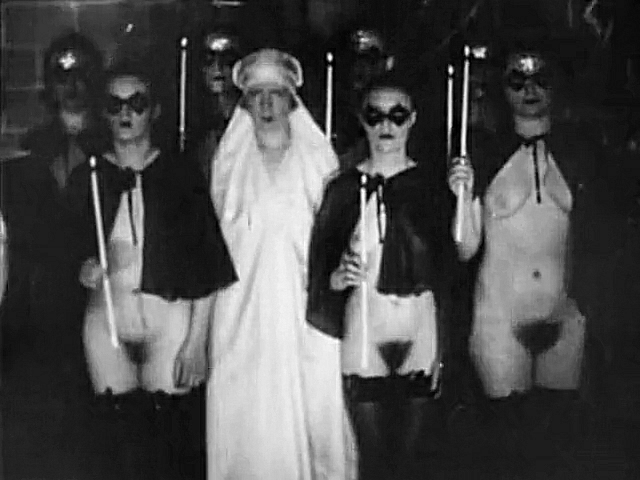
Still in Europe, Hedy Lamarr swam naked in the Czech-Austrian movie 'Ecstasy' in 1933 (below), and was also the first actress to show a female orgasm (implied by her facial emotions) in movie history. It was, of course, immediately banned in the USA.
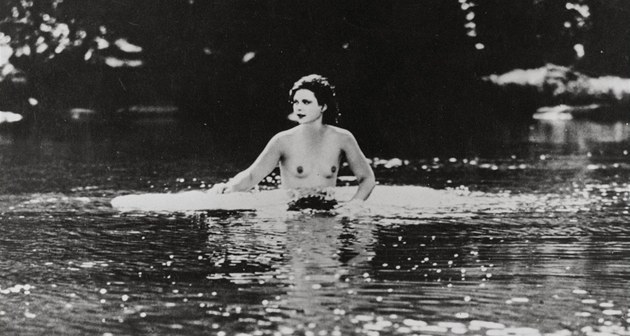
To reiterate, nudity was in movies from the very start — from the Silent era to the end of the Pre-Code era — and prudes, mostly American prudes, wanted it gone. In America offended Christians were rallying and in 1909 'The National Board of Censorship, representing mainstream Protestantism, was created after complaints about "indecent" films'. The period from the arrival of sound in film in the late 1920s through to 1934 is known as the Pre-Code era, since in 1930 the Motion Picture Producers and Distributors of America (MPPDA) decided to force self-censorship of movies onto Hollywood by creating a code of censorship guidelines, first the Motion Picture Production Code (which wasn't rigidly enforced until 1934) and then they replaced it with the Hays Code. It was named after the organisation's president Will H. Hays, a Presbyterian deacon and former chairman of the Republican National Committee (ie the committee of the very conservative US Republican Party) who was hired in 1922 and tasked 'with "cleaning up" early Hollywood's sinful image'. The Production Code and then the Hays Code said that no movie should 'lower the moral standards of those who see it', and by moral standards they meant the moral standards God had set out in the Bible. Of course we don't understand how these censors would ever know what effect a movie would actually have on each viewer's moral standards. Just because a movie character was immoral, there is no evidence that this suddenly makes moviegoers immoral. I can watch an on-screen rape without then thinking I should also rape someone. Clearly these censors are just placing their own moral failings onto everyone else, believing that we are as weak-willed as they are. The Codes included a 'list of "don'ts" and "be carefuls", with bans on nudity, suggestive dancing and lustful kissing. The mocking of religion and the depiction of illegal drug use were prohibited, as were interracial romance, revenge plots and the showing of a crime method clearly enough that it might be imitated'. In 1941 Paramount photographer A. L. "Whitey" Schafer created a staged photograph (below) that satirically mocked many of the things that movies could not depict if they wanted to be approved for distribution. His list includes the defeat of the law in the form of a dead cop, the inside of a woman's thigh, lace lingerie, a dead man, narcotics, drinking alcohol, an exposed bosom, gambling, pointing a gun and showing a Tommy gun (ie the Thompson submachine gun, a deadly effective weapon where today's equivalent would be assault rifles such as the M4, AK-47 and M16).
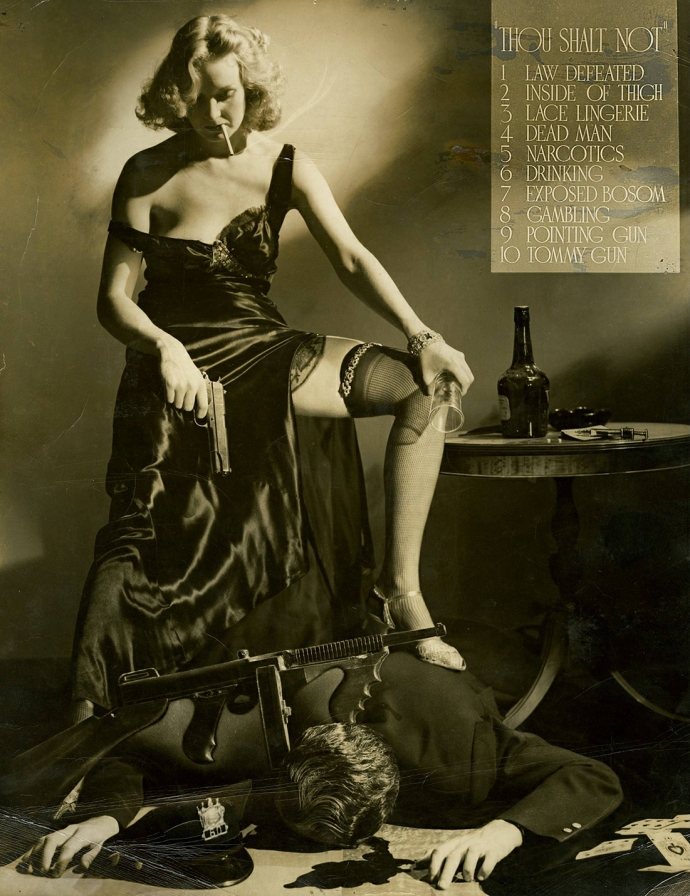
To realise how restrictive (and ridiculous) this Code was, consider that untold hugely popular Hollywood movies from the last 50 years contain several, if not all, of those scenes. Note that there is no specific mention of nudity, let alone pubic hair or the dreaded female nipple, since all that was long gone from movies, now the worry was simply about some movie showing the inside of a woman's thigh or the very top of her breast. British studios wanting to screen their movies in the US often ran into trouble with America's conservative censorship code. 'The Wicked Lady' (1946), a movie set in the 17th century, was just one of many British films to have cuts forced on it by Hollywood censors, in this case cuts such as 'several sexually suggestive lines ... as well as scenes involving beds', plus both Margaret Lockwood and Patricia Roc had to re-shoot (at considerable cost) some of their scenes that had 'historically accurate, but very low-cut gowns', with Margaret Lockwood later saying, 'We had to do nine days of re-takes to satisfy the censor on that film and it all seemed very foolish'. The American version was released with new footage of the women wearing dresses with higher necklines than the British version. Strangely there were no howls of protest or rioting on the street from British audiences after viewing the more revealing uncut version, apparently they were not traumatised in the least on seeing the top of a beautiful woman's breasts. Note also that throughout this roughly 40-year period the depiction of a 'Tommy gun', a weapon of war, was prohibited by the Code. However in a depraved twist America has gone from not even letting Americans see such a weapon, to now enforcing laws so that every citizen can own as many as they like and can openly carry them down the street. And now every American hero and villain in Hollywood movies (and in real life) settle every conflict they have with an automatic or semi-automatic weapon. Americans can't get enough of the violence, threatening anyone that might take their guns away, from them personally or from their favourite movie characters. But while they've made a complete U-turn on movies depicting the use of automatic weapons, conservative gun-toting Americans are still nostalgic of the Code's ban on nudity, because ... umm ... apparently nudity causes more harm than guns (and if pushed, they will argue that the Bible condemns nudity but doesn't even mention guns, plus their Constitution clearly says every patriotic American should have at least one gun).
In 1945 the MPPDA was renamed the Motion Picture Association of America (MPAA). Nudity effectively disappeared from American movies between the early 1930s to the late 1960s. In response to continuing objections by directors and producers to the highly restrictive nature of the Hays Code the MPAA made minor changes over the years, gradually loosening some restrictions, mainly around the portrayal of violence rather than nudity or sex. However, especially in the 1960s, many studios simply began to defy the Code resulting in the actual Hays Code eventually being abandoned in 1968. From there the MPAA created a new form of "censorship code" which is the now-familiar G, PG, R, and X ratings system (later still PG-13 was added and X was renamed as NC-17). While this change from a "code" to a "rating system" may seem that it has returned content control to Hollywood, the reality is that the MPAA is still the very powerful organisation that rates movies for the American public today, meaning the power it wields essentially still controls what studios can show in their movies. This is because all studios desperately desire a suitable rating from the MPAA that will see their movie widely distributed to the largest audience possible, and they are well aware that if they include scenes in their movie that they know the MPAA disapproves of, like nudity and sex, then they will receive a more restrictive rating (like R or NC-17), or worse still, will be refused a rating at all, which will severely limit their potential audience and their chance to make a financial return on their movie. While Hollywood studios don't have to seek a movie rating from the MPAA, it is financial suicide not to, so they are effectively forced to comply with their new censorship code, the rating system. Plus the MPAA is still heavily influenced by Christian moral attitudes, and like it or not, censored American movies and TV shows still hold the market share of the world's screen time. So, it's American society (and largely a patriarchal society), not Chinese or Indian or Ukrainian society, that's having a disproportionate influence on the rest of the world through their movies and TV. The values and behaviour that they portray in their movies influence, deliberately or otherwise, people in other countries with different cultures and values. As we've said, Europeans used to be quite nonchalant regarding nudity, in movies and at the beach (and still are compared to the rest of the world), but European culture of late has clearly been influenced by American culture, mainly through their movies. More and more Europeans (and Asians and Kiwis etc) are adopting American values and mannerisms and rejecting their own. Women, and men, are copying American ideals of beauty. European and Asian women that never felt the need to shave their pubic hair and armpits to look beautiful now do; beautiful Asian women are having their eyelids surgically altered to look like American women, and the world seems to have a lot more blonde women than genetics would suggest is possible. When I first travelled the world decades ago each different country was a culture shock, and the differences were fascinating and invigorating, but now more and more countries, in Europe and Asia and even NZ, are looking like cheap copies of the USA. Everywhere you look you see American fashion, slang, architecture, technology, fast-food restaurants, books and magazines, and of course, movies. Iran claims to hate America, but (women's oppressive dress code aside) walking around Teheran wasn't really all that different an experience from many US cities. Most Iranians want everything the Americans have, from their clothes, cars and smartphones to their movies, air conditioners and free speech. Satellite TV — meaning foreign influence — was supposedly illegal, but satellite dishes were everywhere. They're already Americans in spirit, but without the nuclear weapons (yet). As a kid growing up in NZ everyone used British English, we said 'lorry' rather than 'truck', 'petrol' rather than 'gas', 'torch' rather than 'flashlight' and we rode in 'lifts' not 'elevators'. But now people are using more American terms, because as a country we went from watching mostly British TV and movies to American fare. The general public now incorrectly refers to the NZ Police 'Armed Offenders Squad' as the SWAT team, an American term, and our recorded civil defence messages that are sent to every cell phone in the country during an emergency are spoken in an American accent, pronouncing NZ as 'en zee' rather than 'en zed' as Kiwis speak. We're guessing no Kiwi could be found with a good speaking voice. Through its movies, America is clearly altering behaviour and attitudes worldwide, and some of it is intentional. We can't condemn all Americans for their prudishness regarding nudity, because some are actively fighting to allow nudity in movies (and to keep their nude beaches open), but unfortunately a more powerful sector of US society is doing its utmost to stop them, and they're winning. Organisations like the MPAA were created solely to oppose producers, directors and actors who believed realism in movies sometimes meant nudity and sex, not just graphic violence. Regrettably, the voice of those that oppose public nudity is drowning out those arguing for freedom of expression, probably because many religious nutters hold positions of power in a religiously conservative country like America. And that prudishness has spread to NZ, but we don't understand why it has. We're typically not religious nutters that view censoring public nudity as a good way of decreasing lust and promoting modesty in the eyes of God. In NZ, as the American's would say (and again highlighting their influence), God has left the building. It's not as though society's attitude to public nudity has just stalled, since attitudes towards nudity have actually regressed over the last few decades. We could understand if society had said, 'Enough, no more!', but we can't understand why society has gone backwards. We know why society changed its mind regarding homosexuality and sexual equality and slavery, but not about nudity. What is the argument that convinced people to say that full-frontal nudity in our movies and topless women on our beaches and naked people in our saunas was a step too far — that we tried it, it was a mistake — and now we need to wind the clock back to a time when decent women swooned at even the hint of naked flesh? New Zealanders like to think of ourselves as intelligent and independent. We don't agree with America on many issues, such as gay marriage, gun ownership and religious observance, so why does it appear that we're blindly following their example regarding nudity in movies and TV, and in our saunas and on our beaches? It seems like too much of a coincidence that many Kiwis are now acting the way fictional characters in American movies and TV shows act. Does movie nudity put actors at risk? Recently some forum discussions we've read on the Internet got us thinking and has compelled us to update our essay 'Nudity or Violence?' with this new section. Here is one such typical comment from a poster who writes that, '30 years ago [1992] ... You'd see ... many, many films (from horror to comedy to thriller to erotic) that showed full frontal female nudity. In the very late 1990s and early 2000s that started to shift as the industry began acknowledging very real issues with on-set and behind the scenes sexual misconduct or at the very least a devaluation of the female nude. As a result we've seen a dramatic decline in full female nudity ...'Actor and director John Cameron Mitchell noted that there has always been critics of movie nudity, but that the criticism has now changed: 'Back then some of the objections might be more from the right wing, kind of conservative Christian side. Now, the objection might be more from the left which is, "Well, if someone's having sex, someone's being exploited".' [1]Are they right, do these scenes in movies mean actors were exploited in their making? By arguing, as we have done in this essay, that nudity and sex (and not just violence) should be naturally portrayed in movies and TV shows, are we part of the problem, are we helping to perpetuate this sexual misconduct in the movie industry? Might it appear that we are dismissing these issues as rather trivial, and certainly not serious enough to ban nudity in movies? Are we being callous, with no regard for the welfare of the actors, just imploring them to keep getting naked on-screen for our entertainment? Absolutely not, we don't condone any sort of sexual misconduct, and we categorically accept that there have been untold criminal offences experienced by many actors over many years, much of it involved with securing or performing movie roles that called for sex or nude scenes. But knowing this, the question then becomes, by urging actors to keep doing these scenes, for the sake of movie realism no less, are we not asking them to continue to take unnecessary risks, and possibly suffer real harm, just to keep us moviegoers happy? Are we demanding movie realism at the expense of an actor's well-being? Again, certainly not, but since the problem of abuse is real, should we then, as some are suggesting, be pushing for a ban of sex and nude scenes in movies to ensure the safety of actors? After some soul searching we say No! We believe both can be achieved, meaning realistic nudity in movies and happy actors. In this section we are going to examine why filming nude scenes can cause problems, and how we believe these issues can and are being circumvented, ensuring that actors feel comfortable and safe on set, and are thus able to continue to produce believable scenes that represent real life, which obviously includes sex and nudity, not just car chases and running gun battles. So what is the main problem that needs to be addressed? In our view it is eliminating the sexual predators that prey on actors. When the #MeToo movement gained worldwide attention in 2017 due to American film producer Harvey Weinstein being accused and eventually charged and jailed, the serious issue of sexual harassment and sexual abuse of women (and men) in the workplace was finally acknowledged and this has led to long overdue sweeping cultural and workplace changes, with several powerful players in Hollywood being dethroned. Unlike most workplaces, in Hollywood the potential for exploitation is twofold, where sexual favours can be demanded by producers and directors in order for an upcoming actor to secure a movie role, and secondly, if the movie calls for nudity and/or sex scenes the actor can be cajoled or forced into a revealing and intimate scene that they're not comfortable with. Sadly this is nothing new. This article in 'The Atlantic' explains that: 'The casting couch — where, as the story goes, aspiring actresses had to trade sexual favors in order to win roles — has been a familiar image in Hollywood since the advent of the studio system in the 1920s and '30s.'  We even saw a silent European full-feature film made back in 1920 called 'Consultorio de Señoras' that included a 'casting couch' scene in the actual film (right), suggesting that the use of the 'casting couch' was already well established and accepted by patriarchal casting directors and producers who saw aspiring actresses as sexual playthings that had to show how much they wanted the role. The above 'Atlantic' article quotes actress Glenn Close, who in anger says that, 'the "casting couch" phenomenon, so to speak, is still a reality in our business and in the world'. In another article 'actor Michael Caine has said the casting couch was an open secret in Hollywood [but] he did not know the extent of the problem' until the Weinstein scandal broke. And again, it's not just Hollywood. Speaking in a documentary about their experiences during the late 1960s and '70s in the British film industry [16], some actresses acknowledged that while most directors, agents and casting directors were respectful some were not, with some attempting the infamous 'casting couch' form of interviews, where sexual favours were expected to be traded for a role. When being considered for roles, actress Francoise Pascal ('School for Sex' 1969) noted that some casting directors would always ask her to take her clothes off. Alexandra Dane ('Carry on Behind' 1975) revealed that some said, 'If you're nice to me, I'll be nice to you, that's what they used to say, and then the hand would come on my knee'. Diane Keen ('Sex Thief' 1973) felt that she was exploited as a young actress, saying that some 'people would touch you all over the place, it's like they had every right in the world to do that, and it was scary because you didn't know whether you should allow that'. All three actresses said they rebuffed sexual advances from casting directors, however both Pascal and Keen did agree to some movie roles that required full-frontal nudity, so presumably they felt that the script did sometimes justify on-screen nudity (as long as the role didn't include 'casting couch' coercion). Of course sexual abuse of women (and it is largely women) doesn't just happen in the movie business, it can happen in any workplace, but the glare and wrath of the public has largely been on Hollywood, since the public is familiar with many of the abused and their abusers and are weirdly fascinated by their lives. This has led some people to suggest that it might not be a bad thing if nudity and sex scenes were to disappear from movies entirely to ensure the safety of the actors, to ensure they're not sexually exploited in intimate, risque scenes. Of course this would do nothing to eliminate the sexual threat of the backroom 'casting couch', of powerful players abusing actors before the movie even begins production. We'd argue that banning scenes of nudity or pretend sex from movies is as stupid and as extreme as banning swimming in case someone drowns. And the reality is that probably most all movie scenes of sex and/or nudity over the years (although of course not all) were filmed with none of the actors being harmed, abused or even exploited, they all performed as free agents. We need not totally ban something just to prevent a rare event. Rather than ban swimming outright to keep people safe, we teach people how to swim and how to look out for each other around water, and the same should be done, and now is being done, around these movie scenes where actors might feel vulnerable, and where on occasion might be exploited by less savoury characters. To wit, a new job has arisen on the movie scene called the intimacy coordinator, described as:
We even saw a silent European full-feature film made back in 1920 called 'Consultorio de Señoras' that included a 'casting couch' scene in the actual film (right), suggesting that the use of the 'casting couch' was already well established and accepted by patriarchal casting directors and producers who saw aspiring actresses as sexual playthings that had to show how much they wanted the role. The above 'Atlantic' article quotes actress Glenn Close, who in anger says that, 'the "casting couch" phenomenon, so to speak, is still a reality in our business and in the world'. In another article 'actor Michael Caine has said the casting couch was an open secret in Hollywood [but] he did not know the extent of the problem' until the Weinstein scandal broke. And again, it's not just Hollywood. Speaking in a documentary about their experiences during the late 1960s and '70s in the British film industry [16], some actresses acknowledged that while most directors, agents and casting directors were respectful some were not, with some attempting the infamous 'casting couch' form of interviews, where sexual favours were expected to be traded for a role. When being considered for roles, actress Francoise Pascal ('School for Sex' 1969) noted that some casting directors would always ask her to take her clothes off. Alexandra Dane ('Carry on Behind' 1975) revealed that some said, 'If you're nice to me, I'll be nice to you, that's what they used to say, and then the hand would come on my knee'. Diane Keen ('Sex Thief' 1973) felt that she was exploited as a young actress, saying that some 'people would touch you all over the place, it's like they had every right in the world to do that, and it was scary because you didn't know whether you should allow that'. All three actresses said they rebuffed sexual advances from casting directors, however both Pascal and Keen did agree to some movie roles that required full-frontal nudity, so presumably they felt that the script did sometimes justify on-screen nudity (as long as the role didn't include 'casting couch' coercion). Of course sexual abuse of women (and it is largely women) doesn't just happen in the movie business, it can happen in any workplace, but the glare and wrath of the public has largely been on Hollywood, since the public is familiar with many of the abused and their abusers and are weirdly fascinated by their lives. This has led some people to suggest that it might not be a bad thing if nudity and sex scenes were to disappear from movies entirely to ensure the safety of the actors, to ensure they're not sexually exploited in intimate, risque scenes. Of course this would do nothing to eliminate the sexual threat of the backroom 'casting couch', of powerful players abusing actors before the movie even begins production. We'd argue that banning scenes of nudity or pretend sex from movies is as stupid and as extreme as banning swimming in case someone drowns. And the reality is that probably most all movie scenes of sex and/or nudity over the years (although of course not all) were filmed with none of the actors being harmed, abused or even exploited, they all performed as free agents. We need not totally ban something just to prevent a rare event. Rather than ban swimming outright to keep people safe, we teach people how to swim and how to look out for each other around water, and the same should be done, and now is being done, around these movie scenes where actors might feel vulnerable, and where on occasion might be exploited by less savoury characters. To wit, a new job has arisen on the movie scene called the intimacy coordinator, described as:
'a member of a film or television crew who ensures the well-being of actors and actresses who participate in sex scenes or other intimate scenes' [and who] 'can assist the director with choreography, work with physical consent with the actors, and help with the blocking of a scene working with modesty garments'.By modesty garments they mean items that keep the intimate parts of actor's bodies securely covered and apart even if they appear to be naked and touching, since of course the sex is only simulated, and often the nudity is too. There are flesh-coloured strapless thongs held on by adhesives, silicone pasties or nipple covers and strapless stick-on bras. There's also flesh-coloured underwear, briefs and even full bodysuits. And we have the merkin (or pubic wig), although we should explain that, strictly speaking, a merkin is not a modesty garment. 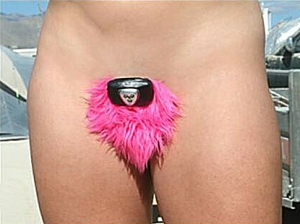 While the merkin has a history dating back hundreds of years, it was never intended as a modesty patch, and it was never meant to securely cover the genitals. Although their history is rather murky, it's believed they arose with prostitutes who had shaved their pubic hair following lice infestation, but their bare skin might then expose the marks of venereal diseases, so the fake pubic hair attempted to hide this. The merkin had nothing to do with modesty, these were women having real sex with strangers, not shy women acting in a movie. And real women way back then (and until very recently actually) had pubic hair. Not only was it seen as normal and desirable, it was considered a sign of good health, meaning its absence would have alerted their clients that there was a problem. Hence the need for some subterfuge. Now it's purpose is quite different, and twofold. It's used by the movie director as a physical special effect when a character (played by a shaved actor) needs to appear to have pubic hair (and is no different to outfitting the actor with era-appropriate clothes and weapons), and it's also sometimes used by the actor as a modesty patch, with many actresses having said it's like wearing a 'fur bikini'. Today the movie director and actress both utilise the merkin for quite different reasons. Moving on, there's body tape in various skin tones to hold things in place and for men there's the modesty pouch. Genital on genital contact is never allowed in sex scenes so these items cover the genitals and breasts, and often the likes of neoprene (yoga) mats are also placed between the actor's bodies. Below are some examples of the strapless thongs and nipple stickers, showing how the flesh-coloured ones give the appearance of nudity (although of course you can't see the Hollywood versions once their makeup teams have finished their work). While the merkin has a history dating back hundreds of years, it was never intended as a modesty patch, and it was never meant to securely cover the genitals. Although their history is rather murky, it's believed they arose with prostitutes who had shaved their pubic hair following lice infestation, but their bare skin might then expose the marks of venereal diseases, so the fake pubic hair attempted to hide this. The merkin had nothing to do with modesty, these were women having real sex with strangers, not shy women acting in a movie. And real women way back then (and until very recently actually) had pubic hair. Not only was it seen as normal and desirable, it was considered a sign of good health, meaning its absence would have alerted their clients that there was a problem. Hence the need for some subterfuge. Now it's purpose is quite different, and twofold. It's used by the movie director as a physical special effect when a character (played by a shaved actor) needs to appear to have pubic hair (and is no different to outfitting the actor with era-appropriate clothes and weapons), and it's also sometimes used by the actor as a modesty patch, with many actresses having said it's like wearing a 'fur bikini'. Today the movie director and actress both utilise the merkin for quite different reasons. Moving on, there's body tape in various skin tones to hold things in place and for men there's the modesty pouch. Genital on genital contact is never allowed in sex scenes so these items cover the genitals and breasts, and often the likes of neoprene (yoga) mats are also placed between the actor's bodies. Below are some examples of the strapless thongs and nipple stickers, showing how the flesh-coloured ones give the appearance of nudity (although of course you can't see the Hollywood versions once their makeup teams have finished their work).
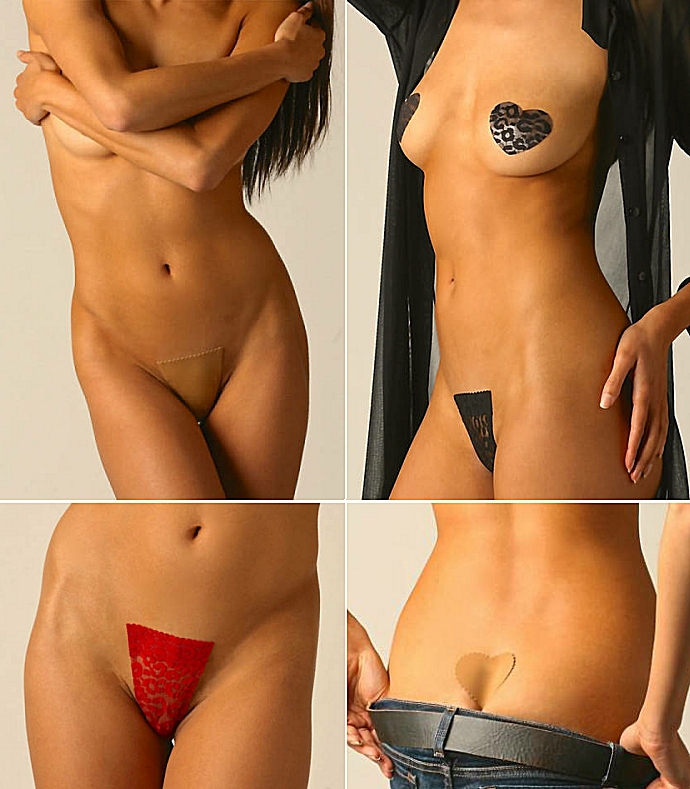
Actress Sydney Sweeney has given a frank and less than glamorous description saying that, 'she felt "disconnected" from her nude scenes in "Euphoria" because of the technicalities that go into filming them. "When you film one of these scenes, it is so technical and so not romantic," she said. "There are people staring at you, there's pads between you, there's nipple covers and weird sticker thongs all up in your butt".'By making use of swim coaches, lifeguards and flotation devices means it's safe to go in the water, and actors, movie crew and intimacy coordinators that all look out for each other means it's now just as safe to film the sex or nudity scenes as it is to film the risky fight scenes or high-speed car chases. Necessary and long overdue changes have been forced onto the industry. If a problem arises, if someone acts inappropriately, women now speak up and more importantly, they are listened to and immediate action is taken. As director Liz Goldwyn said, 'Everything's been upended because all of this institutionalized sexism and harassment has been coming to light [...] and now there's more of a system of checks and balances'. [1] Now actors can approach a scene knowing they won't be taken advantage of and that they're in control. Deputy film editor for the Hollywood Reporter, Tatiana Siegel, explained that, 'You want people to just sort of feel like whatever they're doing they signed up to do'. [1] They've understood how the scene will play out, of how much nudity is involved, the safe guards that are in place and they've given their consent. There will be no surprises or exploitation. Actress Diane Franklin added: 'Now with the #MeToo movement, I think it's really important for women to know that nudity in film is a choice. And it's never an expectation. [...] I didn't have the choices that women do today. And I'm very happy to see that women today have the choices where they can choose to do nudity or not. If a woman's comfortable with it, great, and if they're not, that's fine too. It doesn't mean you're going to be given more or less of an opportunity. I think it just has to do with who you are. [...] Nudity is never gonna go away. It's something we're always fascinated by. I think it's educational'. [1]We agree, nudity isn't going away, it does fascinate people, even the prudes who go out of their way to see it ... and then complain about it, and it's educational if it's shown realistically, in scenes where nudity is natural and expected, rather than in gratuitous scenes added merely to objectify women and sell tickets by titillating frustrated male teenagers and adults alike. For example, when making 'Valley Girl' in 1983, director Martha Coolidge was informed by the movie distributors Atlantic Releasing that following talks with the producers, 'We've made them agree. You are going to show naked breasts in four scenes in this movie'. It didn't matter whether the actual script called for nudity or not, for the important distribution deal to go ahead the movie needed naked boobs. Asked if that was a deal breaker, the director replied: 'No. Is it a problem if I do it whatever way I think of? And they said "No, we don't care how we see them. We just want to see them".' [1]While this might seem like a bit of a cop out on the part of the director, she explained that she sought this concession so she could at least script scenes that appeared realistic, where nudity might reasonably be expected, where the action in the scene is at least somewhat believable. It's real world nudity versus gratuitous nudity. A classic example of gratuitous nudity is a scene in the 1983 comedy movie 'Private School' where Betsy Russell's character Jordan (below) is horseback riding and another rider grabs her top, which, inexplicably, along with her riding helmet, comes off completely, and yet Jordan just keeps riding, not in the least concerned that she is now topless, and in case the viewer missed it, the movie replays the incident in slow motion:
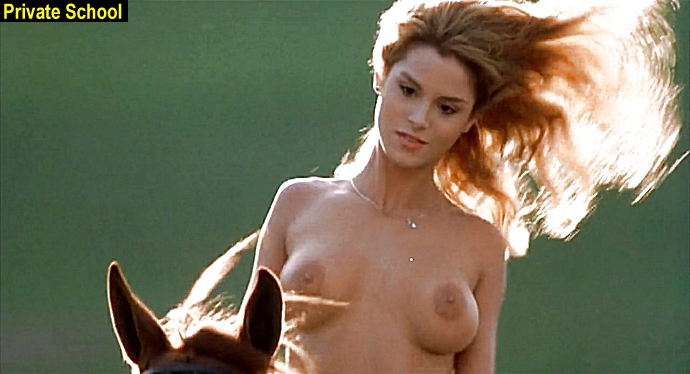
In a 2020 documentary actress Betsy Russell recounted that when she arrived on the set of that movie, fellow actress Phoebe Cates asked her: 'Are you ... are you worried about the nudity at all? And I said, "Why would I be worried about the nudity?" I said, "It's a great role, I'm not worried about it". She said "Oh good, I'm so happy, 'cause I was naked, like, 25 times in [the 1982 movie] 'Paradise'." And we just hit it off'. [1]Betsy then added: 'When am I ever gonna look this good again? Why not have it on film for the rest of time, where I can remember, "Oh my gosh I looked great?" And I had no problem with any of it'. [1]Amy Nicholson, a film critic for Variety Magazine, has said that 'distinguishing between essential nudity, and exploitation nudity is really tricky, because sometimes they clash even in the same film'. [1] However in cases like 'Private School', 'Valley Girl' and untold other movies, then and now, such scenes are clearly exploitation nudity, it's Hollywood making use of gratuitous nudity to sell movie tickets and increase the return to the studio. This is very different from essential nudity, scenes in movies where nudity is natural and expected and therefore essential if the scene is to be believed and taken as realistic to life. We should also point out that exploitation nudity is not the same as abusive, harmful and forced nudity. Exploitation nudity exploits the naked body to make money, but it doesn't mean the actors were harmed, abused or forced to get naked. A powerful movie producer like Harvey Weinstein forcing an actress to strip naked and perform a sex act in order to get a movie role is totally different to an actress willingly stripping naked and pretending to have sex as part of a movie scene. The first is real and forced and is sexual abuse, the second is pretend, voluntary and is called acting. The second is something actors choose to do, or not. As actress Betsy Russell said above, she had no problem with the nudity in 'Private School', nor did fellow actress Phoebe Cates. It certainly was exploitation nudity but the actresses themselves did not believe that they were personally exploited. There's a crucial difference between an actress knowingly and willingly helping to create a scene of exploitation nudity (often found in comedies) and a director or producer exploiting an actress by coercing her into performing naked. The first is an act of free will and the second is a criminal act. That said, because of the #MeToo movement some people are questioning the need for nudity in movies at all, especially if it's gratuitous. Actor Jennifer Tilly has said, 'I think it's a really fine line that actresses have to walk when they look at a script to say, well is this artistic nudity or is it just nudity? I say a lot of times the difference between artistic nudity and just plain nudity is "lighting".' [4]We guess that the point here is that some people will begrudgingly accept the inclusion of 'artistic nudity' in movies but will baulk at 'just plain nudity'. But if a movie is trying to tell a believable tale that takes place in the real world, surely it is plain nudity that has a right to be there and not artistic nudity, since it's a narrative and not a piece of art on display in a gallery? We don't complain when movies show plain cars and plain supermarkets and plain office workers in plain clothes, we don't insist that characters engage in artistic jogging and artistic computer hacking, in fact we would consider it quite distracting if a real-world scene suddenly took on an artistic feel (like when everyone bursts into song in musicals). When we see a character preparing dinner, putting on a spacesuit or loading a weapon, the movements are always plain and natural, never artistic, so why shouldn't nudity be shown in the same realistic manner? It's just childish to say that we might allow some nudity as long as it's shown artistically. Any person who observes the world must recognise that nudity plays a major role in life, in everyone's life, and it's overwhelmingly 'just plain nudity'. The same with sex, since as film archivist Valerie Schwan said, 'Sex is the quintessential reality of the human species'. [9] So let's include more reality in our movies and leave the art for the galleries. Amy Nicholson made this observation: 'A filmmaker knows now, "If I have nudity in my film, it will be absolutely cross-examined by the internet. So I need to make sure I have a reason for it. I need to justify it. I can't just have cheap nudity in this film for no reason".' [1]Like us, Amy Nicholson is clearly still supportive of essential nudity in movies, believing that realistic nudity that makes sense storywise has an important role to play in movies and needs to replace cheap exploitation nudity. Of course it should go without saying that staging nude scenes that involve real sexual harassment and abuse of actors is criminal, and those responsible need to be held accountable. But no one in the industry, such as producers, directors, studio executives, actors and scriptwriters, are pushing for a ban on essential nudity. Asked whether some in the #MeToo movement might be suggesting that including nudity in movies causes problems that a ban would quickly fix, Tatiana Siegel, deputy film editor for the Hollywood Reporter, replied: 'No, and I don't think we ever want to get in a situation where people say "We can't have nudity in films or television because it's too problematic." That's a problem'. [1]We agree, any thought that we should ban nudity in films and television is in itself a problem; that move would just be creating a new problem, not fixing the original one. And realistically, as one person noted, 'banning nudity in films would be a false solution, doomed to failure', since as critic Jami Bernard observed, 'From the dawn of cinema there has always been sex in movies, and there's always been people who want to control it'. [3] Yet no matter the prudish efforts at censorship, thankfully there are always some directors, producers, scriptwriters and actors finding ways to include at least hints of sex and nudity into their movies, keeping them a little bit real. Banning sex and nudity from movies would be hiding an important part of what it means to be human, similar to the way that oppressive societies like North Korea try to hide knowledge of the outside world from its citizens. Sex and nudity are part of real life, an amazing part, and naturally deserves to be in our movies that often depict real life. Why are many people so surprised, and worse, offended, when filmmakers try to put a natural and beautiful part of life into their films? As director Ron Shelton has said, 'I think it's inappropriate not to deal with sex in motion pictures ... all I'm trying to do is make movies about human behaviour and sex is a part of that'. [4] Actress Polly Shannon supports this view when she says, 'People need to have sex and they need love and affection, so it's all part of storytelling, an intense part'. [4] Director Adam Rifkin concurs, saying, 'Sex is a part of life, movies are expected to reflect life', and notes that he's 'shocked at how many people are still shocked ... by sex'. [4] Burlesque performer Dita von Teese wonders why some people have a such problem with nudity, asking, 'I'm like anybody else, I want to see all my favourite actresses with no clothes on ... I'm just like anybody else ya know. It's part of real life, and why do we have to skip that when we're making a movie?' [3] Why indeed? Female writer/director Jamie Babbit argues that, 'It's really up to us to push the envelope sexually so that we kind of move the right a little more left, not because we're trying to make society a more sexual place necessarily, we're just trying to make society a more honest place, and isn't that what making movies is all about?' [3]We all know about sex and nudity, society is abuzz with images and talk, we couldn't ignore their existence even if we wanted to, so why should we want our movies to pretend that neither exists? Director Paul Verhoeven has said that, 'Before I came to the United States I could do whatever I wanted in film making, certainly in a sexual way'. [4] But in the US, unlike Europe, the preference is to project violence onto both the big and small screen while pretending that any portrayal of sex or nudity is as unwelcome as COIVD-19. Plus by removing scenes of nudity from movies we'd be exacerbating another problem, the widespread and harmful belief that society feels nudity is shameful and offensive, something to be hidden. It's loss from movies would just serve to reinforce this view. In this essay we've argued that nudity in movies is decreasing, and have quoted the seemingly increasingly popular opinion that, 'Sex scenes have no place in mainstream film and television', that when it comes to seeing sex and nudity in movies, 'We've seen enough' and 'no, I don't want to see that, it does make me feel uncomfortable'. So, is it likely that Hollywood might start thinking that 'We can't have nudity in films or television because it's too problematic ... and most people don't want it anyway!' Or have they already started down that road, hence the already noticed decrease? So, what might the possible arguments be? There are probably four reasons why keeping nudity in movies might be seen as problematic for Hollywood. (1) Due to the required nudity on set, actors are vulnerable to sexual harassment and abuse from sexual deviants in the studio crew, from producer and director down to those working in wardrobe and lighting. (2) The technical difficulty to shoot/block/simulate nudity and sex without making the scene either too explicit for censors to allow or too unbelievable for the audience. (3) Many actors are now unwilling to do nude scenes. (4) The public is becoming increasingly reluctant to watch movies with sex or nude scenes. Let's consider these reasons to see if any have merit. (1) Yes, the risk of sexual abuse while filming a nude scene is very real, but anyone that thinks banning on-screen nudity is the best solution has failed to grasp what the real issue is. The real issue, which the #MeToo movement has shone the spotlight on, is not nudity in films but sexual harassment and abuse in the workplace, whether that be a movie set, a lawyer's office, a hospital ward or a hardware store. Women should be safe no matter what work they are doing, whether that is filming a movie scene, researching a legal case, treating a patient or stocking shelves. The common element that creates a potential for harm in all these work places is men and women working together, and yet no one would seriously say, 'This working together ... it's too problematic. We should stop it'. No one is suggesting that we could eliminate, or greatly reduce, the risk of sexual harm in the workplace by simply keeping men and women separate, even though technically it might work (although of course this wouldn't prevent abuse of a homosexual nature). No, we continue the collaboration and instead put in place procedures that prohibits (and severely punishes) any sexual harassment and abuse. We implement and follow strict safety guidelines (like Hollywood must already do with firearms, explosions, fight scenes and car chases) and ensure no infringements occur. We don't punish the actors (and the scriptwriters and the moviegoers) instead by simply deleting all nudity. We enforce these measures in the lawyer's office, the hospital ward and the hardware store, why shouldn't we also do it for the movie set? Why should we exclude actresses from being able to safely ply their trade to the full extent? It's really quite backward to argue that because of the nature of nude scenes the risk of abuse is ever present and the efforts needed to keep actresses safe would require putting constraints on men that men obviously aren't willing to accept, so the best way to ensure their safety is simply not to film nude scenes. Are we to believe that the solution to empowering women is to erase sex and nude scenes from movies? That's no different to the old sexist argument (one that is too often heard) that women can avoid being raped by simply dressing modestly and maybe even staying at home, meaning women should sacrifice their freedom to remain safe from males who have no constraints put on their freedom. The victims must make the sacrifices, not the abuser. How is this Hollywood argument any different, that if actresses want to stay safe then don't film nude scenes that could tempt men to sexually abuse them? Both punish women for the faults of men. Women are further victimised and the original problem remains, in that the abusers, frustrated on the movie set, would simply take their abuse elsewhere, like to the infamous "casting couch" or the home. It's a real societal problem if people think that simply banning nude scenes would solve the problem of sexual abuse in Hollywood. It won't, because the nude scenes didn't cause the abuse, the abuse was caused by the presence of a sexual predator and the willingness of the industry to turn a blind eye to that abuse, and in some cases, even help facilitate it. To fix the problem we must go after the offenders, not the victims. Simply banning nude scenes would just punish the actors by limiting the scenes they can act in, and would punish moviegoers by limiting what real world behaviour movies can show their characters involved in. It would be like going back to the time when movies couldn't show a toilet or a married couple sleeping in the same bed. The solution is simple, fix the problem by keeping the nude scenes in and kicking the sexual predators out; be offended by the abuse rather than the nudity. Furthermore, the #MeToo movement isn't about ridding Hollywood of sexual predators, it's about ridding the world of sexual predators. If you're trying to fix the abuse problem by focusing on nude scenes in movies then you're missing the point and are actually part of the problem. Some might accept that perhaps on-set sexual harassment and abuse is rare, but will still argue that banning such scenes would eliminate the risk entirely, at least on movie sets. Surely even one incident of sexual assault or exploitation is one too many? However by the same logic, we know that filming action scenes always carries real physical risk. Actors and crew have been injured and even killed in stunts that have gone wrong, such as in 2017 when Joi Harris, a stuntwoman for actor Zazie Beetz in 'Deadpool 2', died when a motorcycle stunt failed. In the previous month stuntman John Bernecker died following a 20-foot fall while rehearsing a stunt on the TV series 'The Walking Dead'. So since the risk of suffering harm is much higher, and any injuries suffered far more serious than in nude scenes, then surely action scenes should also be banned to keep actors and crew safe? If preventing harm in nude scenes is problematic, then preventing harm in action scenes must be a hellish nightmare, if not nigh on impossible. We read recently that when he played super-spy James Bond, 'Daniel Craig had more serious injuries on set than all the other Bond actors combined'. And yet as problematic as that clearly would have been for the actor and the studio, they persevered and kept making Bond movies. There has never been any serious suggestion or push for filmmakers to stop shooting risky action or firearms scenes, instead the potential for harm was recognised and effort focused on making such scenes safer; simply giving up was never an option. Did they ever say such scenes were problematic, in that they were difficult to film and involved some real risk? No doubt they did. But the way forward was always seen as finding safe, workable solutions to those problems, never in simply banning them. And what about the recent horrific incident in 2021 that occurred on a New Mexico movie set? While filming the movie 'Rust' actor Alec Baldwin accidentally shot and killed cinematographer Halyna Hutchins and wounded director Joel Souza when a revolver he had been given as a prop discharged a live round. Criminal charges were laid against Baldwin and the set's armorer but later dropped, then later still laid again (eventually the armorer was found guilty of involuntary manslaughter and Baldwin's trial was dismissed due to law enforcement officers and prosecutors hiding evidence from the defence.) No doubt even more stringent safety regulations and checks will be introduced for future movie scenes involving firearms, but even before any of that had happened, the movie was set to resume filming (and was eventually released in 2025). It's quite ridiculous to argue that 'We can't have nudity in films or television because it's too problematic', and yet even when a woman is killed and a man wounded while filming a scene of violence, there is no similar cry that 'We can't have violence in films or television because it's too problematic'. Such scenes of violence will continue to be a mainstay of Hollywood, since if any scene has to be banned, Americans will fight to the death to keep the one with a gun (some nonsense about the US Constitution and the Second Amendment) and will happily lose the one with the boobs. But if the studios can take the necessary steps required to keep actors safe in often very complex and risky action scenes, surely they can do likewise in nudity and sex scenes, where actors just have to pretend to cuddle while dressed in their birthday suits? Having regularly handled both real naked bodies and real guns, it's always the guns that scare me. Why do so many Americans feel just the opposite, and say let's lose the nudity and keep the guns, keep the violence? (2) When shooting nude scenes are the steps required in order to appease the censors just too difficult and not worth the effort? There is no doubt that it takes some skill from the director to shoot a nude scene that won't cause many Americans to run screaming from the theatre. Hiding those offensive nipples and ugly genitals behind silly props, filming from weird angles and under low light, gluing on merkins and editing out naughty bits with CGI, while still fooling the viewer into thinking they've seen the actor totally naked! So yes, filming nudity and sex scenes that won't end up on the cutting-room floor does takes some considerable effort, but then so too do most scenes. Again, think of the action scenes. That's why some movies are brilliant and others are crap, movie making is not as easy as it might appear. If skilled, decent people are filming the scene, if there is no risk of sexual abuse, then the technical challenges are really not all that different to the scenes where actors have clothes on. And yet some are now suggesting that filming nudity (as simple as that is) presents challenges that are too difficult to surmount, so let's just give up. Let's be realistic here. Logistically speaking, filming nudity is not problematic, and it never has been. The actor simply takes his or her clothes off and the director shouts 'Action'. A simple nude scene, say where a character hops out of bed naked and walks across to the window, is probably the easiest and cheapest to shoot of any movie scene, especially compared to a fight scene with martial arts, guns or swords, a high-speed car chase, a scene with non-existent CGI characters that will be added later in post-production, a scene where an alien character has prosthetic pointy ears and green skin, or an emotional death scene with fake bloody wounds. Even filming a scene where a character simply walks into a restaurant is harder and more expensive since a costume matching the place and time period of the story as well as the profession of the character must be created and fitted to the actor. The simple nude scene requires no costume, no fake wounds, no interacting with invisible characters, no prosthetics, no emotional dialogue, no acrobatic punches and kicks, and no deadly firearm skills. Unlike the talking and fighting scenes, almost anyone could do the nude scene since it's literally stripped down to the bare minimum. If you find it problematic, either shooting it as a director or acting in it, then you really are in the wrong profession. So yes, filming a believable scene with nudity and/or sex that the censor won't delete (especially American censors) does take skill and effort, but is that effort worth it? Umm ... duh!? ... hell yes! Personally we simply love it when movie scenes are believable, when they show real life, and we hate it with a passion when characters suddenly do something utterly stupid or childish simply to hide a naked body (but never a gun). Sex and nude scenes that are censored so as not to offend prudish Americans (or Muslims) can ruin a movie for us, just as does any movie scene where an event supposedly playing out in real-life suddenly turns into movie fantasy. Like in the movie 'Constantine' (2005) where a character rapidly fires 29 shots without reloading from a pistol that only holds 8 rounds! Seriously ... do directors think moviegoers won't notice? Whether it's removing nudity or adding bullets, when neither would or could happen in the real world it quickly turns a believable scene into a farce. And the fix isn't rocket science, the director simply includes tasteful nudity when a character would be naturally naked (and shows guns that cease firing when their supply of bullets is exhausted), and intelligent moviegoers welcome such believable scenes. Plus, haven't you heard the saying 'Sex Sells'? Haven't you noticed that even in a society so desirous of censoring sex and nudity, there is still a huge demand to see sex and nudity? Why is the likes of Facebook, YouTube and Instagram waging an ongoing battle to ban any hint of sex and nudity from their platforms if no one wants to see it? Who is continually making all these posts containing naughty images ... the Russians, the North Koreans? Americans are a strangely conflicted society, offended by and obsessed with nudity and sex in equal measures. And in this they are not alone, many Muslim societies are similarly afflicted. Just as audiences flock to movies to see the exciting action scenes and scary monsters and lavish sets, which all take lots of time and money to produce, they are likewise drawn to movies with daring sex and nude scenes, so, even if it might not be straightforward, filming those scenes is definitely worth the effort, both in profits to the studios and increased enjoyment for the viewer. (3) A proposed nude scene might be problematic as many actors are unwilling to get naked. It's argued that many actors are too embarrassed or ashamed to be seen naked, and believe that wider society would rightly condemn them for exposing their body on-screen for all to see. This condemnation would harm their public profile and result in them being offered fewer roles, damaging their career. If many actors fear on-screen nudity, this means studios will have difficulty filling such roles with their preferred actors, which will simply see nude scenes being deleted from movie scripts to avoid the problem. So is this true? Of course there are Hollywood actors who are absolutely mortified at the thought of being seen naked, this is America so how could there not be?! These actors will insist on a strict "no-nudity" clause in their movie contracts, also called a "nudity rider".
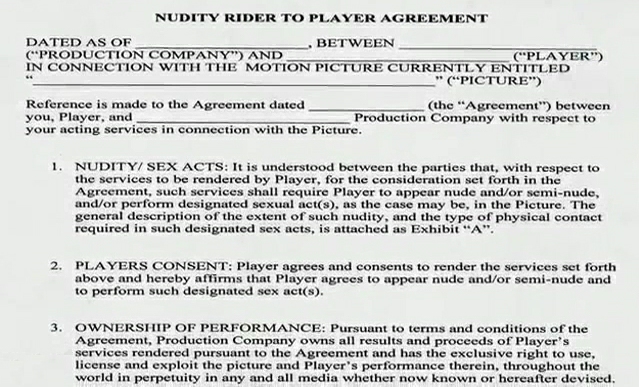
We read that, 'In the film industry, a "nudity rider" is a contractual clause that outlines an actor's willingness or refusal to appear nude on screen. This provision is negotiated before filming commences and can significantly impact a film's artistic direction'.And by 'significantly impact a film's artistic direction', they mean that a "no-nudity" clause can ruin a film by making the story it tells less believable, they certainly don't mean that by excluding nude scenes the film will better represent reality. Actress Polly Shannon adds that, 'A nudity rider is where in your contract you basically fine tune how much you will do in regards to nudity ... There's full frontal, breasts, full back, both buttocks etc'. [4] And of course, absolutely no nudity at all, zilch, zero, nada! But rather than many actors going down this path, we'd argue that only some are reluctant or quite unwilling to get naked. We say this because clearly many actors are willing to do nude scenes. When a naked body double was sought for Lena Headey's 'Game of Thrones' character, 'More than 1,000 actresses applied for the role' — not 5 or 10 but more than a thousand women were willing to play a part where their naked body was the sole focus — and of course many of that show's regular actors have also appeared naked on the show, including at least three in Headey's 'walk of shame' scene. In the documentary 'Sex and the Cinema' (2009) movie director Adam Rifkin observed that: 
'When you look at how many actresses have done nudity in films, the list just goes on and on and on. Charlize Theron, naked a million times in movies, phenomenal actress, everyone takes her seriously as an actress. Helen Mirren, Jodie Foster, Halle Berry, beautiful actresses who have won academy awards, have done nudity in films ... The current woman that I admire most for her bold portrayal of sexuality is Kate Winslet. Kate Winslet is naked constantly, god bless her [...] she is not ashamed of her body, she is not afraid to show it off if it applies to the role. Marisa Tomei, phenomenal actress, already won an academy award before'. [4]That got us thinking, that Rifkin is right, that 'the list just goes on and on and on', since with very little thought we've made a start on our own list of successful actresses, and actors, who have appeared naked on-screen. These are just those that we've seen and that come to mind, clearly there will be many we've forgotten or omitted (from movies we don't watch, like horror movies), and literally thousands who have appeared naked but never became famous. And for those naked actors that never made it big, it should be noted that we don't see them blaming a nude scene for the failure of their acting career; blame is usually apportioned to bad scripts, bad directing, a bad attitude or simply no real acting talent. If it's true that appearing naked on-screen will quickly scuttle any hope of a successful acting career, then you shouldn't recognise any of the following names:
Probably many of the above names will be familiar to you, and we're sure you can add many other well-known names to the list, plus untold lesser-known names, so apparently Hollywood has no problem getting everyone from celebrity actors to unknown extras to strip for the camera. And yes, there are actors who won't do nude scenes, which is fine, just as some won't use firearms or play prostitutes, but directors simply don't hire those actors for those parts. Only some actors can play muscular superheroes or sadistic villains or sexy femme fatales or the doll Barbie, and only some actors can and will play a naked character on-screen. But as reality and our partial list shows, obviously many actors are willing to do nude scenes, and not just wannabe actors looking to be noticed, but famous actors who are getting naked for their craft, happily getting their kit off if they believe the script calls for it. In support of on-screen nudity, here are some views as expressed by some well-known actors. Anne Hathaway has said, 'It's just part of the job. That being said, it is intensely mortifying taking your clothes off in front of other people, but it is also intensely mortifying doing a lot of things in front of people and I've learned how to deal with that'.Speaking of her role in 'The Girl With the Dragon Tattoo' (2011), Rooney Mara said that, 'Nudity is such a huge part of the character in the book, so I never thought twice about it. There was no time for hesitation. I didn't have time to second-guess anything or be scared; I just showed up and was comfortable'.Explaining the nudity in 'Trance' (2013), Rosario Dawson stated that, 'You understand that this is a really key part to the puzzle. It can't be sacrificed. It's not going to be cut out later. So, don't even audition for it if you're not willing to go there. It's not negotiable'.When Lizzy Caplan was asked about actors being hesitant about filming nudity, especially her nude scenes in the TV drama series 'Masters of Sex' (2013), she replied, 'If you're going to be squeamish about it, go be on some CBS show ... I remember after the first time I did it on 'True Blood' (2008), I felt very, very empowered and it stirred up a huge feminist thing in me ... You'd think you'd feel awkward because there's just a bunch of dudes standing around watching, but it's this weirdly liberating thing ... So I'm choosing to do this, and Virginia Johnson [the real-life character I play in 'Masters of Sex'] to me perfectly embodies feminism. Yeah, I'm taking my clothes off on television but I don't feel like I'm being objectified for it at all. I feel like this is a story that needs to be told in order to empower women instead of objectifying them'.Actress Kate Hudson has said she'll willingly appear naked on-screen if the nudity makes sense, saying that, 'It depends on the movie and depends on the circumstance, but nudity is always something that is an issue for women. I am pretty comfortable with that — but as long as it works for the movie ... [and] if I wanted a part I would pretty much do anything I needed to in order to get that role. My mother and father [actors Goldie Hawn and Kurt Russell] never made a big deal about nudity in our house. I often walk around naked or just wearing panties. Actors are all supposed to be emotionally naked anyway'.Speaking of his nude scene in 'Outlaw King' (2018), Chris Pine notes that, 'it got a lot of attention, but what did strike me most is that Florence Pugh bares everything too and no one commented. I am not sure what that means. Either people think they can't comment, or everyone expects women to get naked. Either way, it's double standards'.Actress Dakota Johnson has said she refused to use a body double for the topless and full-frontal nude scenes in the 'Fifty Shades of Grey' erotic trilogy, saying, '... it would have felt like a cop-out if I did. If I was going to do this job, I was going to do it 100 per cent and give it everything. I wanted to be true and honest to the role, and the character. I don't have a problem with nudity. I think it is beautiful and so I was OK with that'.When it was then claimed that Dakota Johnson felt no shame about anything, she responded saying, 'What a monster I would be! I absolutely have shame and I do have guilt. I am a human. It's true that I'm not ashamed of my body. I'm comfortable and I think more women should be more confident. I think nudity and sexual scenes in movies are beautiful when they're tastefully done'.Dakota Johnson also correctly observed that 'America is still so sexually oppressed. Isn't God's gift to humans the orgasm?' In a 2018 interview Jessica Chastain explained that, 'I have no issues with nudity, especially in a lot of European cinema that I adore, but I find that in American cinema, the idea of nudity has always bothered me. I realized why: For me, I'm uncomfortable with nudity when it feels like it's not the person's decision to be naked, when it's something that has been put upon them. In a way, I see that as like a victimization. It trains an audience that exploiting someone in their body should be normal for nudity, when I think the opposite. When people are completely in control of their decisions, that is a really exciting thing. I love the human form — male nudity, female nudity, I'm all about it. I had to get to that place where, for me, it was my decision'.In her most famous nude scene from 'Game of Thrones', Emilia Clarke's character slowly and dramatically emerges from a burning temple, and Emilia later made it known that while she was given the option, '... this is all me, all proud, all strong. I'm just feeling genuinely happy I said "Yes". That ain't no body double!'Emilia has 'also previously said she should be able to appear naked onscreen without it discrediting her support of women's rights: 'It doesn't stop me from being a feminist'. When asked if she had used a body double in any of her movie nude scenes Rachel Weisz replied, 'Absolutely not. It was all me. I never even thought of using a double'.Discussing her nude scenes in the TV series 'Euphoria' (2019), Sydney Sweeney said, 'People forget that I'm playing a character, they think, "Oh, she gets naked on-screen, she's a sex symbol. And they can't get past that". I have no problems with those scenes, and I won't stop doing them, but I wish there was an easier way to have an open conversation about what we're assuming about actors in the industry'.She also told Variety that she felt comfortable filming nude scenes and that filming nude actually boosted her body positivity, saying that, 'It's a very safe environment. I'm very fortunate that I am coming up during a time where there is so much thought in this process, and we now have intimacy coordinators. I have weirdly become very confident with my body through [filming these nude scenes]'.Commenting on Kate Winslet's willingness to do nudes scenes, Halle Berry said in an Elle magazine interview, 'Kate Winslet is always naked, sitting on a toilet, running buck-naked. She's free. I want to be the kind of actress who can really be comfortable with my body like that'.Regarding his full-frontal nudity in 'Shame' (2011), Michael Fassbender said, 'It just baffles me: Women can parade around naked all the time, but the guy conveniently has his pants on. I remember my mom always complaining about that to me, saying, "This is such bullshit, it's always the women who are naked!" So I did this one for you, Mom!'Mary-Louise Parker appeared naked in numerous episodes of her TV series 'Weeds' (2005-2012) and in 'Angels in America' (2003), and speaking of her photo shoot for 'Esquire' magazine in 2007, she said, 'I like posing nude and I persuaded the editor to pose nude, too, so that he could see what it's like for me. But actually, nudity is the greatest costume because no-one is looking at you as a person — all they see is your body'.When Lena Headey was criticised for using a body double in 'Game of Thrones', she responded, 'Some people thought that I was less of an actress because I didn't get my tits out. You know what? [The criticism] was really a bit shocking. I've done nudity. I'm not adverse to it'.Viola Davis, star of the TV series 'How to Get Away With Murder' (2014), has revealed that she, 'had no issues filming nude scenes, as long as production agreed to allow the scene to be as realistic as possible'.Jennifer Lawrence defended her nude scene in 'Red Sparrow' (2018), saying, 'It's my body, it's my art, and it's my choice. And if you don't like boobs, you should not go see 'Red Sparrow'.There is a nude scene in 'Hotel Chevalier' (2007) starring Natalie Portman, who laments, 'But it really depresses me that what I think is a wonderful film ... at the end literally half of any article or review about it has been about the nudity'.Kristen Dunst stands by her naked appearance in 'Melancholia' (2011), stating, 'What we made as a film means more to me than the fact that, you know, I'm on the Internet naked. It looks beautiful, it was shot well. It's a beautiful film. It is not something I feel embarrassed about'.When offered a role in the French-made movie 'Personal Shopper' (2016), one that required nudity, Kristen Stewart said, 'I'm pretty open. I think people are a little too fucking weird about it, to be honest, but that's kind of why I was like, "I'll do it" ... and also noted that in France, nudity isn't quite a big deal. But Americans "are weirder about shit like that".'Speaking of her nude scenes in the TV series 'Glow' (2017), Alison Brie said, 'Getting naked on camera is like ripping off a Band-Aid. The hardest part is the transition from being in your robe to being naked on set. Once I was naked, it kind of reminded me of my nudist days from college and that feeling of, Oh yeah, I love my body and this is fun and silly and it's fine'.In an interview actress Malin Akerman was asked if her relaxed attitude to on-screen nudity was due to her Swedish background, and she replied: 'I would imagine so. In Sweden, nudity is natural. It's not considered sexual. We've grown up with boobies on television. People are topless on the beach. My parents would sometimes walk naked from the bedroom to the bathroom. You don't blink because it's so natural. I always think of my parents when I take a role. If I had been brought up in a prudish household, perhaps I would think differently. But, if the role is a good one, the nudity is not even an afterthought'.Speaking of her naked fight scene in 'Terminator: Dark Fate' (2019), Canadian actress Mackenzie Davis explained in an interview that even though, 'the complicated nature of performing such a scene while completely naked ... clearly limited her movements ... "It's cool. Yeah, it's cool because you can't get tripped up with anything so you just sort of really understand your limitations. There's a lot of adrenaline about being naked in front of people so that affects the weight of your punches". She even opted out of wearing a modesty garment which is typically used while filming nude scenes. She described the garment as "disgusting underwear" and that putting it on was like "trussing a turkey." Davis decided to go without the garment because she realised that it was "so much nicer to just be nude and not sort of embellish it with these weird lines. Just sort of really enjoy it".'In another refreshing attitude to nudity, Judy Greer briefly appears topless in the first episode of the TV series 'Reboot' (2022), and when asked if she was comfortable with the scene, explained that, 'Being topless was not in the script. What was written was her trying to get her top off and everything. When you're shooting scenes like that, you can wear a bandeau or pasties, but, when it comes down to it, it's a pain in the ass shooting around all kinds of undergarments. So I said, "Let's just do the scene and then you guys can just deal with my boobs in the editing room." When the scene was edited together, they were like, "Well, we have two versions, and there is a version where we can see your breasts — and it's very funny. We're never putting this in the show if you don't want to, but why don't you come and see what you think?" So, I saw it, and I thought it was ... funny and awkward and surprising ... [so we kept it in.] There are so many different kinds of nudity, and that was nothing as far as my comfort level ... This is comedy, and they're just boobs. We never freak out when dudes have their shirts off'.  And this liberal attitude to nudity is nothing new. We've already mentioned that actresses were happily appearing naked in movies up until the early 1930s, until the pearls- and Bible-clutching prudes stopped them. Then in the late '60s and '70s British actresses started appearing naked in movies again (thank you God ... or Zeus ... or whoever). In the documentary 'Saucy!: Secrets of the British Sex Comedy' (2024) [16] some of the many actresses that appeared naked in those various movies were asked if they had a problem stripping for those roles. Sue Longhurst ('Confessions of a Window Cleaner' 1974) replied that,
And this liberal attitude to nudity is nothing new. We've already mentioned that actresses were happily appearing naked in movies up until the early 1930s, until the pearls- and Bible-clutching prudes stopped them. Then in the late '60s and '70s British actresses started appearing naked in movies again (thank you God ... or Zeus ... or whoever). In the documentary 'Saucy!: Secrets of the British Sex Comedy' (2024) [16] some of the many actresses that appeared naked in those various movies were asked if they had a problem stripping for those roles. Sue Longhurst ('Confessions of a Window Cleaner' 1974) replied that,
'Nudity just didn't bother me, I didn't feel like I was flaunting myself ever'.Gay Soper ('The Ups and Downs of a Handyman' 1975) said, 'I never felt any sort of pressure about anything, I mean if I hadn't wanted to go up for them, or if I hadn't wanted to look glam and sexy, well I wouldn't have done'.Linzi Drew ('Emmanuelle in Soho' (1981) responded saying, 'No one ever asked me or forced me to do anything I didn't want to do'.Penny Meredith ('The Ups and Downs of a Handyman' 1975) answered, 'I never felt it was gratuitous, I didn't actually feel I was being exploited, if you didn't want to do it you didn't take the part'.Sally Faulkner ('I'm Not Feeling Myself Tonight' 1976) noted that, 'There's a level of exploitation about it, but everyone was ... everyone knew what they were doing. You knew what you were doing'.Mary Millington ('Come Play with Me' (1977) in a taped 1978 audio interview said, 'I didn't have anything against doing the stronger pictures at all because I believe in bodies being for looking at and nothing obscene about them whatsoever'.Nicola Austine ('Come Play with Me' 1977) defended her actions by saying that, 'All my career I've done something that I wanted to do, so I've been happy, I couldn't do something I didn't enjoy ... People would say to me, don't you think you're being used, like taking advantage of you, you know like asking you to do something? ... Absolutely not, they pay me for what I do, I enjoy what I'm doing, end of story. That's it'.And things in America in the '60s were changing too. In her book 'Lewd Looks: American Sexploitation Cinema in the 1960s' (2017) Elena Gorfinkel writes that, 'even at this time, major stars, such as Marilyn Monroe, Jayne Mansfield, and Carroll Baker, represented a new willingness to bare all in studio-bankrolled productions ... Monroe's last, uncompleted film, 'Something's Got to Give' (1962), was widely known to have included a nude swimming pool scene. Jayne Mansfield gained the mantle of the first known star to appear nude in 'Promises! Promises!' (1963) ... Hollywood actress Carroll Baker, 'Baby Doll' (1956), was in 1964 defending her own practice of doing nude scenes in films. She stated that she did "not think that movie nudity will injure the national character".'Discussing his Hollywood movie 'The First Nudie Musical' that was released in 1976, director/writer Bruce Kimmel later recalled that while: 'almost all of the characters to appear nude were women ... the original plan was to be more egalitarian when it came to the nude scenes, especially the ones involving dancers. But while he had no problems finding women who were willing to appear naked on film, casting willing men proved problematic:So to reiterate, in the mid-'70s a movie director 'had no problems finding women who were willing to appear naked on film', although not all male actors were so keen (that has changed somewhat thankfully), and the director also noted that 'the people involved suffered no ill effects from their associations with the most explicit R-rated film to date'.'That was the funniest thing. Not only did we not have problems in casting [female chorus parts], but they kind of really wanted to do it. ... They all kind of So from Marilyn Monroe to Mary Millington to Kristen Stewart, famous stars from different eras have willingly got naked for a movie role and will have known from experience that nudity didn't harm their careers in the slightest. The reality is that appearing naked on-screen won't make or break an actor's career (even though it may get them noticed briefly in the gossip tabloids), their long term success always rests on far more than just a cute body. We don't believe any actor will be excluded from consideration for a role simply because they've proven by past roles that they're willing to get naked for it. Indeed, it will likely be those actors that refuse to do nude scenes that will be somewhat limited in the roles they're offered, not the other way around. Again, you simply don't hear of actors saying they failed to get a big (or small) movie contract because they had appeared naked in a previous movie, that they were being penalised for a past nude scene. For example, consider actor Veronica Cartwright (below, left in both screenshots) who was chosen to star in 'Alien' (1979) alongside Sigourney Weaver. She had previously appeared naked in the movie 'Inserts' (1975) with Richard Dreyfuss, and yet this on-screen nudity clearly didn't prevent her from landing a choice 'Alien' role (in fact it may have even helped).
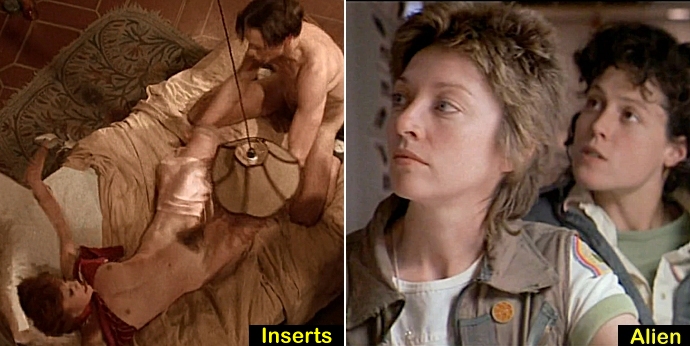
Hollywood casting directors simply aren't known for dismissing actors who have done nude scenes, they are in fact more likely to ignore actors who turn up with a list of conditions, things they won't say or do in a movie role. For example, actor Neal McDonough has lost roles because he won't kiss any woman other than his wife (and obviously sex scenes are clearly out) and yet we've seen many movies where the asshole happily plays a villain that tortures and/or kills untold people. McDonough, guided by his faith as a devout Catholic, has no problem acting out the graphic fake screen violence but won't even perform an innocent fake screen kiss. But to be fair and balanced, since we've provided many names and some viewpoints from actors comfortable with doing nude scenes, we should do likewise for those that are unwilling. What's their reasoning for staying under wraps, and might it trump getting naked? A quick search turned up the names of the following actors who refuse to do nude scenes. Note that some of them will consent to doing sex scenes, as long as they're at least wearing a bra and panties, lingerie or T-shirt etc. Appearing to have sex on-screen is fine apparently, we're all allowed to witness that intimate experience, but we can't be allowed to think that we might have seen some naked flesh.
You'll immediately notice that the list of those actors afraid of nudity is much shorter than the list of those willing to appear naked, which again argues that the majority of actors, known and unknown, have no problem with nude scenes, and studios are therefore unlikely to be struggling to find actors for such scenes. But of those that do refuse, what reasons do they give? Sarah Jessica Parker has said she has no problem with nude scenes per se or with other actors doing them: 'I don't have any judgement about anyone who chooses to do it. I think it's fantastic that people feel comfortable doing it. It's not some kind of principled position or religious or ideological on my part ... I've just always had a no-nudity clause. I'm a modest person. You couldn't pay me enough to have someone pretend they were me doing a nude scene. No body doubles — that's part of my contract'.Jessica Alba has said her reason to stay clothed is simply: 'I don't want my grandparents to see my boobs. That's it. It would be weird at Christmas'.Explaining her refusal to appear naked, Anna Kendrick has said, 'Nudity really isn't for me ... I don't mind a sex scene. A character can be having a sex scene, but my physical parts always feel like mine. 'Cause ... they are ... I don't object at all to the use of nudity in film; it can add realism and intimacy. And by the way, more power to the actors who are comfortable with it, but for the time being, it's not for me'.Mandy Moore refuses to be seen nude on-screen since she feels, 'It would be completely uncomfortable to walk down the street and know that the person passing by had seen me without my clothes on'.Well-known for her role as Trinity in 'The Matrix' (1999), Carrie-Anne Moss will also be keeping her clothes on, saying, 'I'm just not like that at all. My first thought would be, 'What would my mother think?'But no actor apparently worries over what their mother might think about seeing them kill untold people on-screen! The reason Hilary Duff has given for no nudity is, 'if I do a movie I want to be myself. I don't want to take my top off or anything'.We fail to see how that statement makes any sense at all, since people in movies never get to be themselves, they're always playing a fictional character and doing whatever that character is scripted to do. It's called acting, and sometimes that means taking your top off. And when Hilary is at home being herself, her statement implies that she never wants to take her top or anything else off, which is surely false. The reality is the movie world and the real world both feature nudity. All of the above actresses offer simplistic reasons for no nudity, like 'I don't want my grandparents to see my boobs', which is personal to them, and none have a problem with other actors doing nude scenes, so none of their reasons offer any argument that on-screen nudity shouldn't happen. Their reasons are essentially no different to an actor saying they won't film scenes in Los Angeles because they live in New York and don't want to spend time away from their family. It's a reason unique to them and has nothing to do with the studios in Los Angeles. Likewise their aversion to on-screen nudity is personal and says nothing about whether movies should feature nudity. These actors no doubt also refuse to be seen naked in pool changing rooms, saunas and their doctor's office. Discussing on-screen nudity, Megan Fox has said, 'I can't ever imagine myself doing nudity in a film. It lives forever, especially now, with the Internet. I just can't. I just can't ... Literally all I have left are my private parts and I don't want to also share them with the world. I'd like to keep them private. That's why they're called that!'Actually they're called 'private parts' because the Christian Church (unlike other ancient cultures) came to view the genitals and female breasts as offensive, indecent, obscene and disgusting, even though they were lovingly designed and crafted by their god to be perfect. Saying the genitals must be kept private makes no more sense than saying the elbow must be kept private. There is no line on the body marking where public skin becomes private skin, believing that there is such an invisible boundary is superstitious nonsense. Remember that the navel, ankle and male nipples were also once considered 'private parts', just as the hair on a woman's head still is in many Muslim countries. Fox has also said she has turned down certain roles, like playing a sex worker, because, 'Those are things that are degrading to the woman who's playing the character. ... I don't think my children should ever see me doing some of that stuff. I don't think my boys could handle that'.  And yet Fox happily took a role in (among other similar titles) the (crappy) action movie 'Expend4bles' (2023) playing a deadly mercenary, which was 'Rated R for strong/bloody violence throughout, language and sexual material', the thrillers 'Till Death' (2021) — 'Rated R for strong violence' — and 'Midnight in the Switchgrass' (2021) — 'Rated R for violence and language throughout' — and also the horror movie 'Jennifer's Body' (2009) — 'Rated R for sexuality, bloody violence, language and brief drug use'. Like a true patriotic American Megan Fox has no problem with her children seeing her shoot, kill and murder numerous people in her movies; she's happy with them seeing her doing all the violent stuff. She'll even do some sex scenes in revealing underwear, as the following screenshot from 'Expend4bles' shows — she's sure her boys can handle that — but again, like a true American, she just won't take her clothes off in the sex scenes ... because ... umm ... it's unladylike and she doesn't believe her young boys could handle the shock of naked flesh? It's annoying how many people can't admit to their own insecurities and instead argue that they're performing certain actions to protect the innocent children, who normally aren't worried in the slightest or even interested. And lest you think, well it's just a movie, just pretend, of course she would get naked in real life during sex, the scary reality is that some authorities in Islam, the fastest-growing major religion in the world, are indeed demanding that people keep their clothes on while having sex. And the Christians have made similar irrational demands around sex and nudity in the past, and could easily do so again, if they haven't already in some fundamentalist sects. Anyway, regarding Islam we have read the following:
And yet Fox happily took a role in (among other similar titles) the (crappy) action movie 'Expend4bles' (2023) playing a deadly mercenary, which was 'Rated R for strong/bloody violence throughout, language and sexual material', the thrillers 'Till Death' (2021) — 'Rated R for strong violence' — and 'Midnight in the Switchgrass' (2021) — 'Rated R for violence and language throughout' — and also the horror movie 'Jennifer's Body' (2009) — 'Rated R for sexuality, bloody violence, language and brief drug use'. Like a true patriotic American Megan Fox has no problem with her children seeing her shoot, kill and murder numerous people in her movies; she's happy with them seeing her doing all the violent stuff. She'll even do some sex scenes in revealing underwear, as the following screenshot from 'Expend4bles' shows — she's sure her boys can handle that — but again, like a true American, she just won't take her clothes off in the sex scenes ... because ... umm ... it's unladylike and she doesn't believe her young boys could handle the shock of naked flesh? It's annoying how many people can't admit to their own insecurities and instead argue that they're performing certain actions to protect the innocent children, who normally aren't worried in the slightest or even interested. And lest you think, well it's just a movie, just pretend, of course she would get naked in real life during sex, the scary reality is that some authorities in Islam, the fastest-growing major religion in the world, are indeed demanding that people keep their clothes on while having sex. And the Christians have made similar irrational demands around sex and nudity in the past, and could easily do so again, if they haven't already in some fundamentalist sects. Anyway, regarding Islam we have read the following:
'Egyptian scholars issue fatwas against unclothed marital intercourse. In 2006 Rashad Khalil, former dean of shari'a law at Al-Azhar University, issued a fatwa suggesting that a state of undress somehow negates the properly modest state of marriage. One suggestion, by the chairman of the university's fatwa committee, Abdullah Megawar, was that married couples might at least avoid looking at each other's genitals.' [27]In the movie 'Expend4bles' Fox likewise denied her lover the pleasure — or should that be shielded him from the horror — of seeing her genitals, or her breasts, by insisting on 'clothed intercourse'. Fox gives a thumbs up for kids watching violence in movies, but a thumbs down for nudity. Clearly a woman that knows how to raise children. We're of the view that people should be allowed to do stupid things as long as they don't harm others, and yet in this case Fox will be doing harm to her children by instilling in them the belief that nudity is shameful, that not only are sex workers shameless, even an actor merely playing a sex worker in a movie is doing something degrading. And since Fox refuses to act in a scene 'doing some of that stuff', which of course is just normal sex acts, then Fox's boys will surely grow up believing sex is degrading, at least for women. But they'll get to see their mother killing untold people in lots of violent movies, something which always moulds good character.
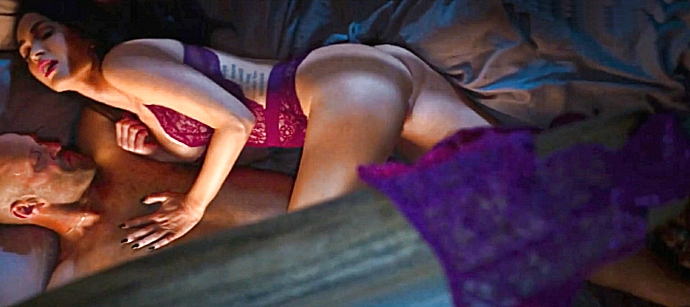
As for Jessica Simpson's reason, she says, 'I will never do nudity ... I don't think people deserve to see what's underneath my clothing'.Seriously ... people don't deserve to see her naked!? What a nonsensical excuse! To deserve something is 'to gain as a result of one's behaviour or effort', and since Simpson knows absolutely nothing about the world's moviegoers, she clearly can have no idea whether we have done enough to deserve to see beneath her clothing. It's also quite arrogant of Simpson to think that moviegoers actually want to see her naked. We can honestly say she has never been on our (huge) 'Actors we want to see naked' list, and still isn't. Blake Lively has said that part of the reason why she won't appear naked is that, 'When I see nudity in movies, I am always distracted by it. I know that if I am watching a scene and someone has their boobs out, then that's all I'm looking at — I can't help it'.We'd agree with Blake that for many people the sudden appearance of some boobs can be distracting, but her solution to the problem, keeping her boobs covered, is a solution destined to fail. Boobs, and nudity in general, is distracting to many moviegoers simply because of how the movies treat nudity, which is the argument of this entire article. Movies treat innocent, real-world nudity — like when showering, changing clothes or even having sex — as something shameful, as something that should be kept hidden, either with the likes of sexy underwear, translucent shower curtains, fluffy towels and cover-all bed sheets, or better still, not seen at all. So when nudity does make a rare appearance, of course people are going to notice, and maybe get a little distracted, since we don't expect realism in the movies when it comes to nudity. We're like Blake, in that we too get distracted by boobs, in movie after movie, and not because someone gets them out, but because they don't! Happily enjoying a movie we can suddenly find ourselves jolted out of the moment and shouting at the screen — WTF! Why is she now covering her boobs with the bed sheet when it's implied that they've spent the last couple of hours having wild, passionate sex? And why when they both finally hop out of bed are they both still wearing underwear? Why are all the carefree, confident nudists hiding their nudity behind conveniently placed objects? Why do people, alone in the bathroom, emerge from the shower already wrapped in a fluffy towel, almost as if they think they're being filmed? It's stupid, unrealistic scenes like these that we find distracting, not the nudity but the lack of it when it should be there. We know that nearly every scene in every movie is pure fiction (even much of those that claim to be 'based on a true story'), but even though it's fiction, we still expect a level of realism, meaning the fictional world must still have an internal consistency. Physical laws and logic must still apply as they do in our world, unless of course it's the likes of a Bugs Bunny or Roadrunner cartoon. Even though the story isn't real it's still telling a story that, within the movie, is absolutely real as far as the characters are concerned. For these fake scenes to seem real to the viewer as well, the makers of these movies know the guns must look and perform like real guns, same with the speeding cars, likewise aliens and zombies must look and behave like the stories suggest they would, and survivors struggling in a post-apocalyptic world must appear dirty and desperate as the term usually implies. And importantly we should still expect people in these movies to behave as they would in our real world, whether doing something mundane or confronted with some new challenge. People should be amazed by superheroes, run screaming from zombies, battle the aliens and try to prevent terrorist attacks, just as they should occasionally need to go to the toilet and charge their smartphone. That's what real, normal people do. And real, normal people get out of the shower naked and have sex naked. Nothing knocks us out of that full movie immersion as does a scene that defies belief, where a character does something completely 'out of character', does something that a real person with their knowledge and experience would never do in real life. If Blake Lively finds boobs in movies distracting, then the answer is to show realistic nudity in movies just as we show realistic murders, bullet wounds and autopsies. After a while someone with their boobs out would be no more distracting than a person with their smartphone out. UPDATE: Blake Lively made the above statement to the Daily Mail in 2012 but has since changed her mind, deciding to appear naked in the 2016 movie 'All I See Is You', agreeing that it was quite necessary for the story. So we've removed her name from our list, however Internet lists still keep highlighting her as someone against movie nudity. Actor Rachel Bilson won't get naked on-screen because she believes that, 'Movies can be sexy or sexual without showing things'.Of course this is true, but one could equally argue that movies can be exciting and thrilling without showing graphic violence. We don't need to see untold bullets ripping through bodies, swords slicing through flesh and planes exploding to know people have been killed. And yet, contrary to movies 50 plus years ago, Hollywood now feels they definitely need to show things, well, at least when it comes to the violence. Showing things in a nudity context is now rare, even actual nude scenes actually show very little. Rachel's argument also has another side to it, in that movies can also be sexy or sexual by actually showing things. Call us weird, but as sexy as a woman might appear in fancy lingerie, she is far sexier when it comes off. Sexy bras and panties are great, but only because of the promise of what's underneath. In the real world we would never feel satisfied if they never came off, and yet Rachel's belief is that moviegoers are just as happy if they are never shown a glimpse of bush country. Actors Chris Pratt, Neal McDonough (Christians) and Mahershala Ali (a Muslim) all refuse to do nude or sex scenes because of their religion, with McDonough saying, 'I am very religious. I put God and family first, and me second. That's what I live by'.Surprisingly Chris Pratt worked as a stripper when he was in his late teens, saying, 'I was always a very much naked person. I loved to always get naked. I was very free, so I thought, I may as well get paid'.  Then Pratt found God. Well, of course he didn't actually find God, that would be as impossible as finding the Easter Bunny, he has merely deluded himself into thinking he has sensed God's existence. Refusing to do nude or sex scenes because of a silly belief in an imaginary being is of course a futile exercise. The actors don't earn any brownie points for their chaste behaviour since God isn't real and isn't watching. Their lifestyle is made more difficult trying to comply with God's ridiculous rules, including McDonough losing out on work, and the joy of nudity that Pratt used to feel has evidently been replaced with the bogus belief that it is shameful. Rather than love the naked human body and freely enjoy sex, religion teaches believers to be ashamed of both, and utterly screws up their lives. An excellent book to read is 'Sex & God: How Religion Distorts Sexuality' (2012) by Darrel W. Ray where he details the harm that it does.
Then Pratt found God. Well, of course he didn't actually find God, that would be as impossible as finding the Easter Bunny, he has merely deluded himself into thinking he has sensed God's existence. Refusing to do nude or sex scenes because of a silly belief in an imaginary being is of course a futile exercise. The actors don't earn any brownie points for their chaste behaviour since God isn't real and isn't watching. Their lifestyle is made more difficult trying to comply with God's ridiculous rules, including McDonough losing out on work, and the joy of nudity that Pratt used to feel has evidently been replaced with the bogus belief that it is shameful. Rather than love the naked human body and freely enjoy sex, religion teaches believers to be ashamed of both, and utterly screws up their lives. An excellent book to read is 'Sex & God: How Religion Distorts Sexuality' (2012) by Darrel W. Ray where he details the harm that it does.
All of the reasons these actors give for them not doing nude scenes seem, at their core, to suggest that they think it's simply wrong to be seen naked, that it's shameful and deeply embarrassing. Our last three actors freely acknowledge that it's religion that gives them this message, but clearly the rest feel the same way, even if they don't mention God. Something in their upbringing has told them to keep their body covered, and has taught them to be mortified if someone sees them naked. These are all very attractive actors, so clearly none would be worried that people would laugh at their naked form, their fear of nudity derives from them being conditioned to feel shame, regardless of how beautiful their body might be. And as we've argued in this article, even for people who don't recognise God in the mix, this source of shame can always find its way back to people loudly insisting that God would not approve! We mentioned that when explaining her source of shame, Jessica Alba has simply said: 'I don't want my grandparents to see my boobs. That's it. It would be weird at Christmas'.However we've since seen another interview she had with Scarlet magazine, where she added more background info: 'I think I was always very uncomfortable about the way my body developed, and I remember my grandmother would freak out and throw a towel over me if she saw me wearing just a bra and panties. I come from a very Catholic family so it wasn't seen as a good thing to flaunt yourself like that'.And the truth comes out. Jessica was raised from a child to be ashamed of her body by a fucked up Catholic family. God is the villain once again. Furthermore, not one of these actors has cited any of the arguments some people are offering for needing to get rid of nude scenes from movies; none say they fear sexual harassment or abuse while on set; none complain about the technical difficulties of keeping the censors happy; none say the public is offended by nude scenes; and none claim that actors as a group are rebelling against nude scenes. It all focuses on their personal shame, about how their nudity would affect them, not about how it affects other actors or movies as a whole.
OK, so no doubt some actors will miss out on certain roles because of things they're not prepared to do, meaning their career might potentially suffer, but there is no evidence that the opposite happens, that actors miss out on roles because it's known that they've appeared nude in a previous movie. Clearly there are untold actors, famous and otherwise, that are willing to do nude and sex scenes, and there is no evidence that taking these revealing roles harm their careers in the slightest. Yet still there are those in society, often clutching a Bible, that belittle and denigrate actors for taking such roles, but why should the sight of an actor naked lower their reputation or standing in the real world? Let's assume for the sake of argument, that American actors did suddenly get all prudish, find God and refuse to do nude scenes? (More outlandish things have happened, they elected Trump president after all!) Would this refusal to get naked create a problem so insurmountable that by necessity it would see the end of on-screen nudity? Not at all. Actors rightly refuse to get shot, stabbed, blown up with car bombs or thrown off high buildings, and yet still we seem to see actors experiencing exactly those things on-screen, over and over. But, we hear you say, when we see a movie character killed or bitten by a zombie, it's obviously not real. Of course it looks real, sometimes distressingly real, but we know the actor wasn't actually shot or bitten. And there's the solution, in that likewise actors can now say they weren't actually naked, it wasn't real, it was all fake. The bullet wounds were fake, the scary ghosts were fake, the zombie bite marks were fake, and yes, the naked boobs were fake too. It used to be that the sex in movies was fake (obviously) and the nudity real, but now the nudity can be fake too. We have the technology, we've landed a probe on a comet, sequenced the human genome, eradicated smallpox, and now when making a movie we can give a woman fake breasts and a guy a fake penis (with no need for surgery), and even fake pubic hair ... yes, I know, isn't it amazing! Who would have imagined that they could recreate long extinct pubic hair ... maybe dinosaurs will be next? So even though we've just argued that there are many actors, both famous and unknown, that are quite willingly to appear naked on-screen if the scene calls for it, the reality is that Hollywood is now faking more and more of its nude scenes. So when people today argue that there is still some nudity in contemporary movies and TV shows, this is certainly true, but there is far less than there used to be, like in the 1970s and '80s, and unlike back then, a proportion of today's on-screen nudity will be fake. So not only is there less nudity, there is even less real nudity. Today Hollywood is often choosing to fake the nudity, even though filming willing actors in the nude is surely the cheapest, easiest and most realistic way to film a nude scene. In a similar vein (minus the nudity), I was reading last night how a film crew figured out that the best way to shoot a realistic scene that would show that their Vikings warriors lived in a cold, harsh land called Iceland was to ... simply put the real actors in a real snow-covered field in Iceland. Wow, who would have thought that the best way to achieve realistic looking people on film was to simply film real people? Not all directors in Hollywood it seems because as we've said some are faking their nude scenes, meaning the need for Hollywood to find actors willing to get naked has effectively disappeared. We're not saying that Hollywood faking nudity is a bad thing, after all, Hollywood is in the business of producing convincing fakes, that's what it excels at (at least some of the time). We'd prefer it if they simply showed the actors truly naked, but if they were all suddenly too ashamed to strip off, then the next best option is fake nudity than no nudity at all. The only problem we have with Hollywood faking nudity is their propensity to create fake bodies that fit a perfect, idealised form that only exist in their fictional world, rather than creating real world bodies that real people actually have, and in doing so they set an unrealistic standard of perfection that no real person can hope to attain, and yet, like foolishly seeking the pot of gold at the end of a rainbow, untold people now strive for that fantasy of gaining a body like their favourite screen goddess or muscular hero. If forced on us by Hollywood, the fake nudity we'd approve of is where on-screen naked bodies, although faked, still resemble real world naked bodies, not idealised fantasy versions, actual bodies that we can relate to. And surely no actor could oppose fake nudity, since the audience would know that the nudity was fake just as they know all the murders and crimes their character committed were fake too. And again, this isn't hypothetical, a proportion of today's on-screen nudity is already fake. How much is anyone's guess. But without doubt, these days some of the on-screen nudity that many people are offended by (or titillated by) isn't even real! Really ... fake nudes?? I mean, fake news is bad enough, but fake nudes? Maybe you're not convinced? Just wait, photos are coming up. After a little research into the prevalence of fake nudity in movies we were somewhat surprised at how common it seems to have become, and how good they are getting at fooling us, at least some of the time. But perhaps you doubt that much fake movie nudity even exists, after all you haven't noticed it, and (like untold 14-year-old boys on Internet forums) you're convinced that you can confidently tell whether a naked body is real or not. In our (limited) research we looked at screenshots of naked bodies from some movies and TV shows that have been revealed by the actual actors or directors as being faked, in the same way that bullet wounds are faked. By faked we mean the illusion of nudity is created with special effects, like where an actor's real body part is replaced with a fake body part, such as a prosthetic, or where their entire body is replaced with a body double, or where CGI creates a fake digital body image, or where the nudity (real or not) is essentially hidden by the likes of shadows or props, in essence any scene where the viewer is fooled into thinking they really saw an actor naked is a fake scene. Just as actors never get shot during the filming of an action scene, these actors never got naked during their nude scene either. But it's not that easy to compare fake bodies with real bodies, since even though there has of course been numerous "nude" scenes in movies in the last two or three decades of what we might label the beginning of the 'fake era', only a handful of actors or directors have ever revealed which of these movie scenes were faked and which were filmed for real. Most actors are understandably less than candid in discussing their movie's nude scenes, and likewise most directors no doubt believe that what happens on set stays on set. Although we personally like to watch those rare video extras that were sometimes included on movie DVDs where a handful of directors and actors explained a little of what went into making their movie, most of what happens behind the scenes to make movies seem real, from action stunts to explosive special effects, is never revealed, nor do most people want it to be, and so of course what happens in the filming of nude scenes will likewise be kept under wraps, even more so because of its personal and intimate nature. The nudity you think you see on-screen belongs to the character, the nudity that happened, or didn't happen, during filming on set belongs to the actors, who are real people with a right to as much privacy as they desire. Nudity in a movie is designed to reveal an image of a specific character, usually a fantasy character, it's not there to show what the actor looks like naked, meaning there is no reason why specific parts of the actor's body shouldn't be altered with prosthetics, CGI or a body double to make them better resemble the character, or to show a level of nudity that the actor might not be comfortable with. Plus actors are (at least in the industry) often praised for their bravery in agreeing to nude scenes, and the fakery almost always shows them with amazing bodies, so some may be reluctant to correct the false assumption that it's their sexy body that is seen on-screen, rather than a fake. Although people can easily point to a specific movie with a nude scene, if the studio has done its job then it's mere opinion and not fact as to whether it was faked in any way. Of course it would be easy to grab movie screenshots from the 1970s and '80s and confidently declare that most all those nude scenes featured real nude actors, and those that didn't were clearly faked by cheap special effects or the obvious use of a body double. However in the last few decades far more sophisticated tools have become available to the studios. Just like magicians, directors spend a lot of effort controlling what the moviegoer can see, and hiding everything that might reveal how their movie magic actually works. They want to create scenes that look and feel real, that's their job, they want us immersed in the story, not wondering how the scene was filmed, meaning they don't want to include any sign of their tinkering that might burst the bubble and destroy the illusion. Most movies are made, people watch them, and then they, both the movie studio and the moviegoer, move on to the next one. While there are a few nerds that feel differently (like us), most moviegoers are not interested in how movies are made, many even feel that knowing how would ruin the movie for them. So only a few snippets ever come out about what really happens on a movie set.
So the problem is, with the movie often being the only evidence to examine, how does a (curious and skeptical) moviegoer judge whether a nude scene is real? When you see a bullet wound in the movies, no matter how realistic it looks you know it must be fake. Movie nudity is different in that it can look real because it is real, or it can look real because it has been convincingly faked, like the bullet wounds. To make our case that Hollywood can now easily mislead moviegoers when it comes to the naked human body, quickly scroll through the following screenshots of bodies from various movies and TV shows. This is not a test to guess the actor or the movie. The challenge is simply to see if you can detect the scenes in which we are seeing the actor's real body, the scenes in which some body parts are fake (where practical special effects and/or CGI have created the illusion of some naughty bits), and the scenes in which it's impossible to tell whether it's fake or real. There are examples of each. And remember that many of these scenes would only have been on-screen for a few seconds, so you shouldn't spend ages deciding, as you wouldn't have had that luxury when watching the actual movie. So see how well you do. We'll start with a couple of easy ones. The answers are at the end of the images, where we will then look at the tricks movies use to fool us.

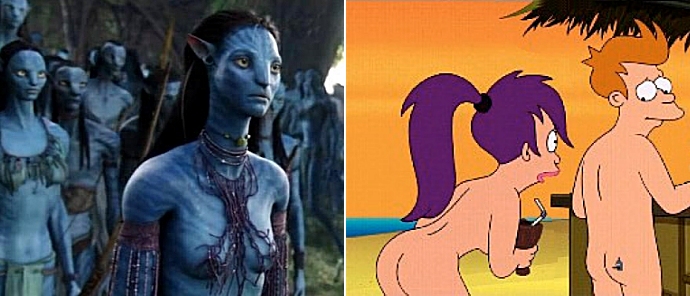
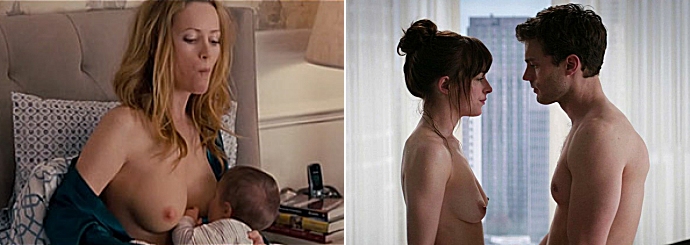
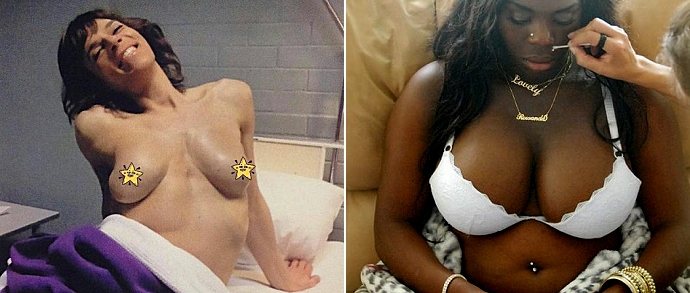
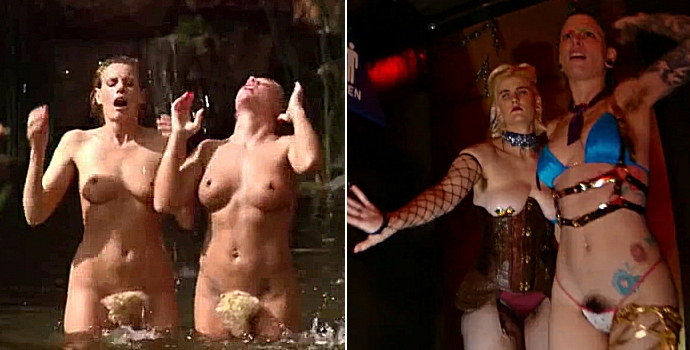
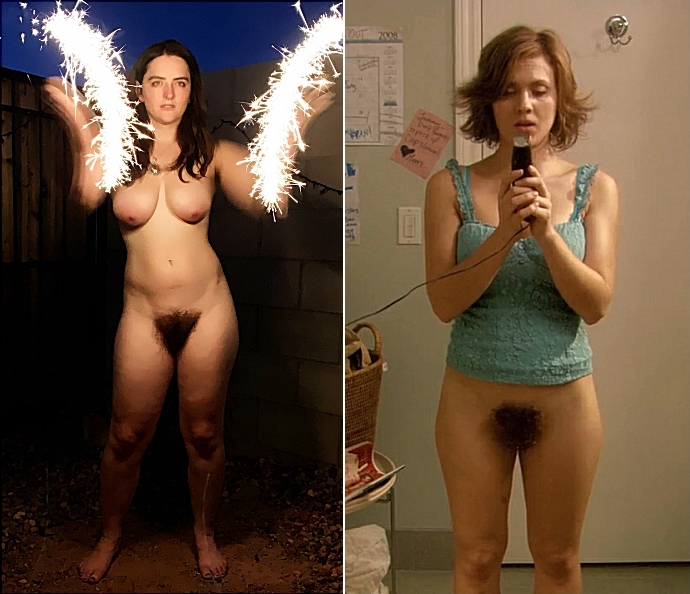
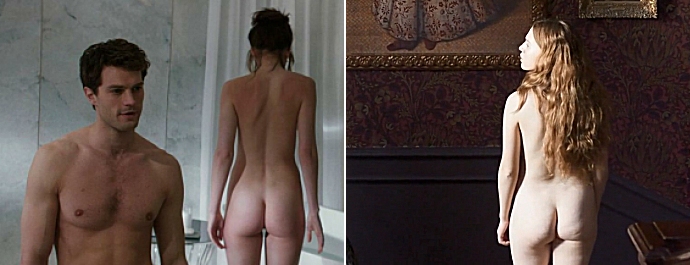
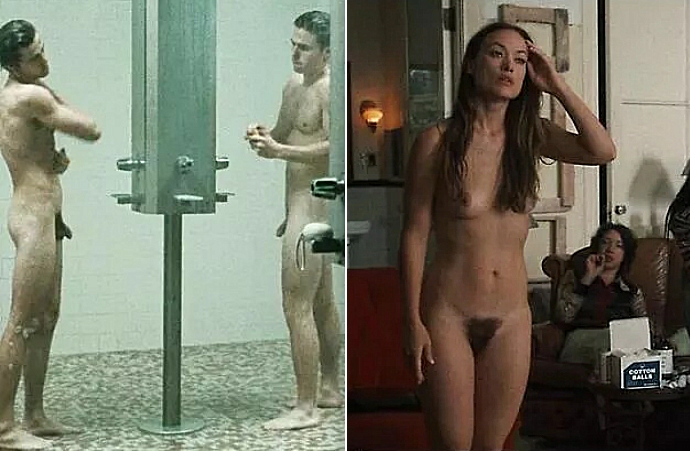
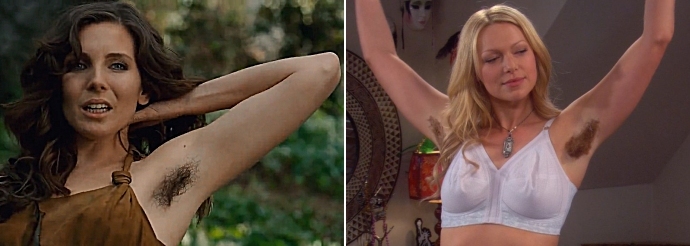
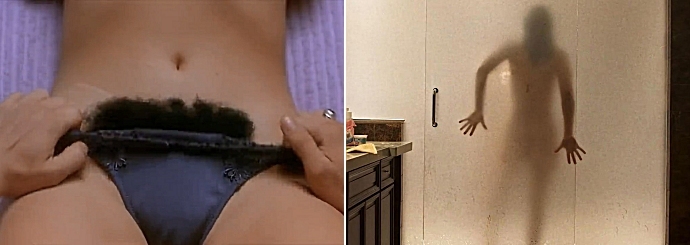
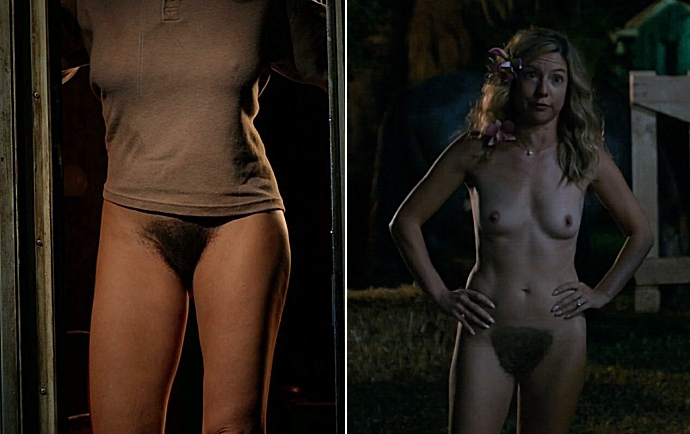
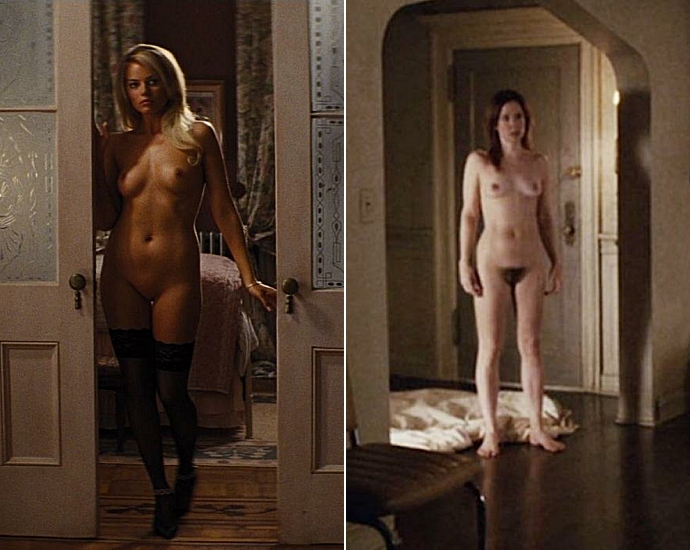
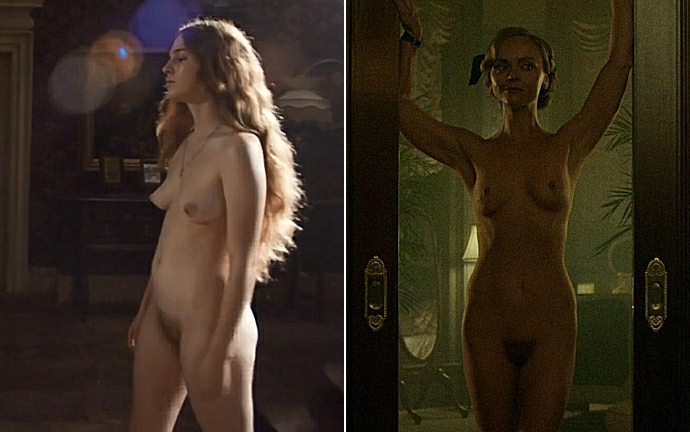





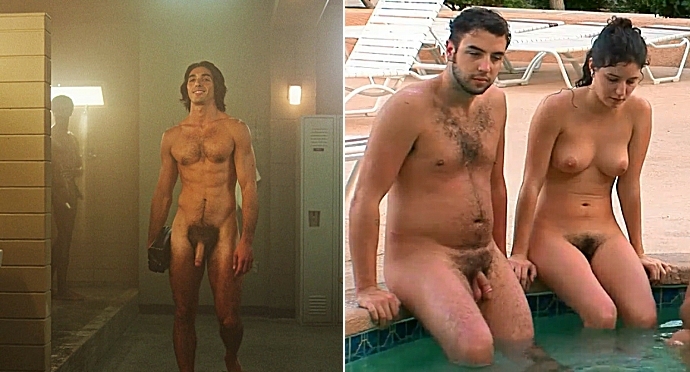
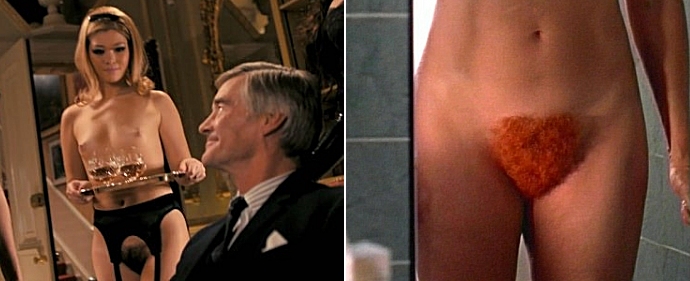

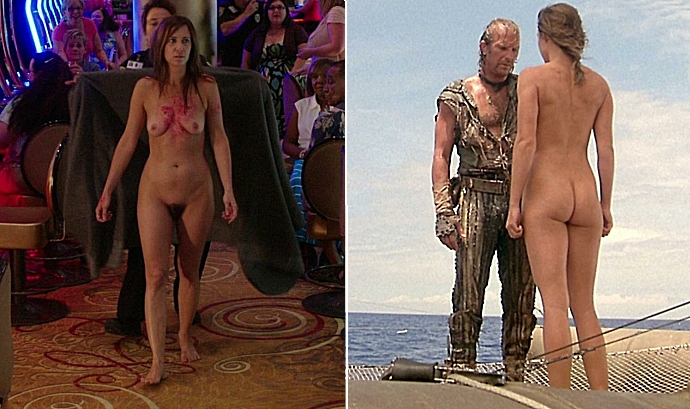
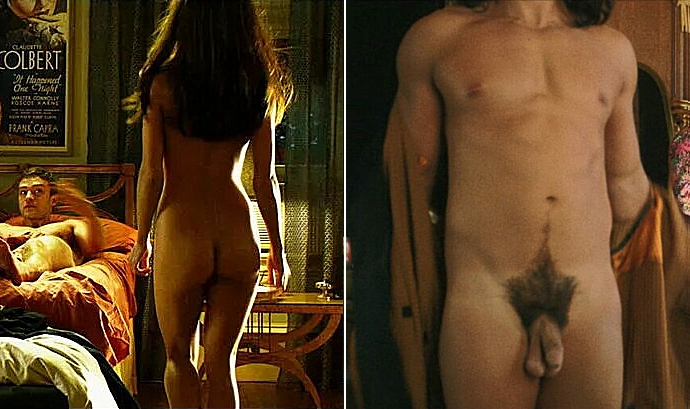
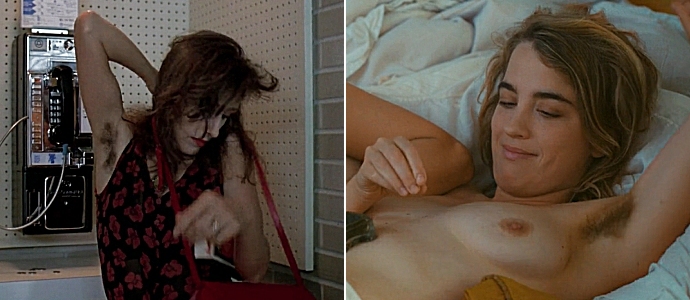
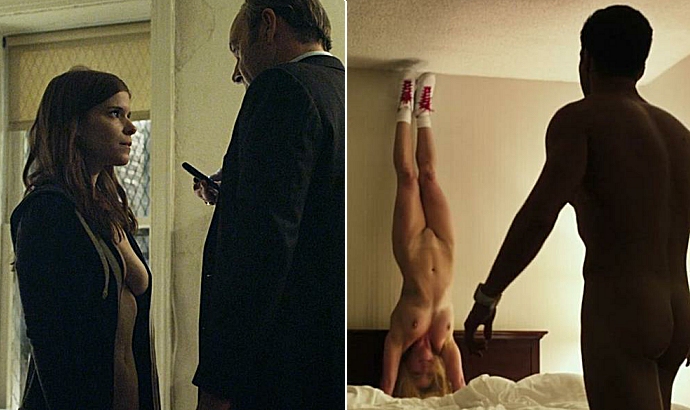



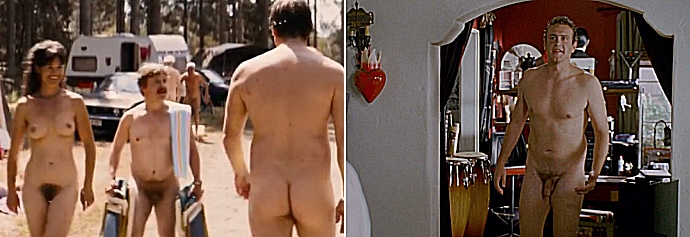
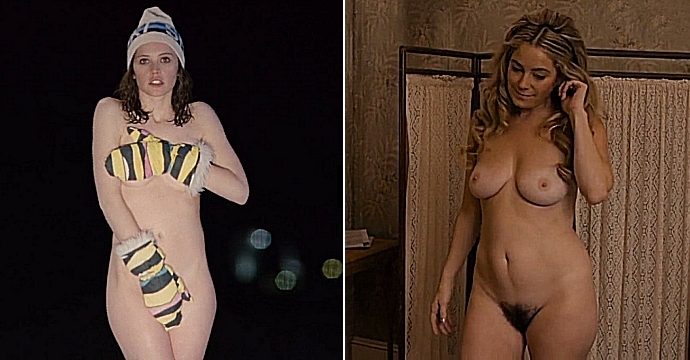
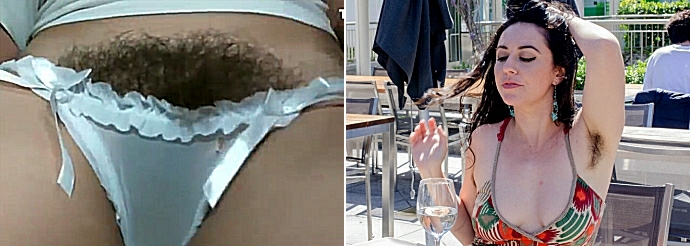
OK, times up, let's see how well you did. Below we've labelled each of the above scenes 'FAKE', 'REAL' or 'UNKNOWN'. For the fakes we have identified which part of the body is fake or have noted where the whole body has been swapped out for a fake body double.

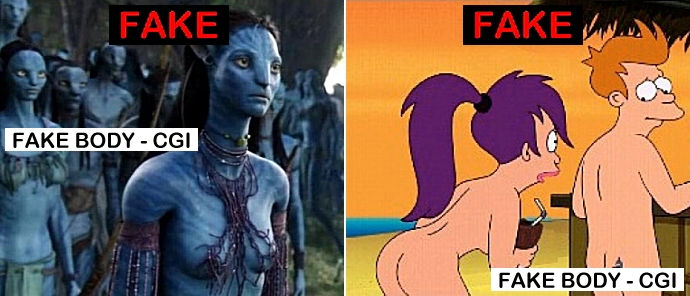
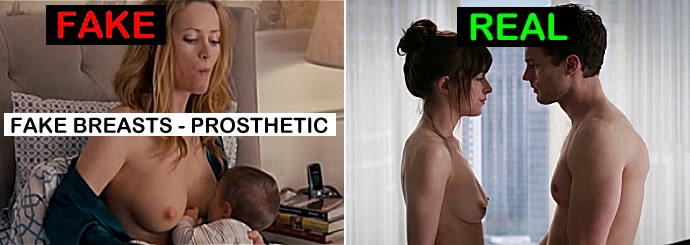
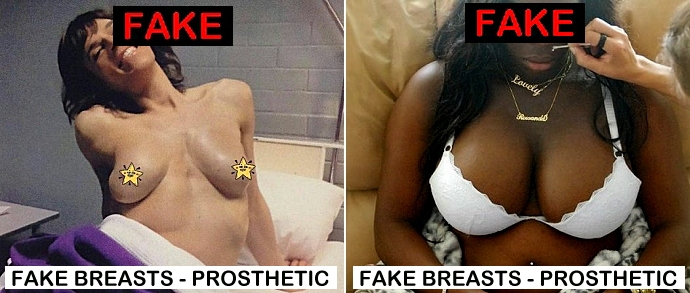
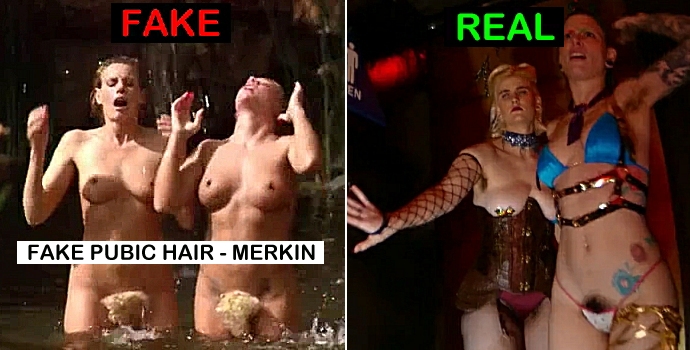
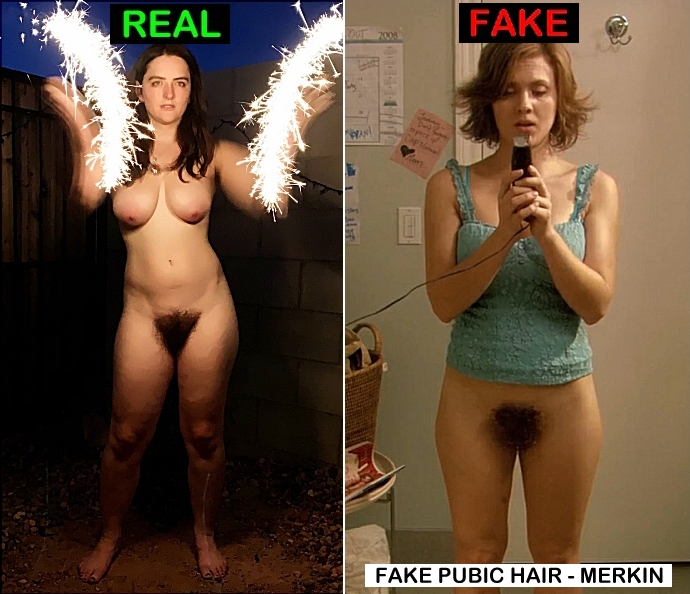
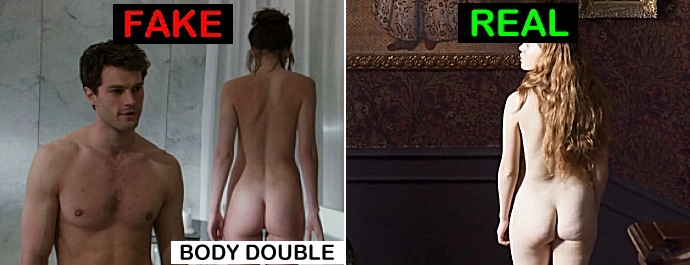
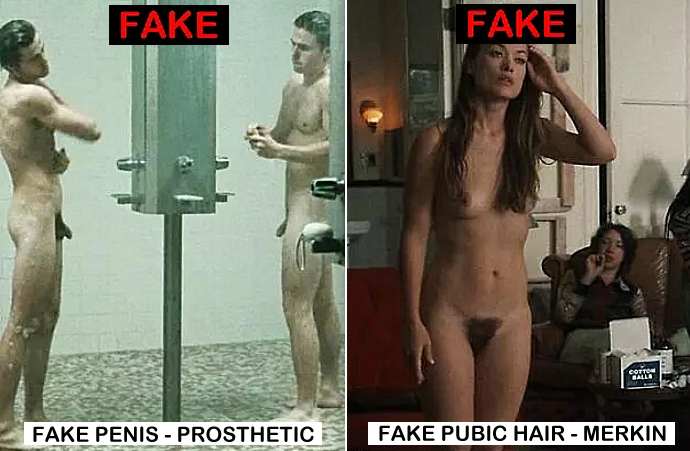
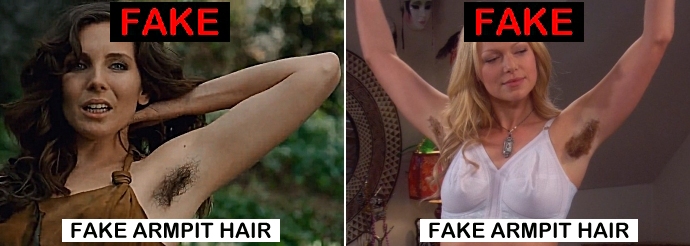
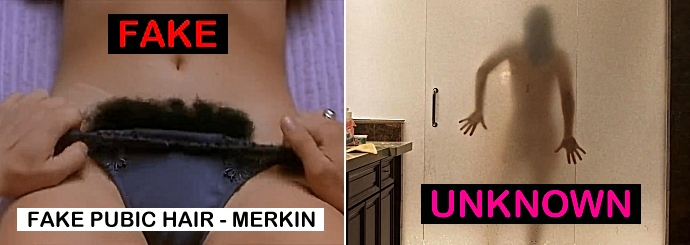
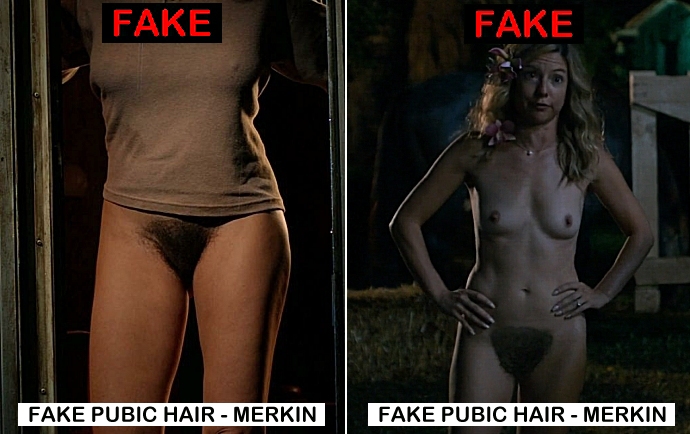
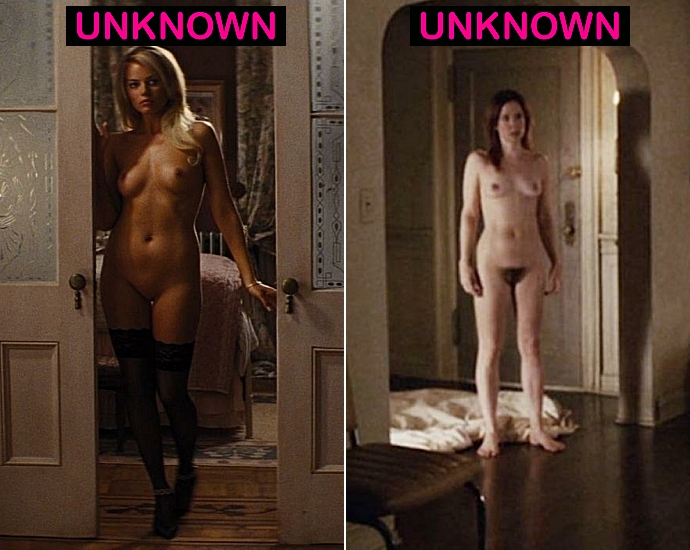
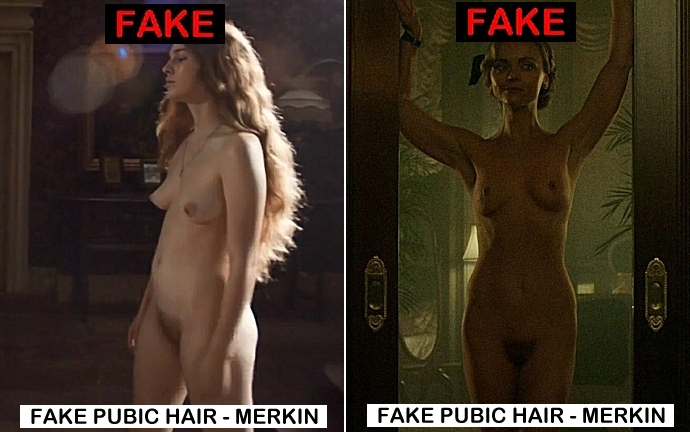
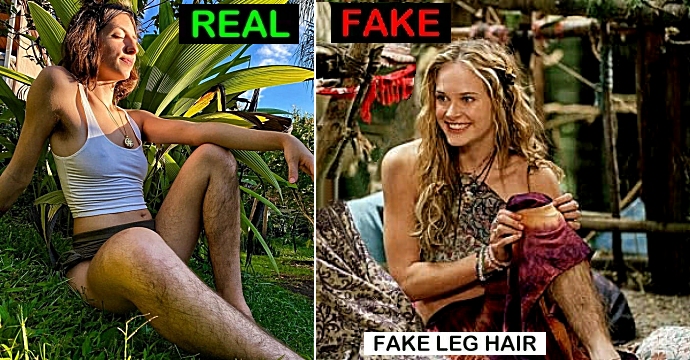




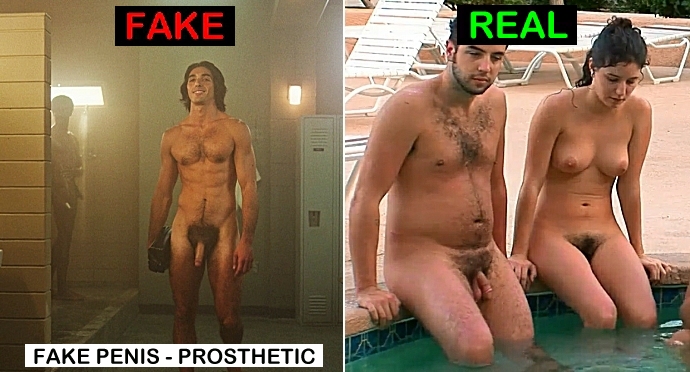
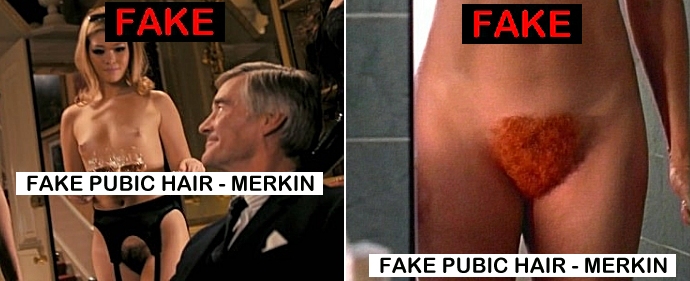

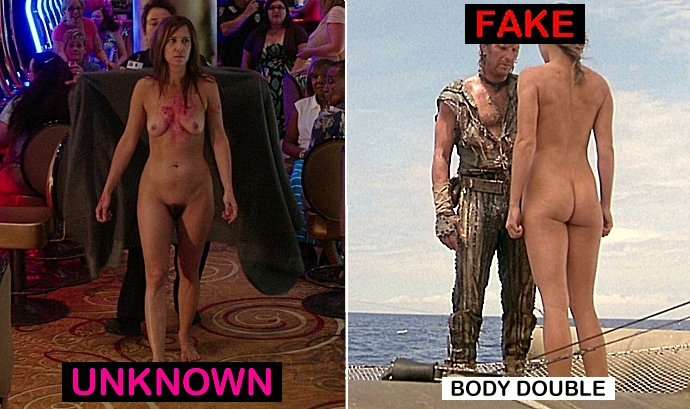
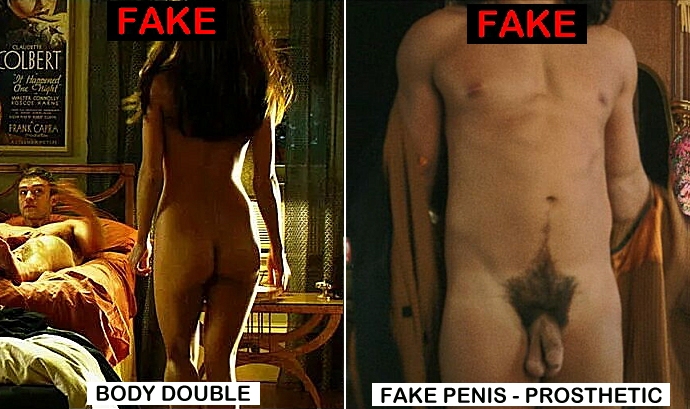
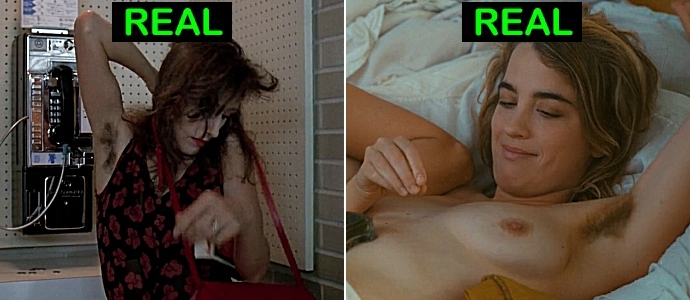
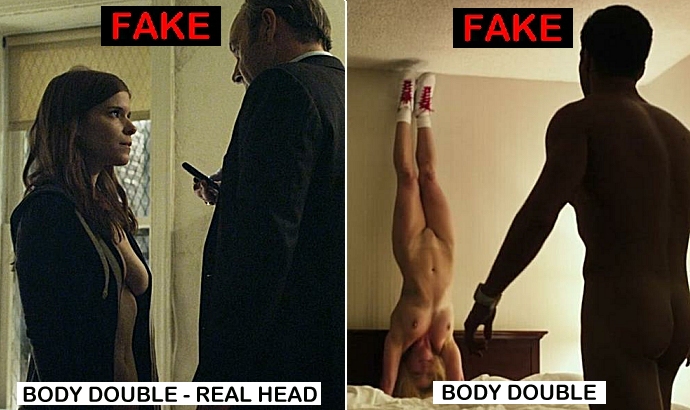
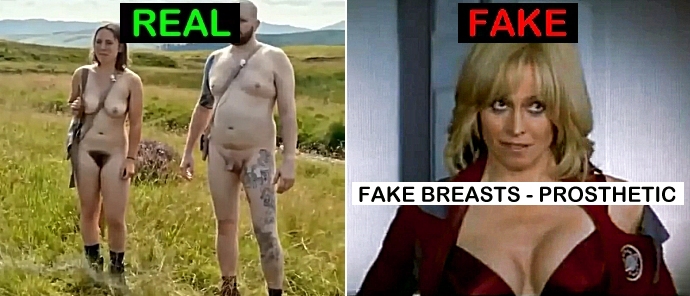
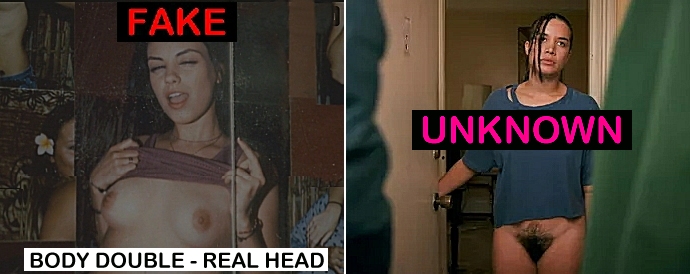
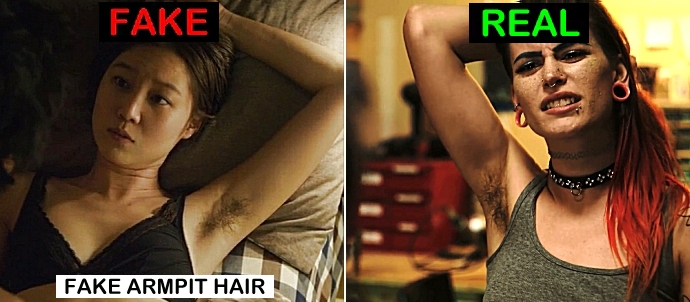
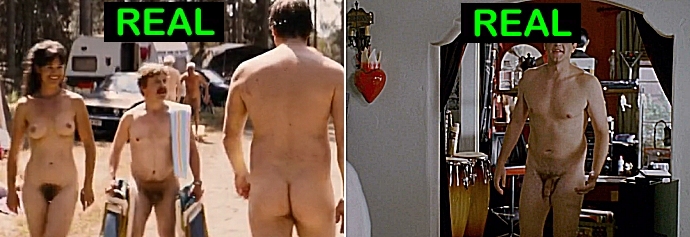
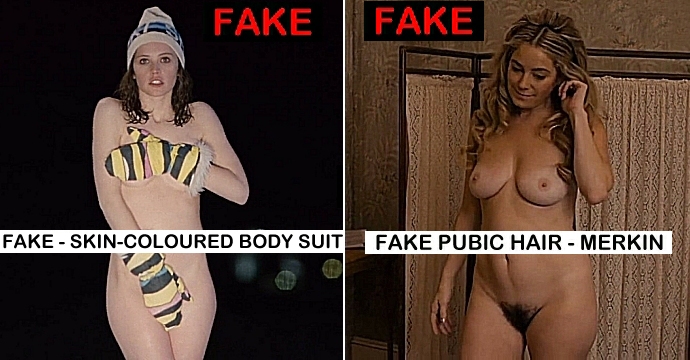

So ... how did we go? Have you qualified for a prize? Could you readily tell where part of a body was fake, or was it mostly too close to call? Or worse still, did you mistakenly flag some of the fake bodies as real and vice versa? Of those scenes, over half were fake, six were scenes where we simply don't know (but of course we could have included untold examples of this sort), and the remaining ones, less than a third, were real. Aside from the obvious fakes (hopefully you got 'Avatar' and 'Futurama'), we have only been able to reliably tag the real and fake bodies because those involved in those scenes have identified them as such, essentially we have "insider information". We hope we've convinced you that some of the acknowledged fake nudity is so realistic that it forces us to accept that it is likely impossible to discern whether the scenes for which we have no information contain real or fake nudity. We included those unknowns to demonstrate the bigger challenge, that when we look at other nude scenes in recent movies we have to admit (because no one is talking) that we simply can't say whether they show the actor's real body or a fake body, or some of both, and surely it's the same for all moviegoers, not just us. Even when some do talk, what they say is sometimes questionable, like they'll say they were naked when that isn't strictly true. Like many people, especially Americans, some actors struggle to understand what being naked actually means. Some actresses will say they were naked in a movie when they were only topless, or they only showed their naked back or butt, very few will have been truly naked these days, which means full-frontal nudity. The great majority of movies that have a nude scene involve an actress that exposes her breasts but nothing below her waist. Even if a scene appears to show full-frontal nudity she will now likely be wearing a merkin or modesty patch, which is no different to wearing flesh-coloured underwear or bikini bottoms; so not naked, just topless. Male actors might say they were naked (and feel naked) while neglecting to mention that their genitals were safely secured in a little flesh-coloured pouch. Some may have been genuinely naked and will say they appeared naked even if they were a blurry figure running in the distance, or were standing fully naked behind some well placed props, like a shower curtain, or were filmed deep in the shadows, which is still fakery since they were shot that way to hide their nudity, as real as it may have been for them on the movie set. We'll show an example of this a little further down involving Jennifer Connelly's "naked" appearance in 'American Pastoral', but for now here's an example from the comedy movie 'Girl Walks Into a Bar' (2011) starring Carla Gugino. The scene shown in the screenshot below was set in a nudist ping-pong club (it's a thing apparently), but were the actors actually naked with the props being carefully arranged and black bars added later in post-production to hide that nudity, or were they all wearing flesh-coloured underwear, and that's what the black bars hide? If they were truly naked, and that certainly would have been the easiest way to film that scene, then they could honestly say so in interviews, but that statement of fact would lead many to infer that they are therefore seen naked on-screen, which is a false assumption since their nudity has been hidden from the moviegoer. Appearing fully naked in front of a film crew is not the same as appearing fully naked on-screen to the public, not if movie tricks were employed to hide what the film crew saw. So again, an actor can honestly say they were truly naked on the set while filming a scene, but in terms of what the movie shows, they kind of weren't, so an actor's comments can be both true and false at the same time.
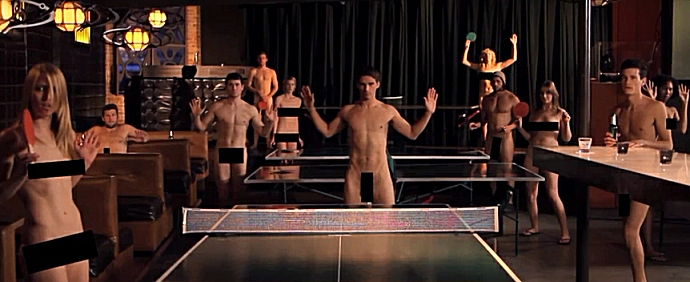
When Hollywood puts its best people on the job it's impossible to tell if we're seeing a real human body. Sometimes actors or directors reveal what was real and what was fake, but usually nothing is said, so these days it's just guesswork as to whether an actor was actually naked in a certain movie. Maybe they were, or maybe not. The level of fakery is now that good that, should they choose to, an actor can lie and claim that the naked body seen on-screen is really theirs, free of any enhancement, and you can't argue with them. Conversely they can say it was all faked, even if it was them naked (something they now regret), and again you can't argue with them. So that's the real challenge modern movies present us with, are we now beyond judging whether we're seeing the real bodies of the actors or carefully crafted fakes? We're talking breasts, genitals, butts, pregnant bellies, even navels and female body hair, all the parts of the human body that many people (especially many Americans and Muslims) find repulsive and offensive. And let's not forget female nipples, they might well be the most feared body part of all (for reasons never explained). So why can't we tell a real, dangerous female nipple from a harmless CGI nipple? How is Hollywood managing to fool us? Let's start with one of the oldest and simplest fakes, where sometimes the nudity in movies is real but the scene is still fake. As confusing as that sounds, what we're referring to is body doubles, where a real naked person with a body that resembles the actor's body shape and skin tone stands in for the actor in the nude scenes. Wearing a wig and accessories identical to the actor (just as stunt doubles do in fight and action sequences), a naked body double might be shown walking away so as not to reveal their face, or shot from a distance so their face isn't clear, and if the actor's face is in shot then the body double's naked body is not, you'll only see them from their naked shoulders upwards. When you do see naked breasts, for example, then you never see the actor's face, only the torso of the body double (although recent advances in CGI is changing this rule, and future scenes will show the actor's head merged seamlessly with the naked body of their double in the same shot). So some real naked body parts are seen, usually fleetingly, and it's edited in such a way to hide the fact that you are seeing the body of an unknown body double and not the body of the actor, who remains fully clothed off-camera. The use of body doubles in nude scenes is actually far more common than often realised (and certainly not new), but unlike stunt doubles in action movies, the nude body doubles receive even less recognition and are 'typically nearly invisible to those outside the industry'. Referring to the 1934 movie 'Tarzan and His Mate', Barry Kemelhor noted that, 'There's a scene where Tarzan and Jane swim underwater in the nude. And a lot of people thought that was, or were supposed to think that was Maureen O'Sullivan, but it was not, it was a body double, and that's the first instance of a body double being used for a nude scene'. [1]Even though it's not obvious, the movie audience know that the actors have stunt doubles for the dangerous scenes, they know that the actors can't really fight monsters, jump off buildings or survive explosions unscathed, but the audience rarely wonders whether a body double is employed for the nude scenes, since — beyond shame and modesty — there's no good reason why the actors can't do the scenes that call for nudity, why they can't simply get naked. They all have a body, usually very attractive bodies, and nudity carries no risk, it's not harmful in the slightest. And yet some actors do employ a body double for their nude scenes. Nothing as complicated as the famous 'Game of Thrones' scene (more details below), it's usually all achieved by selective camera views and angles. Barry Kemelhor also noted that in Alfred Hitchcock's film 'Psycho' (1960): 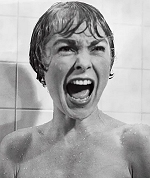
'Everyone, I think remembers that Janet Leigh gets stabbed in the shower by Anthony Perkins. She would not do a nude scene, she had a "no nudity" clause. So they had to get a body double. And so they hired Marli Renfro, who was an actress and a nude model. And because it was not Janet Leigh, Hitchcock had to shoot it in such a way that you couldn't tell who was actually in the shower'. [1]Did you know that the shower scene itself lasts a mere 45 seconds but it took seven days to film, and involves 78 different shots or camera setups and 52 editing cuts? Discussing this scene in the documentary '78/52: Hitchcock's Shower Scene' (2017), director Richard Stanley noted that, 'Generally these days, you're lucky if you get one day to kill someone'. So why did it take so long? All this effort was to both hide the fact that a body double was used for the nude scene (a nude scene that really didn't show any nudity) and to create a scene (at least for the time) of terrifying violence (that again didn't actually show any graphic violence!) To us it seems quite ridiculous to have even hired another actress as a nude body double since they had no intention of showing any nudity on-screen. In various interviews years later, Janet Leigh's body double Marli Renfro said, 'I was a nudist, so I was very comfortable being without clothes', but added that, I was not quite completely nude. I had what we called a crotch patch. During filming with the shower going and everything it would come loose. I told Hitchcock, I said "Why don't we take this thing off?" And he says, "No. No".' [13]So the wearing of a rubberised cover over the pubic region was already in use in the late 1950s, what are now called modesty patches, although we suspect their purpose back then was only to hide the genitals from the camera (and the censor), to prevent accidental exposure on-screen, not to protect the modesty of the actress. After all, when Marli went to film the nude scene she said she discovered that the studio had suddenly installed bleachers on the supposedly "Closed Set". You're not thinking of the actress nor her modesty when you invite a male audience to watch her perform naked. In another interview with Marli Renfro it was revealed that, 'While she was comfortable with nudity, the film censors were not. "At the time, the censors would not allow a belly button to be shown. In all of those beach party movies from the '50s, if they wore bikinis they had to cover their bellybuttons," she says. Hitchcock managed to get a shot of Renfro's navel passed by the censors "because it was so fast with quick cuts," she explains'.We're guessing that for Janet Leigh even the risk of accidentally exposing her belly button was unthinkable and scandalous.
A typical modern nude scene involving a cut to a body double (wearing a merkin/pubic wig) was in the movie 'Waiting...' (2005), a comedy starring, among others, Ryan Reynolds and Anna Faris. To shock her coworkers, Alanna Ubach's character jumps up and lifts her skirt, revealing that she is not wearing any underwear. In the images below, the first image (top left) shows Alanna as she prepares to jump up, and a brief accidental glimpse of white under her skirt reveals that she is in fact wearing panties (as the middle two images clearly show). However moviegoers never get to see those two middle images, we never get to see the scene as it was actually shot, where the behind-the-scenes footage shows Alanna merely pretending to flash her coworkers. The top two images and the bottom two images are all moviegoers actually see. Knowing that she was only going to be filmed from the waist up in the actual scene as it would appear in the movie, Alanna puts her hand down her skirt and pretends she has a gun hidden under there, clearly trying to shock her fellow actors into delivering an appropriate response, without actually getting naked. Then a body double was filmed standing in the same spot wearing a merkin, and just as Alanna was only shot from the waist up, the body double was only shot from the waist down. These shots of Alanna and the body double were then merged. Note that in the first image actor Anna Faris is to the right of Alanna, but in the image below that Anna is gone and we see the film crew instead, then in the image below that we again see a shocked Anna looking up at Alanna (actually her body double), who according to that angle has her legs spread apart, but when we are shown what Anna is looking at, her legs are together! For those that might argue that the middle two images are only a rehearsal and Alanna might still have been naked for the final shot, if that had happened then the scene as seen in the movie would mirror the middle images, meaning Alanna's full body would have been in shot and she wouldn't have been wearing panties. It's like when people think that it's a little suspicious that Clark Kent and Superman are never seen together in the same room, and in a twist to that logic, we think it's equally suspicious that Alanna's face and her bush are apparently in the same room but still not seen together, we only see one or the other. Plus Alanna has said they used a body double and fake pubic hair, so there's that.
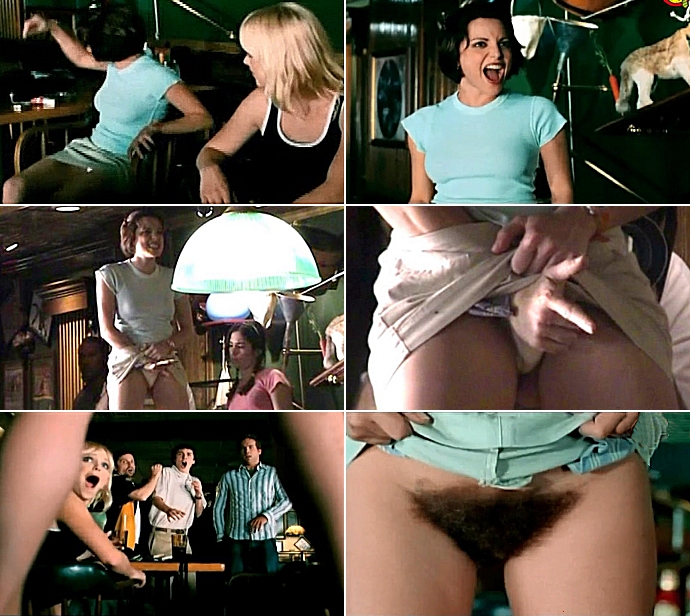
OK, so that scene was designed to create revulsion in both her coworkers and the viewers by revealing a woman that still has pubic hair, and they were more focused on shock value and laughs than hiding the fact that a body double was used, whereas in more serious movies the directors usually put more effort into hiding the cut to the body double. And speaking of pubic hair. That's right, these days even something as natural, simple and ubiquitous as pubic hair is usually faked, and is now manufactured in a back room as a special effect. We can understand why a special effects team is needed to produce the appearance of gunshot wounds, vampire teeth, pointy alien ears and rotting skin on corpses, but seriously ... pubic hair?! There's actually a cheap, simple and very natural way of producing surprisingly realistic looking pubic hair, but apparently knowledge of this method was lost to Hollywood sometime back in the 1980s. So, to repeat what we wrote near the very beginning of this essay several years ago, if you think you've seen some female pubic hair in a modern movie then it was almost certainly fake (they're called merkins, pubic wigs or fur bikinis), with a few actresses almost desperate to inform the media afterwards that it wasn't real, that moviegoers hadn't actually seen them naked. For example, Olivia Wilde's appearance in 'Vinyl' (2016) called for full-frontal nudity, as this screenshot shows:
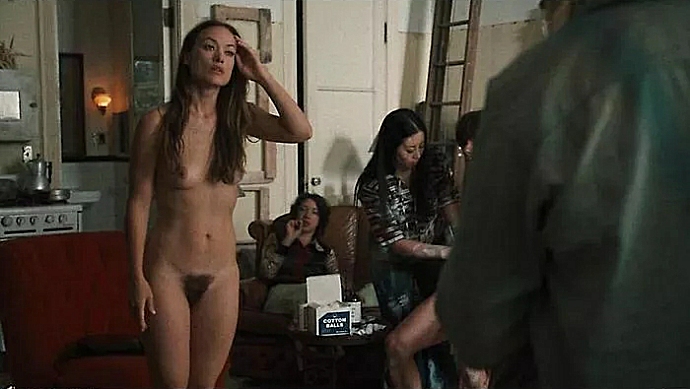
This was a TV series set in the 1970s, a time when most women had a full bush and didn't endlessly strive to be totally hairless to match men's weird, and frankly disturbing pedophile vision of how they expect women to look. To achieve this natural 1970s look, an apparently hairless Wilde worn a merkin, revealing in an interview that the show had a 'merkin wall for all the women on the show', and that 'she even had a hand in crafting her pubic wig, describing it as "Build-A-Bush".' Wilde later wrote on Twitter: 'Big thanks to my co-star, Molly Merkin, for working so closely with me ... couldn't have done it without you, girl'. So while Wilde thought wearing a merkin was 'great' in that 'It makes you feel a little less naked', explaining that it's like 'you're wearing a little fur bikini', she was still quite embarrassed while on set, but not because of the nudity per se, stating that, 'I was so vocal about it being fake, because I was horrified that background actors might think this was actually my real body hair'. Yes, Zeus forbid that men should discover that women have body hair. The world is not yet ready for that shockingly and shameful secret to be revealed. But many of the merkins we see in movies — that we know are merkins — are not always front and centre like that worn by Olivia Wilde. And just as Olivia felt very self-conscious wearing hers, an equally embarrassed Jennifer Connelly said that in the movie 'American Pastoral' (2016) 'there's a scene where I'm naked and dancing around freely', and since the movie takes place in the 1960s, she was required to wear 'an enormous wig on my crotch, which was so embarrassing'. So embarrassed was she of this 'fake' pubic hair that Connelly actually tried to convince make-up artist Judy Chin to make the merkin much smaller, arguing that it needed to go 'down to a size that I feel like I can actually go stand in front of people [on set] with this thing on'. If you're curious to see just how outlandish this merkin was (we were), below left is Judy Chin displaying the merkin next to two screenshots of Connelly and her merkin as they appeared in the movie.
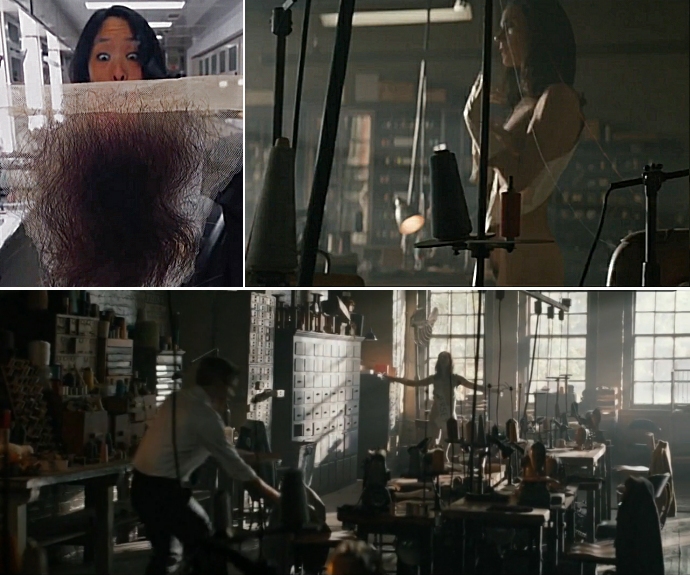
The top right image is the only frame in the movie where even a hint of pubic hair ... sorry, merkin ... can be seen, and the bottom full-frontal image is so distant and deliberately washed out that you can't even tell if it's Jennifer Connelly, let alone if she is naked. We were going to add a red arrow to indicate where Connelly actually was in that bottom cluttered screenshot, but then thought that if you have to search just to find her body, it might help you comprehend our criticism of the scene. Seriously, why go to all that bother and expense and then shoot the scene in such a way that it makes the nudity almost invisible? That merkin was a waste of time and money. It's just Hollywood attracting ticket sales by saying they still have nudity in movies, and while it may be technically true, blink and you'll miss it. The audience will be going ... Wait ... what ... that was the nudity they promised? Here's another example of blink and you'll miss it. According to an article in Vulture, a question the Coen brothers grappled with on the set of their movie 'A Serious Man' (2009) starring Amy Landecker, was 'How can a filmmaker re-create authentic sixties-era full-frontal nudity while shooting in the age of bikini waxing?' Willing to try growing real pubic hair, Amy Landecker stopped waxing but soon realised that 'It's not going to grow back in. I'll never have seventies bush'. That meant the services of a merkin were required, which Amy came to call 'Cousin Itt' (in reference to a very hairy male member of 'The Addams Family' TV series.) Amy said, 'I put it on, and it was like I had the world's largest bush'. She said her primary fear was 'That her high-school boyfriend would see it and think, Why doesn't she clip that thing?' We know what you're thinking, 'that thing' really must be huge, well beyond what nature could produce, even in the wild untamed 1960s and '70s. So we went and had a look and here's a screenshot of the only time Amy's merkin appears on screen (look closely, it's there):
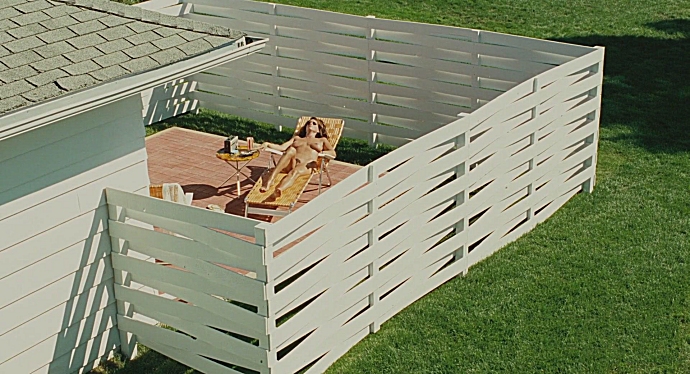
Seriously, 'that thing' that you can barely see, what Amy described as 'the world's largest bush', is a non-event, it's strange that she would even mention it in interviews since it plays such a minor, minor role in the movie. Speaking as a woman not used to seeing any pubic hair, no doubt her fake bush looked much bigger to her and the film crew compared to what the moviegoer sees, but even then to call it 'the world's largest bush' suggests that Amy has been waxing almost forever and has At a New York press event Evan Rachel Wood revealed that she wore a merkin in the TV historical drama series 'Mildred Pierce' (2011), starring alongside Kate Winslet. Unsure whether she would go fully nude in an upcoming scene, both Kate Winslet and Todd Haynes, the series' writer and director, encouraged her to do the nude scene, with Kate saying, 'Put a merkin on and you'll be fine'. So not actually fully nude then, or as one movie critic noted, 'Apparently, she's not a method actor', since "method acting dives into the essence of realism", and faking the nudity is hardly realism. Wood explained that, 'Let's just say, I had to wear a wig because it was in the '30s, and everything had to look like it was in the '30s'. So again we looked and here's a screenshot of that merkin in all it's hairy glory:
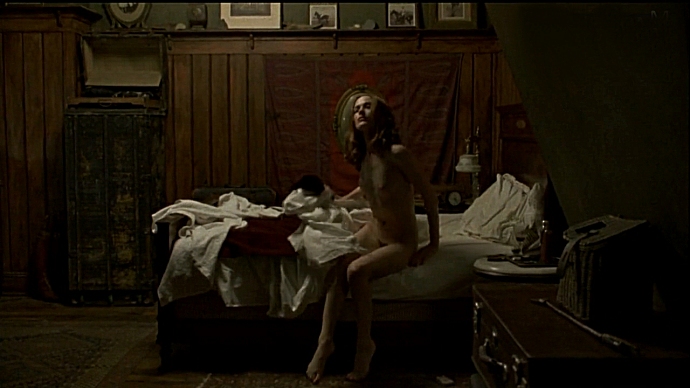
Again we're going... WTF ... are you kidding me? How many moviegoers would have even noticed the pubic hair, let alone could tell if it was real or fake, that is, if Evan Rachel Wood was actually naked or merely topless? Even though she gets out of bed and walks across the room, that fraction of a second glimpse is all one sees, her body is quickly positioned to hide that expensive merkin. As shown in the next screenshot, even when she sits down at a mirror she adopts a quite unnatural pose, raising her leg with her foot pointed like a ballerina, obviously to hide another glimpse of body hair, of fake body hair.
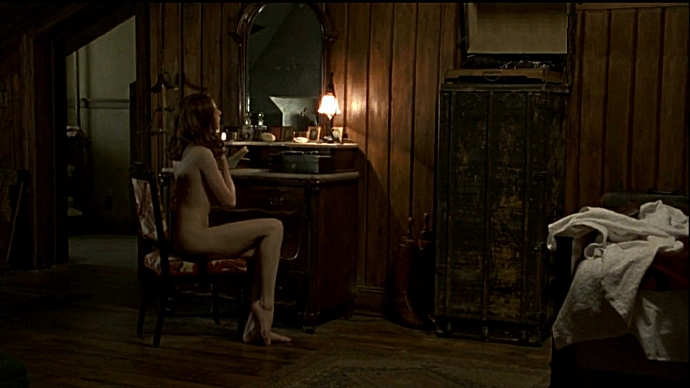
When discussing 'The Girl With the Dragon Tattoo' (2011), Rooney Mara pointed out that a merkin helps preserve a veneer of privacy, saying that: 'I had to wear a merkin… they didn't ask me to but I'm naked so much in it I wanted one, 'cause it felt like a little fur bikini… it was really cute, it was a cute little fur bikini and I had them make it strawberry blonde'.
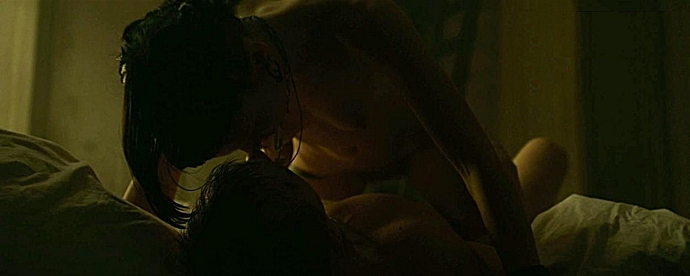
The above screenshot displays the only glimpse of Rooney Mara's 'really cute ... strawberry blonde ... fur bikini'. Can you tell it's strawberry blonde, can you even tell it's there? No doubt actresses do feel more comfortable wearing their 'little fur bikini' since they can spend hours on set filming these scenes under bright lights and surrounded by a large film crew. But again there is obviously a huge difference in what a film crew will see over the course of a day and what the moviegoer sees for a few seconds. It appears that in many movies the merkin is often more about hiding nudity from the film crew than the audience, since the movie simply hides nudity by using low lighting, carefully chosen angles and heavy editing, making the merkin almost superfluous as regards what the moviegoer sees. But of course not all movies hide the merkins they put so much time into making and then gluing onto freshly waxed genitals, like the already mentioned merkin of Olivia Wilde. Our next example is in that vein in that we actually do see a merkin, albeit in a dim light. It's worn by Christina Ricci in the TV historical drama series 'Z: The Beginning of Everything' (2015). Christina played Zelda Sayre who married author Scott Fitzgerald in 1920, and the following screenshot is from a scene set in their honeymoon suite. It shows Zelda trying to tempt her new husband away from a party by appearing naked at the door (although there is no evidence that the real Zelda did this; remember that Hollywood isn't interested in what did happen, but only in what would look great on-screen). Asked if the pubic hair was real or a merkin, Christina affirmed it was a merkin, 'Oh yes, I don't think I'm capable of that. After 20 years of waxing, I don't think I can grow that much hair ... it ended up being too big and I wanted them to digitally reduce it, but I guess they didn't do as much because I've heard from people that it remains extremely large ... it was really big when they put it on me. I was like "I think this is too big guys".'
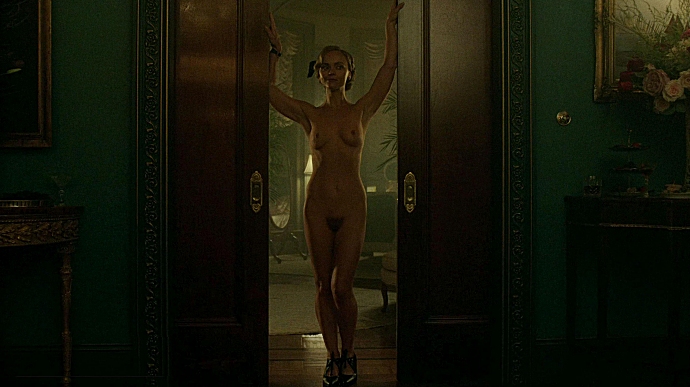
Christina Ricci complained that the merkin was unrealistic, being 'really big ... too big ... extremely large', and even the female journalist interviewing her agreed, saying, 'It's pretty large'. What absolute nonsense, it looks normal, if anything we'd say it was too small and artificial looking, like it was stuck on. Oh wait, it was. Like Olivia Wilde, Jennifer Connelly and Amy Landecker (and millions of other women), clearly Christina Ricci is living in a fantasy world created by Hollywood, the beauty industry and pornography, where all women have somehow evolved into hairless Barbie dolls, and even a wisp of hair is seen as too much and totally unfeminine. Zelda was a woman living in 1920, not 2020, when women didn't even trim their bikini line, since bikinis didn't exist (and it would have been considered highly offensive to wear anything as revealing as a bikini in public even if they did). Consider again the above image and Christina Ricci's view that the merkin she wore was excessive, bigger than real life, even for a woman in 1920, and then look at the following genuine photos from around that era. We don't think her merkin was too big, rather it wasn't big enough. And while they didn't have colour film back then, they apparently had better lighting than what Hollywood now has access to.
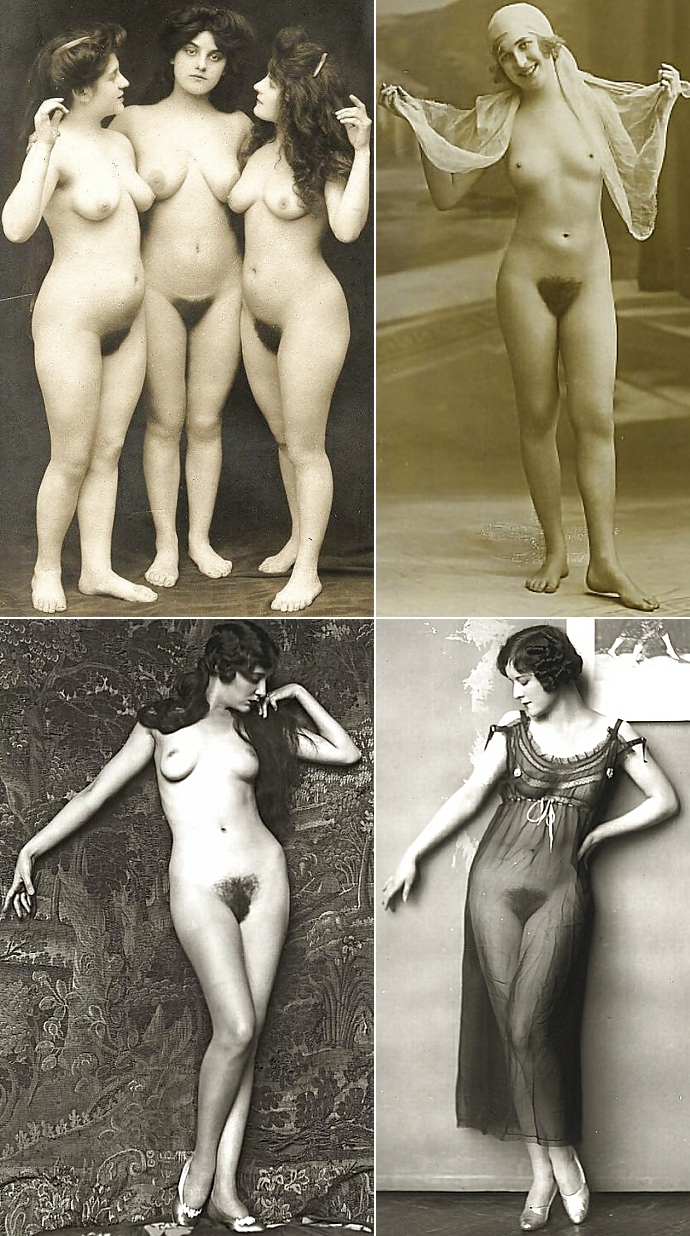
We're just amazed at the number of women today that are quite ignorant of what natural pubic hair on a woman looks like. The ignorance and intolerance displayed by men concerning female body hair is bad enough, but for women to be so naive concerning their own bodies is almost unbelievable. We recently watched the comedy 'Drive-Away Dolls' (2023) starring Margaret Qualley and Geraldine Viswanathan, where the only full-frontal nudity was the following screenshot (actress Savanna Ziegler):
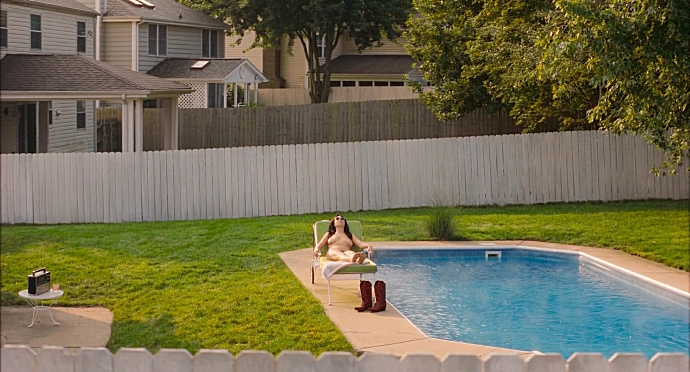
Set in 1999 before the waxing craze really took hold, it appears to show the barest glimpse of pubic hair (we know she is not simply wearing dark bikini bottoms because we are given a closer view of her getting out of the pool naked, but that scene is very careful not to show her front on, unlike the distant one on the sun lounger). Is it real pubic hair or a merkin? Most probably it will be a merkin, lovingly crafted and attached at some expense, a fur bikini to help the actress feel more relaxed during the filming. But who knows, real or fake? It will be a mystery for the ages. Emmy-winning makeup artist Nicki Ledermann has also observed that 'For some actors, a merkin is a safety blanket'. Eva Husson, director of 'Mothering Sunday' (2011), said in an interview that in addition to the movie's 1920s setting calling for a merkin, its female star Odessa Young 'wanted a merkin ... because that made her feel that she was really wearing a costume'. Of course making a realistic looking merkin for period dramas, ie movies or TV shows set before the 21st century, is apparently not easy nor cheap, so on the flip side one would assume filming naked women in movies set in modern times or the future is now a breeze. Decades ago, as we've said, to achieve realism Hollywood simply filmed real naked people, pubic hair and all. It was quick, simple and cheap as there was no need for special effects. Back then society thought that even women in the imagined distant future would naturally have pubic hair, so no matter the era the movie was set in — past, present or future — in order to look like the naked characters they were portraying on-screen actresses simply had to take their clothes off. No need for merkins since the actresses already had the real thing. This was unintentionally demonstrated in the 1966 movie 'Blow-Up', only worthy of mention now for apparently being the first first mainstream feature film to show female pubic hair, albeit fleetingly and quite accidentally. One imagines it only got past the censors because either they didn't notice it, or they thought the audience wouldn't. But it seems many moviegoers did notice, and as one 15-year-old boy said when he saw it in 1966, 'So girls had pubic hair too, who knew!' But that was then. Now, in apparently more civilised times, they don't. So today when the modern characters portrayed on-screen are "naturally" smooth and hairless to match 21st century norms, and when actresses like Olivia Wilde, Christina Ricci and Amy Landecker are likewise smooth and hairless, one would think Hollywood could easily repeat that process, simply have the actress take her clothes off and they're ready to go. Again, no need to muck around with the appearance of her vulva since the actress already has the real thing — hairless genitals — as smooth as a baby's, or at least a ten-year-old girl. But alas, there is still a problem. Even though (the way Hollywood shoots nude scenes) there is largely nothing to see but bare skin, actresses are now (paradoxically) quite unwilling to show what they've deliberately gone to considerable effort to expose by removing their pubic hair. Instead of asking for a 'fur bikini' they're now demanding a flesh-coloured covering that might be called a 'skin bikini', but is actually one type of modesty garment called a shibue (or a hibue for men), a strapless thong available in a range of skin tones that is stuck to the pelvis. From a special effects and makeup perspective a shibue is possibly more expensive and difficult to produce and fit than a merkin. Merkins are meant to be noticed by the viewer, and the fake hair will hide the edges of the merkin, whereas these hairless modesty patches need to blend into the skin and remain hidden from sight, a far more difficult endeavour for the special effects crew. Seamus McGarvey, the cinematographer of 'Fifty Shades of Grey' (2015), revealed that 'not every part of Dakota Johnson in the film was entirely real', stating that she 'had a specially designed piece over her nether region', explaining that, 'Dakota had kind of a patch that went over her pubic area, and right round her whole body. We were in the curious situation, in post-production, of adding [pubic hair]'. And yes, you read that right, even though Dakota wore a 'modesty patch' that showed her as smooth as a Barbie doll in the genital region, they then used CGI to add a wisp of pubic hair (it's unclear why as the movie was set in 2011, but maybe the pubic hair was needed as the smooth Barbie look of the patch just appeared too fake). McGarvey revealed that they also had 'a butt double for Dakota' and that her co-star Jamie Dornan had a 'cover over his penis'. In addition to the ones we've already mentioned, media interviews have revealed that Gina Gershon wore a merkin in 'Killer Joe' (2011) and so too did Sugar Lyn Beard in 'Mike and Dave Need Wedding Dates' (2016), with Beard adding, 'and they made it bushier than I could have imagined, because they went in I think and digitally added even more'. Heidi Klum wore a pink heart-shaped one in 'Blow Dry' (2001), and Jake Gyllenhaal has said both he and Anne Hathaway sported merkins in 'Love & Other Drugs' (2010), although maybe Jake is referring to a modesty pouch he likely worn rather than an actual merkin (or maybe he had both). Merkins were also wore by Kim Cattrall in 'Sex and the City' (2004), Malin Akerman in 'The Heartbreak Kid' (2007), Olivia Alaina May in '18-Year-Old Virgin' (2009), Patricia Arquette in 'Human Nature' (2001), Jamie Neumann in 'The Deuce' (2017), and an uncredited actress playing a prostitute in the 'The Bank Job' (2008). Also actress and writer Guinevere Turner has said, 'I have done movies where you do allegedly see my pubic hair but what in fact, it's actually a little tiny flesh-coloured g-string with fake pubic hair on it. It's called a merkin, you know it's like a little fake wig, and I have to say I always thought, "This is getting a little abstract". Like what's more embarrassing, seeing what I actually have or seeing me wear this? I mean, you know, whose hair is this anyway?' [3]Christien Tinsley, a makeup artist on the TV series 'Westworld' (2016), revealed the following regarding the show's merkins: 'We made hundreds of these for 'Westworld'. In fact a small army of artists would begin making these by the dozens daily after we got through the early morning makeup call. I don't know the exact number but I would say around 500 more or less. That's a lot of nude people needing a lot of hair!!'That's also a lot of time and expense to provide something that used to come naturally, for free. Although Thandie Newton, one of the (more sensible) stars of the show, has said that: 'I didn't need the merkin because I don't alter anything. Full '70s bush! ... I also said no because it's another 45 minutes to get that thing glued on, and I wanted to go home to my 2-year-old. I didn't want to spend time doing that'.Yet all the other actors spent time and money waxing or shaving off their own pubic hair just so fake pubic hair could be glued back on by a stranger. Clearly evolution isn't making everyone smarter. In an interview actor Margot Robbie was asked, 'When you've got a period piece, I've heard that a lot of the time it's actually quite hard to find women with real breasts and pubic hair', with Robbie saying she, 'became familiar with the use of merkins after her work on 'The Wolf of Wall Street', where she came face-to-face with an 'entire merkin room'. She recalled: There was a whole room full of merkins. I guess people would go in and pick out... I'm not gonna go into detail, but it was fascinating and a little known fact about the filmmaking industry'.Well, a fact about the '21st century' filmmaking industry perhaps, a few decades ago the industry had no need of a merkin room. Actresses had the real thing, and better still, it was natural, totally realistic and evolution-approved. While we're at it, we should note that some oft-repeated accounts of actresses wearing a merkin are actually false, eg Kate Winslet in 'The Reader' and Sasha Grey in 'Entourage' (which once again reinforces how much misinformation there is on the Internet). That said, most apparent sightings of pubic hair in contemporary movies will likely be a merkin, even though this is usually not divulged, simply because directors, actors and special effects professionals would rather not reveal their secrets, believing that the best illusion is one where the audience never realises they were fooled. And when it comes to nudity, many moviegoers really do want to believe they saw their favourite actor naked. But it's not just pubic hair that has disappeared into the mists of time, like stagecoaches and dinosaurs, and now needs to be faked in movies. Even things that are still omnipresent, that actors and actresses both still bring with them to set, are now often faked in movies. In the movie 'The Change-Up' (2011), both Leslie Mann and Olivia Wilde appear topless, but in later interviews Leslie Mann admitted that her exposed breasts were not real, and were actually created with an enhanced prosthetic and CGI, and that she also employed a body double for a close-up shot of her ass. Olivia Wilde revealed that she wore pasties (nipple covers) on set which were supposed to have been hidden by careful editing, but a mistake meant they weren't, meaning that the pasties had to be later replaced with CGI nipples, with Wilde stating that, 'I wasn't actually naked but now appear to be naked because [the producers added] nipples using CGI'.As we've already noted, it's very weird that many Americans believe that women are not topless, not even slightly naked, as long as their nipples are covered! For example, look at the following 'behind-the-scenes' image of Megan Fox on the set of 'Jennifer's Body' (2009) during the filming of a supposedly nude swimming scene. (You may remember Megan Fox from our list of actors who say they will never do on-screen nudity.) To shoot the scene Fox wore flesh-coloured nipple covers and briefs and obviously didn't think any of her 'private parts' were even slightly visible. Many people outside America would disagree. The two screenshots under that image reveal how much of Fox's body was shown in the actual movie, suggesting that Fox had no need to be topless, but then she apparently didn't think she was.

Of course we're not criticising Fox for being partially naked, it was (almost) the easiest way to shoot that scene, we just don't understand why she didn't mind a film crew of strangers seeing that view of her body in real life and yet is terrified that someone on the Internet might see a still photo. And we don't understand this American belief that you can stick some nipple covers on bare breasts and that immediately shifts a woman from having the look of a dirty, sleazy whore to a prim and proper lady dressed ready for church. But that's how it works in America, you can expose the breasts, just cover the nipples with ... something ... tape, pasties, CGI nipples or a shotgun held at the right angle.

And of course when naked men are shown on-screen, it is now, unlike the past, usually through the use of prosthetics, such as Mark Wahlberg's large prosthetic penis in 'Boogie Nights' (1997) and the many penises in the comedy TV series Minx' (2022). During an appearance on Jimmy Kimmel Live!', Jacob Elordi, one of the stars of the TV drama 'Euphoria' (2019), was asked about the use of 'stunt penises', and he revealed that 'the Euphoria production crew actually has a whole collection of prosthetic members for the actors. "When you come into the makeup trailer, [the fake penises] are all kinda set up".' It's also been revealed that Steve Zahn in 'The White Lotus' (2021) and Adam Demos in 'Sex/Life' (2021) both wore a prosthetic penis in their TV dramas. And it's not just the men that appear on-screen wearing fake genitals. The movie 'Blue Is the Warmest Color'(2013) featured a sex scene between two lesbians played by Léa Seydoux and Adele Exarchopoulos which appeared to show graphic nudity, with not a merkin in sight. But appearances can be deceptive, remember this is an industry built on actors pretending to be someone else, meaning the movie made use of prosthetics in the form of fake genitals. As Seydoux said, 'We had fake pussies on. You have something to protect and tape it under. I don't make love on-screen. We can fake these things'. Even a woman's pregnant body is usually faked in movies (although this is to be expected, actresses are unlikely to be pregnant while filming), and in the three images below, not only is the belly a fake prosthetic, but so too are the breasts, and they are very realistic (ignore the strange nipples, that's Facebook censorship, the rest of the breast is fine, it's just those disgusting nipples Facebook has a problem with!)

Special effects makeup artists created prosthetic breasts for Jennifer Morrison in the comedy 'Big Stan' (2007), and the FX studios provided the following photo of the progression from start to the finished effect, and it's hard not to be impressed with the realism:

When Lea Thompson finished filming of the sci-fi comedy movie 'Back to the Future Part II' (1989), she left with an intimate souvenir, her prosthetic breasts. And when Sigourney Weaver was approached to play a crew member on the sci-fi comedy movie 'Galaxy Quest' (1999), she had a request: 'The first thing I said to Dean [the director] was that Lieutenant Tawny Madison had to be blonde, and she had to have big boobs'. This necessitated not only a fake blonde wig but also large prosthetic breasts, both which Weaver apparently also kept after filming as souvenirs. I never noticed that either actress was wearing prosthetic breasts, although in hindsight I should have noticed Weaver's. It wasn't until 20 years later when I got the chance to re-watch 'Galaxy Quest' that I said — Wait a minute ... Sigourney Weaver doesn't have big boobs! — and I realised something wasn't right. They had to be fake, either breast implants or prosthetic breasts. And yet they looked so real. A little online research soon revealed the answer, prosthetic breasts, and the realisation that I had been fooled. And that was back in the '90s. Advanced prosthetics coupled with sophisticated CGI means, now more than ever, that you can't always believe what you see on-screen, no matter how real it looks. Not real aliens, not real zombies and not real nudity. As an example of how CGI can now fool the viewer, the script for the movie 'Machete' (2010) called for actress Jessica Alba's character to have a (utterly gratuitous) nude shower scene, but since Alba had a "no-nudity" clause in all her movie contracts they filmed the scene with Alba in her underwear, and then the special effects team digitally removed her underwear afterwards to create the appearance of nudity. And even though Alba has said that 'she doesn't do nude scenes for familial reasons', she surprisingly had no problem with the movie appearing to show her doing just that, a nude scene. As one person noted in an Internet blog post, 'This is really a great time actresses live in — they can now do nude scenes without actually doing nude scenes'. The following image shows before and after screenshots, and if you look closely, critics have noted that during the editing stages her 'tummy was flattened a little and her butt lifted'. As sexy and attractive as Jessica Alba clearly is, Hollywood still felt the need to "improve" her body. And real women wonder why they don't look like the women on-screen!
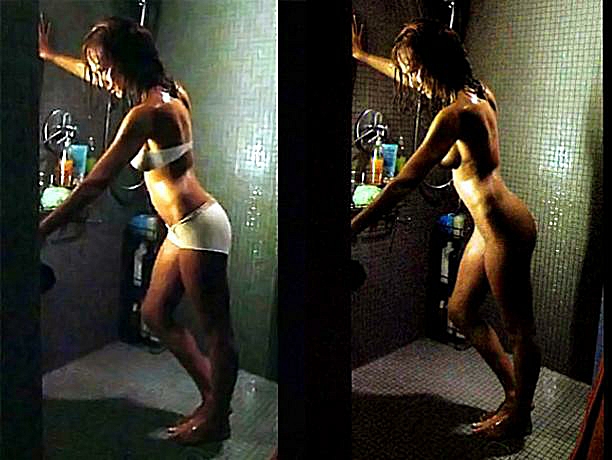
In the movie the shower scene actually showed the actress standing quite still, so they were essentially editing a static image rather than a moving and constantly changing image like in normal video. So a more impressive example of digital editing is a scene from the TV series 'Game of Thrones' (2015) when Lena Headey's character Cersei Lannister (below) is shamed and punished by being forced to walk naked through a jeering, abusive and hostile crowd. The technical magic involved filming a real naked body double (actress Rebecca Van Cleave wearing a merkin) and then filming a clothed Lena Headey doing the same walk, a "simple" naked stroll that apparently cost around $US200,000 (even before the post-production editing) and took three days to shoot (or two or four days depending on which account you read), with the two takes then merged in post-production to create the illusion of a naked Headey, her head on the nude body double. As we've mentioned, in an Entertainment Weekly interview it was revealed that, 'More than 1,000 actresses applied for the role of Headey's double', so clearly many actresses are not as prudish as society would like them to be.
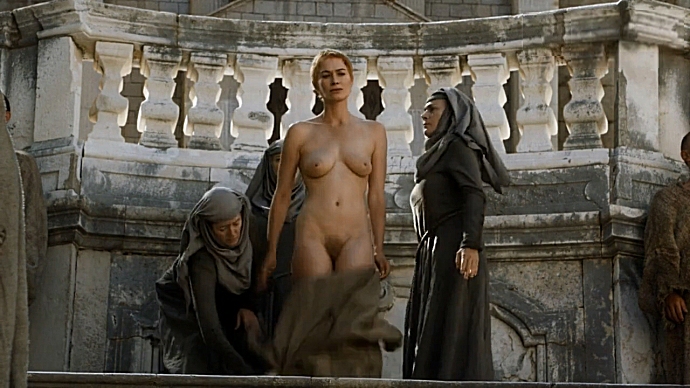
Removing some underwear or changing a body's appearance with photo-editing software is not too difficult if it's just a single, still image. Look at the following image where the studio "digitally enhanced" Keira Knightley's breasts for the movie poster of 'King Arthur' (2004). The centre image is the original photo (as she appears in the movie), the one on the right the enhanced version that appears on the poster.

However putting a fake head onto another body in a realistic video, where the head and body move seamlessly as one, is something else entirely. Clearly the old adage that 'the camera never lies' is long dead, and with the growth in computing power, editing software and artificial intelligence (AI) it could soon be quite impossible to tell real video from fake. Increasingly convincing videos that are called 'Deep Fakes' are already being created and distributed on the Internet. In fact actors are worried that in the future Hollywood will use advanced AI to create virtual reality (VR) images of their likeness, meaning real actors will be superfluous. It won't just be CGI nipples and pubic hair, the entire body (with the likeness of whatever actor you want, dead or alive), plus the sky above and the ground they appear to walk on will all be digitally created in a computer. It will be a lot like how cartoons are created, only in these movies the characters and their world will appear to be utterly real, but will still be as fake as Mickey Mouse and Homer Simpson. While this sounds like science fiction, in a limited sense this has already happened, with AI, VR and CGI being used to complete scenes with actors who unfortunately died before filming was completed. Their final movie scenes, as real as they appear on screen, never actually happened. Maybe in the distant future Hollywood will exist solely within a computer lab, and actors, camera crew, special effects teams, stunt and body doubles, makeup personnel, even scriptwriters and directors, will be out of a job, with entire movies generated by AI within the digital world. OK, so we're not at that stage yet thankfully, but again, if you think you saw a vulva in a recent movie (what ignorant folk call a vagina), shaved or hairy, you probably didn't, it was likely fake, ditto with a penis. Even women's breasts seen in movies these days are sometimes fake, either prosthetics, CGI or a body double, but more often than not fake breasts resulting from breast implants; cosmetic surgery that the actress has undergone in real life. Hollywood may not have faked the implants, but they're still fake, you're still looking at fake boobs, not a real topless woman. Her breasts are as fake as the bullet wounds and the Jedi lightsabers. Surprisingly, back in 2010 when casting for their latest 'Pirates of the Caribbean' movie, Disney made a stand on fake boobs: 'The New York Post is reporting that Disney has specifically requested that no actresses with breast implants apply for a role, and that the company will even ask actresses to jog in front of casting directors to prove that their breasts are real. The casting notice allegedly requests: "Beautiful female fit models. Must be 5ft 7in-5ft 8in, size 4 or 6, no bigger or smaller. Age 18-25. Must have a lean dancer body. Must have real breasts. Do not submit if you have implants".'As entertaining as they are, considering the significant scientific and historical inaccuracies in the 'Pirates of the Caribbean' movies, it's really quite strange that Disney suddenly felt they must be authentic regarding women's breasts, especially since there is no nudity in the movies, and also some women back in the 1700s (just like today) did have large natural breasts. Being Disney, a very family-friendly and sex-and-nudity-adverse studio, perhaps they just felt that big fake boobs, even ones covered up, were not something children should be exposed to. Although that said, it's reported that regarding the earlier 'Pirates of the Caribbean' movies, 'star Keira Knightley has said in the past that makeup artists spent up to 45 minutes painting her cleavage on, adding shade and volume', so that's Disney deliberately faking the appearance of her breasts to drawn attention to them. Again, it's no wonder that so many people, especially young women, are deeply unhappy with the appearance of their own bodies when Hollywood is continually putting unobtainable fantasy bodies on-screen as comparisons. As was noted on an Internet blog post, '[Hollywood's] use of CGI to make their naughty bits look extremely close to the real deal [...] could turn out to be a terrible thing for normal women — if actresses like Olivia Wilde start using CGI to enhance their bodies in movies, they'll help to create a level of perfection that's impossible to achieve, and women will continue to compare themselves to the digitally improved stars.'So, to return to our original query, would actors refusing to do nude scenes see the end of movie nudity? Clearly it wouldn't as Hollywood is already producing nude scenes where no one got naked, and often no one in the audience is any the wiser. As we've said, we'd prefer that movies showed real nudity rather than fake nudity, since fake nudity (as Hollywood and the porn industry does it) creates societal problems around body image and body positivity. When Hollywood creates fake naked bodies to stand in for the actors' real bodies, they obviously don't just make xerox copies of the actor's actual body, if they did then they might as well just show the real body. They instead make an idealised version of the movie character's body, of how the script says the character would look naked. Any flaws the actor feels their real body might have are obviously not copied over to the movie character's naked body. Actors that use body doubles in nude scenes are often allowed to help select the anonymous actor that will play the part of their breasts, ass etc., even their nipples, and they naturally all choose the most sexy and gorgeous body available, giving themselves the appearance of having bigger and more attractive breasts, smoother skin, a slimmer waist, hairless skin, sexier nipples and ass, or a more manly sized penis. And if CGI or prosthetics are used instead (Olivia Wilde got to select her preferred CGI nipples), again their character is often given the body of a Greek god or goddess, given a body fit for a hero or heroine, since viewers expect James Bond and Wonder Woman to have bodies that make us all envious. Of course most of us know we will never possess the amazing skills or powers that the likes of James Bond or Wonder Woman display on-screen, but their bodies are a different matter. When these movie characters strip down their bodies bear a passing resemblance to our own, only much, much more attractive and sexier of course. So maybe if we went to the gym, went on a diet, underwent regular coffee enemas, and had some cosmetic surgeries performed, we too could have a naked body like the men and women in movies. But this is impossible, today's movies create idealised images of the body that are simply unattainable. Striving to have a naked body like James Bond or Wonder Woman is utterly futile, even the actors playing these characters acknowledge that screen magic makes them look the way they do in the movie. Hollywood already employs actors with the most naturally attractive bodies they can find, and if actresses start using CGI to enhance their bodies in movies — like Olivia Wilde, a woman that is already very beautiful by conventional norms — then this will turn out to be a terrible thing for real, normal women since this digital editing to erase perceived flaws and accentuate preferred body parts on already beautiful women (and men) will only help create a level of perfection that's impossible to achieve in real life. And yet women (and men) will still continue to compare themselves to these fantasy versions of digitally improved stars, and become depressed when they likely don't even come close. If you watch nude scenes in movies from the 1970s and '80s the men and women look real; the breasts, the skin, the muscles, the pubic hair, the way the bodies move all look real, wrinkles and all, because they were real, the actors weren't enhanced with prosthetics or CGI, but today they often are. You could see naked bodies in those older movies that looked like those you could expect to see in real life, if you were lucky, but you'll never see real naked bodies that resemble those in most of today's movies just as you'll never see zombies or aliens or superheroes, because they're all impossible fakes created for a movie. The trouble is that while moviegoers accept that zombies and such are just movie magic, they fool themselves into believing the naked bodies in movies are what real bodies look like (or at least what society expects their body should look like if they are to be accepted) — for women, big breasts, very slim, long legs, blonde hair, smooth skin, tanned, no body hair, invisible labia, the perfect nose etc etc, and for men, muscles ... everywhere, tall, smooth skin, no body hair, large penis, circumcised, athletic build etc etc — which sets them on a path to obtain the impossible, creating dissatisfaction, disappointment, depression and disillusionment with their natural body. Thank you Hollywood (and the fashion and cosmetic industries, which all feed off each other). Clearly Hollywood has no problem with faking nudity, and has been doing so since its inception, but the current reality is that the increased use of modern technology, everything from prosthetics and merkins to CGI and body doubles, means that movies can show nudity and sex scenes and viewers will not be able to tell the real body parts from the fake ones. And again, this is what the movie business is all about, producing realistic, believable entertainment, so just as they fake all their car chases and gun battles, along with their aliens, zombies and superheroes, so of course some directors will be tempted to fake their nude scenes if that's what's needed to complete their vision. And sure, while actors have to fake their bullet wounds, their nude scenes could, and indeed used to be real, but now we'll never know for sure. If today directors did begin to encounter reluctant actors and studio executives, then even though it's more difficult, expensive and time consuming, they will surely opt for fakery if that's what it takes to keep the scene in the movie. What all this means is that even if actors were to refuse to do nude scenes, and it simply became too problematic to convince them otherwise, directors would simply continue to do as they already are doing in some movies, faking the nudity. So nudity in movies, whether it's real or fake, isn't going to disappear. Nude scenes will continue, even if actors never again take their clothes off. So while realistic fake nudity is better than no nudity, we'd prefer that movies showed real nudity (with real diversity) since it would make viewers more accepting of their own body image as they'd be seeing bodies like they might see in real life or in the mirror, meaning they would be far more confident in their own appearance, and consequently happier, and be far less likely to embark on useless and harmful diets and fads or to undergo expensive and risky cosmetic surgeries. But before we finish, let's digress for a moment and state the obvious, that even though sex and nudity can improve an already great movie (at least it can for us), nobody actually watches movies just for the sex and nudity, that's what porn is for. Good mainstream movies have great stories, intelligent dialogue and amazing sets, but pathetic sex, whereas good porn movies have great sex but pathetic everything else. Wow, if only we could take the best of both, what a movie that would be! So while we're at it, talking about movie fakery, is the nudity and sex in porn movies any more real? Yes and no. Mostly yes, obviously, but sometimes no, sometimes they fake it too, since like the mainstream movie business they're simply turning out an entertainment product too. Porn actors generally have no problem exposing their bodies so the nudity is always real ... or is it? Pornographic movies started over a century ago when mainstream cinema arose, since of course one of the first things that people thought to film with their newfangled moving picture cameras was naked bodies ... having sex. So for most of porn's history the nudity was real, they had plenty of real naked bodies so they simply filmed them ... doing naughty things. There was no need to fake what was freely available, the breasts, vulvas, penises and pubic hair was all real. But in the last few decades many porn actors, mainly the women, began presenting with body enhancements, first with fake breasts, followed by expensive laser treatments to remove body hair, then labiaplasty to hide (naturally) protruding labia and other cosmetic surgery to remove cellulite, body fat, improve skin tone etc, even the infamous (and risky) BBL, the Brazilian Butt Lift. So in reality many of the bodies seen in modern porn aren't exactly real, in the sense that real female bodies don't have fake boobs, surgically trimmed labia and hairless vulvas. Nor do men all have huge penises, although admittedly a handful do, but certainly nowhere near as many as porn implies (and like women with naturally large breasts, large penises can often be more of a handicap than a bonus, with both men and women in the real world sometimes seeking surgical reductions). So while the big penises in porn are not fake, they are certainly misleading and are not representative of the real world. Most of the men and women in mainstream porn certainly project a fake image of what a typical naked body looks like, and how it performs, in the same way that real spies don't look (or act) like James Bond. Porn is providing a fantasy vision of sexual encounters for the purpose of entertainment. So the nudity in modern porn (in the productions that make the big bucks) can range from fake to very misleading, but what about the actual sex scenes? Clearly the sex is real (mostly) in that real penises are seen penetrating real vaginas and really ejaculating and real clitoris' are seen being licked. But, just like mainstream movies, porn directors sometimes use male body doubles (known in the business as 'stunt cocks') when the male actor can't perform on cue for a specific shot, and female body doubles when a female actor refuses to engage in a specific act. Sometimes the obligatory "money shot" is faked with a squirt of a white liquid, much of the writhing and moaning is faked (often badly) and/or dubbed in later and almost all of the female orgasms are faked. And just like mainstream movies, many apparently short scenes in porn can take a long time to shoot, with many takes to get the lighting right, to film from the best angles, to get the right responses from the actors etc. Many of the sexual positions adopted in porn are chosen simply because they give the audience the best closeup view of the action, ie of the genitals, certainly not because those positions are the most arousing, intimate or comfortable for the couple having sex. And in fact the real reason that female porn stars started removing their pubic hair in the mid-1990s was solely to allow new high definition cameras to provide a clearer picture of penetration, of the penis entering the vagina (in real-life sex neither the man nor the woman is looking down there, only the person viewing porn is, and for tens of thousands of years people managed to have sex just fine, even with pubic hair). Many male porn stars then started removing their pubic hair to try and make their penis look bigger, a visual trick that may have some small effect when viewed on-screen, but in the real world the scam is quickly seen to be false advertising since the penis is clearly still the same size, and more importantly, what a penis feels like is vastly more important than how big it appears to be when seen from a distance. However in porn movies appearance matters since viewers can only watch and not touch, so directors focus on visual cues, but in real life such visual tricks are immediately seen as fake, just like that old subterfuge of women stuffing their bras with tissues to give the appearance of larger breasts, which likewise only succeeds if the encounter never becomes "hands-on". A more worrying fact is that hairless genitals (on both men and women) give the appearance of a young child, not an adult, remembering that when men are occasionally seen naked in public, say in a pool changing room, their penis is flaccid like a child's, and the lack of pubic hair only reinforces that prepubescent look. Child pornography is rightly illegal, and people say the thought of it is far more vile than even adult porn, so we are utterly mystified why adults want their sexual partners to have genitals that resemble those of children — smooth and hairless, and of course this also extends to legs and armpits, and on men, hairless chests and backs. We can understand people having sexual fantasies involving women dressed like sexy nurses and men dressed as rugged firemen, but not why they get aroused by (and openly encourage everyone to have) a naked body that resembles that of a young child. There's a name for that — pedophilia. But regardless of what the practice has morphed into, porn stars started the trend, and since they were assumed to be the sex experts of the world and the only people the public ever saw having real sex, they became the role models of how we should look and perform, so women thought they should remove their pubic hair as well, and a new industry was born. Today women are slavishly removing their pubic hair quite unaware that the practice was originally just a trick to improve the visuals of porn videos. Porn directors are using many of the same tricks as Hollywood directors to make their scenes look as amazing as possible. Probably the most obvious way that many porn movie scenes are fake is the mirror opposite to the fake scenes in mainstream movies. Whereas mainstream movies consistently refuse to show nudity in situations where it would naturally be expected, porn movies consistently show nudity in situations where it would never be expected. Even when alone, women in Hollywood movies ensure they're well covered up before hopping out of bed or the shower, whereas naked women in porn movies never bother covering up before answering a knock at the door. Both scenes are equally unrealistic. In mainstream movies, when the hero approaches the most beautiful woman in the bar she is always single, is immediately smitten by his charms and they are next seen in bed (suitably covered) having sex, and in porn movies the beautiful woman, whether she's single or married, always insists on having sex (that certainly isn't hidden) with the pizza delivery guy or the pool cleaner or in fact any random stranger. And again, both scenes are equally unrealistic. And the sex itself can be called fake in the same sense that a Hollywood movie kiss can be called fake, where even though two actors do kiss, they are still acting, creating a fake scene in a fake movie story. The kiss may be real in that their lips touch, but it's fake in that the emotion that would normally be behind the kiss in real life will be missing from the movie kiss. The actors aren't in love, they're just going through the motions for the camera, and it's the same with the porn actors, although their genitals touch they're not having sex in a real world sense. Like the Hollywood kiss they're just following a script and the cues of the director. We wouldn't say a car chase featuring James Bond is real just because a real actor is driving a real car really fast through the real streets of Paris. Regardless of the real elements in the scene, we still say it's a fake action scene. Equally just because actors are touching real genitals it's still a fake scene following a script. But there is a far more insidious element of fakery going on in porn, and that is that the sex acts as portrayed in modern porn often bear little resemblance to real world sex. We're talking about the likes of rough sex, acts that are clearly focused only on the man's pleasure, the lack of consent, of any real intimacy, subtle (and often not so subtle) coercion, the refusal to use condoms and no acknowledgement of safe sex practices etc. Although there is some ethical porn being produced, much of contemporary porn is blatantly sexist towards women, who are seen as mere sexual playthings for men, utterly compliant and willing to do whatever is demanded, and made to suffer if they don't. The on-screen story lines often display coercive, abusive and physically violent sexual acts, not just to the female characters in the movie, but also towards the actresses forced to actually experience such rough sex. For many young men today brought up on modern porn, their fantasy encounter is choking a woman (preferably their sister) as they have rough anal sex with her (not vaginal sex, which makes us question their sexuality) and then making her gag by thrusting violently down her throat until they ejaculate. Not only is modern porn pushing a fantasy, it is pushing a dangerous fantasy, teaching young men that this is how real men have sex and this is how you act towards women, and how they want you to act. They are there for your pleasure, so use them. If they say no, they really mean yes. Just carry on with what you're doing, she'll come around. Young people think watching porn will teach them about sex and the naked body, and since parents, schools and the movies often refuse to broach the subject, where else might they go for help? Yet learning about sex from porn is like learning how to drive by watching all 'The Fast & the Furious' movies or learning how to be nice to your new immigrant neighbours by watching an ISIS recruitment video. Porn movies from the last century were often sexist, but they used natural bodies and rarely were they violent or abusive towards women, plus they weren't at all pervasive like today's easily accessed porn, meaning most people couldn't learn about sex from porn, even if they wanted to. And if they did see porn, they saw normal looking people having normal sex, almost like what you might see spying on real (good-looking) people having sex, not the fantasy bodies having fantasy sex as portrayed in today's popular porn. So in a real sense much of today's porn is indeed fake, it's misinformation, and this is not a good thing since it's misleading so many people. It's like the porn equivalent of fake news. OK, so now onto the final problem facing nudity in movies. (4) If the public is indeed becoming increasingly reluctant to watch movies with sex or nude scenes then that would be a major problem, since expensive movies with such scenes will fail miserably at the box office, followed by the studio if they keep making such movies. There is no doubt that some people don't want to watch movies with sex or nude scenes (just as some don't want to watch movies where a woman is the hero, or where the main characters are gay or they blaspheme God or Donald Trump, or movies with bloody Hobbits) but we don't believe Hollywood gives a fuck about any of them ... unless their group makes up a sizeable proportion of their income stream. Hollywood makes the sort of movies that will return them the most profit, that's all they care about. They are a business after all, not a charity. When I was a kid Westerns were all the rage, now they are as rare as hen's teeth. A while back we saw a fondness for vampires, which gave way to zombies, now it's superhero movies that are generating huge profits. While we've argued that nudity in movies is decreasing, we don't believe this is being driven by Hollywood not wanting to offend moviegoers, we believe this decrease in nude scenes is simply due to Hollywood preferring (as it always has) to make movies that will be viewed by the largest possible audience and therefore bring in the largest profit. Take the movie 'Barbie' (2023) for example, starring Margot Robbie and Ryan Gosling. By deliberately making it suitable viewing for child and adult alike they created a huge audience for the movie, and consequently a huge profit, having already passed $1 billion at the global box office not long after its release. Had it included any sex or nude scenes their profit would have been nowhere near as great. While Hollywood is indeed making fewer movies with nudity, this is not because they have a problem with filming nude scenes per se, it's simply because they have a problem with including any scene that might limit their take at the box office. In the past the promise of nudity would increase ticket sales, now with the easy availability of porn, it does not. Look at how careful they are these days not to insult the likes of China, which is now a huge market for them. They've found that action scenes increase their profits and nude scenes limit them, simply because Americans take the whole family to watch violence but leave all the kids (and their kid's ticket money) at home when a movie has a nude scene. To support our argument, consider 'Barbie's box office and Oscar awards competitor 'Oppenheimer' (2023). It has several sex and nude scenes, arguably all gratuitous, and they were surely there because the subject matter of the movie, America's creation and detonation of the atom bomb, meant that the movie couldn't realistically be targeted at children, so there would be no loss of ticket sales by having the nudity, and in fact the nudity might be the one thing that makes sitting through the long, confusing and boring movie worthwhile (IMHO). They even kept the nude scenes knowing that they would have to spend time and money editing the nudity out in order to market a censored version of the movie to certain counties, like India and some MIddle Eastern countries. Here's screenshots of actor Florence Pugh from the original and censored versions of the movie:

To repeat, the nudity had nothing to do with the story and could have been omitted (one sex scene was even historically false), plus it cost them extra to censor it for distribution to some markets, so clearly Hollywood will keep sex or nude scenes in movies if the nature of the script means it will only attract an adult audience, but will omit such scenes from movies that have the potential of being marketed to a wider age group, especially the youth market. As movie critic Matt Singer has noted regarding the movies that reach the theatres, 'Hollywood in general right now stays away from sexual adult issues, they avoid those topics, they make more safe things that are more wholesome that are PG-13 or PG, not even R, that appeal to the widest possible audience because that's the money they're interested in making. That attitude is in itself almost a form of censorship because it prevents those ideas that are certainly valuable and would be interesting from even making it past the stage where they're discussed'. [3]So it's not true that a nudity-adverse public (if they even exist in any real numbers) means that having nudity in films or television is becoming too problematic. Hollywood cares little about what the public wants, it is adding or deleting nudity from movies solely on the basis of their bottom line — which option will sell the most tickets? Hollywood will give the public the movies it can make the most money from, they're not concerned about whether seeing nudity or violence causes harm, in the same way that the tobacco, firearms and cosmetic industries don't care whether their products cause harm. Hollywood also knows that the pornography industry makes more per year than they do, so they are well aware that there is a huge, profitable market out there for sex and nudity, regardless of all the prudes, hypocrites and liars who say they want nothing to do with sex and nudity. While Hollywood is never going to compete with porn by providing explicit sex and nudity, they know there is a market for a soft version, and have known this since the cinema first began over a century ago. There will always be a sizeable segment of society that wants to see realism in their movies, which includes sex and nudity, not just violence, meaning it's a revenue stream that Hollywood won't simply give up. There may be many movies we'll never get to see because Hollywood can't figure out how to make them kid friendly, but some directors and actors are keen to show real-world adult realism, focusing on telling interesting stories rather than making huge profits. So in conclusion, having nudity in films or television is not in any real sense problematic, meaning there is no good reason to remove it. The problem of potential sexual abuse can be mitigated simply with good safety practices, like in any workplace. The technical problems in filming nude scenes are far less involved, costly and risky than those that are willingly overcome in action scenes, meaning if there is an argument for any scene to vanish, it should be the action scenes, not the nude scenes. Clearly that is not going to happen. There is also no problem with major or minor actors refusing to do nudes scenes. While some will decline, there will be plenty that will consent to on-screen nudity. And finally, while there are and always have been people that have a problem watching on-screen sex and nudity, Hollywood knows that there is still a very sizeable and profitable market that enjoys such scenes, and many directors and scriptwriters are committed to including such scenes. Clearly nudity in movies and television isn't going anywhere. It may be real or, increasingly, faked, but viewers usually won't be able to tell the difference, nor should they care (as long as it shows realism and diversity). They know and accept that pretty much everything they see on screen is fake, from the guns and zombies to the spaceships and the sex, so why should they be upset or feel cheated if the nudity is fake too? Do we have to say it again, Hollywood is an industry that exists solely to make entertaining stories about fake characters living in fake worlds, and while in the past they filmed real nudity, that was only because it was the cheapest, easiest and only way to shoot realistic nudity, but now they have the means to fake it, so if issues shooting real nudity arise it's surely to be expected that Hollywood will insert a fake scene. When you're watching a movie you're literally immersed in a sea of fakery, one more fake element shouldn't ruin your enjoyment of it. So to reiterate, we fully support the #MeToo movement in eliminating the real problem of sexual abuse in Hollywood, but the knee-jerk suggestion that cutting nudity from movies is the answer is a red herring, and a dangerous one at that. It's as misleading as the serious claim that the solution to America's appalling history of gun violence is to give everyone easier access to guns, children included. As we've argued, nude scenes in movies are not what cause the sexual abuse of workers in the industry, any more then zombie scenes cause an increase in real-life zombie attacks. People have been pushing for an end to nudity in movies since the cinema began, not because seeing a naked body exposes people to the risk of real harm, but simply because they believe their invisible god is offended by nudity. But not guns. He loves guns. Sorry, but we have no respect or tolerance for people creating movies that are awash with graphic violence but religiously wiped clean of any hint of nudity. These people should not be allowed to flood the world with their glitzy propaganda proclaiming nudity as the problem and violence the cure. See a nipple, get out your gun and some duct tape and order them to cover up. Problem solved. Let's reiterate our argument here, which is that we disagree with the way movies and TV shows deliberately prohibit and/or censor scenes that show characters engaging in perfectly legal, pleasurable, harmless and desirable behaviours in the form of sex and/or innocent nudity, while at the same time they promote scenes that show illegal, horrifying, harmful, repellent and odious behaviour, in the form of murder, rape, torture and untold other criminal acts; violence that is portrayed in the most realistic, graphic manner possible, sometimes from start to finish. If the censors, movie producers and society in general believe, and clearly they do, that viewers are mature enough that they will not be harmed in the slightest psychologically, nor will they harm others after viewing this graphic violence inflicted on their fellow human beings, then what justification do they have for thinking that graphic scenes of nudity or sex would impact differently on viewers? That these same mature viewers would suddenly run amuck and start harming themselves or others? We've hopefully convinced you that seeing nudity, in movies or real life, does not cause any real harm. Yes, many people may feel embarrassed or shocked or offended, but it wasn't really a naked body that did that, it was the irrational, screwed up beliefs in their head that made them uncomfortable. We've explained that several diverse groups view nudity as part of their day, and none are harmed in the slightest. Unlike, say, high levels of radioactivity that harms everyone who comes in contact with it, nudity does not emit anything that causes harm. If it did then reducing how much nudity we see should have brought about a real reduction in harmful effects. But we've argued that as public nudity has decreased over the last couple of decades, there has been no real world simultaneous decrease in sexual assaults or violence or harm in general. In fact we'd argue that there has been an increase. So clearly there is no causal relationship between nudity and harm, you could even argue, facetiously, that perhaps nudity was somehow helping keep harm in check, since when we started eliminating nudity from movies and the public sphere all we got in its place was a huge increase in graphic movie violence and real world violence. The problem is not nudity but a society that is mired in primitive, superstitious, irrational beliefs. We don't need to rid the world of harmless naked bodies, we need to rid the world of prudes. It hasn't been, but if it were successfully argued that seeing a graphic murder or rape in a movie might prompt a viewer to actually murder or rape someone in real life, then that would be a good reason to censor such scenes from movies. We would be preventing real harm from occurring. But let's apply the same argument to nudity and sex in movies. If seeing innocent full-frontal nudity or graphic sex in a movie might prompt a viewer to actually go skinny dipping with friends or to have sex with their lover in real life, then what would be the problem? No one has been harmed, just the opposite, since enjoyable, pleasurable real-life experiences would have occurred. That would be the worst case scenario for showing both violence and nudity in movies, that viewing such graphic scenes might prompt copycat behaviour in real life. But then surely any intelligent, informed person should see that, if such a risk exists, then graphic movie violence should be censored and graphic movie nudity should be allowed. And yet we find ourselves with just the opposite situation, movie violence is rampant while movie nudity is censored. Why is this? Consider that movie violence spilling over into real life would be horrific, innocent people would be dying and suffering, while movie nudity spilling over into real life would mean, at it's worst, that some sheltered folk were occasionally embarrassed. One is genuinely harmful, while the other is inconsequential. If there was any chance that movie violence and nudity might influence viewers and change behaviour in the real world, we'd prefer to be confronted with a world of friendly nudists wearing only sandals than a world of homicidal maniacs carrying assault rifles. Any argument that says movie violence is harmless entertainment and quite safe to view, that it won't cause injury or corrupt the morals of society, must surely apply equally to movie nudity. If it doesn't, why doesn't it? And unlike violence, even if viewers were swayed by movie nudity to be more accepting of nudity in real life, what would be the harm if a friend saw you naked? Why do people have this irrational fear of nudity but not violence, which believe it or not, can actually harm you? As the American humour columnist Mike Nichols once wrote: 'Take off all your clothes and walk down the street waving a machete and firing an Uzi, and terrified citizens will phone the police and report: 'There's a naked person outside!"'
And again, we're not saying that movies should be full of nudity, only that nudity should be portrayed naturally when a scene calls for it, that is, when people would be naked in real life situations. Movie producers We'll finish with the question that we started with, nudity or violence — which is worse? The question is not which scene do you recoil from in disgust if you see it on our big and small screens, since obviously for most people the answer to that question is of course nudity. Forget movie night, the crucial question is which — nudity or violence — really does more real harm to our psyche, our relationships and the world at large? And of course that question is also moot, it's already been decided that nudity, not violence, is far worse, and is what would cause the collapse of society if allowed past the censors and out of our bathrooms and onto our beaches and into our saunas. What's not so clear, to us anyway, since we must have missed a crucial memo, is how the sight of innocent nudity, or even actual sex, carries the seeds of our destruction whereas viewing realistic graphic violence is nothing but harmless entertainment. Even for the children. There was an inspiring saying from last century that went: 'Make love, not war', and yet these days our movies push just the opposite message, with realistic scenes of war flaunted and realistic scenes of love censored. We're not so sure that glorifying violence and condemning nudity is really the way forward.
Authors: John L. Ateo, Rachel C.
Readers' Comments:
Add a Comment
[1] Skin: A History of Nudity in the Movies — Danny Wolf (Director), 2020 |
||||||||||||
|
|
||||||||||||
|
|
||||||||||||
|
www.sillybeliefs.com
Last Updated Jul 2024 |
 What causes more harm in society, weapons or naked bodies, boxing matches or nude beaches, children being bullied in the playground or a young mother breastfeeding in public? What shocks people more if seen on TV, someone being beaten and shot, or someone walking into the room naked? Actually the matter has already been decided for you. If TV and movies are any guide, seeing naked bodies is what's most harmful to our psyche and well-being, hence their deliberate exclusion from our screens, while violence in all its many forms is highly entertaining and enriching.
What causes more harm in society, weapons or naked bodies, boxing matches or nude beaches, children being bullied in the playground or a young mother breastfeeding in public? What shocks people more if seen on TV, someone being beaten and shot, or someone walking into the room naked? Actually the matter has already been decided for you. If TV and movies are any guide, seeing naked bodies is what's most harmful to our psyche and well-being, hence their deliberate exclusion from our screens, while violence in all its many forms is highly entertaining and enriching.
 of when they once had to walk past a mixed group sunbathing and swimming naked on a remote beach. Now some years later, the shock of that revealing incident still haunts them. Clearly the naked human body with its naughty bits is something most people wish to be shielded from, since the sight of it is apparently traumatic, except perhaps in the privacy of their bedroom and bathroom, although for some, maybe not even there. I read in Louise Zaetta's book 'For Christ's Sake!' (1980) that some Catholics in the recent past
of when they once had to walk past a mixed group sunbathing and swimming naked on a remote beach. Now some years later, the shock of that revealing incident still haunts them. Clearly the naked human body with its naughty bits is something most people wish to be shielded from, since the sight of it is apparently traumatic, except perhaps in the privacy of their bedroom and bathroom, although for some, maybe not even there. I read in Louise Zaetta's book 'For Christ's Sake!' (1980) that some Catholics in the recent past  (like the 1950s, '60s and '70s, not the Middle Ages), especially girls at Catholic boarding schools, were forced to bathe while wearing a chemise so as not to gaze upon their own naked body. And we know married couples that even today are quite reluctant to be naked in front of each other. They get dressed out of sight of their partner, and the lights are definitely off if sex is on the menu. While you may think that such Victorian attitudes are rare these days, we would argue otherwise, that our society is in fact becoming more prudish, not less. That fact hit home for me yet again that night as I relaxed in front of TV with a movie called 'Unbreakable' (2000), starring Bruce Willis. It revealed how scared we are of nudity, by paradoxically not revealing any nudity at all in a scene that called for nudity, and at the same time it threw up an extreme and disturbing contrast, of just how enamoured we are with blood curdling violence. Judging by what we watch these days, apparently moviegoers just aren't comfortable seeing nudity, and yet, they're perfectly comfortable viewing graphic violence. Just what is going on here?
(like the 1950s, '60s and '70s, not the Middle Ages), especially girls at Catholic boarding schools, were forced to bathe while wearing a chemise so as not to gaze upon their own naked body. And we know married couples that even today are quite reluctant to be naked in front of each other. They get dressed out of sight of their partner, and the lights are definitely off if sex is on the menu. While you may think that such Victorian attitudes are rare these days, we would argue otherwise, that our society is in fact becoming more prudish, not less. That fact hit home for me yet again that night as I relaxed in front of TV with a movie called 'Unbreakable' (2000), starring Bruce Willis. It revealed how scared we are of nudity, by paradoxically not revealing any nudity at all in a scene that called for nudity, and at the same time it threw up an extreme and disturbing contrast, of just how enamoured we are with blood curdling violence. Judging by what we watch these days, apparently moviegoers just aren't comfortable seeing nudity, and yet, they're perfectly comfortable viewing graphic violence. Just what is going on here?
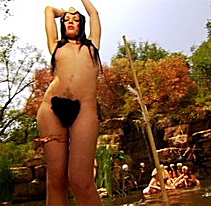 are even cases when actresses were willing to go topless in a movie, but have insisted their real nipples be replaced with fake CGI nipples. Seriously! What is it with Americans and their fear of female nipples? Even when a real naked body is used, it's more often than not a body double, and not the actor playing the part. So if you think you've seen a famous actor completely naked in some recent movie, odds are you haven't, any more than you've seen actors being shot and stabbed. And if a naked shot is anything but fleeting and in a dim light, then the breasts and/or genitals are usually outrageously fake and shown for comic effect. Take for example this screenshot (right) of an Amazon warrior in the (pathetic) comedy movie, 'National Lampoon's Homo Erectus' (2007). Usually these sorts of scenes are designed to make the viewer laugh at the character's nakedness, or to make us feel the character's embarrassment and shame over being caught naked, say when a towel drops or a person accidentally walks in on someone dressing. Whether the sight is funny or embarrassing, we're taught that being caught naked will usually end in humiliating laughter or terrified screams, neither of which is pleasant. So double check that the door is locked, the curtains are drawn and if a towel is involved, it's securely tied.
are even cases when actresses were willing to go topless in a movie, but have insisted their real nipples be replaced with fake CGI nipples. Seriously! What is it with Americans and their fear of female nipples? Even when a real naked body is used, it's more often than not a body double, and not the actor playing the part. So if you think you've seen a famous actor completely naked in some recent movie, odds are you haven't, any more than you've seen actors being shot and stabbed. And if a naked shot is anything but fleeting and in a dim light, then the breasts and/or genitals are usually outrageously fake and shown for comic effect. Take for example this screenshot (right) of an Amazon warrior in the (pathetic) comedy movie, 'National Lampoon's Homo Erectus' (2007). Usually these sorts of scenes are designed to make the viewer laugh at the character's nakedness, or to make us feel the character's embarrassment and shame over being caught naked, say when a towel drops or a person accidentally walks in on someone dressing. Whether the sight is funny or embarrassing, we're taught that being caught naked will usually end in humiliating laughter or terrified screams, neither of which is pleasant. So double check that the door is locked, the curtains are drawn and if a towel is involved, it's securely tied.
 would agree with our view, saying in a magazine interview:
would agree with our view, saying in a magazine interview:
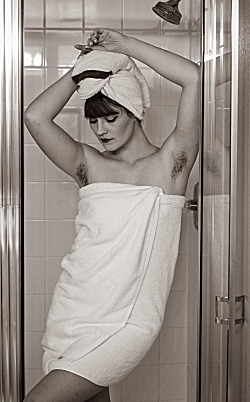 hidden bodies of the actors, but there will still be naked bodies occupying your thoughts. So what has movie censorship actually achieved? By deliberately creating a scene where they've forced us to think of the allure of naked bodies, and maybe also sex, not only have they not prevented us from thinking about nudity, they've done just the opposite. While the movie up to that stage might have had us thinking about aliens attacking the Earth or some secret agent chasing a super villain bent on world domination, as soon as they introduce a bedroom or bathroom scene, we're now thinking about naked bodies. Our argument is that since they've deliberately forced our minds to conjure up images of naked bodies anyway, they might have well have shown us naked bodies for real. Both scenarios would have us visualising nudity in our mind, the only difference between the two is how accurately our fantasy bodies compare to the actors' real bodies, and if sex is involved, our imagination certainly goes into way more detail than the movie does. So again, it's just stupid for prudes to say that they're going to censor nudity because they don't want viewers thinking about that sort of thing, when, like our mention of polar bears, they've made it so we can't think of anything else! Maybe we're unusual, but show us a movie scene where the characters have arrived at a nude beach or are having sex, and even though all the nudity and sex is implied and not actually seen, we can't help but have thoughts of naked bodies or sex. If their goal is to keep "dirty, impure" thoughts out of the minds of viewers, then they've failed miserably. If movies don't want us thinking about naked bodies, and instead want us thinking about how some mad scientist is going to cull half the Earth's population by genetically engineering an alien retrovirus which will be spread under the guise of polio eradication and funded by speculating on the futures market, then don't explain it to us while a sexy woman is taking a shower, even if that woman hides (for some obscure reason) her nudity behind shower curtains or steamed-up glass and emerges modestly wrapped in fluffy towels.
hidden bodies of the actors, but there will still be naked bodies occupying your thoughts. So what has movie censorship actually achieved? By deliberately creating a scene where they've forced us to think of the allure of naked bodies, and maybe also sex, not only have they not prevented us from thinking about nudity, they've done just the opposite. While the movie up to that stage might have had us thinking about aliens attacking the Earth or some secret agent chasing a super villain bent on world domination, as soon as they introduce a bedroom or bathroom scene, we're now thinking about naked bodies. Our argument is that since they've deliberately forced our minds to conjure up images of naked bodies anyway, they might have well have shown us naked bodies for real. Both scenarios would have us visualising nudity in our mind, the only difference between the two is how accurately our fantasy bodies compare to the actors' real bodies, and if sex is involved, our imagination certainly goes into way more detail than the movie does. So again, it's just stupid for prudes to say that they're going to censor nudity because they don't want viewers thinking about that sort of thing, when, like our mention of polar bears, they've made it so we can't think of anything else! Maybe we're unusual, but show us a movie scene where the characters have arrived at a nude beach or are having sex, and even though all the nudity and sex is implied and not actually seen, we can't help but have thoughts of naked bodies or sex. If their goal is to keep "dirty, impure" thoughts out of the minds of viewers, then they've failed miserably. If movies don't want us thinking about naked bodies, and instead want us thinking about how some mad scientist is going to cull half the Earth's population by genetically engineering an alien retrovirus which will be spread under the guise of polio eradication and funded by speculating on the futures market, then don't explain it to us while a sexy woman is taking a shower, even if that woman hides (for some obscure reason) her nudity behind shower curtains or steamed-up glass and emerges modestly wrapped in fluffy towels.
 masturbation, and masturbation causes blindness and other serious maladies. You can't argue with the facts (but seriously, if you want to learn the real facts, we recommend 'Sticky: A (Self) Love Story' (2016), an interesting and humorous documentary that exposes the myths and misconceptions surrounding masturbation and why most people are too afraid to discuss it.) As sincere as these folk are, their claim around nudity and harm rests on mere opinion and not evidence, meaning they are always very vague as to what support there is for their belief that nudity causes harm, and personally we think this speaks more about the person that's afraid of nudity than anything else; that they're fearful that they couldn't control themselves, that they are terribly weak-willed and need society to hide naked bodies from them lest they spy one and run amuck. In his book, 'Thinking Critically About Ethical Issues' (2015), Vincent Ruggiero writes that:
masturbation, and masturbation causes blindness and other serious maladies. You can't argue with the facts (but seriously, if you want to learn the real facts, we recommend 'Sticky: A (Self) Love Story' (2016), an interesting and humorous documentary that exposes the myths and misconceptions surrounding masturbation and why most people are too afraid to discuss it.) As sincere as these folk are, their claim around nudity and harm rests on mere opinion and not evidence, meaning they are always very vague as to what support there is for their belief that nudity causes harm, and personally we think this speaks more about the person that's afraid of nudity than anything else; that they're fearful that they couldn't control themselves, that they are terribly weak-willed and need society to hide naked bodies from them lest they spy one and run amuck. In his book, 'Thinking Critically About Ethical Issues' (2015), Vincent Ruggiero writes that:
 testicles have been found to be as dangerous as asbestos, and they should have been warned of the risk. And let's remember that body hair removal (from the genitals, armpits, legs, ass and even the nipples and toes) is an expensive, time-consuming, painful and utterly needless procedure, so if beauty therapists did find that exposure to nudity was harmful to their well-being, they could simply stop doing it and concentrate on facials and manicures instead. It does nothing but pander to their clients' puerile vanity and continue a money-making scam for the therapists, so society wouldn't suffer if they stopped, and we'd argue that it would actually benefit, with the time and money being spent on more worthwhile pursuits. But they're not stopping, in fact in the last couple of decades there has been an explosion in therapists offering body hair removal, meaning a huge increase in the number of therapists seeing complete strangers naked. And yet still no reports that the therapists are being affected in any way by all this up-close nudity, day in and day out.
testicles have been found to be as dangerous as asbestos, and they should have been warned of the risk. And let's remember that body hair removal (from the genitals, armpits, legs, ass and even the nipples and toes) is an expensive, time-consuming, painful and utterly needless procedure, so if beauty therapists did find that exposure to nudity was harmful to their well-being, they could simply stop doing it and concentrate on facials and manicures instead. It does nothing but pander to their clients' puerile vanity and continue a money-making scam for the therapists, so society wouldn't suffer if they stopped, and we'd argue that it would actually benefit, with the time and money being spent on more worthwhile pursuits. But they're not stopping, in fact in the last couple of decades there has been an explosion in therapists offering body hair removal, meaning a huge increase in the number of therapists seeing complete strangers naked. And yet still no reports that the therapists are being affected in any way by all this up-close nudity, day in and day out.

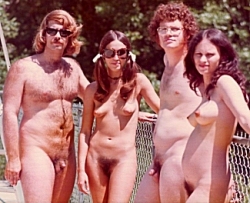 This group, nudists, have a much longer and varied exposure to nudity, although not the hands-on contact that beauty therapists and gynecologists experience. For years and years, nudists often spend the entire day around naked people, while being naked themselves, viewing naked bodies of both sexes, young and old, big and small, beautiful and not-so-much, but again, there is not the slightest indication that wall-to-wall nudity does them, or the wider society, any harm whatsoever. In the book, '1001 Ideas That Changed the Way We Think' (2013), edited by philosopher Robert Arp, the entry on nudism notes that, 'Arguments over the pros and cons of public nudity abound, yet surprisingly very little evidence has been forthcoming to demonstrate that the practice has any negative effect on the moral fabric of society'. We would argue that you may even have some friends or colleagues that are nudists, but you don't know it, because nothing in their behaviour suggests in the slightest that they've been psychologically damaged. In fact, they would likely argue that they are more well-adjusted concerning the naked body than most non-nudists (or textiles), since they don't scream like a little schoolgirl when they're changing in public and their towel slips off.
This group, nudists, have a much longer and varied exposure to nudity, although not the hands-on contact that beauty therapists and gynecologists experience. For years and years, nudists often spend the entire day around naked people, while being naked themselves, viewing naked bodies of both sexes, young and old, big and small, beautiful and not-so-much, but again, there is not the slightest indication that wall-to-wall nudity does them, or the wider society, any harm whatsoever. In the book, '1001 Ideas That Changed the Way We Think' (2013), edited by philosopher Robert Arp, the entry on nudism notes that, 'Arguments over the pros and cons of public nudity abound, yet surprisingly very little evidence has been forthcoming to demonstrate that the practice has any negative effect on the moral fabric of society'. We would argue that you may even have some friends or colleagues that are nudists, but you don't know it, because nothing in their behaviour suggests in the slightest that they've been psychologically damaged. In fact, they would likely argue that they are more well-adjusted concerning the naked body than most non-nudists (or textiles), since they don't scream like a little schoolgirl when they're changing in public and their towel slips off.
 real naked people having real sex in graphic detail are easily obtainable and have been watched by millions, to no ill effect. The above group of censors have even reviewed these movies (and books and magazines) and then released them for our pleasure, saying they are quite safe to view. This fact, that they're harmless, has been known for many decades, ever since pornography was made legal for adults to view, and this harmlessness was the main reason it was made legal. Even when it was illegal, those covertly viewing it weren't causing harm to anyone. All of us at 'Silly Beliefs'' have watched porn, and none of us have gone on to harm ourselves or others, and since we're also atheists, people that have a questionable grasp of morality according to religious mores, the fact that we can combine porn and atheism and still behave morally is surely good evidence that viewing explicit nudity and real sex isn't harmful. And with the Internet, you now don't even have to leave the comfort of your lounge or bedroom, nudity and graphic sex scenes are freely available on your widescreen, high-definition TV, which seems quite laughable when you think that our government censors are doing their best to hide fleeting nudity and brief, shadowy, pretend sex from us in mainstream movies.
real naked people having real sex in graphic detail are easily obtainable and have been watched by millions, to no ill effect. The above group of censors have even reviewed these movies (and books and magazines) and then released them for our pleasure, saying they are quite safe to view. This fact, that they're harmless, has been known for many decades, ever since pornography was made legal for adults to view, and this harmlessness was the main reason it was made legal. Even when it was illegal, those covertly viewing it weren't causing harm to anyone. All of us at 'Silly Beliefs'' have watched porn, and none of us have gone on to harm ourselves or others, and since we're also atheists, people that have a questionable grasp of morality according to religious mores, the fact that we can combine porn and atheism and still behave morally is surely good evidence that viewing explicit nudity and real sex isn't harmful. And with the Internet, you now don't even have to leave the comfort of your lounge or bedroom, nudity and graphic sex scenes are freely available on your widescreen, high-definition TV, which seems quite laughable when you think that our government censors are doing their best to hide fleeting nudity and brief, shadowy, pretend sex from us in mainstream movies.
 At one point in the British documentary series 'Pornography: The Secret History of Civilisation' (1999), film professor Constance Penley discusses the many movies the porn industry makes parodying the Hollywood mainstream movies, such as the three porn movies below spoofing 'Indiana Jones', 'Tomb Raider' and 'Clueless' respectively:
At one point in the British documentary series 'Pornography: The Secret History of Civilisation' (1999), film professor Constance Penley discusses the many movies the porn industry makes parodying the Hollywood mainstream movies, such as the three porn movies below spoofing 'Indiana Jones', 'Tomb Raider' and 'Clueless' respectively:
 Some might argue that there's a huge difference, in that unlike porn movies made solely for adult viewing, mainstream movies are censored to protect children from viewing nudity and/or sex. But without doubt the only mainstream movies that are being stripped of nudity and sex are movies made for adult audiences, not for children. No one even puts nudity and sex in kids' movies to begin with. Disney movies are not known for their sex scenes, and no one is at all concerned that Donald Duck always puts on a shirt but never any pants. Contrary to the fake image on the right that we saw on the Internet, Princess Anna doesn't emerge naked from the shower in the movie 'Frozen'. But while nudity is a no-no, violence and frightening behaviour is fine for kids to see, with the villain and his henchmen trying to murder both Princess Anna and Queen Elsa several times, and Queen Elsa's giant snowman trying to kill Princess Anna and Kristoff, after they were attacked by a pack of vicious wolves. The only reason no one was killed is that cartoon characters are hardier than real people. Look at Wile E. Coyote. Even for kids' movies the implicit message is the same, violence is good, nudity is bad.
Some might argue that there's a huge difference, in that unlike porn movies made solely for adult viewing, mainstream movies are censored to protect children from viewing nudity and/or sex. But without doubt the only mainstream movies that are being stripped of nudity and sex are movies made for adult audiences, not for children. No one even puts nudity and sex in kids' movies to begin with. Disney movies are not known for their sex scenes, and no one is at all concerned that Donald Duck always puts on a shirt but never any pants. Contrary to the fake image on the right that we saw on the Internet, Princess Anna doesn't emerge naked from the shower in the movie 'Frozen'. But while nudity is a no-no, violence and frightening behaviour is fine for kids to see, with the villain and his henchmen trying to murder both Princess Anna and Queen Elsa several times, and Queen Elsa's giant snowman trying to kill Princess Anna and Kristoff, after they were attacked by a pack of vicious wolves. The only reason no one was killed is that cartoon characters are hardier than real people. Look at Wile E. Coyote. Even for kids' movies the implicit message is the same, violence is good, nudity is bad.
 'In March 2009 the BBC Horizon documentary "What's the Problem With Nudity?" explored why people tend to feel ashamed or embarrassed when they are naked ... The documentary ... invited eight volunteers to undergo a series of experiences in the nude in the presence of each other and a team of psychologists, which concluded that our inhibitions about being seen naked are the result of social conditioning, and that we are not born with a shame of nudity, but learn it.'
'In March 2009 the BBC Horizon documentary "What's the Problem With Nudity?" explored why people tend to feel ashamed or embarrassed when they are naked ... The documentary ... invited eight volunteers to undergo a series of experiences in the nude in the presence of each other and a team of psychologists, which concluded that our inhibitions about being seen naked are the result of social conditioning, and that we are not born with a shame of nudity, but learn it.'
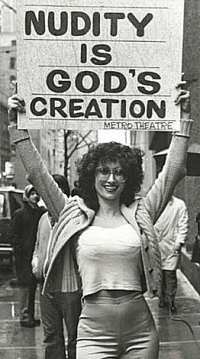 To them, a naked body is of itself obscene because of what it signifies. A naked body seen in the shower or changing at the pool or relaxing in the sauna is obscene. Naked bodies seen skinny dipping are obscene because these ignorant prudes can picture nothing but the wild orgy that will, in their perverted minds, naturally follow. They fear nudity because they fear sex. But the reality is that sex is not obscene, indecent or offensive, it's beautiful and actually a lot of fun, and rather necessary in the big scheme of things, so even if nudity was solely connected to sex, it still wouldn't be obscene, indecent or offensive.
To them, a naked body is of itself obscene because of what it signifies. A naked body seen in the shower or changing at the pool or relaxing in the sauna is obscene. Naked bodies seen skinny dipping are obscene because these ignorant prudes can picture nothing but the wild orgy that will, in their perverted minds, naturally follow. They fear nudity because they fear sex. But the reality is that sex is not obscene, indecent or offensive, it's beautiful and actually a lot of fun, and rather necessary in the big scheme of things, so even if nudity was solely connected to sex, it still wouldn't be obscene, indecent or offensive.
 'There are an awful lot of naked bodies in western art ... and they are often causing trouble, even now. Whether it's [women] demonstrating against sexual violence [in front of naked artwork], or a case of concealment [of naked artwork] to preserve diplomatic relations, or simply [naked artwork] being taken down. The nude stands on some of the deepest fault lines running through society now, speaking directly to issues of men and women, gender and sex. But actually, that is nothing new. For centuries, naked bodies, especially female ones, have been wrapped in high-minded talk of beauty and the ennobling effects of art. But I don't think you can talk about the nude unless you also talk about male desire. In this (documentary) on the naked body in western art, I'll be looking at how for so long men got away with it ... I'll be asking quite why western art has been so obsessed with nudity' [22].
'There are an awful lot of naked bodies in western art ... and they are often causing trouble, even now. Whether it's [women] demonstrating against sexual violence [in front of naked artwork], or a case of concealment [of naked artwork] to preserve diplomatic relations, or simply [naked artwork] being taken down. The nude stands on some of the deepest fault lines running through society now, speaking directly to issues of men and women, gender and sex. But actually, that is nothing new. For centuries, naked bodies, especially female ones, have been wrapped in high-minded talk of beauty and the ennobling effects of art. But I don't think you can talk about the nude unless you also talk about male desire. In this (documentary) on the naked body in western art, I'll be looking at how for so long men got away with it ... I'll be asking quite why western art has been so obsessed with nudity' [22].
 It's been stated that there are surely more paintings and sculptures of a naked or semi-naked Jesus Christ around the world than any other mythological or historical figure by far, such as the 'The Risen Christ', a statue of Jesus (right) carved in 1521 by Michelangelo. Most towns and cities have naked (and often bloody) versions of Jesus in their churches and art galleries, and untold Christians own a small crucifix portraying a semi-naked (and dead) Jesus, with only his genitals modestly covered out of embarrassment by a small piece of cloth added by the artist (although of course Jesus would have been naked on the cross (as confirmed by the Bible) since the Romans wouldn't have cared about his modesty). Even I have a 4 inch crucifix with a dead Jesus hanging from it with his genitals barely covered. I found it discarded in a student flat and I keep it near the door should I need it to ward off vampires.
It's been stated that there are surely more paintings and sculptures of a naked or semi-naked Jesus Christ around the world than any other mythological or historical figure by far, such as the 'The Risen Christ', a statue of Jesus (right) carved in 1521 by Michelangelo. Most towns and cities have naked (and often bloody) versions of Jesus in their churches and art galleries, and untold Christians own a small crucifix portraying a semi-naked (and dead) Jesus, with only his genitals modestly covered out of embarrassment by a small piece of cloth added by the artist (although of course Jesus would have been naked on the cross (as confirmed by the Bible) since the Romans wouldn't have cared about his modesty). Even I have a 4 inch crucifix with a dead Jesus hanging from it with his genitals barely covered. I found it discarded in a student flat and I keep it near the door should I need it to ward off vampires.
 liberated culture that had arisen in Denmark in the late 1960s, the narrator noted that it's citizens, especially its younger generation, 'have outgrown the taboos that made human bodies the only product of all nature too evil to look upon'. To show that these taboos didn't always exist, it displayed artwork featuring nudity and sex from ancient cultures and explained that,
liberated culture that had arisen in Denmark in the late 1960s, the narrator noted that it's citizens, especially its younger generation, 'have outgrown the taboos that made human bodies the only product of all nature too evil to look upon'. To show that these taboos didn't always exist, it displayed artwork featuring nudity and sex from ancient cultures and explained that,
 and sickened, or at the very least, uncomfortable, with nudity? Even when they want to overcome their puritanical upbringing, when it comes to their genitals many people lack self-confidence. They're afraid that their genitals might not be quite normal, since they have no idea what normal is, and watching pornography only makes them more paranoid, since comparing yourself to porn stars is like comparing your body to that of actors in the movie 'Baywatch' (2017), starring Dwayne Johnson and Alexandra Daddario. The male and female bodies in both porn and mainstream movies are a celluloid version of the real thing, where everything from props and CGI to careful editing are utilised to produce an idealised body and an idealised performance. And while a handful of actors do naturally have the muscular and voluptuous bodies we see on-screen, it's quite deceptive and misleading for movies and magazines to suggest that the rest of us, 99.99999% of the planet, are abject failures and physical abominations. It's quite annoying that, through ignorance, most people have been fooled into accepting that the natural human body, the one they have, is physically flawed, that it's something to be ashamed of, simply because it doesn't measure up to the fantasies they see on-screen. Movies only engage with us because they take us to worlds that aren't real, with beautiful people doing amazing things that aren't real, and often couldn't be real, but far too many people forget that, and the movie world starts making impossible demands on reality. People start comparing their naked bodies and their sexual performance to fictional movie characters (in both porn and mainstream movies) and naturally come away disappointed. It's like comparing yourself to Superman or Wonder Woman, you're not even going to come a distant second.
and sickened, or at the very least, uncomfortable, with nudity? Even when they want to overcome their puritanical upbringing, when it comes to their genitals many people lack self-confidence. They're afraid that their genitals might not be quite normal, since they have no idea what normal is, and watching pornography only makes them more paranoid, since comparing yourself to porn stars is like comparing your body to that of actors in the movie 'Baywatch' (2017), starring Dwayne Johnson and Alexandra Daddario. The male and female bodies in both porn and mainstream movies are a celluloid version of the real thing, where everything from props and CGI to careful editing are utilised to produce an idealised body and an idealised performance. And while a handful of actors do naturally have the muscular and voluptuous bodies we see on-screen, it's quite deceptive and misleading for movies and magazines to suggest that the rest of us, 99.99999% of the planet, are abject failures and physical abominations. It's quite annoying that, through ignorance, most people have been fooled into accepting that the natural human body, the one they have, is physically flawed, that it's something to be ashamed of, simply because it doesn't measure up to the fantasies they see on-screen. Movies only engage with us because they take us to worlds that aren't real, with beautiful people doing amazing things that aren't real, and often couldn't be real, but far too many people forget that, and the movie world starts making impossible demands on reality. People start comparing their naked bodies and their sexual performance to fictional movie characters (in both porn and mainstream movies) and naturally come away disappointed. It's like comparing yourself to Superman or Wonder Woman, you're not even going to come a distant second.
 And a couple of months before that we had the 'Southern Rumble', billed as 'the BIGGEST Independent Wrestling event in New Zealand history!' And yes, while pro wrestling gives the impression of being as violent and dangerous as boxing, if not more so, it is of course mostly all an act, almost as fake as the fights we see in the movies. But never the less, it is only popular because of the impression of violence that is delivered, and frankly, we're not sure that all of the fans realise that it's fake. And in any extreme sport there is always the chance for serious injury, that a wrestler bobs when he should have weaved, and he gets hit for real, and clearly this is what the audience is screaming for. They may know it's an orchestrated dance, but they still want to see someone get hurt.
And a couple of months before that we had the 'Southern Rumble', billed as 'the BIGGEST Independent Wrestling event in New Zealand history!' And yes, while pro wrestling gives the impression of being as violent and dangerous as boxing, if not more so, it is of course mostly all an act, almost as fake as the fights we see in the movies. But never the less, it is only popular because of the impression of violence that is delivered, and frankly, we're not sure that all of the fans realise that it's fake. And in any extreme sport there is always the chance for serious injury, that a wrestler bobs when he should have weaved, and he gets hit for real, and clearly this is what the audience is screaming for. They may know it's an orchestrated dance, but they still want to see someone get hurt.
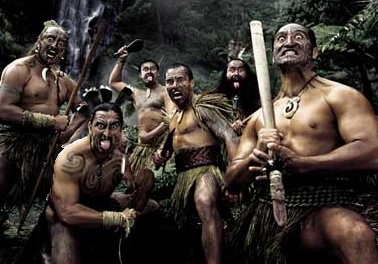 and the way to solve these problems, according some Maori and even some politicians, is to train troubled Maori youth to be warriors, to teach them how Maori warriors traditionally acted hundreds of years ago, when the relationship between neighbouring tribes was often war, not trade. So they're being schooled in the Maori language (rather than English), they memorise and fixate on their Maori lineage (while ignoring their non-Maori lineage), they're told how they lost their lands to English colonialism, instilling a sense of victimhood, and they learn how to use traditional Maori weapons (although in real-life interactions they still prefer guns). And of course they perform the war haka at every possible opportunity, be it after a victory in a game, at a funeral, or when the pizza they ordered finally arrives. But we're not buying this plan for turning their lives around. We're not convinced that teaching people to act like warriors, creating division between Maori and other New Zealanders, performing the intimidating haka incessantly, tattooing your face to look threatening, and training in the use of ancient weapons, has the slightest chance of success. A warrior is one who is trained to do battle, and battles mean violence towards the enemy, so this is just another unfortunate example of the flawed belief that the way of the warrior, the way of violence, is the answer to improve society. And in their own way, Maori are answering our question, nudity or violence — which is worse? That's because, while they're now encouraged by their embittered elders to embrace the ways of the past, the warrior psyche of the war dance and the ancient weapons, there hasn't been a similar return to their traditional views on nudity, just the opposite in fact.
and the way to solve these problems, according some Maori and even some politicians, is to train troubled Maori youth to be warriors, to teach them how Maori warriors traditionally acted hundreds of years ago, when the relationship between neighbouring tribes was often war, not trade. So they're being schooled in the Maori language (rather than English), they memorise and fixate on their Maori lineage (while ignoring their non-Maori lineage), they're told how they lost their lands to English colonialism, instilling a sense of victimhood, and they learn how to use traditional Maori weapons (although in real-life interactions they still prefer guns). And of course they perform the war haka at every possible opportunity, be it after a victory in a game, at a funeral, or when the pizza they ordered finally arrives. But we're not buying this plan for turning their lives around. We're not convinced that teaching people to act like warriors, creating division between Maori and other New Zealanders, performing the intimidating haka incessantly, tattooing your face to look threatening, and training in the use of ancient weapons, has the slightest chance of success. A warrior is one who is trained to do battle, and battles mean violence towards the enemy, so this is just another unfortunate example of the flawed belief that the way of the warrior, the way of violence, is the answer to improve society. And in their own way, Maori are answering our question, nudity or violence — which is worse? That's because, while they're now encouraged by their embittered elders to embrace the ways of the past, the warrior psyche of the war dance and the ancient weapons, there hasn't been a similar return to their traditional views on nudity, just the opposite in fact. 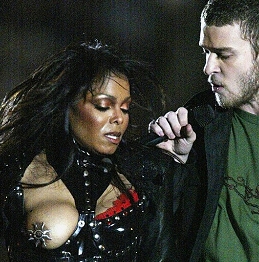 Look at the hysteria that surrounded Janet Jackson's 2004 Super Bowl
Look at the hysteria that surrounded Janet Jackson's 2004 Super Bowl  To highlight this increasing prudishness, did you know that on the popular movie website
To highlight this increasing prudishness, did you know that on the popular movie website  After watching 'Girls of the Sun' (2018), a well-made war drama based on true events about Kurdish female soldiers fighting ISIS invaders, we read a short positive review of the movie on IMDb, where the reviewer finished with this sentence: 'Guide: F-word. No sex or nudity.' So yeah, since there is no sex or nudity the movie is safe viewing for the whole family, just watch out for that offensive F-word when it's uttered, which we're assuming is 'Fuck' (or perhaps 'Feminist', remember this is a movie about female soldiers, women taking on roles that many men believe they have exclusive rights to). This reviewer again highlights the irrational disconnect between sex and violence that untold people exhibit today. Their only fucking concern was that someone said the F-word, that was their sole warning to potential viewers, oh ... and to reassure viewers that there was sex or nudity. They made no fucking mention of graphic battle scenes of female soldiers being killed; no mention of women being raped by Muslim fundamentalists and one woman committing suicide after being raped; no mention of unarmed village men being lined up and shot in the back by ISIS in front of their wives; and no mention of women and young girls being sold as sex slaves by Muslim fundamentalists. This reviewer apparently had no problem viewing graphic and distressing violence inflicted on women, and therefore didn't feel they needed to mention it in their 'Guide', but, obviously fearful that some potential viewers might be hesitant to watch a movie about women, thought it important to reassure them that there was no sex or nudity. And on a positive note, these women had guns! It's fine to see a woman blown up and killed by an IED, we just don't want to see her naked ... Eww. Along similar lines, in an IMDb review of a low-budget post-apocalypse movie, the reviewer included this comment:
After watching 'Girls of the Sun' (2018), a well-made war drama based on true events about Kurdish female soldiers fighting ISIS invaders, we read a short positive review of the movie on IMDb, where the reviewer finished with this sentence: 'Guide: F-word. No sex or nudity.' So yeah, since there is no sex or nudity the movie is safe viewing for the whole family, just watch out for that offensive F-word when it's uttered, which we're assuming is 'Fuck' (or perhaps 'Feminist', remember this is a movie about female soldiers, women taking on roles that many men believe they have exclusive rights to). This reviewer again highlights the irrational disconnect between sex and violence that untold people exhibit today. Their only fucking concern was that someone said the F-word, that was their sole warning to potential viewers, oh ... and to reassure viewers that there was sex or nudity. They made no fucking mention of graphic battle scenes of female soldiers being killed; no mention of women being raped by Muslim fundamentalists and one woman committing suicide after being raped; no mention of unarmed village men being lined up and shot in the back by ISIS in front of their wives; and no mention of women and young girls being sold as sex slaves by Muslim fundamentalists. This reviewer apparently had no problem viewing graphic and distressing violence inflicted on women, and therefore didn't feel they needed to mention it in their 'Guide', but, obviously fearful that some potential viewers might be hesitant to watch a movie about women, thought it important to reassure them that there was no sex or nudity. And on a positive note, these women had guns! It's fine to see a woman blown up and killed by an IED, we just don't want to see her naked ... Eww. Along similar lines, in an IMDb review of a low-budget post-apocalypse movie, the reviewer included this comment:
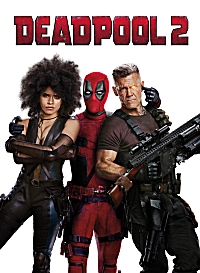 'Sex & Nudity — Moderate
'Sex & Nudity — Moderate
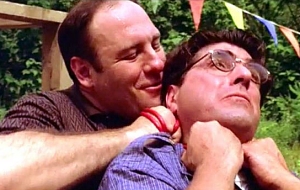 And yet, these same adults see no problem in embracing a recent trend in movies and TV shows that feature a "hero" that in days gone by would have been, without a doubt, the villain. They're fans of popular TV shows such as 'The Sopranos' (image right), where the main character was a crime boss and murderer, or 'Dexter' where the "hero" was a psychopathic serial killer, or 'Sons of Anarchy', a show about an outlaw motorcycle club, or 'Breaking Bad', where the protagonist was a drug dealer. NZ even made its own shows with 'Outrageous Fortune' and 'Westside', which followed the lives of the career criminal West family. Some popular movies that portray villainous or criminal characters as heroes would be 'Ocean's 11' (George Clooney), 'The Fast & the Furious' (Paul Walker), 'Payback' (Mel Gibson), 'Scarface' (Al Pacino), 'Pitch Black' (Vin Diesel), 'Hannibal' (Anthony Hopkins), 'Gone in 60 Seconds' (Nicolas Cage), 'Heist' (Robert De Niro), 'V for Vendetta' (Natalie Portman), 'The Bank Job' (Jason Statham) and even 'Pirates of the Caribbean' (Johnny Depp). Usually they achieve their goal of making the viewer root for the hero, even though this means accepting criminal behaviour, by making the "hero" better looking and/or wittier or simply less villainous than the main villain. Then we have current TV shows like 'The Walking Dead' where sudden and violent death from zombies is the theme, 'SEAL Team' which follows covert and deadly military missions, medieval fantasy shows like 'Game of Thrones' that regale us with the battles between warring kingdoms, and each week we have people being murdered, children being abducted and women being raped in TV crime shows like 'FBI', 'CSI: Miami', 'Criminal Minds', 'NCIS', 'SVU: Special Victims Unit', 'Criminal Intent', 'Suspicious Minds', 'CSI: New York', 'NCIS: LA', 'NCIS: New Orleans' etc. I actually don't watch those crime shows, since I find their enactment of violent crimes too realistic and depressing. Then we have most people, including many kids, watching untold people being killed in movies like 'World War Z' and 'Rambo'. And it's not just movies made for adults, how many violent deaths do kids witness in movies like 'The Lord of the Rings' or 'Star Wars' or even 'Harry Potter', how many innocent people die when those silly robots in the 'Transformers' movies decide to fight their battles amongst the skyscrapers of populous cities rather than an empty desert?
And yet, these same adults see no problem in embracing a recent trend in movies and TV shows that feature a "hero" that in days gone by would have been, without a doubt, the villain. They're fans of popular TV shows such as 'The Sopranos' (image right), where the main character was a crime boss and murderer, or 'Dexter' where the "hero" was a psychopathic serial killer, or 'Sons of Anarchy', a show about an outlaw motorcycle club, or 'Breaking Bad', where the protagonist was a drug dealer. NZ even made its own shows with 'Outrageous Fortune' and 'Westside', which followed the lives of the career criminal West family. Some popular movies that portray villainous or criminal characters as heroes would be 'Ocean's 11' (George Clooney), 'The Fast & the Furious' (Paul Walker), 'Payback' (Mel Gibson), 'Scarface' (Al Pacino), 'Pitch Black' (Vin Diesel), 'Hannibal' (Anthony Hopkins), 'Gone in 60 Seconds' (Nicolas Cage), 'Heist' (Robert De Niro), 'V for Vendetta' (Natalie Portman), 'The Bank Job' (Jason Statham) and even 'Pirates of the Caribbean' (Johnny Depp). Usually they achieve their goal of making the viewer root for the hero, even though this means accepting criminal behaviour, by making the "hero" better looking and/or wittier or simply less villainous than the main villain. Then we have current TV shows like 'The Walking Dead' where sudden and violent death from zombies is the theme, 'SEAL Team' which follows covert and deadly military missions, medieval fantasy shows like 'Game of Thrones' that regale us with the battles between warring kingdoms, and each week we have people being murdered, children being abducted and women being raped in TV crime shows like 'FBI', 'CSI: Miami', 'Criminal Minds', 'NCIS', 'SVU: Special Victims Unit', 'Criminal Intent', 'Suspicious Minds', 'CSI: New York', 'NCIS: LA', 'NCIS: New Orleans' etc. I actually don't watch those crime shows, since I find their enactment of violent crimes too realistic and depressing. Then we have most people, including many kids, watching untold people being killed in movies like 'World War Z' and 'Rambo'. And it's not just movies made for adults, how many violent deaths do kids witness in movies like 'The Lord of the Rings' or 'Star Wars' or even 'Harry Potter', how many innocent people die when those silly robots in the 'Transformers' movies decide to fight their battles amongst the skyscrapers of populous cities rather than an empty desert?
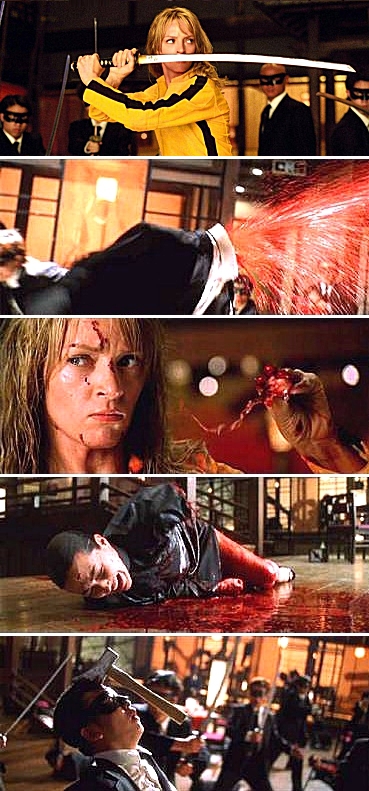
 That is just a small fraction of the graphic violence from that lengthy sword fight, let alone what is seen in the entire movie, actually two movies, since the story was continued and concluded in the sequel, 'Kill Bill: Vol 2' (2004), which was just as violent, and just as successful at the box office. We're using 'Kill Bill' as an example because we found a website that provided all those screenshots (and many more), but there are untold other movies that could provide equally violent and disturbing scenes of human suffering (see the list below). And these movies are all wildly popular, 'big name' mainstream movies that have all screened uncensored on TV, some numerous times, where anyone from adults to young children can watch them. When we say that they 'screened uncensored on TV'
That is just a small fraction of the graphic violence from that lengthy sword fight, let alone what is seen in the entire movie, actually two movies, since the story was continued and concluded in the sequel, 'Kill Bill: Vol 2' (2004), which was just as violent, and just as successful at the box office. We're using 'Kill Bill' as an example because we found a website that provided all those screenshots (and many more), but there are untold other movies that could provide equally violent and disturbing scenes of human suffering (see the list below). And these movies are all wildly popular, 'big name' mainstream movies that have all screened uncensored on TV, some numerous times, where anyone from adults to young children can watch them. When we say that they 'screened uncensored on TV' 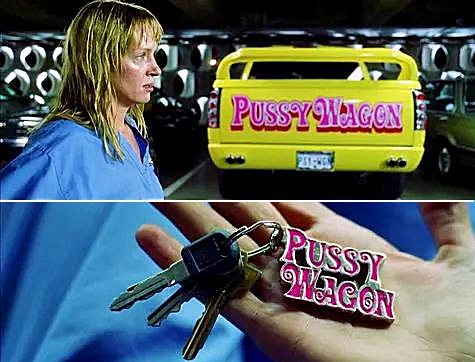 we're talking about NZ TV. We read that when 'Kill Bill' was broadcast on TBS (a popular cable TV network in the US), they apparently changed the name of a yellow pickup truck seen in the movie from the 'Pussy Wagon' to the 'Party Wagon' so as not to offend American viewers. Clearly they were worried that viewers would be far more shocked by the word 'pussy' than the revelation that the vehicle's owner had raped the heroine while she was in a coma (several times) and she had then beaten him to death, along with his would-be rapist friend, and then stole his truck. They went to considerable effort just to shield viewers from the innocent word 'pussy', apparently fearful what furry images viewers might conjure up. And no doubt again fixating on things sexual, TBS also censored the following (underlined) movie dialogue: 'I could see the faces of the cunts that did this to me and the dick responsible', inserting the words 'tramps' and 'jerk' instead. In reality, even before their childish editing, there was no sex or nudity in 'Kill Bill', but there was untold graphic violence, which they happily let through. In the 2015 documentary 'The Mask You Live In', about how American masculinity is harming men and society, it was noted that, 'The average 18 year old has seen 200,000 acts of violence on-screen, including 40,000 murders'.
we're talking about NZ TV. We read that when 'Kill Bill' was broadcast on TBS (a popular cable TV network in the US), they apparently changed the name of a yellow pickup truck seen in the movie from the 'Pussy Wagon' to the 'Party Wagon' so as not to offend American viewers. Clearly they were worried that viewers would be far more shocked by the word 'pussy' than the revelation that the vehicle's owner had raped the heroine while she was in a coma (several times) and she had then beaten him to death, along with his would-be rapist friend, and then stole his truck. They went to considerable effort just to shield viewers from the innocent word 'pussy', apparently fearful what furry images viewers might conjure up. And no doubt again fixating on things sexual, TBS also censored the following (underlined) movie dialogue: 'I could see the faces of the cunts that did this to me and the dick responsible', inserting the words 'tramps' and 'jerk' instead. In reality, even before their childish editing, there was no sex or nudity in 'Kill Bill', but there was untold graphic violence, which they happily let through. In the 2015 documentary 'The Mask You Live In', about how American masculinity is harming men and society, it was noted that, 'The average 18 year old has seen 200,000 acts of violence on-screen, including 40,000 murders'.
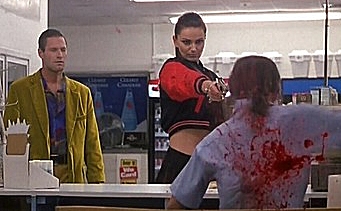 What is society teaching us when in our movies it's OK, enjoyable even, to watch a woman shoot an innocent shop assistant (photo right) or to watch a man sadistically kill a beautiful woman in graphic detail (eg 'Kill Bill'), but it's not OK, it's disgusting even, to watch a man have loving sex with a beautiful woman in graphic detail? Surely, since your typical adult loves sex and abhors murder, we've got this backwards? Movie directors, censors and the movie-going public apparently have no problem with shots of bodily fluids as long as those fluids are red and not white, such as the following screenshots that were the climax of the action movie 'From Paris With Love' (2010). They show a man shooting his fiancee in the forehead in slow motion. Admittedly he had just discovered she was a terrorist with a bomb, and she needed to be stopped, but why did the director insist that we see the extreme detail of blood spurting out the back of her head, when an earlier scene of the young couple about to get naked and have sex stopped abruptly at the bedroom door, with the camera pausing outside only long enough for us to hear a few excited giggles. Apparently the director thought that the viewers' imagination could easily flesh out what was happening off-screen, but when it came to the young woman's later violent death, our imagination was apparently found lacking and the director believed he needed to show how soft flesh responds to high speed bullets.
What is society teaching us when in our movies it's OK, enjoyable even, to watch a woman shoot an innocent shop assistant (photo right) or to watch a man sadistically kill a beautiful woman in graphic detail (eg 'Kill Bill'), but it's not OK, it's disgusting even, to watch a man have loving sex with a beautiful woman in graphic detail? Surely, since your typical adult loves sex and abhors murder, we've got this backwards? Movie directors, censors and the movie-going public apparently have no problem with shots of bodily fluids as long as those fluids are red and not white, such as the following screenshots that were the climax of the action movie 'From Paris With Love' (2010). They show a man shooting his fiancee in the forehead in slow motion. Admittedly he had just discovered she was a terrorist with a bomb, and she needed to be stopped, but why did the director insist that we see the extreme detail of blood spurting out the back of her head, when an earlier scene of the young couple about to get naked and have sex stopped abruptly at the bedroom door, with the camera pausing outside only long enough for us to hear a few excited giggles. Apparently the director thought that the viewers' imagination could easily flesh out what was happening off-screen, but when it came to the young woman's later violent death, our imagination was apparently found lacking and the director believed he needed to show how soft flesh responds to high speed bullets.
 suggesting we make all our beaches nude beaches either, since some locations clearly aren't appropriate for that sort of thing. Too cold. We're simply pointing out that it's just utterly ridiculous that when a body is naked or having sex then it must be hidden behind a sheet, but when that same clothed body is being penetrated by a bullet or knife, blown apart by a car bomb, or having its limbs sliced off with a samurai sword, then not only can it be shown, but it will be shown in all its shocking, gory detail, often in slow motion and extreme close-up. Why the double standards? And if we have to see one sort of body and one sort of act, why has society decided that it's harmless and entertaining to see realistic, bloody, disturbing acts of violence carried out on clothed bodies, and that it's obscene, disgusting and clearly harmful to see bodies naked, even beautiful bodies, let alone naked bodies in a loving embrace or having sex? Why do we allow the gory and censor the beautiful? Graphic scenes of cruelty, hatred and violent death are perfectly OK, even for kids, but scenes of love, intimacy and passion combined with naked bodies, or even naked bodies without any sexual element, such as sunbathing on a beach, are definitely not OK. Society has spoken. End of story. But perhaps we should be questioning what society has decreed, since surely running away from innocent nudity and towards disturbing violence instead is a sign that society is seriously screwed up? Perhaps society needs to be taken down a dark alley and with the aid of an electric cattle prod, given a serious talking to?
suggesting we make all our beaches nude beaches either, since some locations clearly aren't appropriate for that sort of thing. Too cold. We're simply pointing out that it's just utterly ridiculous that when a body is naked or having sex then it must be hidden behind a sheet, but when that same clothed body is being penetrated by a bullet or knife, blown apart by a car bomb, or having its limbs sliced off with a samurai sword, then not only can it be shown, but it will be shown in all its shocking, gory detail, often in slow motion and extreme close-up. Why the double standards? And if we have to see one sort of body and one sort of act, why has society decided that it's harmless and entertaining to see realistic, bloody, disturbing acts of violence carried out on clothed bodies, and that it's obscene, disgusting and clearly harmful to see bodies naked, even beautiful bodies, let alone naked bodies in a loving embrace or having sex? Why do we allow the gory and censor the beautiful? Graphic scenes of cruelty, hatred and violent death are perfectly OK, even for kids, but scenes of love, intimacy and passion combined with naked bodies, or even naked bodies without any sexual element, such as sunbathing on a beach, are definitely not OK. Society has spoken. End of story. But perhaps we should be questioning what society has decreed, since surely running away from innocent nudity and towards disturbing violence instead is a sign that society is seriously screwed up? Perhaps society needs to be taken down a dark alley and with the aid of an electric cattle prod, given a serious talking to?
 A couple of years ago I remember reading an article written by a student from Dunedin's Otago University. She wrote of travelling to Finland and wearing a bathing suit into a sauna and how everyone stared at her, because of course everyone else was naked. She overcame her fear, stripped off and thoroughly enjoyed the experience, discovering that no one cared that they were all naked, and that the lack of restrictive, wet, clingy clothing actually made it more enjoyable. Returning to NZ she was frustrated that all the students in her university sauna wear bathing suits, and wouldn't even consider taking them off.
A couple of years ago I remember reading an article written by a student from Dunedin's Otago University. She wrote of travelling to Finland and wearing a bathing suit into a sauna and how everyone stared at her, because of course everyone else was naked. She overcame her fear, stripped off and thoroughly enjoyed the experience, discovering that no one cared that they were all naked, and that the lack of restrictive, wet, clingy clothing actually made it more enjoyable. Returning to NZ she was frustrated that all the students in her university sauna wear bathing suits, and wouldn't even consider taking them off.
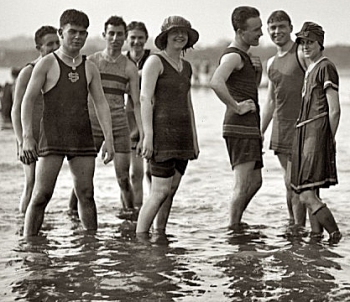 What's next, will these prudes be complaining that today's swimwear exposes too much flesh and start demanding that bathing costumes return to that of a century ago, and still not satisfied, that men and women use the pool on different days, like in past eras? When I was working in Iran in the late 1990s, segregation of the sexes at the hotel pool was the norm, so is that where we're going? You'll note in the photo on the right, of bathing costumes from 1922, that back then it was quite inappropriate for even men to go topless, ie to expose their nipples! In 1927, a London man, Captain H. H. Vincent, was 'arrested for sunbathing bare-chested in Hyde Park. The magistrate was horrified: "To expose the upper part of your body is indecent. I think it is likely to shock persons of ordinary sensibility".' By kowtowing to the prudes in society, are we slowly turning the clock back to those times when even the sight of a shirtless man would cause offence?
What's next, will these prudes be complaining that today's swimwear exposes too much flesh and start demanding that bathing costumes return to that of a century ago, and still not satisfied, that men and women use the pool on different days, like in past eras? When I was working in Iran in the late 1990s, segregation of the sexes at the hotel pool was the norm, so is that where we're going? You'll note in the photo on the right, of bathing costumes from 1922, that back then it was quite inappropriate for even men to go topless, ie to expose their nipples! In 1927, a London man, Captain H. H. Vincent, was 'arrested for sunbathing bare-chested in Hyde Park. The magistrate was horrified: "To expose the upper part of your body is indecent. I think it is likely to shock persons of ordinary sensibility".' By kowtowing to the prudes in society, are we slowly turning the clock back to those times when even the sight of a shirtless man would cause offence?
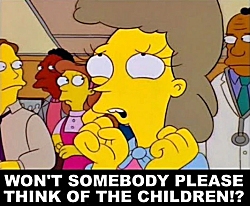 Of course America is the country where the phrase — Won't somebody please think of the children? — is really taken to ridiculous extremes, where hiding nudity and information about sex from children, even on a very basic and child-friendly level, is taken very seriously. In the documentary 'Sex(Ed): The Movie' (2014), a segment was shown where Bill O'Reilly, host of 'The O'Reilly Factor' on Fox News, was discussing sex education in US schools with guest and author Debra Haffner. When O'Reilly asks Haffner what a sex educator might tell a five-year-old she mentions the word uterus as the place inside a woman where 'a baby begins to grow', and O'Reilly immediately interrupts her and objects, saying he doesn't want five-year-olds to ever hear the word uterus, saying, 'They don't need to know that, they're not qualified to know it'. What hypocrisy! American assholes like O'Reilly insist that it's a parent's constitutional right, duty even, to expose children to guns in the home, and teach them how to use them, but that they should never be exposed to such dirty, filthy words as uterus. That it's important to know why they need guns — to protect them from heathens who don't love God as much as they do — but it's certainly not important to know where babies come from, and such loose talk could lead to immoral behaviour. They see a clear danger in talking about sex and the body with children, but see no harm in letting a child get familiar with an assault rifle. Consider where this often leads, with innocent people getting injured and killed due to their love of firearms and untold teenage girls with unplanned pregnancies due to ignorance around sex. America leads the world in both firearm fatalities and unwanted teenage pregnancies, and they're continually battling to keep it that way, constantly waging court battles to maintain easy access to weapons and to ban or limit sex education in schools. They love things like guns that cause violence while fearing even educational talk about sex and nudity, so it's no wonder that their movies also push this message. We all know that young kids will naturally ask questions about their bodies and where babies come from etc, so it's worrying that adults are deliberately withholding the facts while teaching them that the naked body is something to be ashamed of, actions that will negatively impact them once they become adults.
Of course America is the country where the phrase — Won't somebody please think of the children? — is really taken to ridiculous extremes, where hiding nudity and information about sex from children, even on a very basic and child-friendly level, is taken very seriously. In the documentary 'Sex(Ed): The Movie' (2014), a segment was shown where Bill O'Reilly, host of 'The O'Reilly Factor' on Fox News, was discussing sex education in US schools with guest and author Debra Haffner. When O'Reilly asks Haffner what a sex educator might tell a five-year-old she mentions the word uterus as the place inside a woman where 'a baby begins to grow', and O'Reilly immediately interrupts her and objects, saying he doesn't want five-year-olds to ever hear the word uterus, saying, 'They don't need to know that, they're not qualified to know it'. What hypocrisy! American assholes like O'Reilly insist that it's a parent's constitutional right, duty even, to expose children to guns in the home, and teach them how to use them, but that they should never be exposed to such dirty, filthy words as uterus. That it's important to know why they need guns — to protect them from heathens who don't love God as much as they do — but it's certainly not important to know where babies come from, and such loose talk could lead to immoral behaviour. They see a clear danger in talking about sex and the body with children, but see no harm in letting a child get familiar with an assault rifle. Consider where this often leads, with innocent people getting injured and killed due to their love of firearms and untold teenage girls with unplanned pregnancies due to ignorance around sex. America leads the world in both firearm fatalities and unwanted teenage pregnancies, and they're continually battling to keep it that way, constantly waging court battles to maintain easy access to weapons and to ban or limit sex education in schools. They love things like guns that cause violence while fearing even educational talk about sex and nudity, so it's no wonder that their movies also push this message. We all know that young kids will naturally ask questions about their bodies and where babies come from etc, so it's worrying that adults are deliberately withholding the facts while teaching them that the naked body is something to be ashamed of, actions that will negatively impact them once they become adults.
 'Among teenage girls, the equation between nudity, sex and immorality still appears to be fairly strong. A physical education (PE) teacher we interviewed told us that if a girl was comfortable with her own nudity in the school-changing room, this would be negatively interpreted as a sign of "sluttishness" rather than positively as a sign of confidence or unselfconsciousness. ...
'Among teenage girls, the equation between nudity, sex and immorality still appears to be fairly strong. A physical education (PE) teacher we interviewed told us that if a girl was comfortable with her own nudity in the school-changing room, this would be negatively interpreted as a sign of "sluttishness" rather than positively as a sign of confidence or unselfconsciousness. ...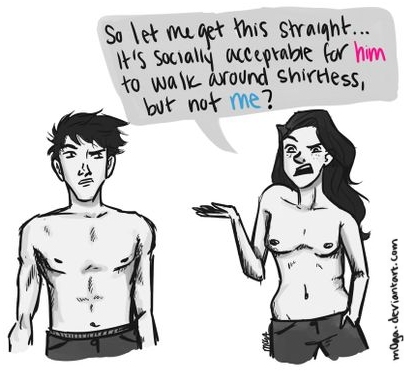 to sunbathe topless in NZ. The thing is, many people these days think it should be. When it comes to the law and beaches and saunas etc, even total nudity is not classed as indecent exposure and isn't an offence in NZ if it's not being done as an obscene act to offend others, that is, if it doesn't feature an element of lewdness or lasciviousness. And it's not just NZ where many people think topless sunbathing should be illegal. We read in an
to sunbathe topless in NZ. The thing is, many people these days think it should be. When it comes to the law and beaches and saunas etc, even total nudity is not classed as indecent exposure and isn't an offence in NZ if it's not being done as an obscene act to offend others, that is, if it doesn't feature an element of lewdness or lasciviousness. And it's not just NZ where many people think topless sunbathing should be illegal. We read in an 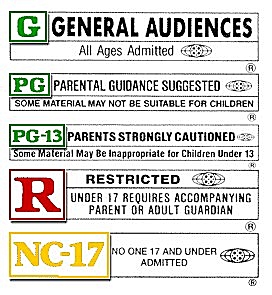 Movies make money based on how many people buy tickets to see them, and this number hinges on how many people are allowed to see them. Even at the very beginning of cinema, as historian and writer Charles Lyons noted in the 2007 documentary 'Indie Sex: Censored',
Movies make money based on how many people buy tickets to see them, and this number hinges on how many people are allowed to see them. Even at the very beginning of cinema, as historian and writer Charles Lyons noted in the 2007 documentary 'Indie Sex: Censored',
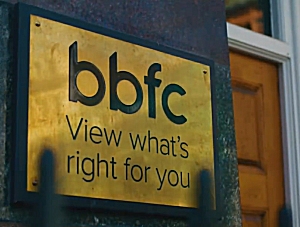 On reading the associated text: 'View what's right for you', I couldn't help but think, 'Who the fuck do they think they are fooling with such a bullshit claim?'. So I goggled the BBFC motto to ensure it wasn't a spoof image, and found Simran Hans' 'Guardian' article where she was likewise gobsmacked, saying,
On reading the associated text: 'View what's right for you', I couldn't help but think, 'Who the fuck do they think they are fooling with such a bullshit claim?'. So I goggled the BBFC motto to ensure it wasn't a spoof image, and found Simran Hans' 'Guardian' article where she was likewise gobsmacked, saying,
 Not for the crew or for the nudity that they had planned for the movie. In interviews later given by Sigourney Weaver who played Ripley, she revealed that:
Not for the crew or for the nudity that they had planned for the movie. In interviews later given by Sigourney Weaver who played Ripley, she revealed that:
 So if it's largely the censors and not the movie producers that are arguing that nudity is offensive, and ordering the editing, who or what is influencing the censors? Who's pulling their strings? Our answer would be that censors mostly obtain their guidelines from society and contemporary culture. It appears that some ignorant, conservative views in society that we thought were fading into deserved obscurity seem to be finding their voice again, and gaining undue influence. Just as sexist, racist morons like Donald Trump can be elected President when all intelligent, rational opinion deemed it nigh impossible, it seems that primitive, ignorant views on nudity and sex can have a resurgence and resonate with many in society, driving back decades of social progress. We wonder if movie content is running on a kind of positive feedback loop, where movie censors, who live in this conservative society, hide full-frontal nudity in certain movie scenes based on their own conservative personal views and that of their equally conservative community. Then after viewing these censored movies, society follows their example and hides it too, in real life. On seeing that society is now a little more adverse to nudity than it used to be, movie censors then think they should hide even more from upcoming movies to keep pace with society, and on and on it goes, each cycle feeding off the last to become more extreme.
So if it's largely the censors and not the movie producers that are arguing that nudity is offensive, and ordering the editing, who or what is influencing the censors? Who's pulling their strings? Our answer would be that censors mostly obtain their guidelines from society and contemporary culture. It appears that some ignorant, conservative views in society that we thought were fading into deserved obscurity seem to be finding their voice again, and gaining undue influence. Just as sexist, racist morons like Donald Trump can be elected President when all intelligent, rational opinion deemed it nigh impossible, it seems that primitive, ignorant views on nudity and sex can have a resurgence and resonate with many in society, driving back decades of social progress. We wonder if movie content is running on a kind of positive feedback loop, where movie censors, who live in this conservative society, hide full-frontal nudity in certain movie scenes based on their own conservative personal views and that of their equally conservative community. Then after viewing these censored movies, society follows their example and hides it too, in real life. On seeing that society is now a little more adverse to nudity than it used to be, movie censors then think they should hide even more from upcoming movies to keep pace with society, and on and on it goes, each cycle feeding off the last to become more extreme.
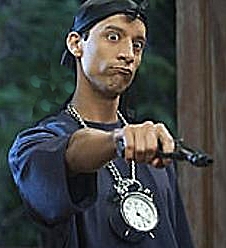 forced to try and hide nudity when the scene clearly calls for it. Often the nudity is hidden by the character quickly grabbing a towel and screaming. Is this sending the message to moviegoers that naked bodies are shameful and should be hidden, and is this in turn influencing viewer behaviour in real life? We'd argue yes. We've already mentioned more women keeping their bra on in bed and the modesty one should maintain with their bed sheets. And remember how movies showed people wearing their baseball caps backwards and holding their pistols on their side, both utterly stupid things to do in real life? But people started doing it anyway, just like in the movies. In NZ our gangs now wear different gang colours and some people call everyone else bro or dude, and all this was copied from Hollywood movies. In a TV episode of 'Sex and the City' in 2000, Sarah Jessica Parker's character helped promote the really stupid trend of the Brazilian wax to the wider world, that expensive and painful treatment to make adult women look like hairless prepubescent young girls for men's pleasure. On the positive side for women, a 1998 episode of the same series helped eliminate the taboo against sex toys when Kristin Davis' character was introduced to the Rabbit vibrator. On another rare positive note, scenes of the hero smoking were greatly reduced in movies to try and reduce smoking in real life, and again people followed. There are untold things people do today because some hero in a movie did it first, so clearly, whether it has to do with social attitudes, language, dress or behaviour, movies can definitely influence viewer behaviour in real life. And that influence can be good or bad, since the bottom line is that movie producers are out to make money by entertaining us, not to educate us or make us better people.
forced to try and hide nudity when the scene clearly calls for it. Often the nudity is hidden by the character quickly grabbing a towel and screaming. Is this sending the message to moviegoers that naked bodies are shameful and should be hidden, and is this in turn influencing viewer behaviour in real life? We'd argue yes. We've already mentioned more women keeping their bra on in bed and the modesty one should maintain with their bed sheets. And remember how movies showed people wearing their baseball caps backwards and holding their pistols on their side, both utterly stupid things to do in real life? But people started doing it anyway, just like in the movies. In NZ our gangs now wear different gang colours and some people call everyone else bro or dude, and all this was copied from Hollywood movies. In a TV episode of 'Sex and the City' in 2000, Sarah Jessica Parker's character helped promote the really stupid trend of the Brazilian wax to the wider world, that expensive and painful treatment to make adult women look like hairless prepubescent young girls for men's pleasure. On the positive side for women, a 1998 episode of the same series helped eliminate the taboo against sex toys when Kristin Davis' character was introduced to the Rabbit vibrator. On another rare positive note, scenes of the hero smoking were greatly reduced in movies to try and reduce smoking in real life, and again people followed. There are untold things people do today because some hero in a movie did it first, so clearly, whether it has to do with social attitudes, language, dress or behaviour, movies can definitely influence viewer behaviour in real life. And that influence can be good or bad, since the bottom line is that movie producers are out to make money by entertaining us, not to educate us or make us better people.
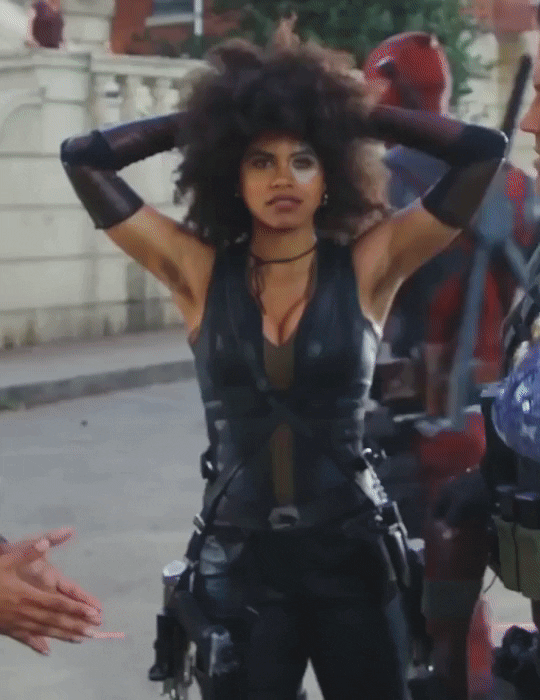 However Hanna Flint is far more mature about it, saying that she has 'too many commitments to worry about how hairy I am in public or the sack', and admits that:
However Hanna Flint is far more mature about it, saying that she has 'too many commitments to worry about how hairy I am in public or the sack', and admits that:
 Censors are responding to what they believe society wants to see, what they think the man and woman on the street finds morally acceptable, and society is in turn guided by what the censors say decent people should be watching. One feeds off the other. And in the case of some (perhaps most) censors, they're also guided by what they personally think is morally acceptable. For example, the people that work for the MPAA and rate US movies are basically just people off the street, they have no specific qualifications, training or expertise, are not elected by the public, and in fact who they are or what qualifies them to rate our movies is hidden from the public. 'This Film Is Not Yet Rated' (2006) is an interesting documentary by Kirby Dick that looks at how the MPAA works, who their anonymous censors are and how biased their decisions are. (You can view it on
Censors are responding to what they believe society wants to see, what they think the man and woman on the street finds morally acceptable, and society is in turn guided by what the censors say decent people should be watching. One feeds off the other. And in the case of some (perhaps most) censors, they're also guided by what they personally think is morally acceptable. For example, the people that work for the MPAA and rate US movies are basically just people off the street, they have no specific qualifications, training or expertise, are not elected by the public, and in fact who they are or what qualifies them to rate our movies is hidden from the public. 'This Film Is Not Yet Rated' (2006) is an interesting documentary by Kirby Dick that looks at how the MPAA works, who their anonymous censors are and how biased their decisions are. (You can view it on 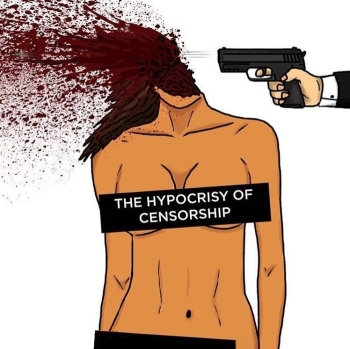
 attitude reminds us of the Romanian movie 'Bad Luck Banging or Loony Porn' (2021), a drama/comedy in which a private sex tape filmed by a teacher (Katia Pascariu) and her husband is leaked (without her permission or knowledge) to an Internet porn site and news of this reaches the parents and teachers at the school where she teaches. Appalled by her behaviour, naturally they all band together and try to get her fired (and of course, watch the video for themselves). The important message of the movie is summed up by this movie reviewer: 'Film-maker Radu Jude is asking us: what is obscene? The porn video or a society that sees sex acts between two consenting adults as obscene?' Clearly society sees it as the latter. In America people have been fired from their jobs when their boss learns they are a nudist (or an atheist), will some soon be fired because their boss learns they are having sex?
attitude reminds us of the Romanian movie 'Bad Luck Banging or Loony Porn' (2021), a drama/comedy in which a private sex tape filmed by a teacher (Katia Pascariu) and her husband is leaked (without her permission or knowledge) to an Internet porn site and news of this reaches the parents and teachers at the school where she teaches. Appalled by her behaviour, naturally they all band together and try to get her fired (and of course, watch the video for themselves). The important message of the movie is summed up by this movie reviewer: 'Film-maker Radu Jude is asking us: what is obscene? The porn video or a society that sees sex acts between two consenting adults as obscene?' Clearly society sees it as the latter. In America people have been fired from their jobs when their boss learns they are a nudist (or an atheist), will some soon be fired because their boss learns they are having sex?
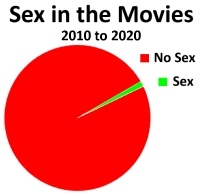
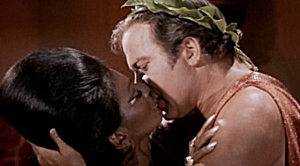 because an alien was forcing them to kiss using psychic powers. They weren't kissing willingly and therefore obviously wouldn't enjoy it (yeah right!). Decades later Nichelle Nichols, the African American actress who played Uhura, said in a documentary that she was annoyed that many in America were so offended, saying, 'It was just a kissing scene!' She's right of course, but it was a controversial scene back in the 1960s since many southern states in the US either still had anti-miscegenation laws which banned marriage and even relationships between different races, or at the very least the racist emotion behind those laws still held sway, with many Americans still thinking that a white man and a black woman kissing was disgusting and quite wrong. Clearly most have now changed their minds (but certainly not all). And for something more recent, people are no longer prosecuted for homosexuality, it's now deemed normal and natural behaviour for some, both in real life and on TV. What was once deemed obscene is now viewed as quite acceptable in our movies and on TV. Most young people today would no doubt find it quite laughable that such innocent scenes as a married couple in a double bed couldn't be shown. Going the other way, as we've argued, nudity in public saunas and spa pools, once deemed normal and natural, is now unacceptable and new rules prohibit it, even nudity in single-sex changing rooms at the pool and the gym is now viewed as disturbing and something to be avoided.
because an alien was forcing them to kiss using psychic powers. They weren't kissing willingly and therefore obviously wouldn't enjoy it (yeah right!). Decades later Nichelle Nichols, the African American actress who played Uhura, said in a documentary that she was annoyed that many in America were so offended, saying, 'It was just a kissing scene!' She's right of course, but it was a controversial scene back in the 1960s since many southern states in the US either still had anti-miscegenation laws which banned marriage and even relationships between different races, or at the very least the racist emotion behind those laws still held sway, with many Americans still thinking that a white man and a black woman kissing was disgusting and quite wrong. Clearly most have now changed their minds (but certainly not all). And for something more recent, people are no longer prosecuted for homosexuality, it's now deemed normal and natural behaviour for some, both in real life and on TV. What was once deemed obscene is now viewed as quite acceptable in our movies and on TV. Most young people today would no doubt find it quite laughable that such innocent scenes as a married couple in a double bed couldn't be shown. Going the other way, as we've argued, nudity in public saunas and spa pools, once deemed normal and natural, is now unacceptable and new rules prohibit it, even nudity in single-sex changing rooms at the pool and the gym is now viewed as disturbing and something to be avoided.


 is a documentary about the history of adult movies, of nudity and sex in the movies over the previous 100 years. Hosted by the comedy writer, actor and director Buck Henry, it began with Buck revealing that:
is a documentary about the history of adult movies, of nudity and sex in the movies over the previous 100 years. Hosted by the comedy writer, actor and director Buck Henry, it began with Buck revealing that:
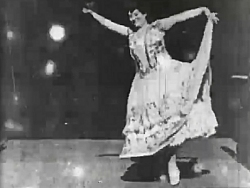
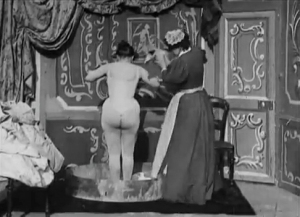 simulate total nudity (even though she is not shown from the front or even side on). However the important thing to note is that even at the very beginning movie makers were deliberately adding nudity to their films, and even though some were offended, notably the Church, the general public was lining up to see them. Think about it, movies had just been invented, and of all the things in the world they could have filmed (and they did film many boring things), Georges Méliès chose to have this particular film (albeit only one minute) show a woman undressing and bathing naked. Clearly it was felt that nudity wasn't strictly taboo for everyone, something that definitely couldn't be shown, it was chosen deliberately since it was expected many people would willingly watch such a scene. And not just watch, but pay to watch, meaning even from the beginning film makers realised certain movie scenes would sell more tickets and generate more profit. Give the people what they want, not what the Church thinks they should be happy with.
simulate total nudity (even though she is not shown from the front or even side on). However the important thing to note is that even at the very beginning movie makers were deliberately adding nudity to their films, and even though some were offended, notably the Church, the general public was lining up to see them. Think about it, movies had just been invented, and of all the things in the world they could have filmed (and they did film many boring things), Georges Méliès chose to have this particular film (albeit only one minute) show a woman undressing and bathing naked. Clearly it was felt that nudity wasn't strictly taboo for everyone, something that definitely couldn't be shown, it was chosen deliberately since it was expected many people would willingly watch such a scene. And not just watch, but pay to watch, meaning even from the beginning film makers realised certain movie scenes would sell more tickets and generate more profit. Give the people what they want, not what the Church thinks they should be happy with.
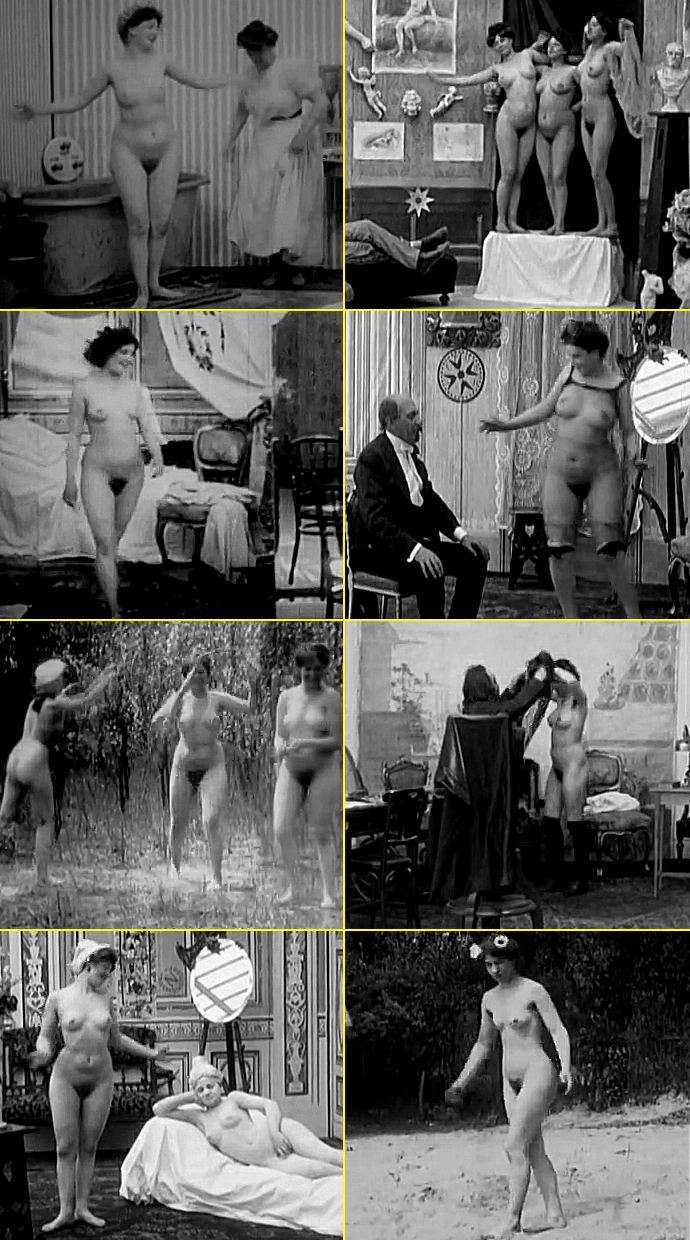 but unlike the above bathing scene from Georges Méliès, now the nudity is real and full-frontal. Likewise compare the nudity of the three artist's models in the second scene (top, right) with the nudity of the artist's model in the 1915 American movie 'Inspiration' which we mention shorty. European film makers were far ahead of the Americans.
but unlike the above bathing scene from Georges Méliès, now the nudity is real and full-frontal. Likewise compare the nudity of the three artist's models in the second scene (top, right) with the nudity of the artist's model in the 1915 American movie 'Inspiration' which we mention shorty. European film makers were far ahead of the Americans.
 In the excellent 2018 documentary about gender disparity in Hollywood, 'This Changes Everything', actress Geena Davis noted that '80% of the media consumed worldwide is created in the United States'. Worse still, as Jill Soloway explained, 'Most of television and most of film is men making stuff for other men', which means, as Davis added, that the USA was 'responsible for exporting a pretty negative view of women'.
In the excellent 2018 documentary about gender disparity in Hollywood, 'This Changes Everything', actress Geena Davis noted that '80% of the media consumed worldwide is created in the United States'. Worse still, as Jill Soloway explained, 'Most of television and most of film is men making stuff for other men', which means, as Davis added, that the USA was 'responsible for exporting a pretty negative view of women'.
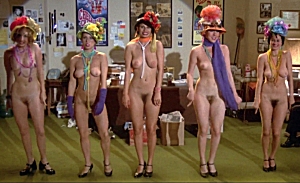 showed up and said, "yeah, it's not salacious, it's funny!" Really, is there anyone who could get titillated from watching this movie? They came in totally nude in that opening production number [right], in those costumes, those hats, which looked so stupid. How could you even think about anything else? They had no problems. The guys had problems. Not the two guys who actually [appeared nude in the film] — they were fine. It was trying to convince the male dancers, who wouldn't do the dance numbers nude. ... We would have done it but we couldn't find anyone who could dance and was willing to do it nude'.' [24]
showed up and said, "yeah, it's not salacious, it's funny!" Really, is there anyone who could get titillated from watching this movie? They came in totally nude in that opening production number [right], in those costumes, those hats, which looked so stupid. How could you even think about anything else? They had no problems. The guys had problems. Not the two guys who actually [appeared nude in the film] — they were fine. It was trying to convince the male dancers, who wouldn't do the dance numbers nude. ... We would have done it but we couldn't find anyone who could dance and was willing to do it nude'.' [24] In 'Body Parts' (2022), a documentary that looks at how Hollywood exploits the nude female body for the benefit of the male gaze and financial gain while at the same time society shames those that appear naked, actress Mishel Prada notes that there is 'This idea of "Oh, I'm less of a true actor if I do nudity", as if it's this negative thing, but who decided that ... who?' [6] Who indeed? Why should on-screen nudity harm an actor's career when on-screen murder doesn't? How does that make sense? Why should we condemn and boycott actors we see naturally naked in a shower scene and give other actors an Oscar when we see them convincingly murder people on-screen? Why does society punish movie nudity by turning an innocent, truly positive thing into a shameful, negative thing while at the same time rewarding movie violence, turning a disturbing, harmful, negative thing into an exciting, positive thing worthy of red carpet award ceremonies? Why has society arrived at a point where we don't mind actors shooting people in the head with blood spraying everywhere, arguing that it's necessary to make a movie convincing, but actors getting naked ... no one should be forced to see that? That would be horrible, the stuff of nightmares! Who decided that actors getting naked for a role are disgracing their profession, that even if a scene calls for nudity it should always be implied and never seen, unlike violence which should always be seen and never just implied? Why do moviegoers see violence as exciting and nudity as shocking? Again, as actress Mishel Prada asked, who decided this fucked up state of affairs? There's nothing shameful or shocking or wrong with nudity, so how did their thinking get so screwed up and why didn't we get a say? But regardless, obviously the claim that nude scenes might be problematic as studios will struggle to find actors willing to get naked is utterly bogus. But what if it wasn't?
In 'Body Parts' (2022), a documentary that looks at how Hollywood exploits the nude female body for the benefit of the male gaze and financial gain while at the same time society shames those that appear naked, actress Mishel Prada notes that there is 'This idea of "Oh, I'm less of a true actor if I do nudity", as if it's this negative thing, but who decided that ... who?' [6] Who indeed? Why should on-screen nudity harm an actor's career when on-screen murder doesn't? How does that make sense? Why should we condemn and boycott actors we see naturally naked in a shower scene and give other actors an Oscar when we see them convincingly murder people on-screen? Why does society punish movie nudity by turning an innocent, truly positive thing into a shameful, negative thing while at the same time rewarding movie violence, turning a disturbing, harmful, negative thing into an exciting, positive thing worthy of red carpet award ceremonies? Why has society arrived at a point where we don't mind actors shooting people in the head with blood spraying everywhere, arguing that it's necessary to make a movie convincing, but actors getting naked ... no one should be forced to see that? That would be horrible, the stuff of nightmares! Who decided that actors getting naked for a role are disgracing their profession, that even if a scene calls for nudity it should always be implied and never seen, unlike violence which should always be seen and never just implied? Why do moviegoers see violence as exciting and nudity as shocking? Again, as actress Mishel Prada asked, who decided this fucked up state of affairs? There's nothing shameful or shocking or wrong with nudity, so how did their thinking get so screwed up and why didn't we get a say? But regardless, obviously the claim that nude scenes might be problematic as studios will struggle to find actors willing to get naked is utterly bogus. But what if it wasn't?
 Common sense solves the bullet wound dilemma for you, they must be fake, but nudity can go either way, and since convincing fakes may have been used, you can't make a call one way or the other. You can make an educated guess, but it's still just a guess, you'll likely never know for sure. But has Hollywood reached the stage of producing convincing fakes when it comes to the human body? With bullet wounds and autopsies, even gun battles and computer hacking, most of us have no experience in these areas and will never pick up on the little details that Hollywood (often) gets wrong, but we've all seen, touched and experienced real human bodies, so we should be far more qualified to detect when Hollywood tries to pass off a plastic Barbie body as a real body. But even with our real life experience, has Hollywood finally mastered faking nudity? As to whether it's real or not, are we now forced to admit that the naked body we're seeing on screen could just as easily be fake as real? We would argue that today ignorance indeed rules, and convincing yourself that you've definitely seen an actor naked on screen is likely as delusional as telling yourself you've seen an actor shot on screen. There will still be some movie nudity today that you can point to as likely being real, and some as certainly fake, but the great majority of scenes will forever remain a mystery — maybe it's real, maybe it's not. Increasingly the honest answer is we simply don't know ... but if we had to put money on it, the odds are swinging towards it being increasingly fake, at least parts of it. And to make things even more difficult, some actors that have filmed real nude scenes have also filmed ones that were faked, so evidence of them being truly naked in one movie is not evidence of real nudity in another.
Common sense solves the bullet wound dilemma for you, they must be fake, but nudity can go either way, and since convincing fakes may have been used, you can't make a call one way or the other. You can make an educated guess, but it's still just a guess, you'll likely never know for sure. But has Hollywood reached the stage of producing convincing fakes when it comes to the human body? With bullet wounds and autopsies, even gun battles and computer hacking, most of us have no experience in these areas and will never pick up on the little details that Hollywood (often) gets wrong, but we've all seen, touched and experienced real human bodies, so we should be far more qualified to detect when Hollywood tries to pass off a plastic Barbie body as a real body. But even with our real life experience, has Hollywood finally mastered faking nudity? As to whether it's real or not, are we now forced to admit that the naked body we're seeing on screen could just as easily be fake as real? We would argue that today ignorance indeed rules, and convincing yourself that you've definitely seen an actor naked on screen is likely as delusional as telling yourself you've seen an actor shot on screen. There will still be some movie nudity today that you can point to as likely being real, and some as certainly fake, but the great majority of scenes will forever remain a mystery — maybe it's real, maybe it's not. Increasingly the honest answer is we simply don't know ... but if we had to put money on it, the odds are swinging towards it being increasingly fake, at least parts of it. And to make things even more difficult, some actors that have filmed real nude scenes have also filmed ones that were faked, so evidence of them being truly naked in one movie is not evidence of real nudity in another.
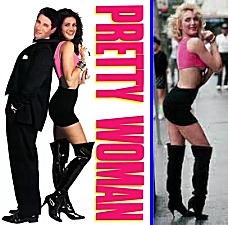 For something far more recent, no doubt you've seen the movie 'Pretty Woman' (1990) starring Julia Roberts and Richard Gere, but did you know that Julia employed a body double by the name of Shelley Michelle for the more 'risqué' scenes? And if you look at the iconic movie poster, the body of the woman in the boots and miniskirt is actually that of Michelle, the body double, the studio simply superimposed Julia Roberts' head onto her body using Photoshop. When Touchstone Pictures was asked if a body double was used in the movie, they initially denied this was the case, only later admitting it was indeed true. This was a movie that had no nudity, merely some revealing outfits, and yet still a body double was utilised for some undisclosed scenes (and denied), so clearly studios and actors are not always going to be honest about the use of body doubles nor will it always be obvious when one might have been used.
For something far more recent, no doubt you've seen the movie 'Pretty Woman' (1990) starring Julia Roberts and Richard Gere, but did you know that Julia employed a body double by the name of Shelley Michelle for the more 'risqué' scenes? And if you look at the iconic movie poster, the body of the woman in the boots and miniskirt is actually that of Michelle, the body double, the studio simply superimposed Julia Roberts' head onto her body using Photoshop. When Touchstone Pictures was asked if a body double was used in the movie, they initially denied this was the case, only later admitting it was indeed true. This was a movie that had no nudity, merely some revealing outfits, and yet still a body double was utilised for some undisclosed scenes (and denied), so clearly studios and actors are not always going to be honest about the use of body doubles nor will it always be obvious when one might have been used.
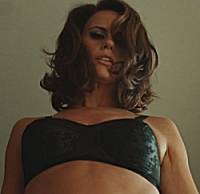 clearly forgotten what a real woman's bush actually looks like. We like it when filmmakers try to make their historical movies appear authentic, like having era-appropriate clothes, weapons, hairstyles etc, including having pubic hair, as these filmmakers did, but why produce and fit a realistic merkin only to almost hide it? The way this scene was deliberately shot, would anyone have noticed if a little hint of pubic hair hadn't been there? Like Jennifer Connelly's merkin, this one was also a waste of time and money, especially since they had another opportunity to highlight their handiwork, in that following this nude scene there was a sex scene. Yet while Amy's character was uninhibited and clearly had no problem sunbathing naked, or instigating sex with her married neighbour, the movie then messed with the nature of her character in that now having sex naked was a step too far, showing Amy only from the waist up and wearing a bra (photo right). Apparently the director quickly ditched any thought of showing the merkin again, it's moment in the limelight was over (as ridiculously brief and indistinct as it was).
clearly forgotten what a real woman's bush actually looks like. We like it when filmmakers try to make their historical movies appear authentic, like having era-appropriate clothes, weapons, hairstyles etc, including having pubic hair, as these filmmakers did, but why produce and fit a realistic merkin only to almost hide it? The way this scene was deliberately shot, would anyone have noticed if a little hint of pubic hair hadn't been there? Like Jennifer Connelly's merkin, this one was also a waste of time and money, especially since they had another opportunity to highlight their handiwork, in that following this nude scene there was a sex scene. Yet while Amy's character was uninhibited and clearly had no problem sunbathing naked, or instigating sex with her married neighbour, the movie then messed with the nature of her character in that now having sex naked was a step too far, showing Amy only from the waist up and wearing a bra (photo right). Apparently the director quickly ditched any thought of showing the merkin again, it's moment in the limelight was over (as ridiculously brief and indistinct as it was).
 now argue that when people get shot and stabbed there will naturally be lots of blood and screaming and horrific wounds, and this needs to be portrayed as realistically as possible to make the scene believable, so we're simply arguing that when movie characters show up on a nude beach, for example, then to make the scene believable, the bathers on that beach should be shown naked. If the bullets ripping through bodies need to be shown and not merely implied, then likewise naked bodies need to be shown and not merely implied, not hidden behind sheets, towels and other strategically placed props, like hiding those offensive nipples behind coffee mugs (although in real life coffee mugs really aren't that effective, as this humorous movie
now argue that when people get shot and stabbed there will naturally be lots of blood and screaming and horrific wounds, and this needs to be portrayed as realistically as possible to make the scene believable, so we're simply arguing that when movie characters show up on a nude beach, for example, then to make the scene believable, the bathers on that beach should be shown naked. If the bullets ripping through bodies need to be shown and not merely implied, then likewise naked bodies need to be shown and not merely implied, not hidden behind sheets, towels and other strategically placed props, like hiding those offensive nipples behind coffee mugs (although in real life coffee mugs really aren't that effective, as this humorous movie